

Mount Fuji Day Trip: Complete 1-Day Itinerary for Lake Kawaguchiko
Embarking on a Mount Fuji day trip offers the chance to enjoy Japan's tallest and most revered mountain up close. Mt. Fuji's magnificence draws numerous visitors from across the globe, making it a significant destination. The popularity of Mt. Fuji and its surrounding area of Lake Kawaguchiko continues to soar, with a steady rise in tourist numbers, reaching a staggering 4.5 million visitors in 2017 alone! Amidst this influx, first-time visitors may find it challenging to determine the best places to explore and the must-see sights. To assist in making these decisions, we have crafted the following itinerary, ensuring that day-trippers from Tokyo can fully immerse themselves in the wonders of the Lake Kawaguchiko region!
Overview of the Mt. Fuji Area
Perfect 1-day itinerary for lake kawaguchi, getting to mt. fuji: from shinjuku expressway bus terminal, shinjuku south exit 4th floor, boarding the sightseeing buses: 3 types of buses at lake kawaguchi station, book a mt. fuji tour.
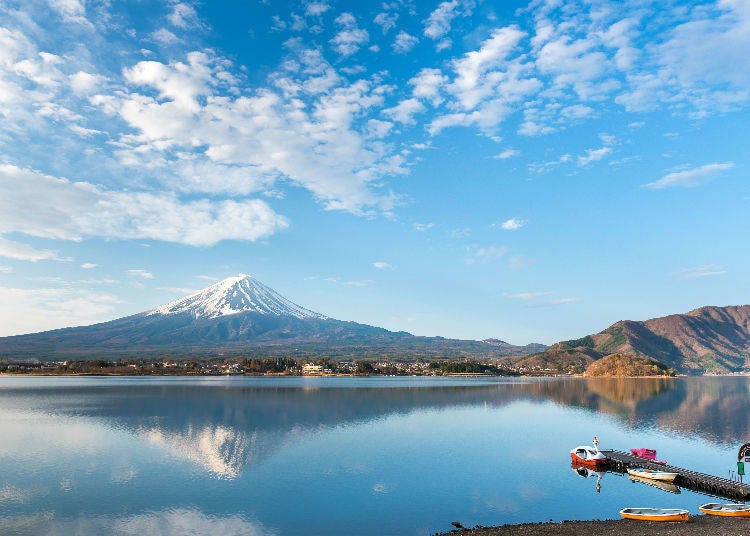
The Mt. Fuji Area: A Symbol of Japan's Beauty Throughout history, Mt. Fuji has stood as an iconic symbol of Japan, captivating the hearts of both the Japanese people and the world. Katsushika Hokusai's renowned series, Thirty-six Views of Mt. Fuji , not only influenced Japanese art but also introduced the legendary mountain to a global audience. As Japan's tallest peak, Mt. Fuji attracts numerous climbers annually. Its summit offers panoramic vistas of the Southern Alps, Izu Peninsula, and shimmering lakes , including the captivating Lake Kawaguchiko. Undoubtedly, it offers Japan's most awe-inspiring views, making it an unparalleled destination for experiencing the beauty of nature . The Enchanting Five Lakes of Mt. Fuji Nestled at the foot of Mt. Fuji are the five lakes that were formed during its last eruption: Lake Motosu , Lake Shoji , Lake Saiko , Lake Kawaguchiko , and Lake Yamanaka . Together, they are referred to as the Five Lakes of Mt. Fuji and were officially recognized as part of the Mt. Fuji Cultural World Heritage site in 2013. Among the five lakes , Lake Kawaguchi stands out for its timeless scenic beauty . In this area, visitors can enjoy attractions like Oishi Park , which provides breathtaking views of the lake and Mt. Fuji. The Kawaguchiko Music Forest Museum offers a remarkable collection of music boxes in a medieval European-style setting. Plus, nearby hot spring resorts offer a perfect chance to relax and soak in the stunning Mt. Fuji scenery.
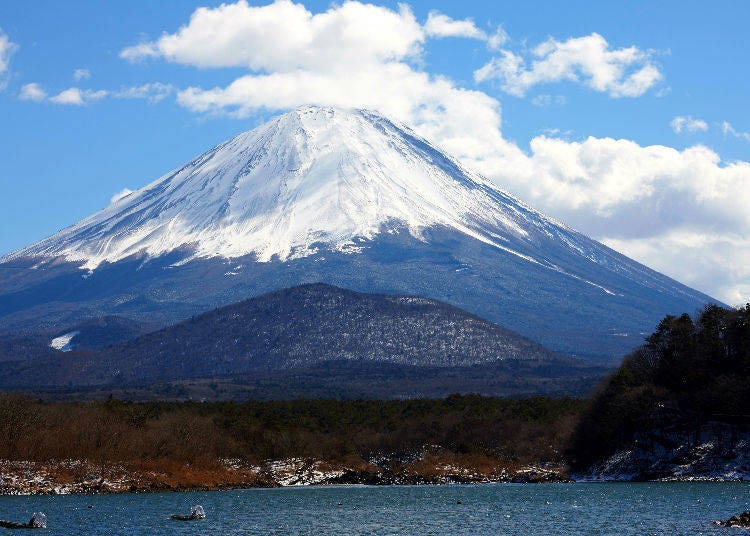
The Journey to World Heritage Status Before starting your Mt. Fuji adventure, let's explore how it became a World Heritage site . Japan joined the World Heritage Convention in 1992, and environmental groups in the Shizuoka and Yamanashi prefectures around Mt. Fuji began working to secure its natural heritage status. However, concerns about litter from climbers temporarily halted these efforts. In 2005, the two prefectures shifted their focus to emphasize the cultural significance of Mt. Fuji and established the Joint Council for its World Cultural Heritage Site registration. Through persistent public relations efforts by Yamanashi and Shizuoka, along with a commitment to managing waste, Mt. Fuji achieved cultural heritage status in 2013. Since then, it has embodied Japan's rich cultural heritage both in name and essence. Supporting the Legacy of Mt. Fuji Today, Mt. Fuji continues to receive unwavering support from Yamanashi and Shizuoka prefectures. When you embark on your Mt. Fuji journey, take a moment to acknowledge the efforts of the local municipalities, which are intertwined within its history. And as a responsible visitor, please ensure to carry away any litter you may have , leaving the mountain pristine for future generations to cherish.
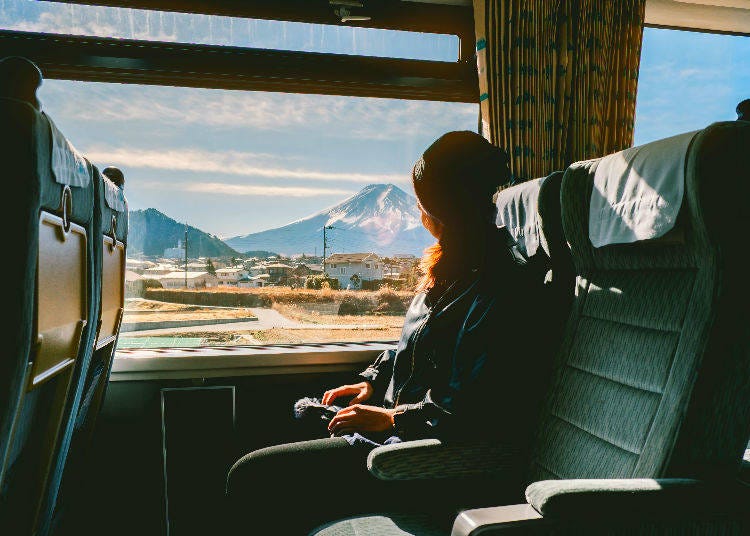
- Depart from Shinjuku Express Bus Terminal (Busta Shinjuku) South Exit, 4th floor at 8:45 AM.
- Arrive at Chuo Expressway Shimoyoshida Bus Stop at Arakurayama Sengen Park at 10:20 AM.
- Depart from Shimoyoshida Bus Stop at 11:00 AM.
- Arrive at Kawaguchiko Station , Houtou Fudou (in front of Kawaguchiko Station) at 11:17 AM.
- Depart from Kawaguchiko Station on the Saiko Sightseeing Bus (Green Line) at 12:10 PM.
- Arrive at Yagizaki Park at 12:22 PM.
- Depart from Yagizaki Park Station on the Saiko Sightseeing Bus (Green Line) at 1:22 PM.
- Arrive at Saiko Iyashi no Sato Nenba (Healing Village) at 1:50 PM.
- Depart from Saiko Iyashi no Sato Nenba (Healing Village) on the Saiko Sightseeing Bus (Green Line) at 2:50 PM.
- Arrive at Kawaguchiko Station and transfer to the Kawaguchiko Sightseeing Bus (Red Line) at 3:45 PM. Depart at 4:00 PM.
- Arrive at Mount Fuji Panoramic Ropeway at 4:11 PM.
- Depart from Mount Fuji Panoramic Ropeway Station on the Kawaguchiko Sightseeing Bus (Red Line) at 5:11 PM.
- Arrive at Kawaguchiko Station , Gateway Fujiyama (at Kawaguchiko Station)
- Return to Shinjuku Express Bus Terminal (Busta Shinjuku) South Exit, 4th floor.

(Depart: 8:45 AM) Upon exiting the south exit of Shinjuku Station, you'll find a four-story building directly ahead, known as the Shinjuku Expressway Bus Terminal. This is where our journey to Mt. Fuji begins. For our one-day excursion to Mt. Fuji today, we will board the Keio Bus Fuji Goko Line, bound for Lake Yamanaka, which departs promptly at 8:45 AM. Our first destination, Arakurayama Sengen Park , is expected to be reached at 10:20 AM. The one-way fare for this 90-minute trip is 1,950 yen. Considering factors such as complicated transfers and cost, the express bus from Shinjuku is widely regarded as the most convenient option for reaching Mt. Fuji. If, by any chance, you miss the scheduled bus departure, there's no need to worry. Apart from the Keio Bus, the Fuji Express Bus also travels to Mt. Fuji, ensuring a bus heads in that direction every 15 minutes. It would be best to ask at the counter about seat availability on the next bus and the possibility of boarding it. Also, if you arrive earlier than the departure time, you can use the waiting room within the bus terminal.
Arakurayama Sengen Park: Gorgeous Views of Mt. Fuji and the streets of Fuji City
(Depart Shinjuku Expressway Bus Terminal at 8:45 AM → Arrive at Chuo EXPWY Shimoyoshida bus stop at 10:20 AM)
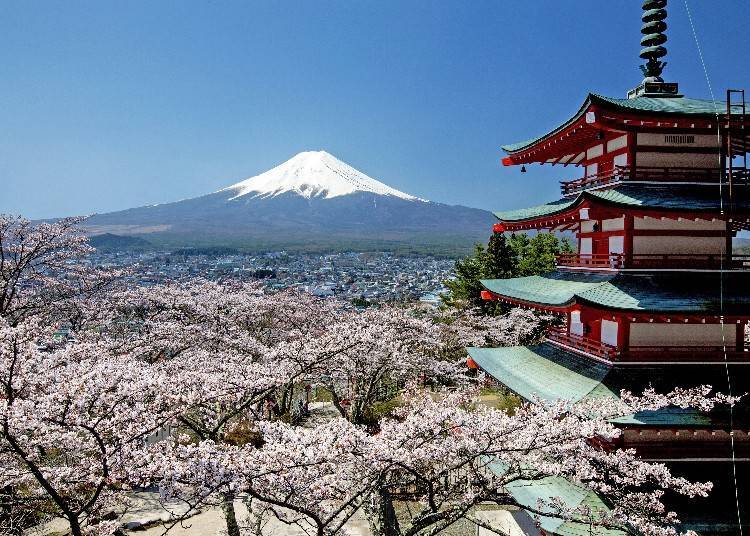
After around an hour and a half journey from Shinjuku , you will reach the Chuo EXPWY Shimo Yoshida bus stop, located in close proximity to Mt. Fuji, where you should disembark. From there, make your way to Arakurayama Sengen Park , offering a remarkable view of both Mt. Fuji and a five-storied pagoda. The park has become increasingly popular among international visitors who flock here to capture breathtaking photographs. Situated around 1 kilometer away from the bus stop, it takes approximately 20 minutes to ascend the gradual slope. As you approach the entrance of Arakurayama Sengen Park , you will pass under a vibrant red torii gate, leading you to the Arakura Fuji Sengen Shrine . Dating back over 1,000 years, the shrine has garnered fame for attracting devotees seeking divine protection from calamities, promoting family harmony, ensuring safe childbirth, and nurturing children. Upon entering the precincts, you will encounter stairs that lead to an observation deck. Scaling the 398 steps of the Sakuya Hime Kaidan, also known as the Blooming Princess Stairs, will bring you to the observation deck. Reaching the observation deck, you will be greeted by the Chureido Pagoda, nestled within Arakurayama Sengen Park . From this vantage point, you can relish panoramic views of the majestic Mt. Fuji, the sprawling streets of Fujiyoshida, and the picturesque five-storied pagoda. The vast landscape with Mt. Fuji as its centerpiece is captivating, often causing visitors to lose track of time. Additionally, the park boasts 650 Yoshino cherry trees, which create a stunning spectacle when they blossom in spring . The peak cherry blossom season generally falls around mid-April, later than Tokyo's cherry blossoms, making it a popular destination for those who missed the blooms in the city. For an enchanting experience combining cherry blossoms and the iconic presence of Mt. Fuji, Arakurayama Sengen Park is an ideal choice.
- Address 2-4-1 Asama, Fujiyoshida, Yamanashi 403-0011
・Telephone: 0555-21-1000 ・Open: 24 hours a day ・Fee: None ・Closed: Open daily
(Depart Shimoyoshida Station at 11 AM → Arrive at Lake Kawaguchi Station at 11:17 AM)
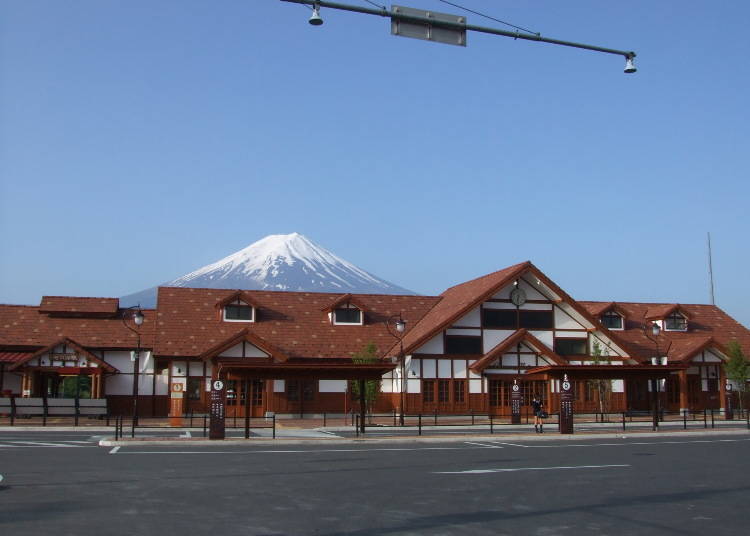
After reveling in the breathtaking view from Arakurayama Sengen Park , the next destination is Lake Kawaguchi Station. This time, you will utilize the Fuji Express Line. Board a local Fuji Express Line train heading to Lake Kawaguchi from Shimoyoshida Station, and in approximately 15 minutes, you will arrive at Kawaguchiko Station. The one-way fare for adults (12 years and older) is 300 yen, while children (between 6 and 12 years old) pay 120 yen. Upon reaching Kawaguchiko Station, it's time to decide how to proceed to your desired locations. From Kawaguchiko Station, you have various options to explore the area. You can visit the Mt. Fuji Panorama Ropeway, enjoy a Lake Kawaguchi Excursion Boat ride, explore the Music Box Forest , and visit the Lake Kawaguchi Museum of Art by taking the Kawaguchiko Sightseeing Bus (Red Line) . Alternatively, you can embark on the Narusawa/Shojiko/Motosuko Sightseeing Bus (Blue Line) to explore the surroundings of Lake Motosu. Another option is to hop on the Saiko Sightseeing Bus (Green Line) to visit Saiko Iyashi-no-Sato Nenba Traditional Japanese Village , Lake Saiko Bat Cave, Fugaku Wind Cave, and Lake Saiko Wild Bird Forest Park . Bus fares range from 150 yen to 1,280 yen, depending on the chosen route. If you plan to visit multiple sightseeing spots, consider purchasing the All Areas Coupon, allowing unlimited rides on all excursion buses for a two-day period. This convenient option saves you from paying individually for each bus ride and reduces travel expenses when exploring numerous attractions. The Adult Free Pass is priced at 1,500 yen, while children can avail it for 750 yen. Let's embark on the Saiko Sightseeing Bus (Green Line) to visit Yagizaki Park and Saiko Iyashi-no-Sato Nenba Traditional Japanese Village . Afterward, we can switch to the Kawaguchiko Sightseeing Bus (Red Line) to reach the Mt. Fuji Panoramic Ropeway, continuing our delightful exploration of the area.
- Address 3641 Funatsu, Minamitsuru-gun, Fujikawaguchiko-machi, Yamanashi, 401-0301
- Phone Number 0555-72-001
・Hours: 6:40 AM to 10:10 PM ・Fare: Depends on the route ・Closed: Open daily
Houtou Futo (Kawaguchiko Ekimae Shop): Popular for its miso soup loaded with delicious ingredients
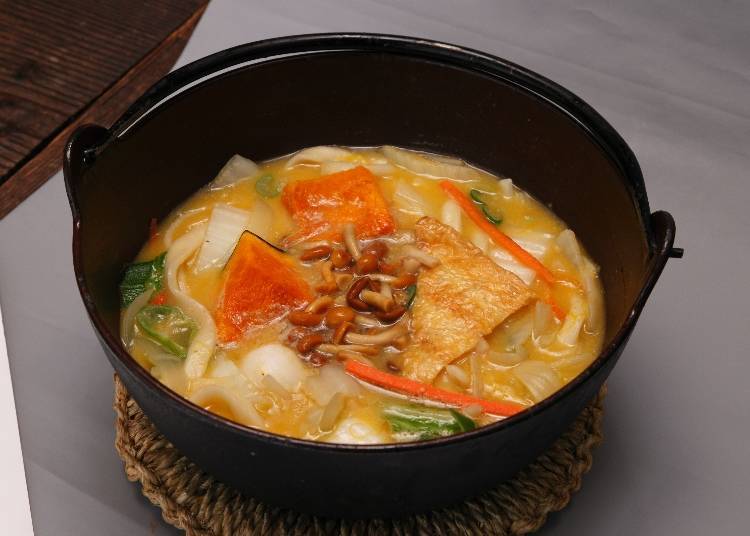
There's more to indulge in than just the awe-inspiring view of Mt. Fuji and exploring the sights around Lake Kawaguchi. The area is also home to numerous delightful dining establishments. One of these culinary gems is the renowned Houtou Futo, conveniently located near Kawaguchiko Station. The shop's signature dish is the Hoto (1,100 yen, tax included), a delectable miso-based soup brimming with locally sourced ingredients cultivated near the foothills of Mt. Fuji, accompanied by hearty, firm-textured noodles. A single sip of this steaming hot soup, infused with the flavorsome essence of the ingredients, is enough to rejuvenate and revitalize you after a morning of activities. In addition to their famous Hoto, Houtou Futo offers an array of other enticing dishes. Delve into the flavors of Japanese cuisine with basashi (thinly sliced raw horse meat) or savor the Kokuto Taki Inari, a delightful combination of flavored boiled rice wrapped in fried bean curd. Don't miss the aburaage (fried bean curd) cooked in brown sugar, lending it a delightful sweetness. Give any of these dishes a try, and I'm confident you will relish the delightful flavors they offer.
- Address 3631-2 Funatsu, Minamitsurugun, Fujikawaguchikomachi, Yamanashi, 401-0301
- Phone Number 0555-72-5560
・Open: 11 AM to 7 PM (If you plan to visit after 4 PM on a weekday, please call the shop in advance to confirm the closing time.) ・Prices: Fudo Hoto (1,080 yen, tax included); Basashi (1,080 yen, tax included); Kokto Taki Inari (432 yen, tax included) ・Closed: Open daily
Yagizaki Park: Spectacular views of lavender blooming with Mt. Fuji in the background
(Depart Kawaguchiko Station at 12:10 PM → arrive at Yagizaki Park at 12:22 PM) (Saiko Sightseeing Bus)
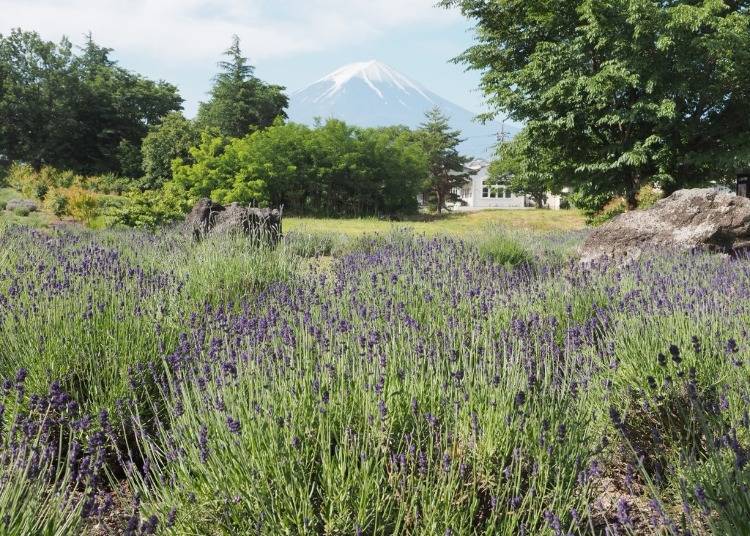
After enjoying a relaxing break at Hoto, our next destination is Yagizaki Park , renowned in the prefecture for its abundant wild bird population. From Kawaguchiko Station, board the Saiko Sightseeing Bus (Green Line) for a delightful 12-minute journey, disembarking at Yagizaki Park . The one-way fare is 150 yen. A pleasant 3-minute walk from the bus stop will lead you to Yagizaki Park . Nestled along the southern coast of Lake Kawaguchi, Yagizaki Park presents a picturesque vista of the Misaka Mountains and the captivating shoreline of the lake stretching before you. The park features an array of shrubs and plants, including lavender, enhancing the scenic allure with the majestic presence of Mt. Fuji in the distance. It's a perfect spot for a leisurely stroll after a satisfying meal. Every year, from June to July, Yagizaki Park hosts the Herb Festival , transforming the surroundings into a splendid purple carpet as the lavender blooms. This captivating sight adds yet another enchanting dimension to the panoramic view of Mt. Fuji, creating a truly mesmerizing experience.
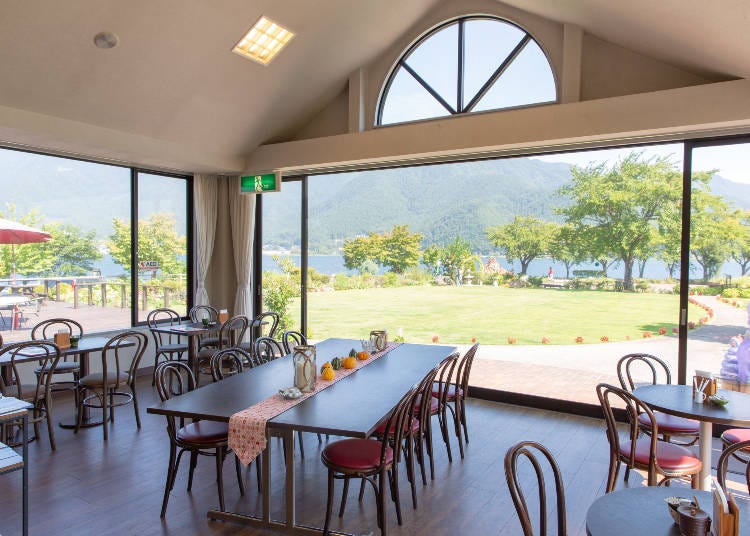
On the western side of the park , you will find the Kawaguchiko Muse Museum - Yuki Atae Hall, showcasing the exquisite artistic creations of renowned doll maker Mr. Yuki Atae. The museum features a permanent exhibition displaying over one hundred dolls meticulously crafted by Mr. Yuki Atae. At different times, the museum also hosts various other captivating displays. Additionally, the museum houses a delightful shop where you can purchase postcards featuring the showcased items and other merchandise like card cases. If you're in the mood for some refreshments, the Doll Cafe offers a delightful culinary experience, serving hearty dishes, delectable desserts, and a selection of alcoholic beverages.
- Address 897-1 Kodachi, Minamitsurugun, Fujikawaguchiko-machi, Yamanashi, 401-0302
- Phone Number 0555-72-1976
・Open: 24 hours a day ・Fee: No charge ・Closed: Open daily
- Address 923 Odachi, Minamitsuru-gun, Fujikawaguchiko-machi, Yamanashi, 401-0302
- Phone Number 0555-72-5258
・Open: 9 AM to 5 PM (Admission until 4:30 PM) ・Admission Fee: - General/University students: 600 yen (540 yen for groups of 8 or more) - Junior and Senior High School students: 400 yen (360 yen for groups of 8 or more) - Free for elementary school age and younger - Half-price admission for those with disability cards ・Closed: Every Thursday from December to March ・Exhibition Change Dates: March, September, and year-end
Saiko Iyashi-no-Sato Nenba: Experience the Charm of a Traditional Japanese Farming Village
(Leave Yagizaki Park at 1:22 PM → Reach Saiko Iyashi no Sato Nenba (Healing Village ) at 1:50 PM)
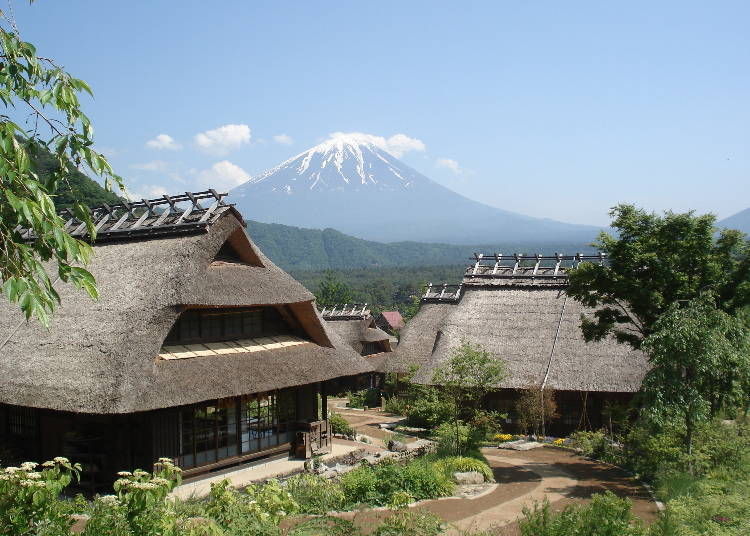
After immersing yourself in the natural beauty of Yagizaki Park , the next stop is the captivating Saiko Iyashi-no-Sato Nenba Traditional Japanese Village . Board the Saiko Sightseeing Bus (Green Line) once again at Yagizaki Park , and after a scenic 28-minute ride, you will arrive at Lake Saiko. The one-way fare for this leg of the journey is 520 yen. Saiko Iyashi-no-Sato Nenba is a meticulously recreated traditional Japanese village , featuring thatch-roofed farmhouses that transport visitors back in time. Established 52 years ago, this village showcases several authentic thatch-roofed farmhouses built in a distinctive style known as Kabuto-zukuri, resembling a samurai's helmet when viewed from the side. This architectural style was once prevalent in the region until a typhoon in 1966 devastated the area, causing the original farmhouses to vanish. Today, it is a rare opportunity to witness faithfully reconstructed traditional farmhouses like the ones found at Saiko Iyashi-no-Sato Nenba Traditional Japanese Village , as they have become scarce in other parts of Japan.
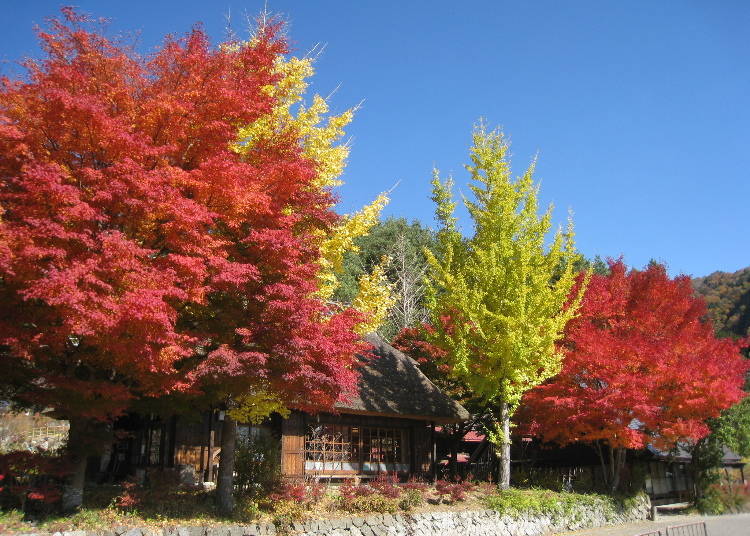
Each building within the village showcases its own distinctive characteristics. For instance, there is the Tokusanhin Kakojo (Special Products Processing Plant), offering locally produced wine and sake. The Omoideya (House of Memories) provides a nostalgic experience, while the Shokuji/Kanmi Saiun (Food and Sweets Saiun) is perfect for enjoying light meals and tea. At the Sabo Shiryokan (Erosion Control Museum ), you can learn about disaster prevention, and the Tsuchi Asobi Fuji Roman Kama (Ceramics Experience) allows you to try your hand at various handicrafts. Moreover, Saiko Iyashi-no-Sato Nenba Traditional Japanese Village provides a unique opportunity to capture the majestic backdrop of Mt. Fuji alongside these charming traditional farmhouses. It is the perfect setting for capturing memorable photos during your visit.
- Address 2710 Saiko Nenba, Minamitsuru-gun, Fujikawaguchiko-machi, Yamanashi, 401-0332
- Phone Number 0555-20-4677
・Open: - March to November: 9 AM to 5 PM (Last admission at 4:30 PM) - December to February: 9:30 AM to 4:30 PM (Last admission at 4 PM) ・Admission Fee: - Adults (high school age and above): 350 yen (300 yen for groups of 20 or more) - Children (junior high school age and below): 150 yen (100 yen for groups of 20 or more) - Adults with disabilities: 150 yen - Children with disabilities: 50 yen (Please present a disability card at the admission counter.) ・Closed: Open year-round (*Occasional unscheduled closures may occur)
Mt. Fuji Panoramic Ropeway: Experience the Breathtaking Panorama from 1,075 Meters Above!
(Leave Saiko Iyashi-no-Sato Nemba Stop at 2:50 PM → Reach Lake Kawaguchiko Station at 3:45 PM → Depart Lake Kawaguchiko Station at 4 PM → Arrive at Mt. Fuji Panoramic Ropeway at 4:11 PM)
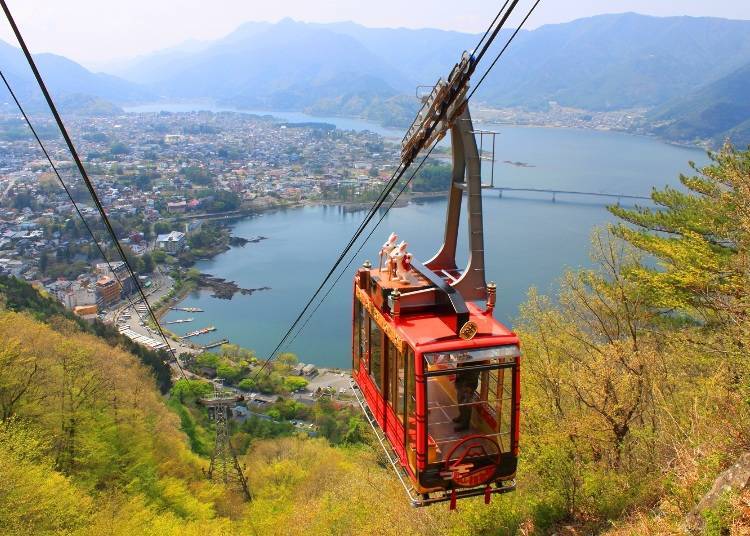
Once you've soaked in the charming atmosphere of an old Japanese village at Saiko Iyashi-no-Sato Nenba Traditional Japanese Village , our next destination is the Mt. Fuji Panoramic Ropeway. To return to Kawaguchiko Station, we'll hop on the Saiko Sightseeing Bus (Green Line) for a 35-minute journey (700 yen one way). Upon reaching Kawaguchiko Station, we'll then board the Kawaguchiko Sightseeing Bus (Red Line) for a 10-minute trip (150 yen one way) to the Excursion Boat and Ropeway Entrance. After reaching the entrance, we'll take the ropeway to the mountain 's summit. From the observation deck situated at the peak, which stands at an altitude of 1075 meters, you'll be greeted with a breathtaking panoramic view if the weather permits. This magnificent vista encompasses Mt. Fuji, Lake Kawaguchi, as well as the Southern Alps' Mt. Akaishi and Mt. Arakawa. During autumn , the mountain 's trees adorned with crimson leaves create a captivating spectacle alongside Mt. Fuji and the surrounding shores of Lake Kawaguchi. While there are various spots in the area to appreciate the beauty of Mt. Fuji, this particular location offers a unique advantage—the only 360-degree panoramic view available.
- Address 1163-1 Asakawa, Minamitsuru-gun, Fujikawaguchiko-machi, Yamanashi, 401-0303
- Phone Number 0555-72-0363
・Hours: - Normal times: 9 AM to 5:20 PM (Last trip up at 5 PM) - Winter season (December 1 to February 28): 9:30 AM to 4:40 PM (Last trip up at 4:20 PM) ・Fares: Individuals: - Adult: Round trip 800 yen (400 yen); one-way 450 yen (230 yen) - Child: Round trip 400 yen (200 yen); one-way 230 yen (120 yen) *Fares in ( ) are for the disabled Groups (15 or more people): - Group Adult: Round trip 720 yen; one-way 410 yen - Group Child (Elementary school age and younger): Round trip 360 yen; one-way 210 yen - Student Adult: Round trip 640 yen; one-way 360 yen - Student Child: Round trip 320 yen; one-way 190 yen ・Closed: Open year-round (*Occasional unscheduled closures due to weather conditions.) Light meals and souvenirs are available at the Tanuki Jaya.
- Address 1163−1 Asakawa, Minamitsuru-gun, Fujikawaguchiko-machi, Yamanashi, 401-0303
・Hours: 9 AM to 4:30 PM ・Prices: Snacks and drinks are approximately 500 yen each. ・Prices: Souvenirs - Mini Osembei: 550 yen (tax included) - Osembei: 400 yen (tax included) - Gondola-shaped Fujiyama Cookie: 700 yen (tax included) - Usagi Jinja Omamori: 620 yen (tax included) - Tobidashi Mascot: 380 yen (tax included) - Frame Magnet: 270 yen (tax included) - Ema [Votive picture] for fulfillment of love: 410 yen (tax included) - Ema for family well-being: 410 yen (tax included) - Mt. Fuji Pilgrimage Ticket: 500 yen (tax included) - Lake Kawaguchi ~ Mt. Fuji Panoramic Ropeway Limited Edition Medallion: 200 yen (tax included) ・Closed: Open year-round (*Occasional unscheduled closures may occur)
Gateway Fujiyama Lake Kawaguchi: Perfect souvenirs of your sightseeing around Mt. Fuji and Lake Kawaguchi
(Leave Fuji Panoramic Ropeway at 5:11 PM → Reach Kawaguchiko Station)
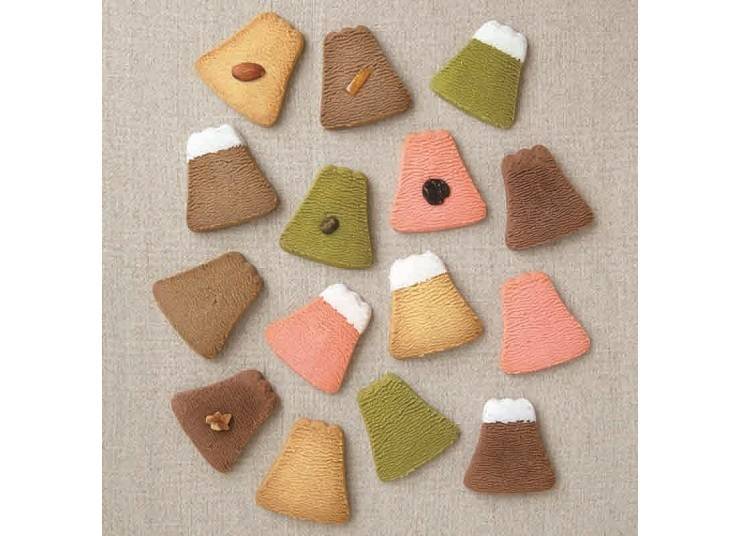
As we leave the Mt. Fuji Panoramic Ropeway, our day trip to the Kawaguchiko area and its spectacular scenery draws to a close. We board the Kawaguchiko Sightseeing Bus (Red Line) (150 yen one way) and return to Kawaguchiko Station.
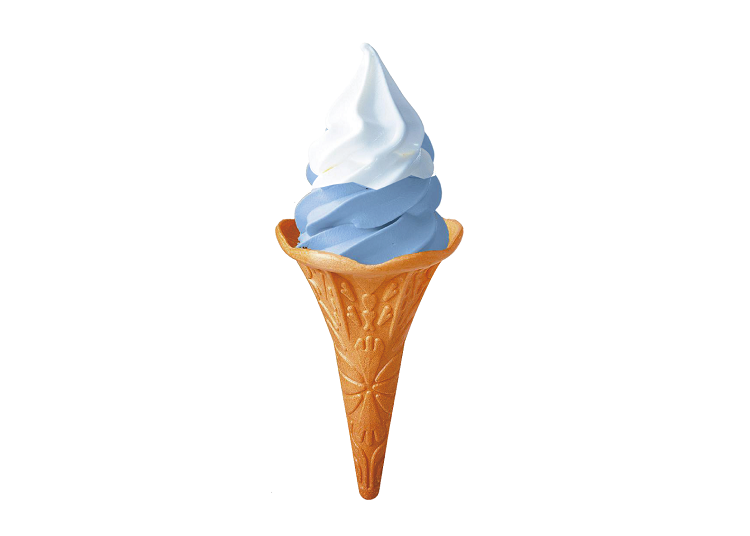
Before we depart from Kawaguchiko Station and head back to Shinjuku , we have one final opportunity for shopping. Gateway Fujiyama Lake Kawaguchi is an antenna shop that boasts a wide array of locally renowned products and souvenirs. Among them, the Fujiyama Cookie, shaped like the iconic Mt. Fuji, holds particular appeal for tourists. This delectable treat is crafted using Japanese flour, honey sourced from Mt. Fuji, cheese, and other carefully selected ingredients, resulting in a beautifully baked cookie. Its exquisite flavor lingers with each bite, leaving a delightful taste in your mouth. The cookie's charming depiction of Mt. Fuji, combined with its aromatic texture and taste, contribute to its immense popularity. Within the same establishment, you'll find the Fujiyama Cafe , a section dedicated to rustic cuisine and beverages prepared with locally sourced ingredients. Here, you can savor the specialty of the region, Yoshida Udon (650 yen, tax included), a country-style noodle dish. Additionally, you can indulge in Fujiyama Soft (370 yen, tax included), a double-layered soft ice cream cone designed to reflect the vibrant colors of Mt. Fuji.
- Phone Number 0555-72-2214
・Open: Monday-Friday: 9 AM - 6 PM; Saturday & Holidays: 9 AM - 7 PM ; Sunday: 8 AM - 7 PM ・Prices: Vary depending on the product. ・Closed: Open year-round from July to September; Unscheduled holidays from October to June.
Experience the wonders of Mt. Fuji like never before by booking a Mt. Fuji Tour! For visitors who prefer a guided experience over a self-directed one, these tours offer a fantastic opportunity to explore the iconic mountain with the expertise and insights of knowledgeable guides. Sit back, relax, and let the professionals take care of all the logistics while you immerse yourself in the breathtaking scenery and rich history of Mt. Fuji.
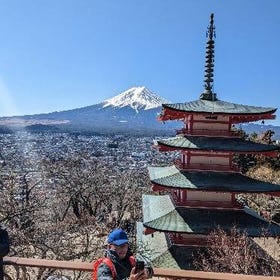
Written by Tomoya Nakazawa
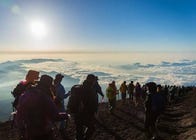
- Area Mt. Fuji
- Category Forests & Mountains
- How To: Visiting Popular Spots
Share this article.
Limited time offer: 10% discount coupons available now!
Le Travel Style
by Courtney Delfino • a San Diego based travel + lifestyle blog inspiring you to travel in style
Japan , Travel · Last Updated: April 27, 2024
The Ultimate Day Trip to Mount Fuji
The ultimate day trip to mt fuji: a 1 day itinerary.
Looking for a day trip to Mt Fuji? In the land of the rising sun, where ancient tradition seamlessly intertwines with modernity, one towering icon stands as a testament to Japan’s natural grandeur – Mount Fuji. Standing tall at over 12,000 feet in the clouds Mount Fuji, also known as “Fuji-san” in Japanese, is an iconic symbol of Japan and holds significant cultural and spiritual importance to the Japanese people. It has been depicted in countless paintings, poems, and other artworks, often representing the beauty and mystique of Japan.
Travelers from around the globe flock here to witness its awe-inspiring beauty firsthand. It was one of the prettiest places I have been and I’ve outlined the perfect Day Trip Itinerary to Mt Fuji. So join us on an unforgettable journey as we embark on a day trip to Mount Fuji. Immersing ourselves in the breathtaking landscapes, rich history, and spiritual allure of Japan’s tallest peak.
While all opinions and recommendations are always my own, my content on this blog post may contain affiliate links for hotels I’ve traveled to, tours I’ve completed, and products I recommend. This means I get a small commission (at no additional cost to you) if you book a stay or purchase a product after clicking one of these links. As always, I am so thankful for your support so I can continue to offer free resources.
Tokyo to Kawaguchiko Station Early Morning (6am-8am)
Departure from Tokyo: To ensure you maximize every moment of your day trip to Mt Fuji, kick off your journey by catching the Shinkansen departing directly from Tokyo station at the crack of dawn. The Shinkansen, bullet train, will take around 2 hours and you’ll want to book your seats in advance. We traveled from Shinjuku station and purchased tickets from the counter the day we arrived in Tokyo. Opting for seats on the right side of the train heading towards Kawaguchiko Station. That way you can see the beauty of Mount Fuji out your train window before arriving.
Being that you can eat on the bullet trains pick up a quick breakfast at the station before departure. Finally, if you’re traveling around Japan for more than 10 days then consider getting an unlimited Japan Rail Pass. This is if you plan on using the JR train line for the majority of your trip. There is a JR Pass calculator you can use to see if it’s worth it or not!
Arrival in Kawaguchiko Rental Car Pick-Up (8 am-9 am)
Given the limited public transit options and overcrowded buses, renting a car in Mount Fuji is a must. Having a car will offer you more flexibility and convenience to explore the region at your own pace. Luckily, the car rental place in the parking lot of Kawaguchiko Station would be a convenient option for travelers. As it allows for easy access to transportation as soon as you arrive. Make sure to book ahead of time because there are limited cars available. Finally, do note that you drive on the right side of the car in Japan. Finally, if you want to sit back and relax to enjoy the journey consider hiring a private driver for the day.
Chureito Pagoda and Arakurayama Sengen Park (9 am-11 am)
Arakurayama Sengen Park, nestled in the picturesque city of Fujiyoshida in Yamanashi Prefecture is a beautiful park that offers visitors a serene escape and unparalleled views of Mount Fuji. The iconic Chureito Pagoda is the most appealing in this park. The park is renowned for its iconic five-storied Chureito Pagoda. Which stands atop a hill, providing a stunning vantage point for capturing the beauty of Japan’s highest peak. It’s especially beautiful in the fall because the pagoda’s iconic red structure is in harmony with the surrounding landscape of autumn. Cherry blossom season is another popular time to visit because the Pagado is surrounded by blooming blossoms.
Beyond its aesthetic appeal, Chureito Pagoda holds cultural significance, serving as a symbol of peace and tranquility. Whether admiring the sunrise casting a golden glow upon Fuji’s majestic silhouette or capturing the ethereal beauty of the autumn colors. A visit to Chureito Pagoda is an unforgettable experience. Finally, do note you will need to ascend quite a few steps (398 to be exact) to reach this viewpoint so make sure to wear comfortable shoes.
Explore Lake Kawaguchiko + Surrounding Areas (11 am-2 pm)
Kawaguchiko Lake offers visitors a serene escape into nature’s tranquility and breathtaking beauty. Kawaguchiko Lake, the second-largest of the Fuji Five Lakes, boasts crystal-clear waters that mirror the majestic silhouette of Mount Fuji on clear days. This creates a scene of unparalleled serenity. You can indulge in a variety of activities. From leisurely boat cruises on the lake to tranquil lakeside walks, taking in the stunning vistas of Mount Fuji.
Adjacent to Kawaguchiko Lake lies Oishi Park. A tranquil place renowned for its meticulously landscaped gardens and panoramic views of Mount Fuji. The park’s sprawling grounds are adorned with vibrant flowers, including seasonal blooms such as cherry blossoms, tulips, and lavender, creating a kaleidoscope of colors.
You can wander along tranquil pathways, pausing to admire the meticulously curated flora, or picnic amidst the blooming flowers, capturing the perfect photograph of Japan’s highest peak. This is a perfect place to grab lunch and try local delicacies like Hoto (thick noodle soup) or Fuji Soba (buckwheat noodles). Whatever you do, don’t miss out on grabbing an ice cream from the park’s concession stand. It may have been the best ice cream we have EVER had! Finally, if you’re looking for an incredible brunch spot with views you can’t miss The Park Cafe Lake Yamanaka.
Hidden Gem: Tenku-no Torii (2 PM – 4 PM)
“Tenku no Torii,” translated as “Torii Gate in the Sky,” is a hidden gem in Mount Fuji. This iconic structure was built as a place to pray at Mount Fuji from a distance. It blends traditional Japanese design with spiritual symbolism. It truly is a breathtaking view. You need to pay a small fee to take a photo here. It costs around 500 yen and they are open daily from 9 am to 4 pm. Finally, it’s best to drive here as opposed to hiking. It can be challenging and scary since you have to hike on a windy road.
Down the road from this Tenku-no Torii, thanks to Google Maps we stumbled upon another hidden gem, this beautiful waterfall. Haha no Shirataki Waterfall is roughly a 15-minute walk from Tenku no Torii. Do note, you will need to walk through a campground to access it. But believe me when I tell you, it’ll be worth the trek!
Traditional Kaiseki Dinner (5:00 PM – 6:30 PM):
For dinner indulge in a traditional Japanese Kaiseki dinner. A kaiseki dinner is a traditional Japanese multi-course meal that showcases seasonal ingredients and meticulous presentation. It is often served in small portions to highlight flavors and textures. It emphasizes harmony, balance, and respect for the ingredients, embodying the principles of Japanese culinary artistry.
In Fujiyoshida, there are several establishments renowned for their exceptional kaiseki dinners:
- Fuji Onsenji Yumedono : This ryokan (traditional Japanese inn) offers luxurious kaiseki meals featuring local seasonal ingredients, with a serene ambiance and views of Mount Fuji.
- Konansou : Another renowned ryokan in Fujiyoshida, Konansou, offers exquisite kaiseki dinners focusing on traditional flavors and artistic presentation, complemented by panoramic views of Mount Fuji.
- Hotel Kaneyamaen : Known for its elegant dining experience, Hotel Kaneyamaen serves kaiseki dinners that highlight the flavors of Yamanashi Prefecture, with meticulous attention to detail and a serene atmosphere.
- Yoshimura : A well-established restaurant in Fujiyoshida, Yoshimura specializes in kaiseki cuisine, offering meticulously crafted dishes that reflect the essence of Japanese culinary tradition.
- Ryokan Fujisan Mishima-tei : This ryokan combines traditional hospitality with exquisite kaiseki meals, showcasing local produce and seasonal delicacies in a peaceful setting near Mount Fuji.
Sunset at Chureito Pagoda 7pm – 8:30pm
One of the prettiest views I have ever seen was a fall sunset overlooking the Chureito Pagoda. If you have it in you to ascend those stairs once more I highly recommend experiencing this renowned beauty at sunset. It’s the perfect way to reflect on the day’s experiences and capture memorable moments.
Day Trip to Mt Fuji: Best Accommodations in the Mount Fuji area
Some of the best accommodations in the Mount Fuji area cater to various preferences and budgets:
- Traditional Ryokans : For an authentic Japanese experience, consider staying in a ryokan such as Fuji Onsenji Yumedono or Yamadaya Hotel , known for their elegant tatami rooms, soothing hot spring baths, and exquisite kaiseki dinners.
- Luxury Hotels : Options like Fuji View Hotel offers luxurious amenities, stunning views of Mount Fuji, and impeccable service, ensuring a memorable stay amidst unparalleled comfort.
- Lakeside Resorts : Accommodations like Kozantei Ubuya or Mizno Hotel provide picturesque views of Lake Kawaguchi, along with modern comforts and easy access to attractions such as Fuji-Q Highland and the Chureito Pagoda.
In conclusion, a day trip to Mt Fuji offers a rich tapestry of cultural immersion, scenic beauty, and adventurous exploration. From indulging in the exquisite flavors of kaiseki dinners in Fujiyoshida and Fujikawaguchiko to marveling at the majestic views of Japan’s iconic peak, this itinerary promises unforgettable experiences for travelers of all interests. I encourage readers to embark on their own ultimate Mount Fuji day trip, ready to discover the wonders that await amidst this celebrated landscape!
Don’t miss more of my Japan Travel Guides !
You’ll Also Love
Leave a reply.
Your email address will not be published. Required fields are marked *
Save my name, email, and website in this browser for the next time I comment.
An Ultimate Travel Guide To Lake Tahoe in The Summer
- Privacy Policy
- Work With Me
Copyright © 2024 Le Travel Style · Theme by 17th Avenue

Five Awesome Mount Fuji Day Trip Itinerary Ideas
Dear reader: This article contains links to products and services that I may be compensated for, at no extra cost to you.
So you’re heading on a Mt. Fuji day trip from Tokyo? With only one day, you may need a bit of luck to get a clear view of the elusive mountain. But not all hope is lost, as there are many other great things to do in Mt. Fuji area, whether you get clear views of not.
With limited time, you’ll want to come armed with a good Mount Fuji day trip itinerary. Below I will detail five awesome and totally different Mt. Fuji day trip ideas, because different people have different ways to travel, right? If you most important concern is seeing Japan’s most iconic mountain from the best spots, check out my article on the 10 best Mount Fuji viewpoints !
For this article, I’ve focused on the Fuji Five Lakes area, where the best places to see Mount Fuji can be found. Hakone, which is a little further away from the mountain, also offers great Fuji views when skies are clear. See this other article for more info on a Hakone day trip from Tokyo .
If you end up deciding to stay at Mount Fuji for more than just one day (I would strongly recommend it!) then I’ll recommend some accommodation options below, including this amazing traditional minshuku that I stayed in with a view of Mt. Fuji right in front of it.
At the end, I’ll also cover how to get to Mt. Fuji from Tokyo or from destinations to the south, such as Osaka and Kyoto.
Besides Mount Fuji, don’t miss Kamakura, another great day trip from Tokyo . Also see my cherry blossoms guide to Osaka , autumn foliage guide to Kyoto , and best places to see in Japan in winter .
Table of Contents
Getting to Mt. Fuji
– I’ll be recommending several tours from Klook, my preferred provider of small group tours. You can get a free credit in your account if you sing up with this link !
– Book a discounted Japan SIM card or an Unlimited WiFi Device before you arrive in Japan. You’ll definitely want Internet access for finding your way around!
– I recommend using 12Go for buying individual bus and train tickets to the Mt. Fuji area.
– The Fujikyuko retro-style sightseeing buses are the best way to get around the Mount Fuji region.
– Want to travel in absolute comfort? Charter a car for the day from Tokyo!
Idea 1: Mt. Fuji Day Tour from Tokyo

Maybe you don’t want to figure out all the planning & buses by yourself. Or perhaps you want to eliminate stress about missing your bus back to Tokyo. Then taking a Mount Fuji day tour from Tokyo may be the best choice for you!
There are many Mt. Fuji day tours available. They come with a wide variety of different ideas and attractions For example, you can even go skiing on Mt. Fuji on a day trip from Tokyo !
When shopping for your ideal Mount Fuji day tour, keep an eye out for the following activities listed:
Gotemba Premium Outlets Shopping
One of the largest outlet malls in Japan, Gotemba Premium offers great views of Mt. Fuji combined with a modern shopping experience.
Almost all tours, such as this one (classic day tour on GetYourGuide) this one (classic day tour on Klook), this one (tour with onsen experience), this one (with stop at Chureito Pagoda), this one (with Fuji 5th station), and this one (Hakone and Fuji tour) include a shopping stop there.
If you want a Mount Fuji day tour with NO SHOPPING, try this one .
Mt. Fuji Ropeway
The Mt. Fuji Panoramic Ropeway (formerly called Kachi Kachi Cable Car) ascends 400 meters to the top of Mount Tenjo for epic views of Mt. Fuji and Lake Kawaguchiko. The cable car is named after a folk story about a rabbit and a tanuki (Japanese raccoon), so you’ll see lots of imagery relating to the two animals up there.
The Mt. Fuji Ropeway is included on this tour and this tour .
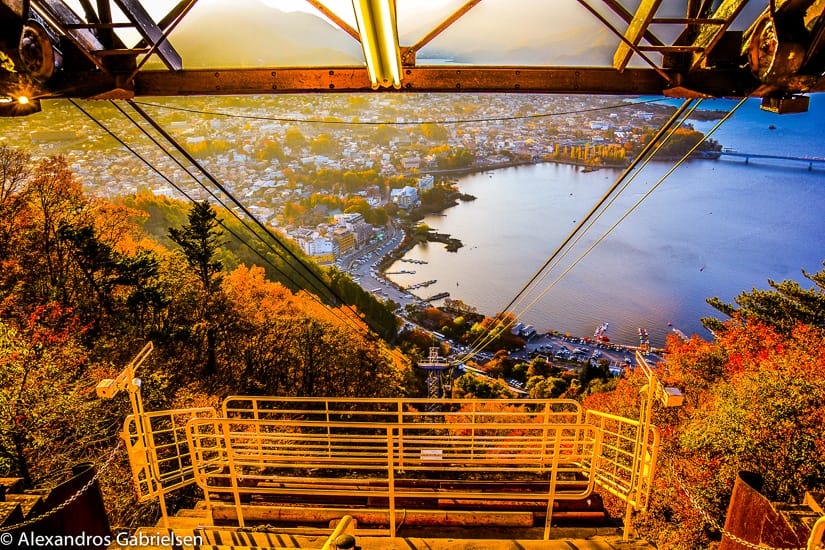
Oshino Hakkai
In this tourist’s village, eight scenic ponds are surrounded with traditional Japanese farmhouses, with Mount Fuji views dominating the background. It is located in Oshino, a small village between Lake Kawaguchi and Lake Yamanaka.
Oshino Hakkai is included on this tour , this one , and this one .
Fuji 5th Station
Fuji 5th station lies about halfway between the traditional starting point of the Mount Fuji climb at Fuji Sengen shrine and the peak of Mount Fuji.
The village is accessible almost year-round, and offers both stunning views of the peak of Mount Fuji and down to the Fuji Five Lakes. Fuji 5th station is included on many tours, including this one and this one .
Chureito Pagoda
This shrine is most famous for having what is perhaps the single most famous view of Mount Fuji, from behind Chureito Pagoda.
Chureito Pagoda is included on this tour .
Love temples? Check out my articles on staying at a temple in Koyasan and the impressive Kumano Sanzan temples in Wakayama
Idea 2: Mt. Fuji Adventure Day Trip
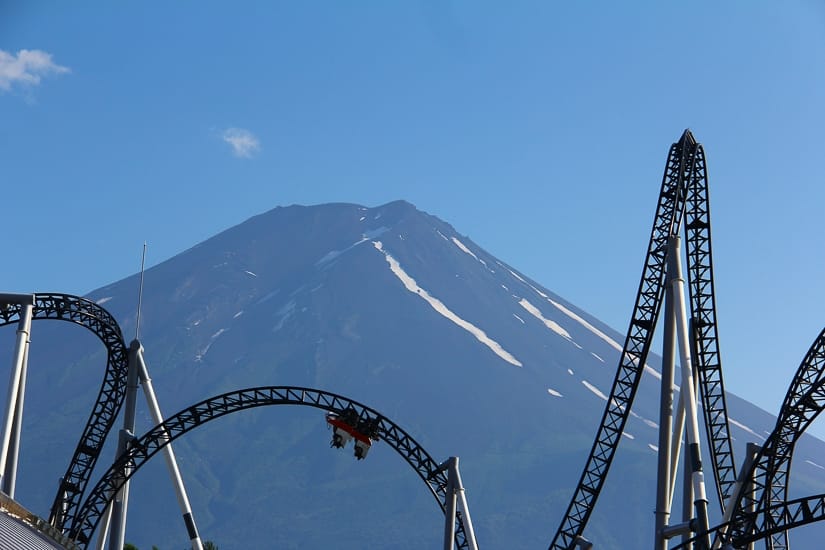
For thrill seekers, here’s a Mt. Fuji itinerary for you. This large amusement park sits very close to the base of Mt. Fuji, offering the chance to see one of the world’s most famous mountains from the top of a roller coaster!
Start your day by heading directly to Fuji Q Highland. This deal includes transfer from Tokyo and entrance tickets. Or get there on your own by booking your transportation on 12Go , then get a discounted admission ticket here .
Some of the most awesome rides in the park include 79-meter Fujiyama , the world’s 8th tallest, 5th longest, and 10th fastest roller coaster, Dododonpa a shorter but even faster roller coaster, Eejanaika , a “4th dimension” roller coaster, and Takabisha , the world’s steepest roller coaster. There are are several haunted attractions, a Ferris wheel, and rides where you get wet.
There is even an onsen (¥1,400 weekdays/¥1,700 weekends, only ¥620 7-9 am) beside Fuji Q, with a view of Mt. Fuji from the relaxation area. There also many restaurants inside Fuji Q to choose from for lunch.
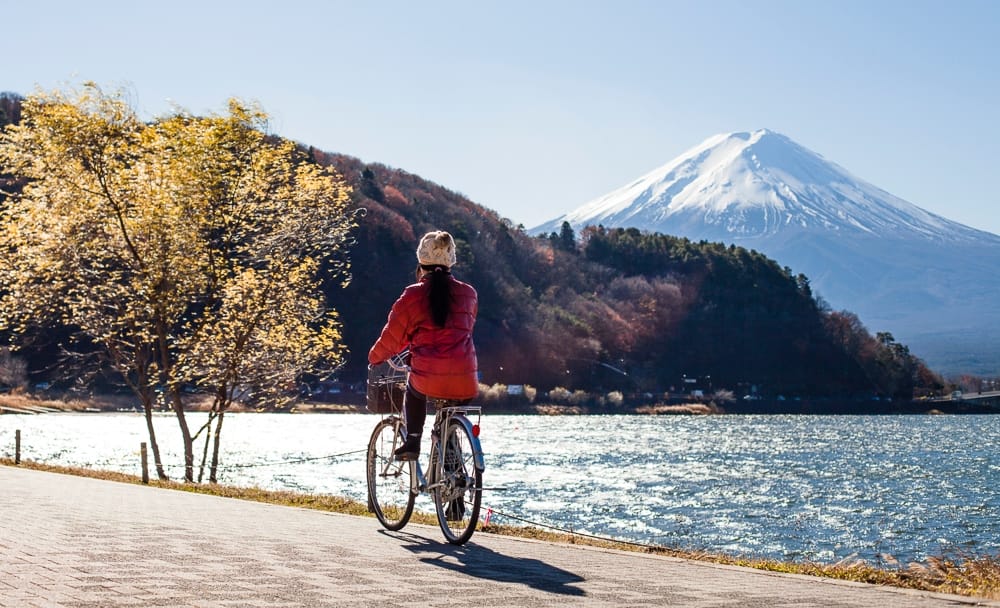
After you’ve had your fill of rides (and lunch), hop on the Fujikyuko bus to Mt. Fuji Yamanakako station (40 minutes) and hire a bicycle (¥1500 for the day) to ride on the dedicated cycling path around the lake, taking in incredible Fuji views along the way.
At the end of your ride, go for a soak in Onsen Benifuji No Yu (10 am to 9 pm, from 6 am on weekends and in winter, ¥700), a (nude only) hot spring which offers Mt. Fuji views. Visitors with tattoos may not be allowed.
Make sure to book your return ride back to Tokyo , and don’t miss the last one!
When it Tokyo, don’t miss the geeky attractions of Akihabara district !
Idea 3: Explore Kawaguchiko
Kawaguchiko, or Lake Kawaguchi, is the most famous and visited of the Fuji Five Lakes. The train station and bus station are located about 10 minute’s walk from the south side of the lake, while postcard-worthy Mt. Fuji views can be enjoyed from the north side.
After traveling from Tokyo to Kawaguchiko , the red line of the Fujikyuko sightseeing bus departs from Kawaguchiko station to all the below sights. It is also possible to ride a bike or walk between many of them.
Start by taking the the bus (11 minutes) to stop #9 or walking (15 minutes) to the Mt. Fuji Panoramic Ropeway for epic Fuji views from the summit of Mt. Tenjo.
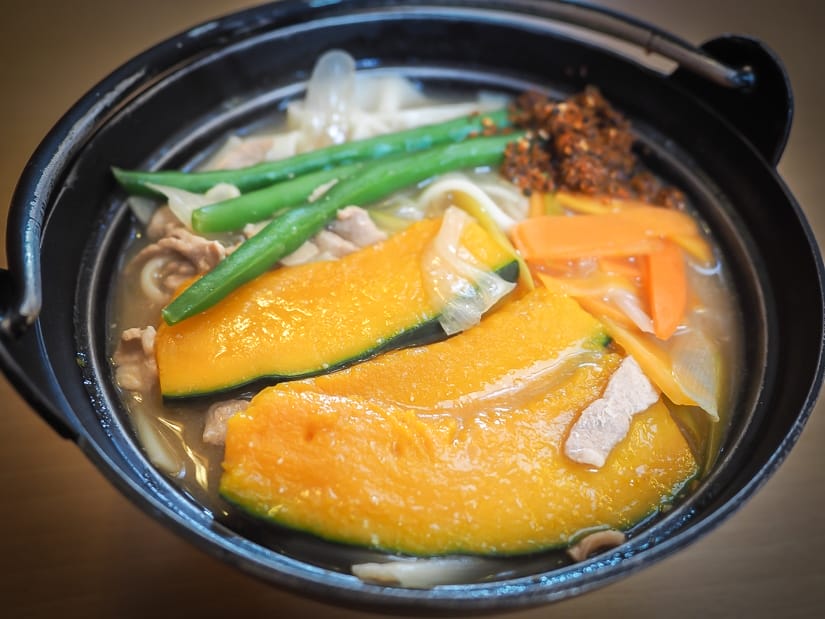
For lunch, take the bus to stop #15 (called “Kawaguchiko Music Forest Museum stop”). Go to Houto-Labo or Houtou Fudou for a lunch of “hoto”. This is a Yamanashi/Mount Fuji specialty that consists of thick udon noodles in a miso broth with pumpkin. Both restaurants are within walking distance of the bus stop.
Nearby, you can also pop into the Kawaguchiko Museum of Art (¥800, open 9:30-5), which houses a large collection of Fuji-related artworks, or the somewhat unusual Kawaguchiko Music Forest Museum (¥1,500), a musical theme park at the lakeside, which the bus stop is named after.
Another worthwhile stop is Kubota Itchiku Art Museum (stop #17), dedicated to a master of silk dying. On display you can see his unfinished masterpiece, an image of Mount Fuji made up of 80 kimonos. The museum is surrounded by lovely woods. Make sure to check whether it’s open before you go.
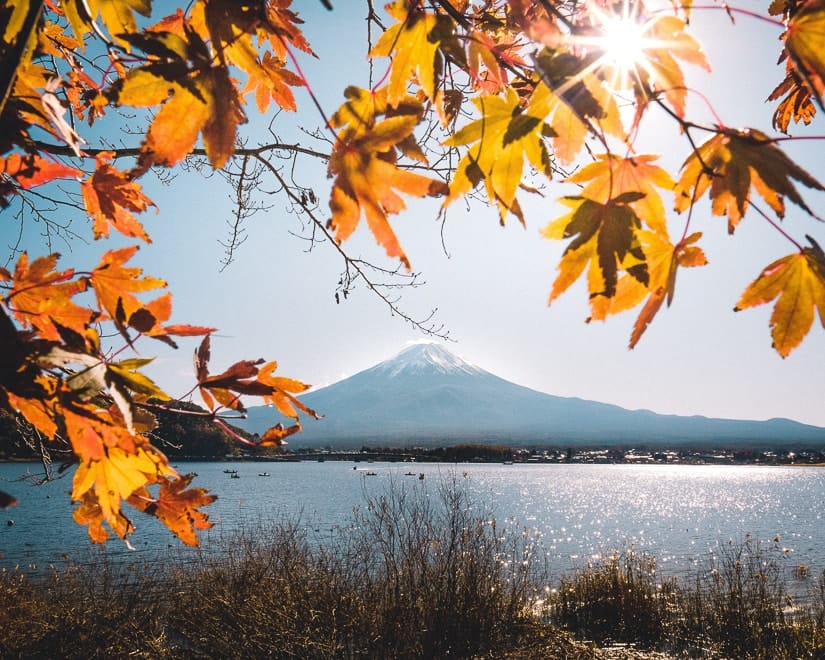
Nearby, the Maple Corridor is a must if you happen to visiting in autumn, while Nagasaki Park (stop #18) offers some of the finest Fuji views on this side of the lake.
If you continue to the end of the bus line (stop #20), Kawaguchiko Natural Living Center features lakeside gardens, fruit picking, and jam making.
Hey day-trippers, here are 40 awesome day-trip ideas from Taipei, Taiwan !
Idea 4: Sacred Sights & Culture
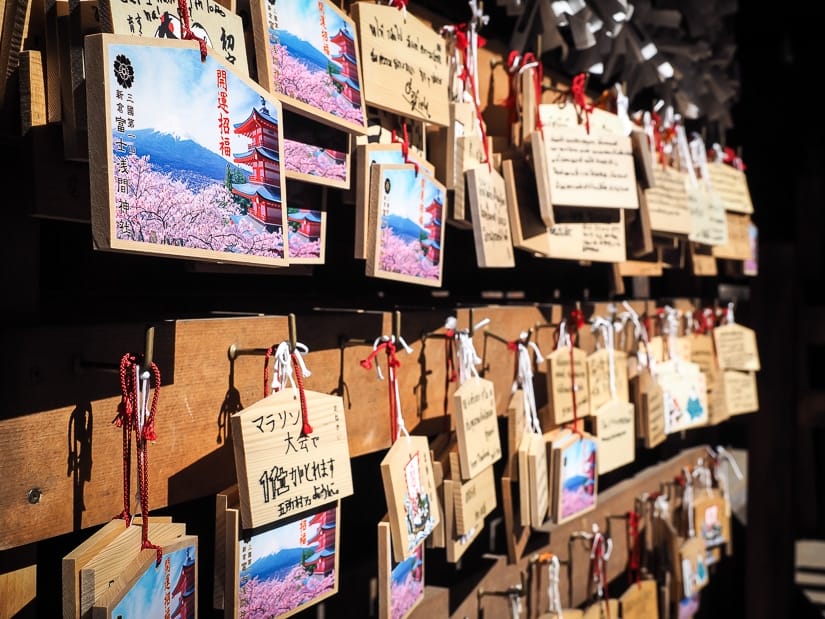
Mount Fuji is sacred to the Japanese. Since ancient times, it has been a Shinto pilgrimage site, a source of artistic inspiration, and a center of training for ascetic Buddhism. Today, there are more than 1000 Fuji Sengen shrines across Japan, which are dedicated to Princess Konohanasakuya, the deity associated with Mt. Fuji.
If you are interested in Mount Fuji’s spiritual connections, you should plan your Mt. Fuji day trip itinerary around visiting some of its most important temples.
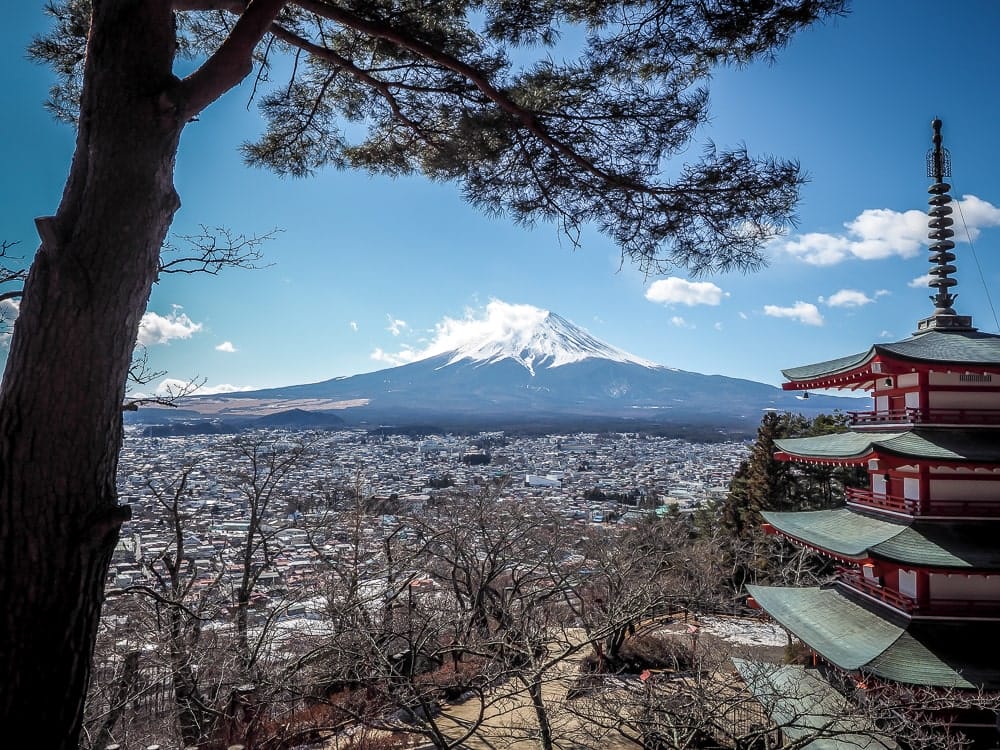
Since Mt. Fuji is usually best seen in the morning, try to take one of the earliest buses from Tokyo to Kawaguchiko .
Start your day by heading to Arakura Sengen Shrine (sometimes called Kawaguchi Sengen Shrine), pictured above. While the shrine itself is peaceful and worth a look, most people come for Chureito Pagoda , where one of Japan’s most iconic views can be enjoyed.
A trail of 398 steps lead to a position behind the pagoda with an unbeatable view of Mt. Fuji. Come in mid-April to add cherry blossoms to your shot, but be prepared for some serious crowds!
To reach Arakura Sengen Shrine, you’ll need to catch the train from Kawaguchiko to Shimo-Yoshida Station (10 minutes, ¥300). From there it’s a 10-minute walk, plus however long it takes you to get up those steps! If you don’t want to go through the transportation trouble, you can visit this pagoda on this organized day tour .
If you are interested in spiritual places, see my articles on hiking the Kumano Kodo pilgrimage and soaking in the sacred hot springs of Wakayama .
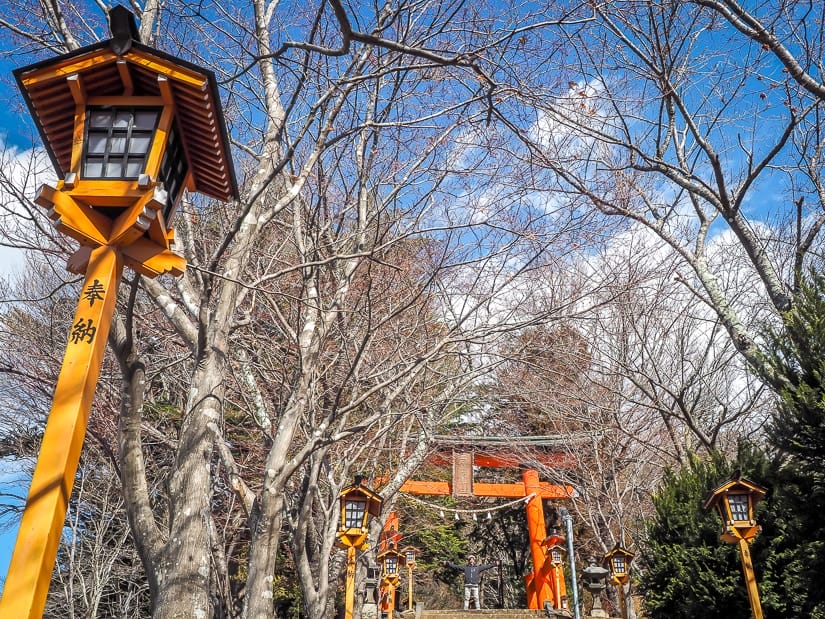
Next on your itinerary, hop on the train from Shimo-Yoshida Station to Fujisan Station (¥219, 6 minutes) to reach the second stop, Fuji Sengen-jinja Shrine (also known as Fujiyoshida Sengen Shrine or Kitaguchi Hongu Sengen Jinja).
The shrine is a 30-minute uphill walk from Fujisan train station. For lunch, you can try Musashi Udon along the way.
You an also get there in 20/10 minutes from Kawaguchiko/Fujisan station on the the Yamanaka Fujikyuko bus (stop at Kitaguchi Hongu Fujisengen Jinja-mae).
Besides these train + walking/busing options, you can hop on the World Heritage Loop bus from Arakura Sengen Shrine all the way to Fuji Sengen-jinja Shrine (30 minutes), but note that this bus doesn’t run from December 1 to March 31.
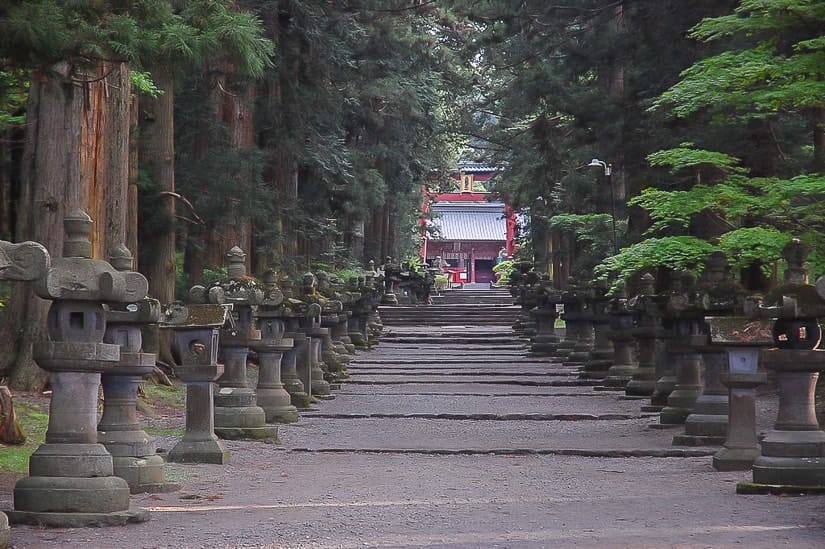
Fuji Sengen-jinja Shrine is the second most important of the three sengen shrines in the Mt. Fuji area (the most important is Fujisan Hongu Sengen Taisha on the other side of Mt. Fuji, but that’s a little too far to include on this Mt. Fuji 1 day itinerary!)
Fuji Sengen-jinja Shrine is also the historical starting point of the hike to the summit of Mt. Fuji from the north, so visiting here is an appropriate inclusion on your Mt. Fuji explorations. From the moment you enter via the long approach from the main road through a cedar forest, you will sense you are in sacred territory.
If you want to see the official start of the hike up to the peak of Mt. Fuji, you can find it to the right behind the main hall, although most hikers nowadays start halfway up the mountain at Fuji 5th Station.
From Fuji Sengen-jinja Shrine, you can also walk (15 minutes) to another smaller forest shrine called Arayayama Shrine , a quiet place dedicated to the god of economic fortune.
Finish your day by hoping back on the Yamanakako bound Fujikyuko bus and heading to Oshino Ninja Village (9am-5pm, ¥1800), and/or Oshino Hakkai (24 hours, museum 9am-5pm, ¥300) where you can learn about traditional local culture.
For a less touristy option, head to the northeast shore of Lake Kawaguchiko and find your way to Kawaguchiko Asama Shrine , a secluded shrine with an 18-meter Otorii (traditional gate) at the entrance and surrounded by 1200-year-old cedars.
Idea 5: Off-the-Beaten Track & Nature
If you prefer to escape the tourist crowds and get into nature, then this Mt. Fuji day trip option is for you. You’ll want to to catch an early ride to Kawaguchiko if you plan to squeeze the below itinerary into one day. Otherwise, you might have to skip a few stops, and make sure to keep an eye on those bus times if you need to get back to Kawaguchiko for your ride back to Tokyo.
For Kawaguchiko Station, hop on the Fujikyuko bus blue line to Koyo-Dai Entrance stop (27 minutes), which is one stop before Narusawa Hyoketsu (Ice Cave) and two stops before Fugaku Fuketsu (Wind Cave) stops.
From the bus stop, a small road runs north off the highway, which you can follow all the way to the peaks of three mountain-top lookout points with incredible views of Mt. Fuji and the Five Lakes: Koyo-Dai (1165m), Sanko-Dai (1202m), and Goko-Dai (1355m).
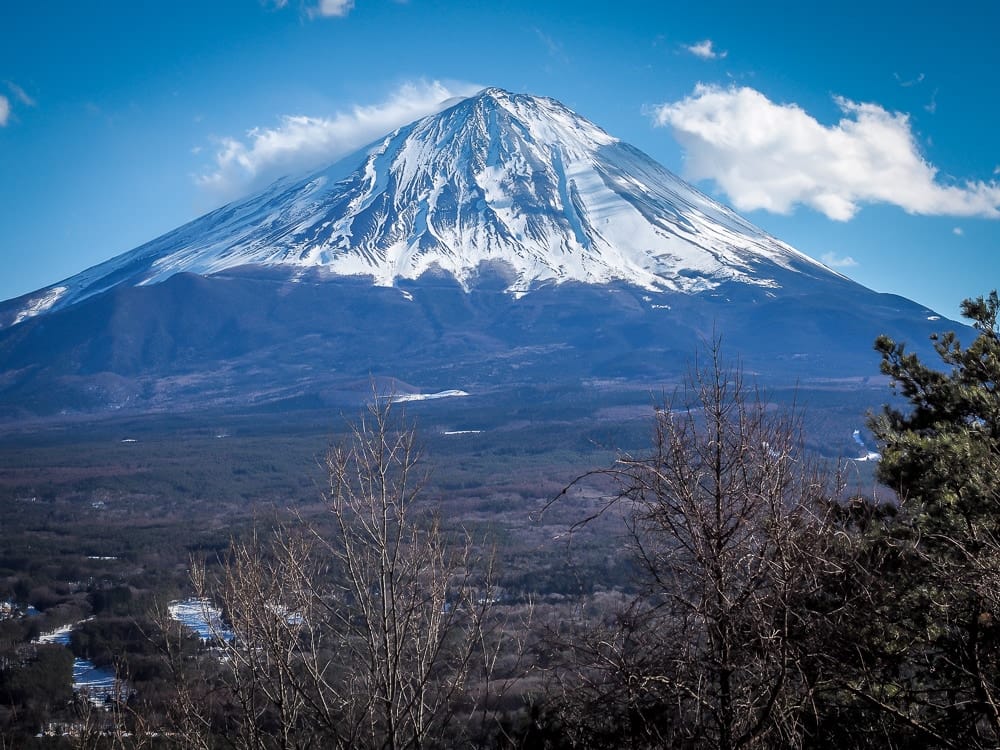
The road and trails are an easy but very rewarding hike, and can even be done in winter (as I did). You can budget an hour return for Koyo-Dai, where you’ll find a small café (closed when I visited) with a lookout platform.
It’s only another 10 minutes up from there to an even better viewpoint at Sanko-Dai (see the cover image of this article), where you can see three of the Fuji Five Lakes.

You’ll need about three hours return to make it all the way to Goko-Dai and back to the highway, but you’ll be rewarded with a view of all five lakes at the same time.
If you want to visit the other spots on this itinerary, I’d suggest sticking to Koyo-Dai and Sanko-Dai, which should take no more than 1.5 hours return.
Next, walk or take the bus one stop to Narusawa Hyoketsu (Ice Cave). After visiting the cave, you can follow a pretty trail (30 minutes) through the forest to similar Fugaku Fuketsu (Wind Cave), or hop on the bus for one stop.
The two caves were formed by molten lava when a flank volcano of Mt. Fuji erupted in the year 864. Both of them contain awesome tunnels, ice walls, ice pillars, and more, and have even been used to store silk worms.
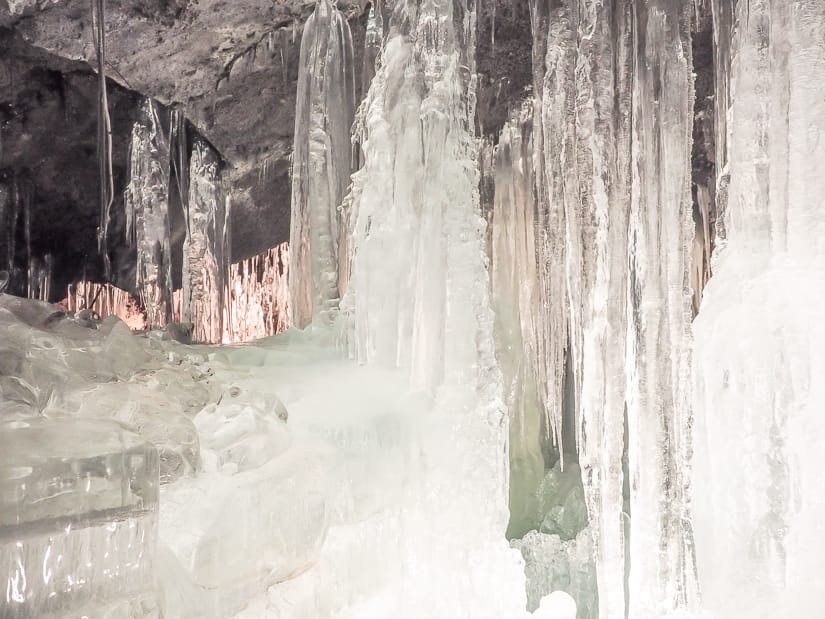
See more information on the website for the two caves , and note that there is a combined ticket if you plan to visit both.
From the Wind Cave, you can catch the green line of the sightseeing bus to remote Lai Sai (Saiko) , where you can visit Iyashi no Sato , a reconstructed traditional village with views of Fuji forming the background to Edo-era houses, which is a similar but less touristy version of Oshino Hakkai between Kawaguchiko and Yamanakako lakes.
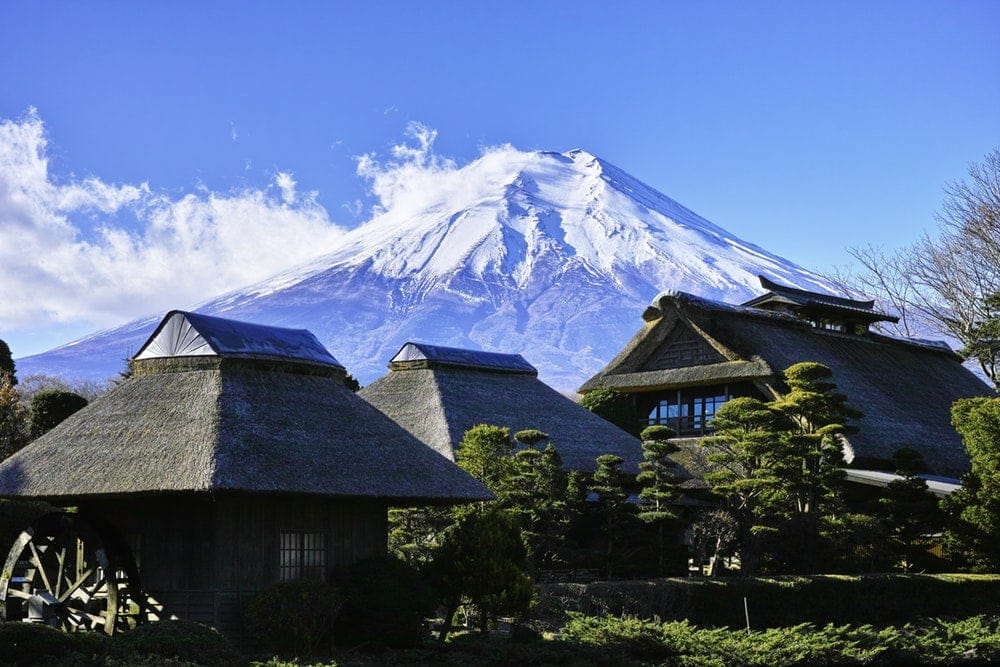
Another choice is to continue along the blue bus line to remote Lake Shoji (Shojiko) , which some say (and I personally agree) has the most beautiful Mt. Fuji views out of all the Fuji Five Lakes.
Get off at Kodaki Fuji View Point for the ultimate Fuji view. But beware; the last bus back from here to Kawaguchiko departs at 4:35 p.m, so if you want to see the sunset and get a shot like the one below, you’ll have to spend the night!
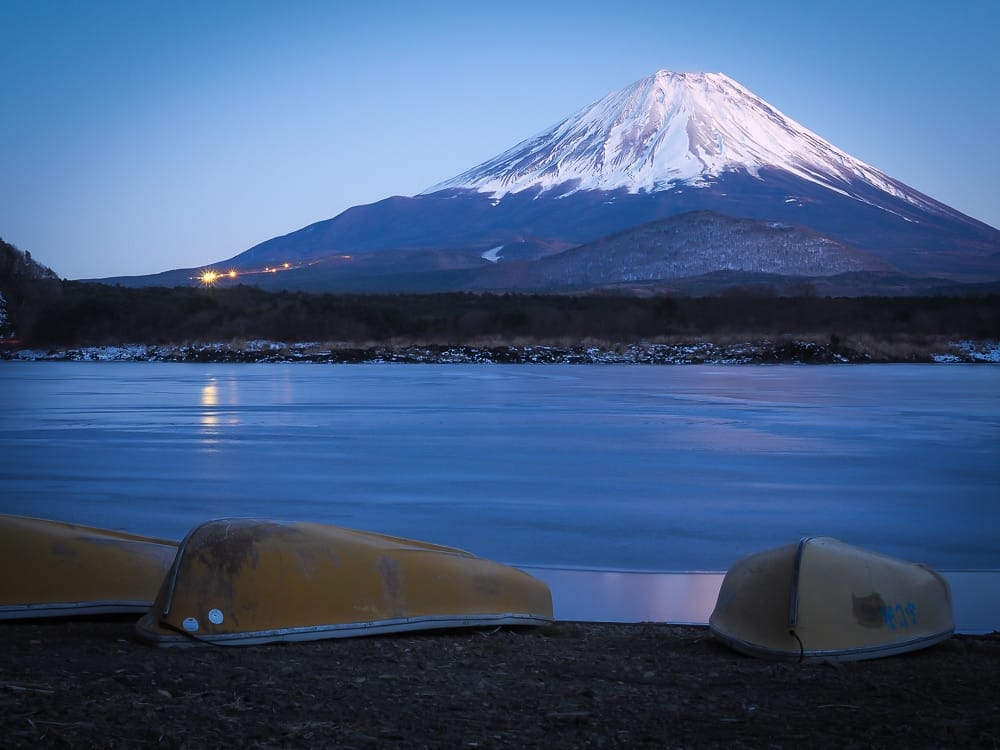
Lake Shoji is actually where I based myself when I visited the Mount Fuji region. There are only a few hotels on the entire lake, so it feels very unspoiled, and the scenery couldn’t be more beautiful. On top of that, the guesthouse where I stayed, Minshuku Murahamasou was the best traditional Japanese guesthouse I’ve ever stayed in .
The food was beyond incredible, and I truly felt I was being taken care of by my (Japanese) mother. The hosts’ American daughter in law was also available by email to answer all my questions in English before I arrived.
So if you end up getting stuck in Shojiko, or you decide to make your day trip to Mount Fuji and overnighter (and you love avoiding the tourist crowds), I can’t recommend this place enough!
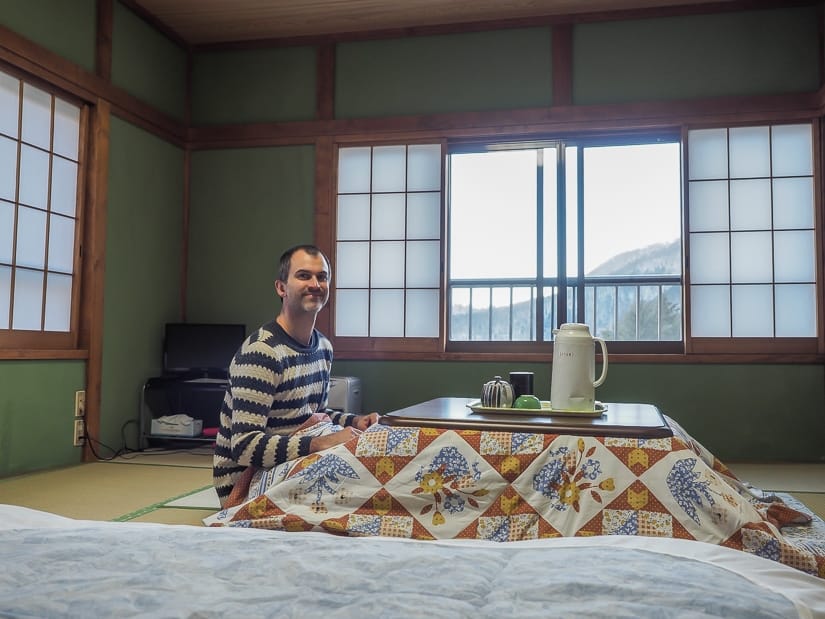
It would be tough to squeeze it into a one day itinerary for Mt. Fuji, but past Shoji Lake, the same bus (the blue line) also reaches the entrance to Motosuko (Motosu Lake) . From the bus stop at the entrance, you can walk (two hours return) to the famous 1000-Yen Viewpoint of Mt Fuji, pictured on the 1000-yen banknote.
There’s no walking path; you just have to walk along the highway, so I would only recommend this for people who REALLY want to see that view or are staying in the area longer.
Getting from Tokyo to Mount Fuji
Buses are the fastest and most convenient option for getting from Tokyo to Mount Fuji. The bus from Shinjuku or Shibuya station takes 1 hour 45 minutes and costs around ¥2000. It’s best to reserve your tickets online before you go and arrive at the station at least 30 minutes before departure.
If you head back to Tokyo during rush hour, the ride can take up to three hours.
Getting from Osaka to Mount Fuji on the Bullet Train
The Shinkansen (bullet train) travels from Shin-Osaka to Shin-Fuji station, and you can even see Mt. Fuji from the shinkansen as you approach Shin-Fuji station (sit on the left hand side!) What an exciting way to get your first glimpse of Mount Fuji! You can book your Shinkansen tickets here .
From Shin-Fuji station, there are only four buses per day to Mount Fuji , departing at 7:15, 9:45, 11:45, and 13:45. Make sure to time it right! The bus ride takes about two hours to Kawaguchiko, passing lakes Motosuko, Shoji, and the Wind/Ice caves, and you get lots of great Fuji views along the way.
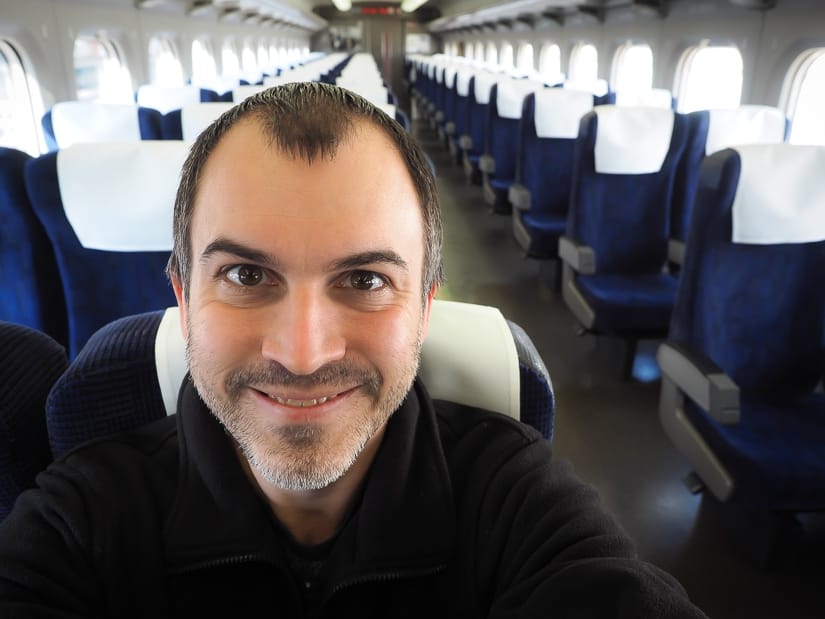
I hope you enjoy your 1 day trip to Mount Fuji, and please let me know in the comments below if you have any comments or questions!
Related Posts

11 thoughts on “Five Awesome Mount Fuji Day Trip Itinerary Ideas”
Hello, I would like to know if it is possible to go from Mont Fuji directly to Kyoto? What is the fastest way? Where does it start? Thank you a lot
Hi Jennifer, You can take the shinkansen from Kyoto to Shin Fuji Station. There’s actually a great view of Mt. Fuji from the station! Then take the bus to the Fuji 5 Lakes area. There are only 4 buses per day (last one 13:45), so make sure you get there early enough! https://bus-en.fujikyu.co.jp/pdf/rosen/timetable_shinfuji_201906.pdf
Hi Nick! Thank you so much for sharing these off-beaten guides, very informative. Question, do we need a guide in trekking the 3 peaks? We are hikers so planning to trek it on our own if trails are well marked. Thanks in advance!
Hi Mary Ann! Thanks for your comment, and I’m glad you were able to find some useful info here. Unfortunately, I haven’t personally trekked to any of these peaks, so I can’t say for sure whether a guide is necessary. I hope you are are able to find reliable info from someone who has!
Hi Nick! Thank you for this awesome guide for exploring Mt.Fuji. I would like to ask how much is the room rate of Minshuku Murahamasou? I have emailed them but still got no reply. Thann you so much
Hi there, you can find their room rates on their website: https://www.murahamasou.com/guestroom.html Their contact information is also on there. Sorry that I cannot help you further than that!
Hi Nick We are staying in Hakone, can you advise the best way to get to get to do Mishima Skywalk and Lake Kawaguchi from there. We are open to the option of staying closer for the night.
Hi Belinda, I’m sorry that I haven’t personally been to Mishima Skywalk or traveled from Hakone to Kawaguchiko. I hope you find the info you are looking for!
Hello Nick!
Thank you for such an informative blog.
Wondering if Highland Fuji Q and Lake Kawaguchiko (cable car and ship cruise) is doable for a day trip?
Thank you kindly, Leah
Sure, I think it’s possible if you get an early start to your day. You can spend 2-3 hours at Fuji Q, budget about 1 hour for the cable car, and still time to fit in a ship cruise as well.
Leave a Comment Cancel reply

- Visa Application Helpline
Subscribe to our newsletter
Learn how to live a sustainable long-term travel lifestyle.
By signing up, you agree to the our terms and our Privacy Policy agreement.
Top 27 Places to visit in Darjeeling, Explore the Beautiful Hills of Darjeeling
Top 10 things to do when traveling to shimla: shimla travel guide, the ultimate paris travel guidelines for first timers | top attractions & things to do.

The Best Day Trip to Mount Fuji: How to Plan the Perfect Day Trip
Being the highest peak in Japan, with an elevation of 3,776.24 m, Mount Fuji attracts both common people and artists. The graceful conical form of the mountain is near to perfect. Throughout centuries, this active volcano has gained fame as the country’s sacred location. Though the view of the peak is often covered by clouds, visitors assemble near the mountain just to try their luck. When you are on a trip to Japan, a visit to Mount Fuji is a must.
Whether you’re a first-time visitor or a seasoned traveller, a day trip to Mount Fuji offers an opportunity to admire the mountain’s stunning views, hike on its trails, and learn about its rich history and culture. With proper planning and preparation, a day trip to Mount Fuji can be a memorable and enjoyable experience. Even if you have tough luck and miss the view, there are so many things that you can do around.
WHAT IS COVERED IN THIS ARTICLE?
Recommended tours & tickets
History of mount fuji.

Not every traveller wants to know about the history of a place they are about to visit because histories are boring. But some do. And some histories are worth knowing. The sacredness of Mount Fuji dates back to the 7th century.
According to some ancient indigenous inhabitants of Japan, the name Mount Fuji may have derived from the words Fuchi and san, which mean fire and mountain. So, the local people call it Fujisan, and some tourists incorrectly call it Mount Fujiyama. So, here’s a reminder for you: Whether you call it Fujisan or Fujiyama, don’t add Mount before it.
Until the mid-19th century, women were forbidden to climb mountains. Now, it’s a religious and tourism destination, open to both men and women. Several temples and shrines are located on and around the vast mountain.
Mount Fuji has been a frequent subject in Japanese art and literature, which reminds me of this beautiful quote by Miyamoto Musashi- “Aspire to be like Mt. Fuji, with such a broad and solid foundation that the strongest earthquake cannot move you, and so tall that the greatest enterprises of common men seem insignificant from your lofty perspective.
With your mind as high as Mt Fuji, you can see all things clearly. And you can see all the forces that shape events, not just the things happening near to you.”
How to Reach Mount Fuji

Mount Fuji is located in central Japan, near the border of the Shizuoka and Yamanashi prefectures. There are several ways to reach the mountain, depending on your starting point and mode of transportation.
- By train: From Tokyo , you can take the shinkansen (bullet train) to Shin-Fuji Station or Gotemba Station and then transfer to a local train or bus to get to the base of the mountain. If you are going from Osaka, you can take the shinkansen to Shin-Fuji Station and then transfer to a local train or bus to get there.
- By bus: From Tokyo, get on a bus from Shinjuku Station or Shibuya Station to the 5th Station of Mount Fuji. And from other nearby cities, you can do the same to reach the 5th Station of Mount Fuji.
- By car: From the capital of Japan, you can drive on the Tomei Expressway and then take the Fuji-Subaru Line to reach the 5th Station. And from Osaka, you can drive on the Meishin Expressway and then take the Gotemba Line to reach the 5th Station.
It’s important to note that during the climbing season, from July to September, the roads to the 5th Station can be congested, and parking can be limited. It’s recommended to use public transportation during this time.
Once you reach the base of the mountain, you can start your hike from one of the four main trails to the summit: the Yoshida Trail, the Subashiri Trail, the Gotemba Trail, or the Fujinomiya Trail. There are also some guided tours you may choose.
Where to Stay at Mount Fuji

There are several options for accommodations near Mount Fuji, depending on your preferences and budget. Here are a few options to consider:
- Mountain huts: Some of the trails, such as the Yoshida Trail, have mountain huts that offer basic accommodation for climbers. These huts fill up quickly during the climbing season, and reservations are recommended.
- Hotels: There are several hotels located in the towns around Mount Fuji, such as Fujiyoshida , Fujinomiya , and Gotemba . These towns offer a wide range of accommodations, from budget-friendly options to luxury resorts.
- Ryokans: A Ryokan is a traditional Japanese inn, typically featuring tatami mat floors, futon beds, and communal hot springs. These are great options for those looking for a more authentic Japanese experience.
- Campsites: Camping is also an option near Mount Fuji. There are several campsites located around the base of the mountain, such as the Fujisan Highland Campground and the Aokigahara forest campsite.
- Capsule hotels: Capsule hotels are a budget-friendly option which offers small, private capsules for sleeping. They are a good option for solo travellers or for those on a budget.
It’s a good idea to book your accommodation in advance, especially during the peak climbing season from July to September. Keep in mind that some accommodations may have limited availability due to the pandemic, so it’s best to plan ahead.
Things to Do in and Around at a day trip to Mount Fuji
Climbing the mountain.
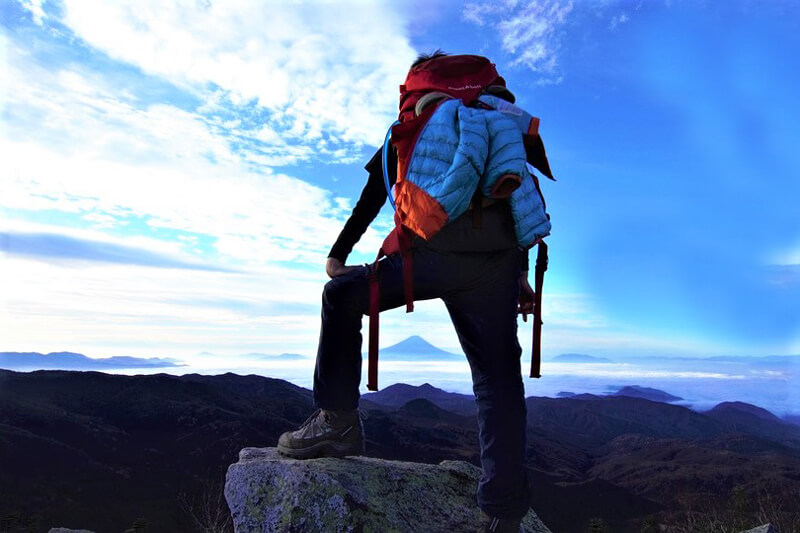
Be it Mount Fuji or any other mountain, the first and best thing to do is climb it. The official climbing season of Mount Fuji is from early July to mid-September. It’s summer in Japan during these months, and all the trails and mountain facilities are available. A one-way climb to the mountain can take around 4-8 hours, depending on the trail.
Though you’d be climbing the mountain in summer, the weather is cold at the peak, so be well-dressed. The air will become thinner as you climb up, so avoid this excursion if you aren’t physically fit for this. If you follow one of the more popular trails, like the Yoshida Trail, expect crowds. Suppose you want to stay in one of the mountain huts available at the 7th and 8th stations, book in advance.
The Fuji Subaru Line 5th Station is the entrance to the most popular Yoshida Trail, so it’s the most popular base for climbing the gigantic Mount Fuji. There are many resting places, shops and restaurants available at this Station. You can prepare yourself for the hike or rest here for a while.
Enjoying the Views of Mount Fuji
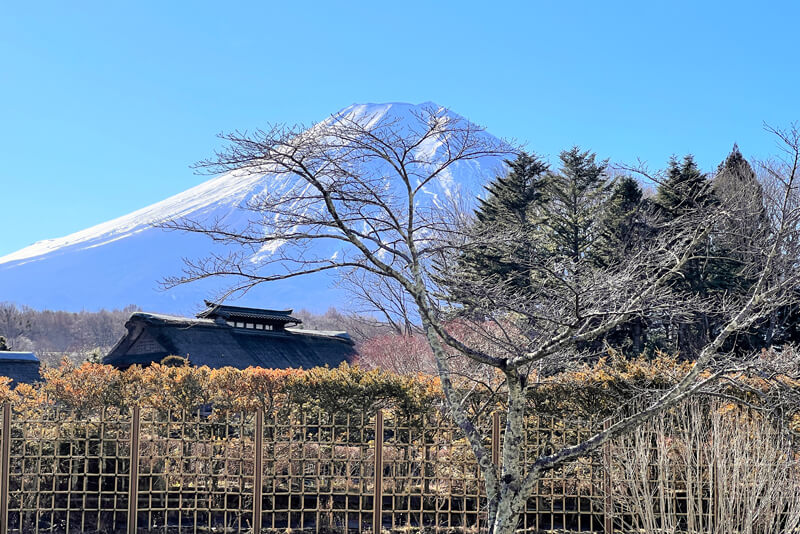
The easiest thing to do around Mount Fuji is to enjoy its views. You might’ve seen that view in calendars or boxes of chocolate, but seeing the live view is entirely a different feeling. The view of the summit of the mountain is mostly seen during winter.
However, that’s not promised. Consider yourself lucky if you are able to get a view of the peak. The best places to get views of the mountain and click some cinematic pictures are three in number, namely, Fuji Five Lakes, Chureito Pagoda, and Oshino Hakkai.
Explore the Fuji Five Lakes

At the base of Mount Fuji, five bodies of water with different sizes and characters meet up. Collectively known as the Fuji Five Lakes or Fujigoko in the local language, the lakes offer the best views of the mountain and so many other activities to try out.
All the lakes have great accommodation options and a number of tourist attractions around them, some of which are more popular than others. Kawaguchiko is considerably the best one based on the fact that you get fantastic views of the mountain from there and it is easily accessible by public transport.
Because of its reputation, its surroundings have been quite developed over time. However, it must be mentioned that the other lakes also stand out for a number of reasons.
Have fun at the Fuji Q Highland

Do you want to enjoy watching Mount Fuji while on a rollercoaster? If your answer is affirmative, then I think Fuji Q Highland is exactly the place you’d want to check out. Popular for being home to some of the best rollercoasters in Japan, Fuji Q Highland will give you the right amount of adrenaline rush that you are craving for.
The park features four rollercoasters with different world-class specialities. For children, kid-friendly rides and attractions are available. You’ll also find restaurants, souvenir shops, a Resort hotel and a spa at the location. The amusement park, particularly its roller coasters being famous, often remains crowded on weekends and holidays.
Location: 5 Chome-6-1 Shinnishihara, Fujiyoshida, Yamanashi 403-0017, Japan
Opening Hours: Monday – Friday | 10:00 am – 5:00 pm, Saturday – Sunday | 10:00 am – 6:00 pm
Get on the Mt. Kachi Kachi Ropeway

The Mt. Kachi Kachi Ropeway , located next to Lake Kawaguchiko , ascends 400 metres to the peak of Mt. Tenjo. The observation deck at the peak of Mt. Tenjo is located 1000 meters above sea level and offers amazing views of Mt. Fuji, Lake Kawaguchiko, and the surroundings. The ride only takes a few minutes, and most tourists opt for a round trip on the ropeway.
However, there’s also a hiking trail that descends from the observation deck through the forested mountain slope. So, hikers need not be disappointed.
Location: 1163-1 Azagawa, Fujikawaguchiko, Minamitsuru District, Yamanashi 401-0303, Japan
Opening Hours: Monday – Friday | 9:30 am – 4:20 pm. Saturday – Sunday | 9:30 am – 5:20 pm
Visit Chureito Pagoda

Previously I’ve mentioned in this article that you get mesmerizing views of Mount Fuji from Chureito Pagoda . But this isn’t the only reason why you should visit the pagoda. This five-storied pagoda is immensely loved by photographers as they get to click some beautiful shots of Japan.
It overlooks Fujiyoshida city, and the location gains tremendous beauty during Spring and Autumn. The cherry blossoms in April, the view of Mount Fuji and the five-storied red pagoda- the combination of these three is a treat to the eyes.
Location: 2-chome-4-1 Asama, Fujiyoshida, Yamanashi 403-0011, Japan
Opening Hours: Everyday | 8:00 am – 5:30 pm
Enjoy a Hot Spring Bath at Hakone

With around 17 hot spring sources in the town, Hakone is the most popular onsen area in Japan. There are a number of hot spring resorts, bathhouses, and ryokan(traditional Japanese inns) available in the region. Some of these resorts and inns offer views of Mount Fuji while you enjoy a hot spring bath. Here are a number of places where you can enjoy a hot spring bath while observing Mount Fuji:
- Fuji Lake Hotel
- Fujikawaguchiko Onsen Konanso
- Hotel Green Plaza Hakone
Visit Fujiyoshida Sengen Shrine

As I’ve mentioned before, Mount Fuji is home to many temples and shrines, and Fujiyoshida Sengen Shrine is the most popular among them. There are thousands of such shrines in the country dedicated to the Shinto deity Princess Konohanasakuya. The shrine is located inside a dense forest, and you have to follow a long path lined by stone lanterns and tall cedar trees to reach there.
Once, the shrine was the main starting point for climbing the mountain from the north. You can find the trailhead behind the right side of the main hall. However, the distance to the summit from this trail is double compared to the Fuji Subaru Line 5th Station. That’s why most hikers prefer to skip this trail.
Explore Obushi Sasaba
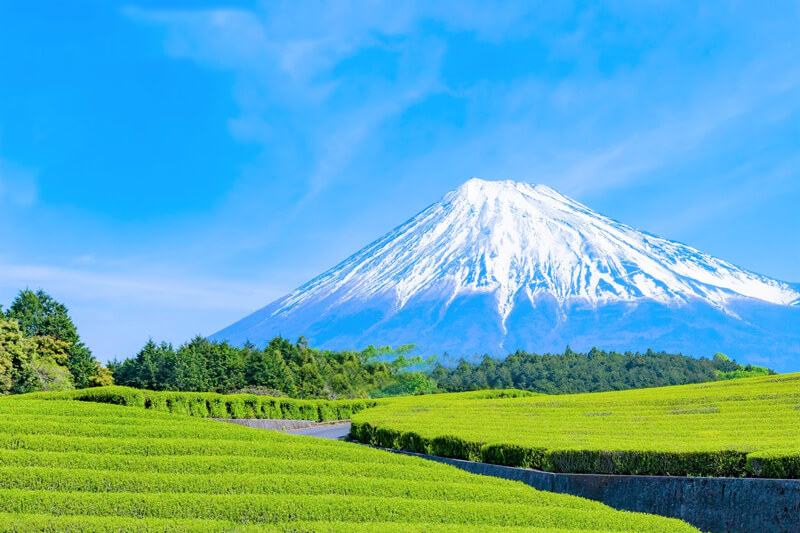
Have you ever seen a tea plantation with a gigantic mountain in the background? Maybe not. So you should check out Obushi Sasaba to enjoy the gorgeous view. If you want to get a view of the snow-capped Mount Fuji and the lush tea gardens in a single frame, you should head there during mid-April.
The spot remains filled with crowds, so you should visit early in the morning. Keep in mind that the plantations are private property, so do not enter there or disturb the locals. If you take photos quietly, they won’t interrupt you.
Location: 1445 Obuchi, Fuji, Shizuoka 417-0801, Japan
Opening Hours: Everyday | 24 hours
Walk Around Aokigahara Forest

Aokigahara Forest , also known as the “Sea of Trees”, is the number one suicide spot in the country. Although the entire forest isn’t very popular with tourists, people visit it as some popular caves are located there. But why don’t people like to walk around the forest? Well, they believe it’s haunted. The forest barely has any wildlife, and always a quietness persists there.
Because of this, people choose it as a suicide spot, and also many ghost stories are popular about it. Most locals don’t even dare to go inside the forest. But the forest offers a sense of solitude to visitors, which is loved by many. If you believe in ghost stories and myths, you can avoid visiting the forest. But if you want to enjoy calmness, a walk around the forest might be a great idea.
Location: Narusawa, Fujikawaguchiko, Minamitsuru District, Yamanashi 401-0300, Japan
Visit Narusawa Ice Cave

Located in the centre of Aokigahara Forest, the Narusawa Ice Cave was formed when Mt. Nagao erupted. Long ago, people used the cave as a natural refrigerator. The average temperature inside this lava cave is around 3°C. The cave features ice walls and pillars all year round. You can also check out the other two caves, Fugaku Wind Cave and Lake Sai Bat Cave, located around the same spot.
Location: 〒401-0320 Yamanashi, Minamitsuru District, Narusawa, 鳴沢8533
Opening Hours: Everyday | 9:00 am – 4:00 pm
Explore Oshino Hakkai

Oshino Hakkai is a dreamy small village centring eight small ponds formed by snowmelt. The water of the ponds is very clear and suitable for drinking. The ponds are now counted as tourist attractions. Surrounding the ponds, you are most likely to find several souvenir shops, restaurants and food vendors. There’s also a small museum, Hannoki Bayashi Shiryokan, near the largest pond. Oshino Hakkai is a perfect place to wander around while enjoying the views of Mount Fuji.
Location: Shibokusa, Oshino, Minamitsuru District, Yamanashi 401-0511, Japan
Visit Fuji Safari Park
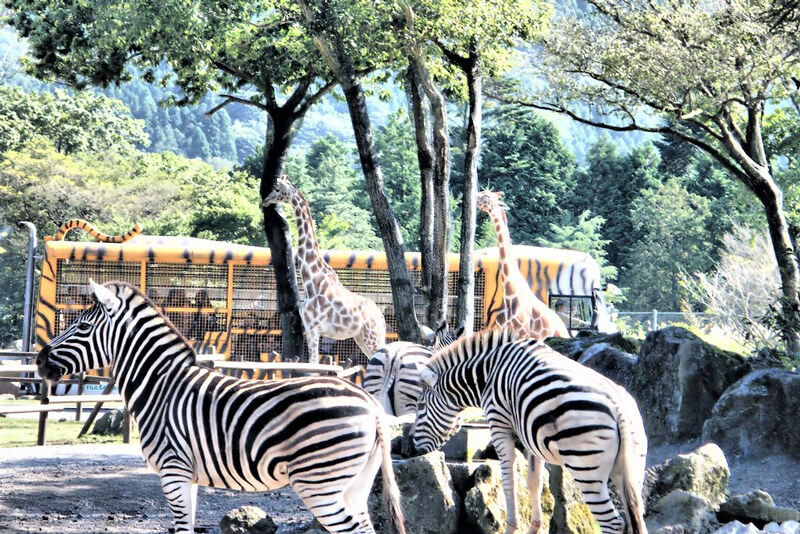
At the foot of Mount Fuji, Fuji Safari Park houses around 70 species of 900 animals. The animals roam around freely in the expansive Safari Zone, which is quite identical to their natural habitat. You can roam around the park by car or get on a Jungle Bus.
From the bus, you can feed large animals coming near, and you might even feel their breath as they come too close. There’s also a Fureai Zone (petting zoo area) where you can feed animals and observe some rare animals closely. You can also enjoy horse riding in this area. It’ll take you around an hour to roam around the entire park.
You can also explore the park on foot following the 2.5 km long trail that opens from late March to November. If you choose to walk, you’ll need around 2 hours to complete. There are a number of restaurants and souvenir shops inside the park.
Location: Japan, 〒410-1231 Shizuoka, Susono, Suyama, 字藤原2255−27
Opening Hours: Everyday | 10:00 am – 3:30 pm
Enjoy Views of Cherry Blossoms near Mount Fuji
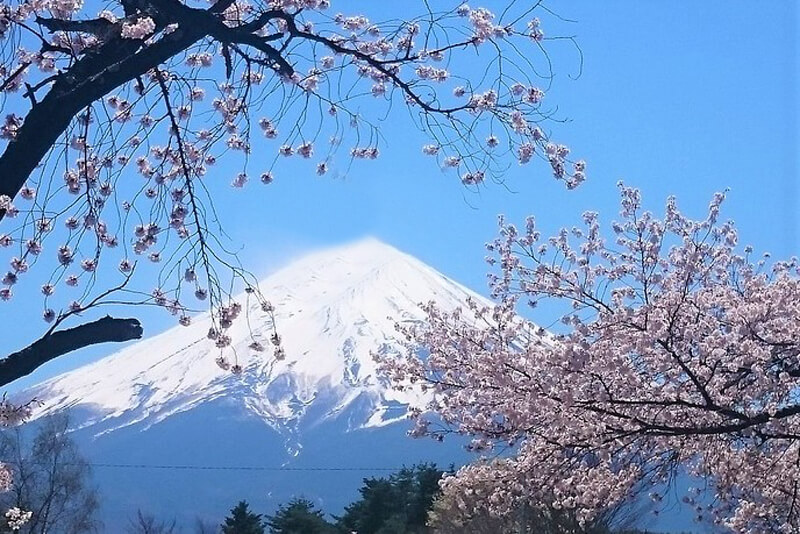
Around Mount Fuji, there are a number of places that offer the best views of cherry blossoms . The scenic combination of the Mount Fuji view and cherry blossoms shouldn’t be missed. You can view cherry blossoms near Kawaguchiko, Oshino Hakkai or Chureito Pagoda.
However, to get the best scenic views of cherry blossoms, the perfect place is the Urui River. The cherry trees lined along the beautiful river stream are extremely popular among photographers. To get the best views, have a visit there between late March and early April.
Shop at Gotemba Premium Outlets

Have you ever thought about shopping around Mount Fuji? If you haven’t, then you must. Gotemba Premium Outlets is one of the most popular shopping areas in Japan. There are around 300 stores and restaurants, along with a food court, a Ferris wheel, a hotel, and a hot spring bath open to the public.
You can buy anything from daily use items to luxury goods at the stores. You will also find stores of internationally renowned brands at the mall. The shops offer a variety of goods at reasonable prices.
Location: 1312 Fukasawa, Gotemba, Shizuoka 412-0023, Japan
Opening Hours: Monday – Friday | 10:00 am – 7:00 pm, Saturday – Sunday | 10:00 am – 8:00 pm
Mount Fuji Trails: A Guide
There are many trails around Mount Fuji, and they’re all beautiful. Mount Fuji has four main trails that lead to the summit: the Yoshida Trail, the Subashiri Trail, the Gotemba Trail, and the Fujinomiya Trail.
- Yoshida Trail: The Yoshida Trail is the most popular and well-maintained trail and is also the most crowded during the climbing season. It starts at the Fuji Subaru Line 5th Station and is 8.9 miles (14.3 kilometres) long. This trail is well-equipped with facilities such as toilets, mountain huts and rest stations. It is also easily accessible from Tokyo. The trail is often known as the “beginners’ trail”.
- Subashiri Trail: The Subashiri Trail is a less crowded alternative to the Yoshida Trail and is also known for its beautiful autumn foliage. It starts at the Subashiri 5th Station and is 7.8 miles (12.5 kilometres) long. The trail is well-equipped with mountain huts and toilets, but not as many as the Yoshida Trail. It is a challenging route and requires around 8 hours to complete.
- Gotemba Trail: The Gotemba Trail is the longest trail, starting at the Gotemba New 5th Station, and is 13.1 miles (21 kilometres) long. It is the least crowded trail and has the least amount of facilities. This trail is recommended for experienced hikers who want to avoid crowds.
- Fujinomiya Trail: The Fujinomiya Trail is the shortest trail to climb Mount Fuji. It starts at the Fujinomiya 5th Station and is 4.7 miles (7.6 kilometres) long. This trail is well-maintained but can be crowded during the climbing season, as it takes only 5 hours to climb. It is also known for its beautiful sunrise views from the summit.
You should remember that all trails to the summit of Mount Fuji require a high level of physical fitness. It’s also important to note that the climbing season is typically from July to September, and hikers should be prepared for changing weather conditions.
Best Time to Visit Mount Fuji
Mount Fuji is one of the most beautiful mountains in Japan, but it’s not just a pretty picture. The mountain is also a popular tourist destination, and it can get busy during the official climbing season (which runs from July to September). If you want to climb the mountain, you must go there during these months. And since it’s a short time, the mountain remains crowded with hikers. If you choose to climb the mountain off-season, it can get really risky.
However, if you don’t want to climb up to the summit of the mountain and just want to check out the views, we recommend visiting Mount Fuji in the early spring or winter, that is, in April and December. During spring, you will be able to see cherry blossoms and witness many eye-soothing views around the mountain. And during winter, you will get to see views of different parts of Mount Fuji, including its base and its summit.
Mount Fuji Packing List
Regardless of how you choose to climb Mount Fuji, it’s important that you make sure you pack correctly. Here are some packing essentials to bring on your trip to Mount Fuji:
- Hiking clothes: Pack layers of clothing to accommodate for changing weather conditions. The temperature can drop significantly at higher elevations, so bring a warm jacket and pants. Also, a waterproof jacket and pants are essential in case of rain or bad weather.
- Climbing Gear: It’s best if you have your own gear because it will save you money and reduce the risk of damage to equipment or people who may be carrying it themselves. Make sure everything fits into your backpack before leaving home so that nothing gets lost along the way!
- Hiking boots: These should be comfortable, waterproof, and provide good support for your feet.
- Water Bottles: Hydration is key when climbing a mountain because it will help keep your energy levels up throughout the day without making you feel tired or dizzy. Bring enough water bottles with you so that they don’t spill while being packed away into your backpack or other containers during transport from one place to another (which could cause injury). You should bring at least 2 litres of water and a water filter or purification tablets to ensure a safe supply of drinking water.
- First Aid Kit: A basic first aid kit with bandages, gauze, and pain relievers is recommended.
- Headlamp or flashlight: This is necessary for the early morning ascent and for navigating the descent in the dark.
- Backpack: Bring a backpack that is large enough to carry all your gear, including water, food, and extra layers of clothing.
- Food: Bring high-energy snacks, such as energy bars, nuts, and dried fruits, to keep you going during the hike.
- Sunscreen and sunglasses: The sun can be intense at higher elevations, so protect your skin and eyes.
- Maps: It’s a good idea to bring a map of the trail, as well as a compass, to help you navigate.
- Camera: To capture the beautiful views of the mountain and your adventure.
- Waste bag: Bring a waste bag to carry out any trash or waste.
It’s also important to note that mountain huts are available on the trails, but they fill up quickly during the climbing season, and reservations are recommended.
How to Maintain Safety While Climbing Mount Fuji
Climbing Mount Fuji is beginner-friendly. However, no matter how easy it is to climb this gigantic mountain, you must be aware of your safety. Here are a few tips for maintaining safety while climbing Mount Fuji:
- If you decide to climb Mount Fuji, make sure you have enough climbing equipment (including ropes and carabiners).
- You should wear comfortable clothes that don’t restrict your movements or put pressure on your joints after climbing. You should also wear appropriate clothing like long pants or shorts and sleeves long enough, so they don’t get caught on trees or rocks while moving around during your climb.
- Make sure your feet don’t slip on the rocks while walking or climbing because this could cause an accident or fall off the mountain! If you do decide to climb Mount Fuji, make sure that your shoes are made out of leather or rubber, so they provide extra protection against slipping on loose rocks or ground debris.
- Wear a helmet and stay hydrated.
- Always follow the instructions of your guide, especially if they tell you to stop for any reason.
- The most important thing to remember before climbing Mount Fuji is that it’s a volcano. While there are no active eruptions at this time, if you’re climbing near the summit, you should still be aware of nearby volcanic activity from eruptions in past years. This means that there may be rocks falling from above you as well as hot springs, steam vents, and other hazards that could catch on fire or explode without warning.
- Stop whenever you feel tired or want to rest.
- Don’t hike alone. If you aren’t a professional hiker, never dare to climb Mount Fuji during the off-season. During the official season, a lot of climbers climb the mountain, so you will be safe.
- The air gets thinner and cooler as you climb up. So, don’t miss out on warm clothing.
- If you face altitude sickness or feel any physical problems, don’t force yourself to climb the mountain. Take a rest at different stations to get used to the altitude. If the sickness prevails, go down to a lower elevation.
In conclusion, Mount Fuji is a must-see destination for any traveller to Japan. With its stunning views and rich cultural significance, it offers a unique and unforgettable experience. Whether you choose to hike to the summit, admire the mountain from a distance, or participate in a traditional Fujikawaguchiko hot spring, there is something for everyone to enjoy.
However, it is important to plan ahead and be prepared for the trip, as the weather can be unpredictable, and the hike can be challenging. With the right preparation and a bit of luck, your visit to Mount Fuji will be a highlight of your trip to Japan.
Frequently Asked Questions
Why is mount fuji famous.
Mount Fuji being, the tallest mountain in Japan, is widely popular for its beautiful symmetrical snow-capped conical form. Its beauty has inspired many writers, poets, and artists to consider it as a subject of their work. However, most locals prefer it as a pilgrimage site.
When is the official climbing season of Mount Fuji?
The official climbing season of Mount Fuji runs from July to September. During these months, all the trails and mountain facilities are available. It is not allowed to climb the mountain during any other time out of the official climbing season as it includes risks.
Which is the easiest trail to follow in order to climb Mount Fuji?
There are four trails that lead to Mount Fuji, Yoshida Trail being the most famous and easily accessible. It is also the one with the most facilities, line first-aid centres, doctors, mountain huts and even vending machines.
Is climbing Mount Fuji risky?
You should remember that Mount Fuji is an active volcano. And during the off-season, the mountain slope remains slippery due to snow. So, climbing the mountain is risky during the off-season.
How difficult is it to climb Mount Fuji?
Climbing Mount Fuji is considered a moderate to difficult hike. The trail is steep and rocky in places, and the altitude can make the climb more challenging. It’s important to be in good physical shape and to be adequately equipped with the right gear and clothing.
How long does it take to climb Mount Fuji?
The typical ascent time for most hikers is around 6 to 8 hours, and the descent takes about 4 to 5 hours. However, it can vary depending on your pace and level of fitness. Some hikers choose to do the climb in a single day, while others choose to stay overnight at one of the mountain’s huts.
Do I need a guide to climb Mount Fuji?
No, you do not need a guide to climb Mount Fuji. The trail is well-marked and easy to follow. However, hiring a guide can be beneficial for those who are not familiar with the mountain or who want a more personalized experience.
Is it possible to see Mount Fuji from Tokyo?
The visibility of Mount Fuji from Tokyo can be limited due to the city’s pollution and the mountain’s distance from the city. The best chances of seeing Mount Fuji from Tokyo are during the winter months when the air is typically clearer, and the mountain is more visible.
Related Posts
The ultimate guide to the best time to travel to japan, discover the serenity of oshino hakkai village: a complete guide, the best 10-day japan itinerary: exploring tokyo, kyoto, and osaka, explore asakusa: top 21 things to do and see.
Save my name, email, and website in this browser for the next time I comment.
This site uses Akismet to reduce spam. Learn how your comment data is processed .
Type above and press Enter to search. Press Esc to cancel.

The Perfect Mt. Fuji Day Trip – Itineraries, Tours, and More
David Taylor
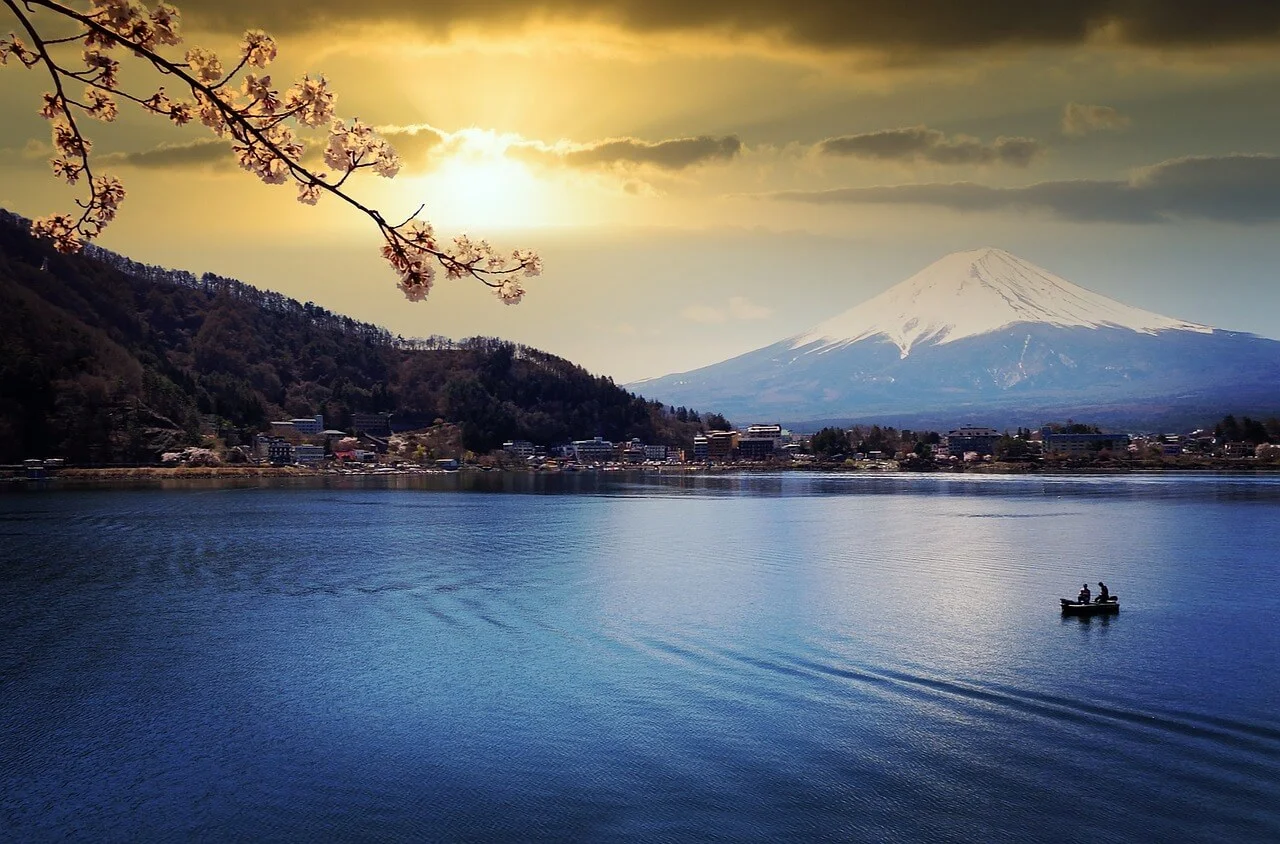
Looking for a breath of fresh air after spending time in Japan’s big cities? Look no further than Mount Fuji, one of the most incredible outdoor destinations Japan has to offer.
There are plenty of set tours with a number of price ranges for first timers. However, with Japan becoming more accessible to English speakers, it’s never been easier to personalize your journey.
By the end of this guide, you’ll have a customizable blueprint that will allow you to experience Mount Fuji and the surrounding areas in your own unique way.
Getting to Mt. Fuji
The first, and (probably) most important step for enjoying a trip to Mount Fuji, is getting there.
There are a number of ways to get to Mount Fuji, and if you’re coming from abroad it depends on which airport you arrive in. Tokyo is the most logical starting point and has the most options in terms of transportation.
If you’re coming from Tokyo, you have three main options for getting to Mount Fuji:
- Highway-buses are the most convenient option and run from Tokyo (Shibuya, Shinjuku stations) and other locations across Japan.
- Driving, for those who are willing to pay a little more for the extra freedom and comfort.
- A bullet train to one of the closer cities that offer tours or busses from there.
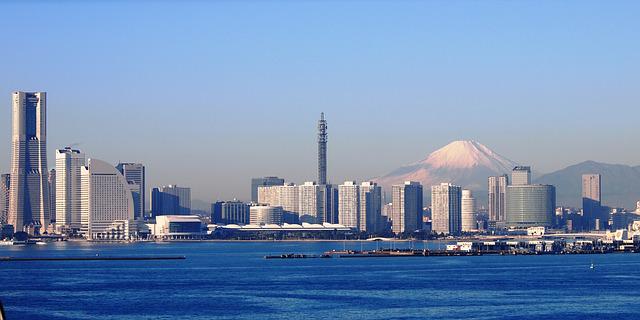
If you decide on taking the train or bus, there are several smartphone navigation apps that’ll make planning the trip a lot easier.
Compared to Tokyo, Kyoto is a bit far from Mount Fuji. So, if possible, it’s best to plan your trip from Tokyo and make your way to Kyoto after that.
However, if you wake up early enough in Kyoto and get bullet train tickets for one of the first departures, there’s no reason you can’t pack in a full day of fun around Mount Fuji.
Take the shinkansen (bullet train) to Mishima station and transfer to the Fuji Q bus bound for Kawaguchi-ko station. Between train and bus, the cost is about ¥13,000 and takes about 3.5 hours total. Take a look at the bus times via Mishima station for yourself and plan accordingly.
How Long Is the Drive From Tokyo to Mt. Fuji?
Driving from Tokyo to Mount Fuji takes between 2-3 hours depending on traffic. The Chuo expressway is the quickest option, but there is a toll. The fee is based on car size, with regular cars costing up to ¥5000 and smaller ones (kei cars with yellow license plates) closer to ¥4000.
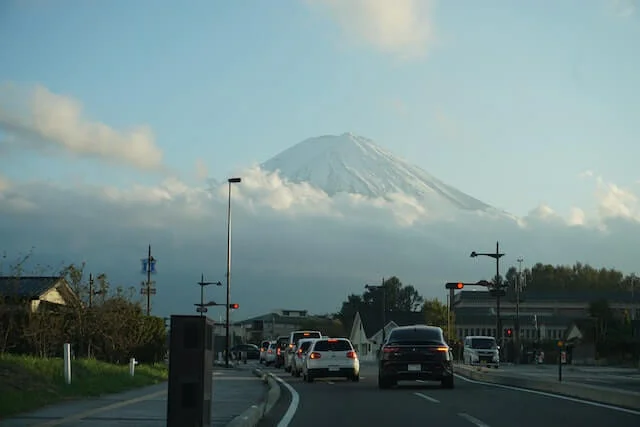
Toll prices are a bit difficult to work out, but if you know the departure and arrival city names then you can use this toll estimation tool for a general idea of the price of your ride.
Mt. Fuji Itinerary Ideas
There is no single ultimate Mount Fuji day trip, and that’s a very good thing! People have different tastes, and the Fuji area is capable of catering to them all.
Take a look at our previous article exploring 14 different Mount Fuji trip ideas for a better idea of what we mean. Everything in the itineraries below is pulled from that list, from shopping at the massive Gotemba outlet to taking the perfect photo from one of the surrounding panorama parks.
Just note that many of the best Fuji attractions are on the east and southeast side. The main exception is some fantastic hot springs like Fujiy Yurari and the Mount Fuji Heritage Center, which is why we included it in the Kyoto itinerary, since you would be coming from the west.
Also, if you have a tokyo rail pass that applies to Fuji, you can consider most, if not all, of the train fees to be zero.
Fuji-Q Day Trip
This first itinerary is for the thrill seekers, as the main focus is one of Japan’s best amusement parks, Fuji-Q Highland .

- Leave from Shinjuku station by bus for Mt. Fuji 5th station at 6:45 AM. Travel time 2h 25 mins (¥3,800 for adults, ¥1,900 for children, one way). This is the highest point you can reach on Mount Fuji by public transport and has an amazing view of the surrounding area.
- Head to Fuji-Q Highland from Mt. Fuji 5th station via Kawaguchi-ko station by highway bus . The 11:40 AM departure will take 40 minutes and cost ¥1,570, one way. From there, you can enjoy roller coasters and other theme park rides to your heart’s content. Day passes are ¥6,300 per person and the park is open until 5 pm.
- Enjoy the view from Mt. Fuji Panoramic Ropeway. Take the train from Fuji Q highland station to Kawaguchi-ko station. The 3 pm train is ¥180, and from there it’s a 10 minute walk to the Base of Mt. Fuji Panoramic ropeway . ¥900 round trip for adults and ¥450 for children. Enjoy some beautiful views and try to catch the sunset!
- Try the local delicacy, Unagi. Not too far from Kawaguchi-ko station, you can try grilled eel at the delicious Unagi Riki . High-grade eel is ¥3,450 per person and the budget option is ¥2,350.
- Back to Tokyo. A 5 minute walk back to Kawaguchi-ko station before taking the limited express Fuji Excursion train to Shinjuku JR station.
Mt. Fuji World Heritage Center Day Trip
This second itinerary is more for someone wanting to get a better sense of the area from indoors. For variety, we’ll start off in Kyoto, but you could do this trip from Tokyo even more easily.

- Leave Kyoto Station on the 6:26 AM shinkansen heading for Shizuoka. There are a few different route options, from transferring onto a limited express train in Shizuoka to multiple local trains. Your destination is Fujinomiya Station.
- Walk to the Mount Fuji World Heritage Center from the station. The Mount Fuji center opens at 9 AM, so after walking from the station after the express train, you’ll be right on time.
- After soaking up Mount Fuji-related facts and history for a couple of hours, grab a bite to eat near Fujinomiya station. There’s no shortage of options.
- Hop on another train from Fujinomiya, bound for Iwanami station. From there, take a bus to Gotemba Premium Outlets and get your shopping fix with a gorgeous view of Mount Fuji.
- Either make the long return to Kyoto or plan your overall trip so that you’re staying in Tokyo that night (recommended).

Chureito Pagoda Day Trip
With one of the most scenic views of Fuji, Chureito Pagoda is a hot spot for tourists. And it’s also a great focal point for another Mount Fuji day trip itinerary.
- Rent a car and drive to Chureito Pagoda in the morning and enjoy the scenery while taking some fantastic pictures.
- Make your way to Fuji’s nearby lakes. From there, you could rent a kayak and go paddling on the pristine waters or find a nice trail for a hike.
- Put a cherry on top of your day with a visit to a Japanese onsen before enjoying some of Yamanashi prefecture’s famous hotpot , called Houtou nabe.
- Make the reluctant return to Tokyo.
Mt. Fuji Day Tours
Just want to kick back and let someone else plan your Mount Fuji trip for you? A professional tour might be the thing you’re looking for to make your visit stress-free.
Here is a list of some recommended day tours which offer a range of unique ways to experience the beauty of Mount Fuji.
Mt. Fuji and Hakone Full Day Tour
Hato bus provides full day tours between April 1st and June 30th. From 9 AM until 8 PM they take you to key spots in surrounding Mount Fuji and Hakone areas. Some of the highlights you can look forward to are as follows:
- A cruise on Lake Ashi
- Visiting the 5th level of Mount Fuji
- Panoramic view of the mountain and surrounding areas from Komagatake Ropeway
Lunch is provided and prices are 12,800 JPY for adults and 10,800 JPY for children (subject to change). Follow this link for more info on this Fuji tour .
Private Car Tour of Mt. Fuji and Gotemba Outlet
This service will pick you up from almost any hotel in Tokyo and provide transportation via private car to and from Mount Fuji’s 5th station. The tour then moves on to the popular Gotemba outlet mall where travelers can spend as much time (and money) as they like.
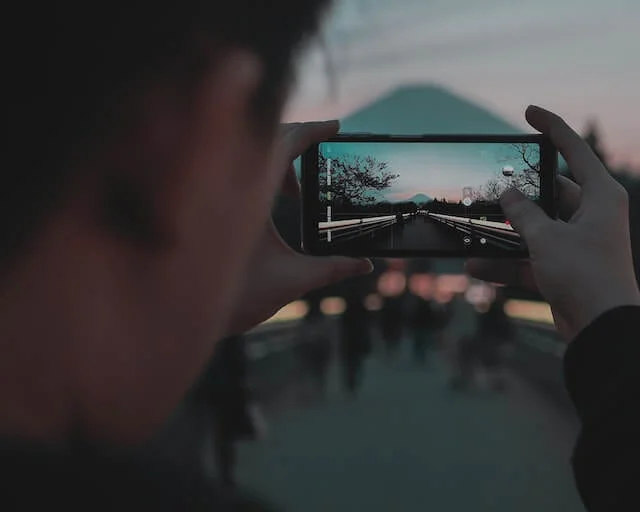
The 10 hour tour is ¥150,000 ($1,178USD) per group and can take up to nine people. Follow this link for more info on this private car tour .
When is the Best Time to Visit Mt. Fuji?
The best time to visit Mount Fuji is during the summer months of July and August when the weather is generally stable and clear, allowing for good views of the mountain. This is also the peak tourist season and the busiest time to visit, so be prepared for crowds.
If you prefer a less crowded experience, you may consider visiting in the spring (April to June) or autumn (October) when the weather is still mild and the foliage is changing colors. As with any mountainous area, check the weather forecast before your trip, as it can be unpredictable and quickly change from clear to cloudy or rainy.
Can You Climb Mt. Fuji in a Day?
If you’re in really great shape, you can climb Mount Fuji in a day. Fuji’s 5th Station is the highest starting point at 2,400 meters in elevation, making the total ascent a little under 1,400 meters. The trail from that point is 5 kilometers, which is doable if you’re up for a challenge.
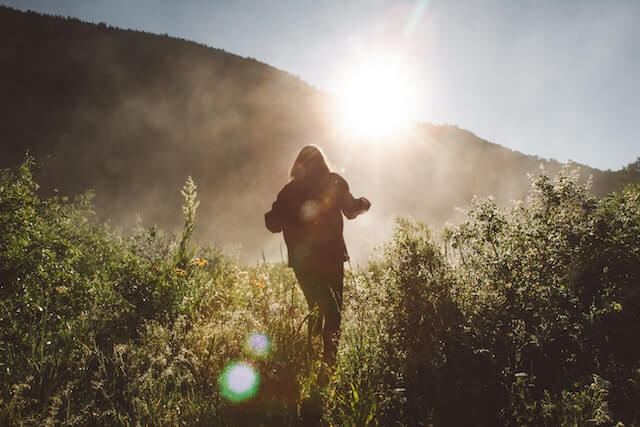
The Yoshida trail takes an average 5-7 hours to climb, and because of the sudden rise in altitude it’s very common to experience altitude sickness. If you’re not extremely confident, you may want to plan to do the climb over a two day period and try to stay at one of the mountain huts.
Mount Fuji day trips are fairly easy to plan since there are plenty of buses and trains going to the different attractions. And if you don’t feel like organizing things for yourself, there are many one day tours, each offering a unique way to enjoy the wonder that is Mt. Fuji.
Try to plan your trip from mid-spring to early fall based on what kind of foliage you want to see and the availability of certain tours. Once you’re there, enjoy the view.
Mount Fuji Heritage Center image by SHIZUOKACITYperson, CC BY-SA 4.0 https://creativecommons.org/licenses/by-sa/4.0 , via Wikimedia Commons
Share the adventures Share this content
- Opens in a new window X
- Opens in a new window Facebook
- Opens in a new window Pinterest
- Opens in a new window LinkedIn
- Opens in a new window Reddit
- Opens in a new window Tumblr
- Opens in a new window WhatsApp
You Might Also Like
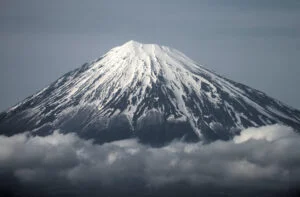
14 Fun Mount Fuji Trip Ideas
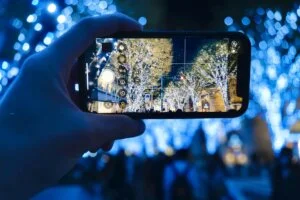
The Top 8 Illumination Events in Tokyo 2023-24

7 Spas in Kyoto to Fit Into Your Next Trip
Leave a reply cancel reply.
Save my name, email, and website in this browser for the next time I comment.
- South Africa
- Afghanistan
- North Korea
- Adventure + Outdoors
- Amusement Parks
- Backpacking Trips
- Boating + Cruises
- Budget Travel
- Bus + Train Travel
- Coasts + Islands
- Country Trips
- Fall Vacations
- Family Vacations
- Green Travel
- Heritage + History
- Honeymoons + Romance
- Inspiration + Guide
- Landmarks + Attractions
- LGBT Travel
- Markets + Bazaars
- National Parks + Reserves
- Nature + Wildlife
- Parks + Gardens
- Pets + Animals
- Photography
- Airlines + Airports
- Budgeting + Currency
- Business Travel
- Celebrity Travel
- Customs + Immigration
- Deals + Rewards
- Family Travel
- Hotels + Resorts
- Luggage + Packing Tips
- Offbeat News
- Photography Tips
- Responsible Travel
- Solo Travel
- Tech + Gear
- Travel Etiquette
- Travel Warnings
- Bars + Clubs
- Celebrity Chefs
- Restaurants + Cafés
- Wine + Vineyards
- Beach Hotels
- Boutique Hotels
- Hotel Openings
- Hotel Reviews
- Luxury Hotels
- Mountain + Ski Resorts
- Spa Resorts
- Vacation Rentals
- Asia Cruises
- European Cruises
- Festivals + Events
- Museums + Galleries
- Style + Design
- Travel’s Best
- Hotel with Agoda.com
- Hotel with Booking.com

Jeju blog: The latest complete Jeju island travel guide
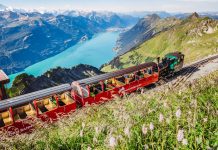
The complete Eurail pass guide: What is eurail pass, how to…

What to eat in Taiwan? — 24+ most popular food to…

What to eat in Nha Trang? — 17+ best street food…
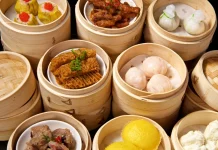
Visit Din Tai Fung Taipei Original (Din Tai Fung Xinyi) —…
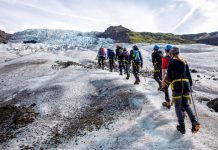
The ultimate Iceland hiking guide: Everything you need to know. Best…
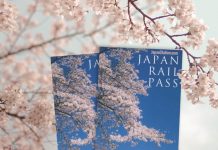
JR Rail Pass Guide. All things you need to know, how…
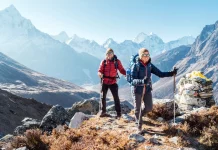
How to prepare for trekking in Nepal? — 10+ Nepal trekking…

India trip tips — 9+ things to know before going to…

All about tips in Nepal — How much to tip in…

Where to eat in Nha Trang? — 27+ budget, best places…

Mövenpick Resort Kuredhivaru Maldives reviews. The detailed review of my vacation…

Hyatt Regency Danang Resort and Spa reviews. The resort is highly…

+7 luxury resorts you must stay in Danang, Vietnam

Top hotels in Siem Reap — 8+ best places to stay…

10 must-know things for your best first time European river cruise

Top 3 best luxury cruises in Halong Bay, Vietnam

Cherry blossom festival Korea 2024 — Top 5 cherry blossom festivals…

- Ghibli museum blog — The fullest Ghibli museum guide for first-timers

Kyoto festival — Top 10 best events & most famous festivals…

National Palace Museum Taipei blog — What to see in National…

Japanese waterfall — Top 10 most beautiful waterfalls in Japan in…

19+ most beautiful towns in Europe every tourist need to visit…

Georgia travel photos — 20+ captivating photos show Georgia is heaven…

Explore Damnoen Floating Market — The oldest floating market of Thailand

Visiting Fenghuang Ancient Town — One of the most charming ancient…

Mekong Delta travel blog — Beyond rivers of Southwestern Vietnam

14 reasons why you should travel when you are young

Shigaraki Tanuki – An animal symbol of good luck in Japan

Living in the charms of cave houses in Andalucia, Southern Spain

20+ jaw-dropping tiny homes around the world
Mount fuji day trip blog — how to spend one perfect day itinerary in mt fuji.
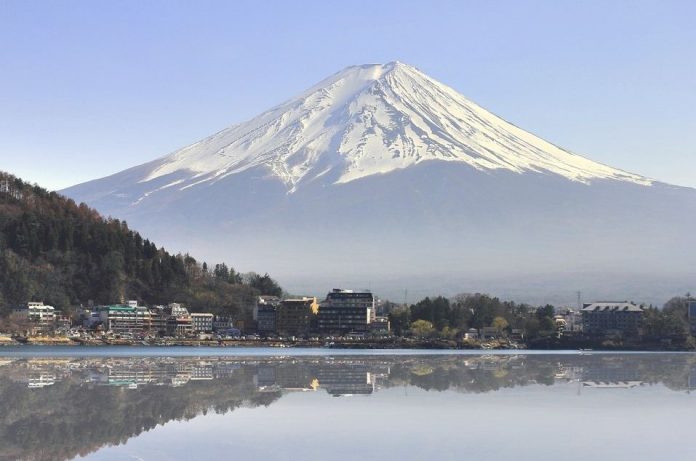
Let’s discover the most famous iconic of Japan through our Mount Fuji day trip blog — Mount Fuji one day itinerary (Mt Fuji one day itinerary, Mount Fuji day trip itinerary) start from Tokyo and from when to visit Mount Fuji to best places to visit in Mt Fuji with Living Nomads: One-day excursion to Fuji mountain review: When and where to go below.
- Tokyo best parks — 10+ best & most beautiful parks in tokyo
- Cherry blossom Tokyo 2024 forecast — 14 best places to see cherry blossoms in Tokyo
- Ikebukuro blog — 7+ best places to go & top fun things to do in Ikebukuro
- Tokyo best temples & shrines — 7 most famous, beautiful shrines & best temples in Tokyo
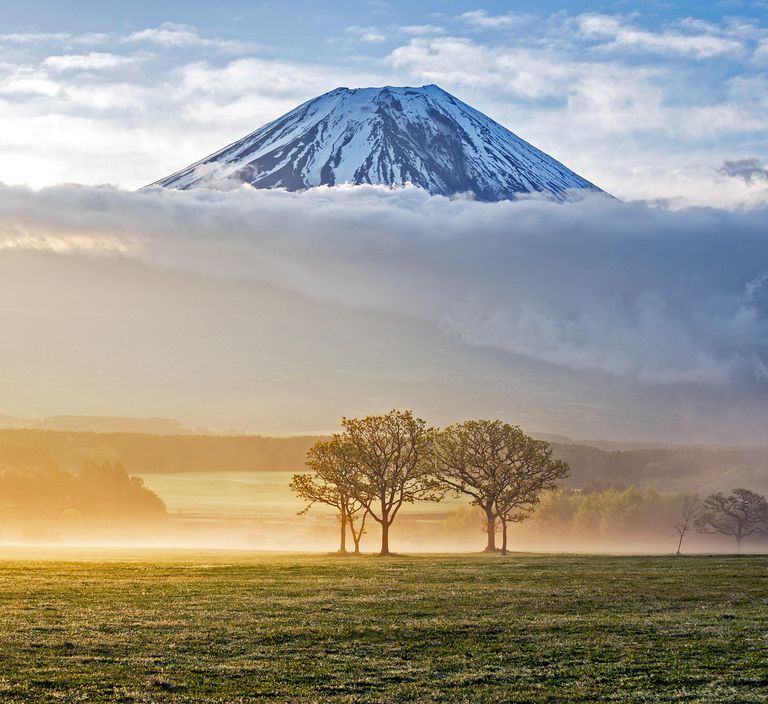
Mount Fuji is the absolutely divine mountain of Japanese. Mount Fuji is not only a legendary place the Japanese must come to, but also anyone who comes to Japan desires to admire this mountain. With the same curiosity and eagerness as many tourists when coming to Japan, our team — Living Nomads have fallen in love with Mount Fuji as soon as they have not yet arrived in Japan (literally).

Just seeing from the plane, we amazingly admired the perfect beauty of Fuji. Therefore, we decided to make a trip to Mount Fuji. We really wanted to make a trip to the top of the mountain to see the sunrise, enjoy the attraction of drifting and bobbing clouds from the foot of the mountain. Unfortunately, we went there during the thaw season, the road was quite slippery. However, our team also had time to visit Mount Fuji and somewhere around the mountain.
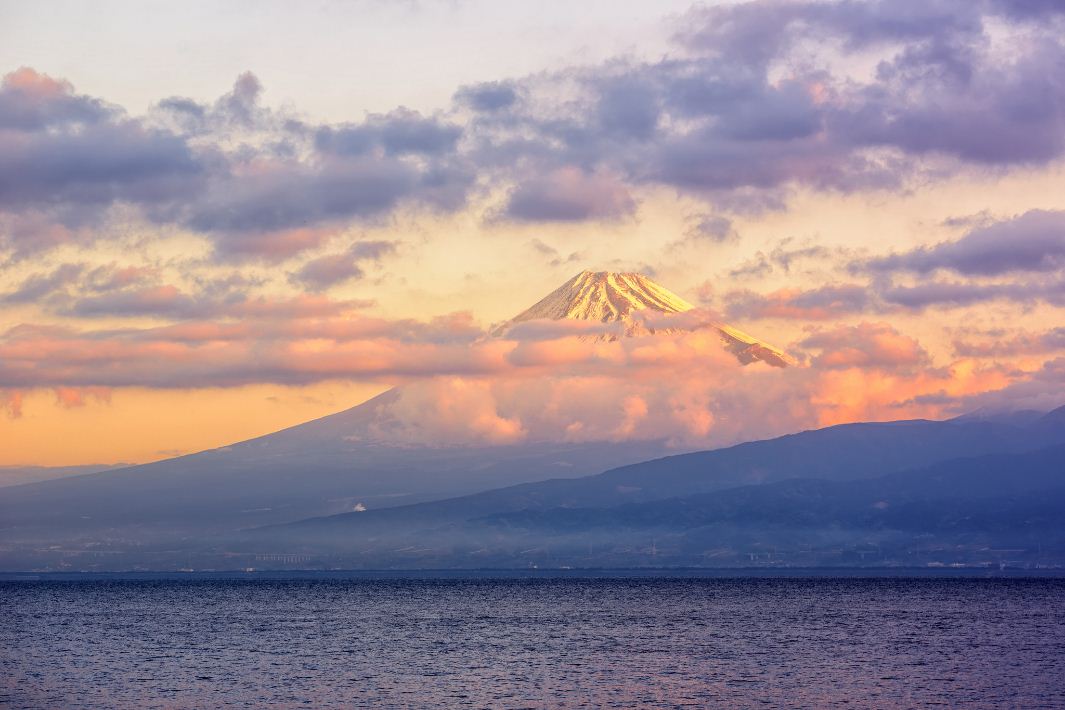
Mount Fuji day trip itinerary: When to visit Mount Fuji?
Depending on the individual needs or hobbies, you can choose your favorite season to go to Fuji mountain.
Spring lasts from March to April. This is time for those who love cherry blossom.
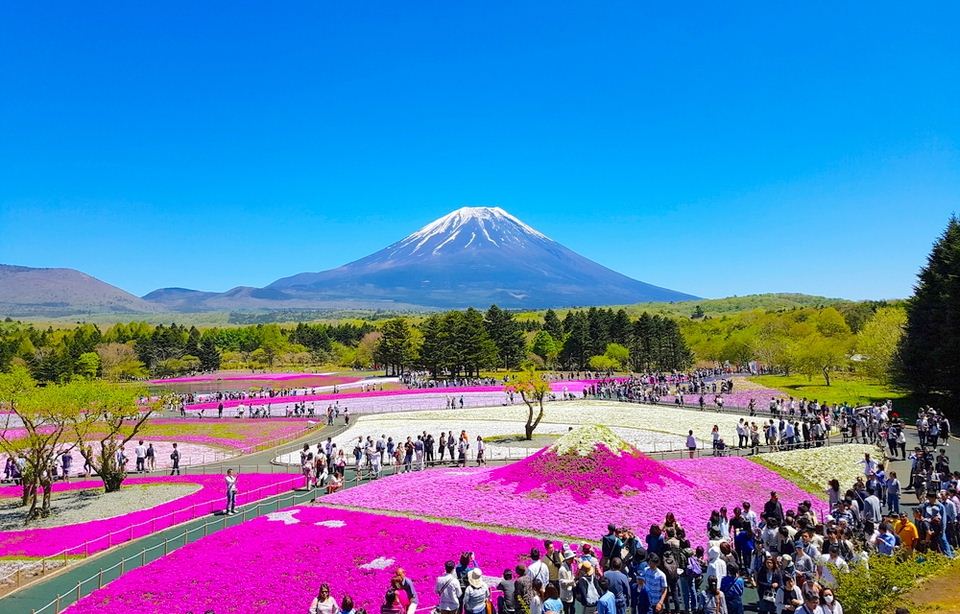
Summer falls in July to September, which is the ideal and cool season for those who want to climb mountains and conquer the Fuji. It’s the best time to visit Mt Fuji.

Autumn begins from October to November. You can view red leaves around Fuji mountain area, especially at Kawaguchi Lake – one of the most beautiful places in Japan.
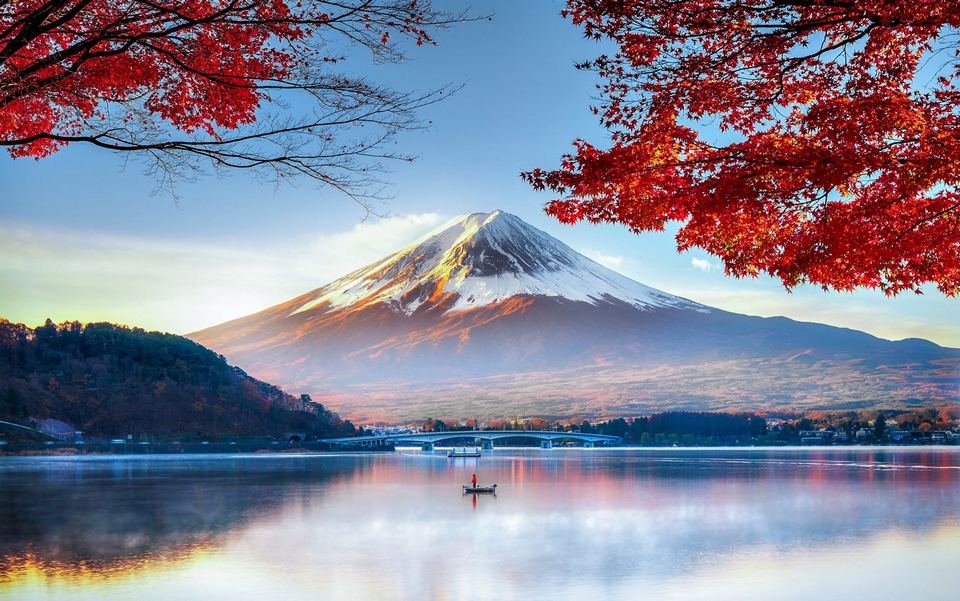
In winter, the weather is quite cold so few people visit Fuji Mountain. However, those who love to see and play with the snow as well as admire the majestic beauty of Mount Fuji in winter also should try.
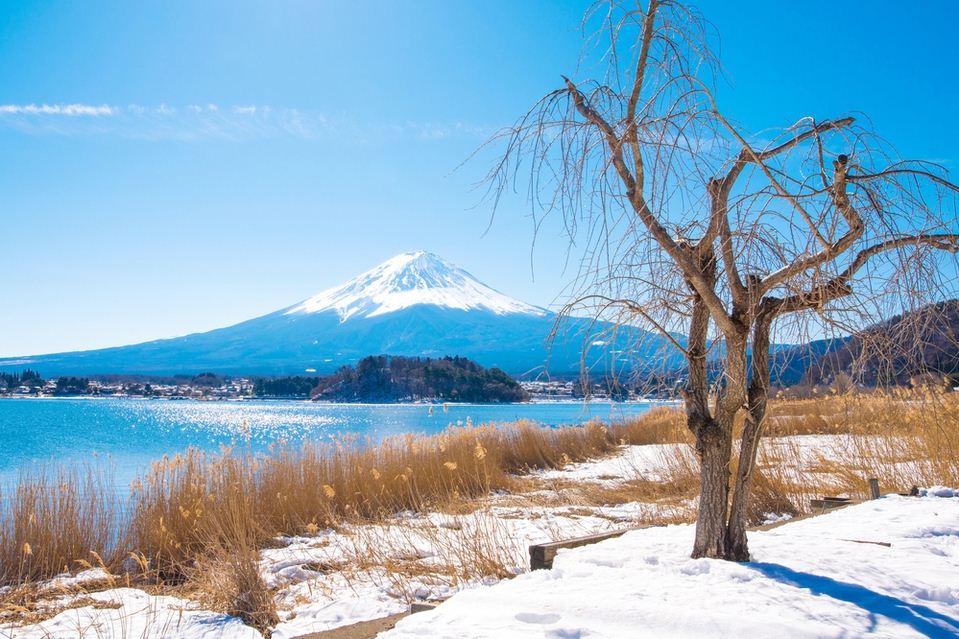
Mount Fuji day trip blog: How to get to MT Fuji from Tokyo?
If you decide to travel by public transport, first you should carry an unlimited data Wifi transmitter to look up information and find the way. Below are some ways on how to go to MT Fuji from Tokyo.
By bus: By a long-distance bus during the climbing season (from July to September)
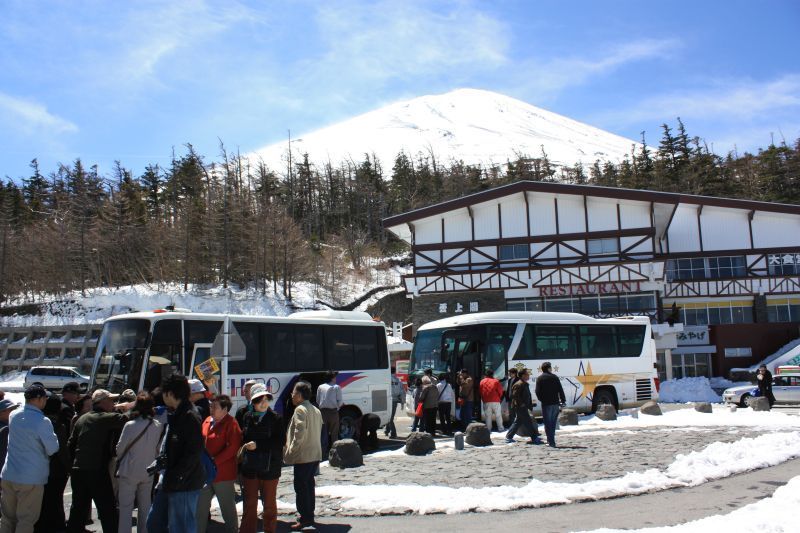
The direct bus takes about 2.5 hours, costs ¥2500 (approximately 25 USD), and departs from the Shinjuku express bus station to the Station No.5- Muji Subaru Line. Most visitors choose this vehicle to go to Mount Fuji because of the smooth roads in Japan. On the way to Mount Fuji, you will go through a music road. This is one of the Japanese ridiculous ideas. A small segment of the road will be made into small grooves. When the vehicles run at the speed of 45km/h, the wheel rolling through the grooves combines with the air flow to create the fun melody.

However, if you want to go to Mount Fuji during the non-climbing season, you have to change the journey, namely from Shinjuku station to Kawaguchiko station will take 1 hour 45 minutes (1,750 yen/ one-way ~ 15.5 USD). Then take a 50-minute bus trip to the Station No.5-Muji Subaru Line costing ¥1,540(~ 14 USD). You should note that at Kawaguchiko station there is only 1 bus after every hour.
By JR train: By Japan Railway train (JR)
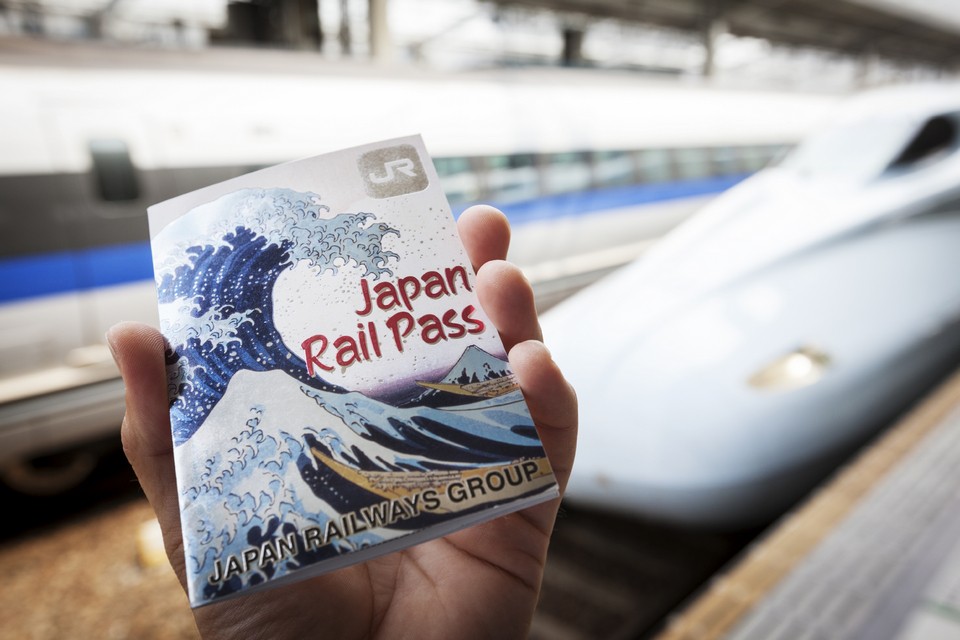
JR Pass is known as the magic card in Japan. If you have JR Pass card, you take the Azusa or Kaiji JR Express train from Shinjuku Station to Ōtsuki Station, then transfer to Fujiko Station to Kawaguchiko. However, the second train is the private one not included in the JR Pass. Therefore you have to buy a retail ticket costing about ¥1,440 yen/one-way (~ 13 USD).
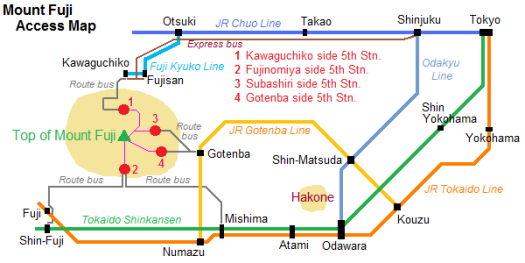
Renting 10-hour car ride to Fuji from Tokyo

Listening to go to Mount Fuji is interesting but it seems that the public transportation is a bit complicated and take a lot of time, not to mention maybe you still have to go to the train station 1 or 2 days before to buy tickets because sometimes it’s run out of tickets, miss train. The simplest, most wonderful way is the renting 10-hour car ride to Mount Fuji by Klook . In addition to going to Mount Fuji, you will also visit the ancient village of Oshino Hakkai, Lake Kawaguchi and also go to Gotemba Premium Outlet to shopping in American style.
Link to book the day tour here.
Getting around Fuji mountain: Best places to visit in Mt Fuji.
The station no.5 – fuji subaru line.
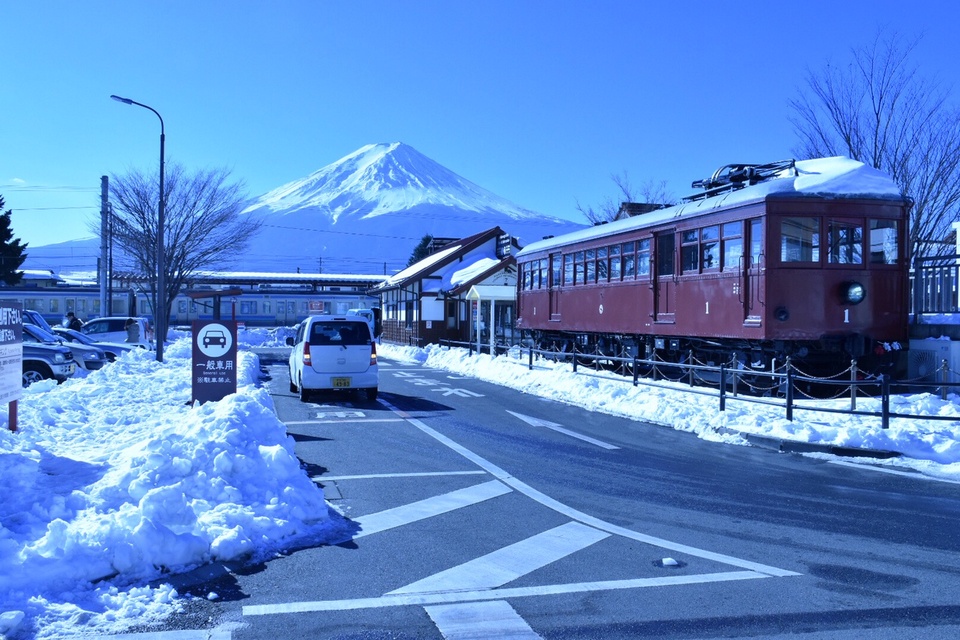
In summer, from early July to late August, it is the climbing season. However, because of being not in the climbing season, we only stopped at the station No. 5, which is the highest station that the bus can reach. However that place is not boring at all, the feeling of breathing fresh air from the height of 2,300m above sea level is quite interesting like the feeling of the body being purified. More interesting thing is that we can enjoy the beauty of thaw snow scenery, play with the left white snow, take photos and check-in with our phones.
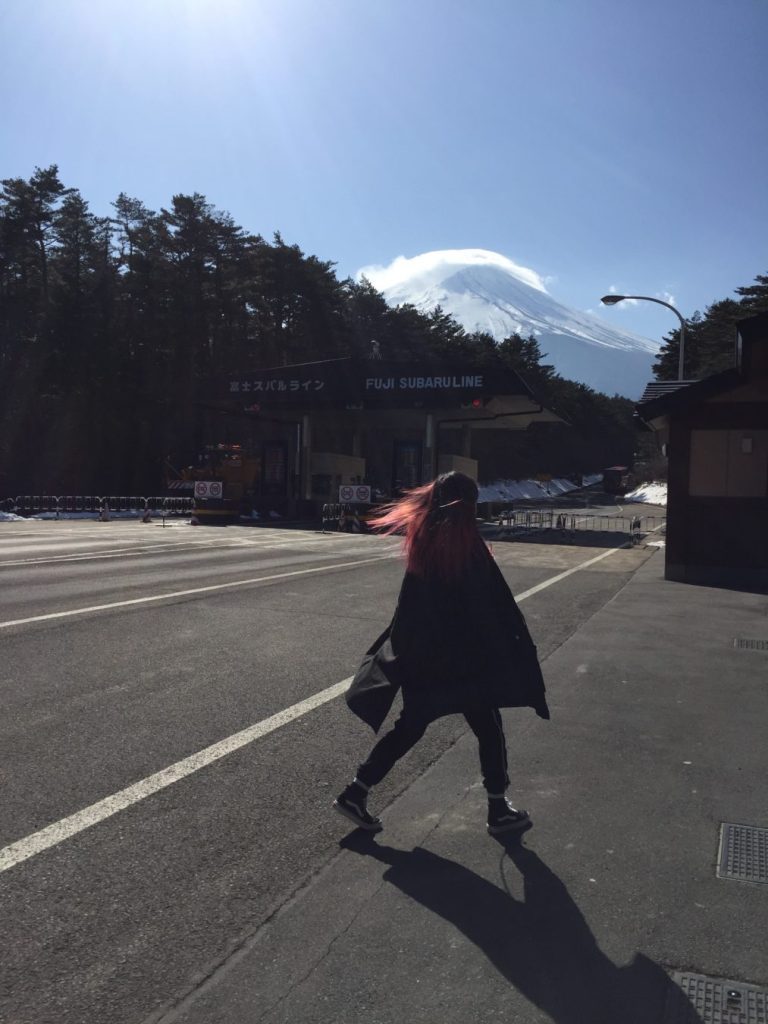
From the station No.5, you can see the huge Mount Fuji, however, from a too close distance, you will not be able to capture the whole beautiful mountain. Thus, you just should come to admire the landscape, other activities such as taking photos of Mount Fuji should be made at the beautiful Kawaguchi Lake.
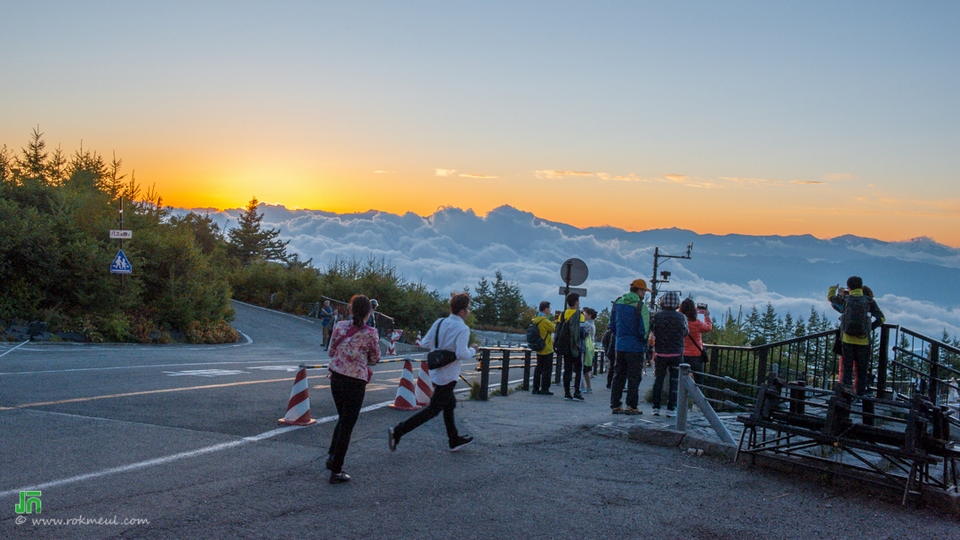
Kawaguchi Lake
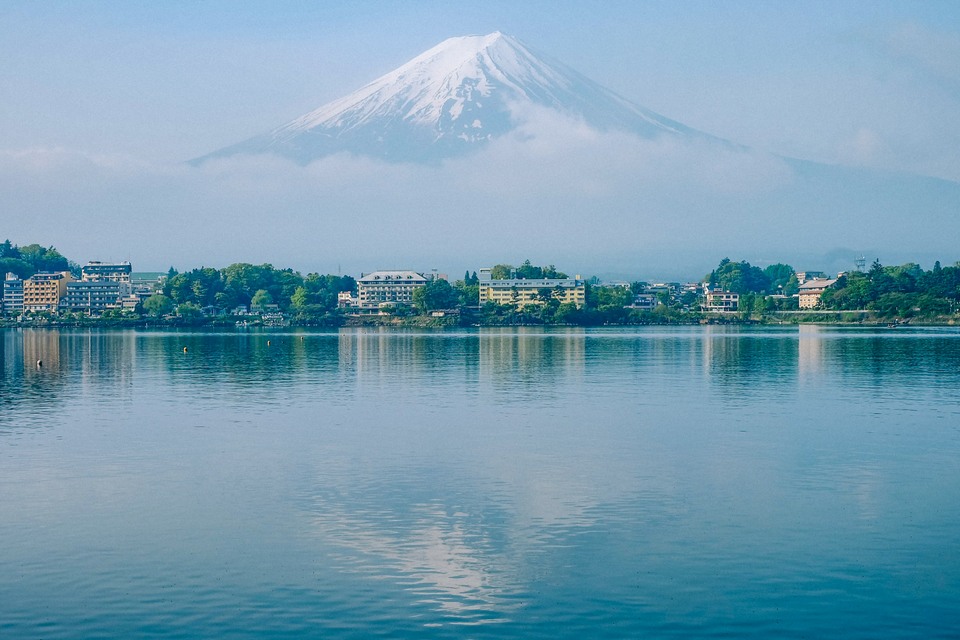
If you have a view from the Station No.5, you will see a huge Mount Fuji. But looking from Kawaguchi Lake, the mountain seems to be somewhat poetic and less divine. The mountain shines its shadow down the serene surface of the lake. The most beautiful time of the day to see or take photos of that scene is at noon. At that time, the sun will shine to create a 3D-liked picture. How wonderful it is! Kawaguchi Lake is also one of the most beautiful attractions to observe the maple leaves in Japan. If your trip falls in the official season, you will capture a beautiful picture with yellow and red leaves and the eye-catching beauty of Mount Fuji. In short, the landscape is fascinating and let’s hit the road!
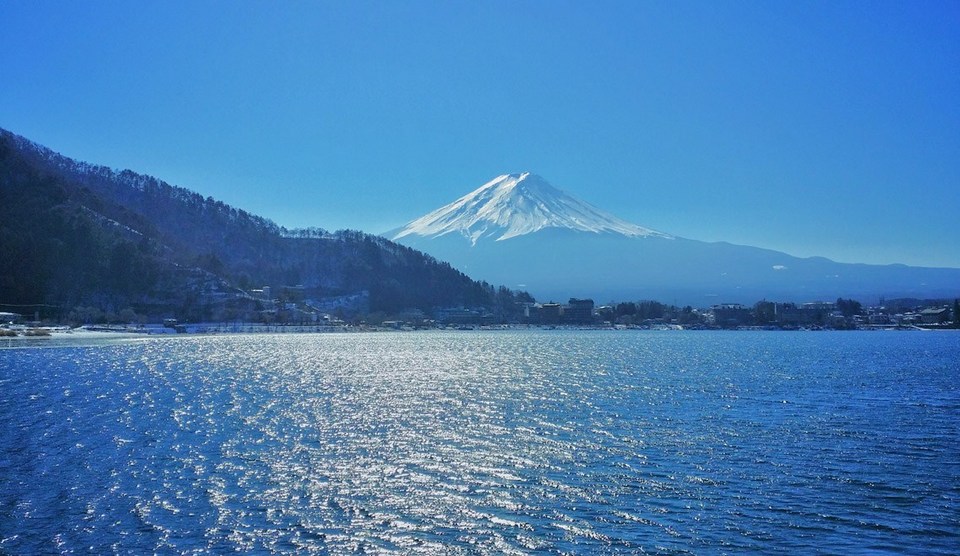
After sightseeing, we chose a restaurant near the lake and had lunch with a ¥1,000 set of rice (~ 9 USD) and then continue our journey.
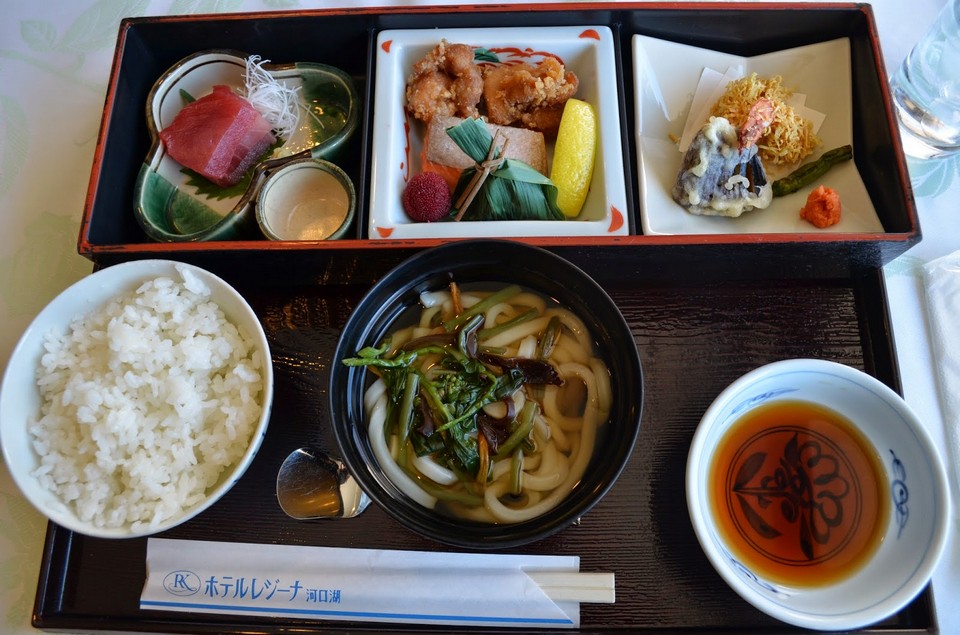
The ancient village – Oshino Hakkai
Once having a day to go to Mount Fuji, you should visit Oshino Hakkai village. Why? Because we are used to the modern and crowed image of Tokyo, breathing fresh air as well as watching thousands of natural beauty like a peaceful painting is impossible.
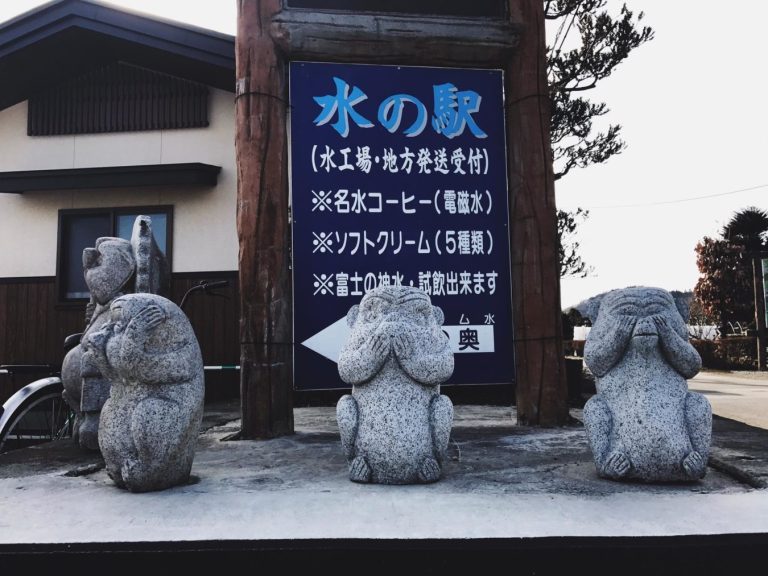
Continued reading…
Related articles
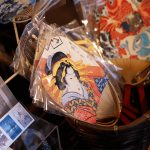
RELATED ARTICLES MORE FROM AUTHOR
The complete eurail pass guide: what is eurail pass, how to use & what countries does eurail pass cover, visit din tai fung taipei original (din tai fung xinyi) — tasting the best dimsum at the best dimsum restaurant in the world, the ultimate iceland hiking guide: everything you need to know. best hiking routes & useful tips, jr rail pass guide. all things you need to know, how to buy, how to use along with japan rail pass faqs.
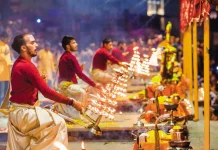
Where to go & what to do in Varanasi? — 15+ places to visit & best things to do in Varanasi
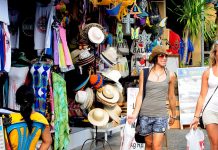
What to buy in Indonesia? — Top +9 famous gifts, souvenirs & best things to buy in Indonesia
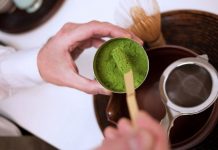
What to buy in Kyoto? — 31+ must-buy Kyoto souvenirs, gifts & best things to buy in Kyoto

What to buy in India? — 29+ best gifts from India & best things to buy in India
Editor picks.

The complete Eurail pass guide: What is eurail pass, how to...

What to eat in Taiwan? — 24+ most popular food to...
Popular posts.

What to buy in USA? — 17+ must buy in USA...

What to buy in Korea? — Top +23 cheap, famous &...

Must buy souvenir in Taiwan — Top 17+ most famous, cheap...
Popular category.
- Inspiration + Guide 1466
- Trip Inspiration 468
- Food + Drink 213
- Thailand 209
- Coasts + Islands 193
- Vietnam 170
- South Korea 169
- Travel Photos 144
- Work for Us
- Terms & Conditions
- Privacy Policy

Mount Fuji Day Trip: Perfect 1-Day Itinerary for Lake Kawaguchiko
Recognized as Japan’s tallest and most revered mountain, Mt. Fuji has long been a prominent subject depicted in ancient artwork, cultural artifacts, and imagery. Its magnificence draws numerous visitors from across the globe, making it a significant destination.
The popularity of Mt. Fuji and its surrounding areas continues to soar, with a steady rise in tourist numbers, reaching a staggering 4.5 million visitors in 2017 alone! Amidst this influx, first-time visitors may find it challenging to determine the best places to explore and the must-see sights. To assist in making these decisions, we have crafted the following itinerary, ensuring that day-trippers from Tokyo can fully immerse themselves in the wonders of the Lake Kawaguchiko region!
Overview of the Mt. Fuji Area
The Mt. Fuji Area: A Symbol of Japan’s Beauty Throughout history, Mt. Fuji has stood as an iconic symbol of Japan, captivating the hearts of both the Japanese people and the world. Katsushika Hokusai’s renowned series, “Thirty-six Views of Mt. Fuji,” not only influenced Japanese art but also introduced the legendary mountain to a global audience.
Rising as the tallest peak in Japan, Mt. Fuji attracts a substantial number of climbers annually. Its summit offers breathtaking panoramic vistas of the Southern Alps, Izu Peninsula, and the shimmering lakes, including the captivating Lake Kawaguchiko. Undoubtedly, it presents the most awe-inspiring views in all of Japan, making it an unparalleled destination for experiencing nature’s beauty.
The Enchanting Five Lakes of Mt. Fuji Nestled at the foot of Mt. Fuji are the five lakes that were formed during its last eruption: Lake Motosu, Lake Shoji, Lake Saiko, Lake Kawaguchiko, and Lake Yamanaka. Together, they are referred to as the Five Lakes of Mt. Fuji and were officially recognized as part of the Mt. Fuji Cultural World Heritage site in 2013.
Among these five lakes, Lake Kawaguchi has been renowned for its breathtaking scenic beauty since ancient times. In the vicinity of Lake Kawaguchi, visitors can explore various attractions, including Oishi Park, which offers a stunning view of both the lake and Mt. Fuji. The Kawaguchiko Music Forest Museum showcases a splendid collection of music boxes within its medieval European-inspired decor. Additionally, hot spring resorts provide an ideal opportunity to unwind and immerse in the captivating scenery of Mt. Fuji.
The Journey to World Heritage Status Before embarking on your Mt. Fuji adventur…
See More >>
Leave a Reply Cancel reply
Your email address will not be published. Required fields are marked *
Save my name, email, and website in this browser for the next time I comment.
Search by purpose
Search by articles.
- 2023 Spring Events in Japan
- Osaka’s Umeda Station Travel Guide
- Sea Kayaking Iwate’s Pureland Paradise
- Top 20 Sightseeing & Shopping Spots in Shibuya
- 48 Hours in Zamami
- The 7 best beach locations to visit in Japan
- Nihonshu Genka Sakagura Shinjuku East Entrance
Search by Area

POWERED BY NIK’S CONSULTING 2022© View Japan from the Inside – Right from the Window.
- Itineraries
- Tours and Activities
- Travel Guides
- Best of Japan
JRailPass.com » Japan Travel Blog » Mount Fuji from Tokyo: Day trip itinerary
Mount Fuji from Tokyo: Day trip itinerary
November 8, 2022
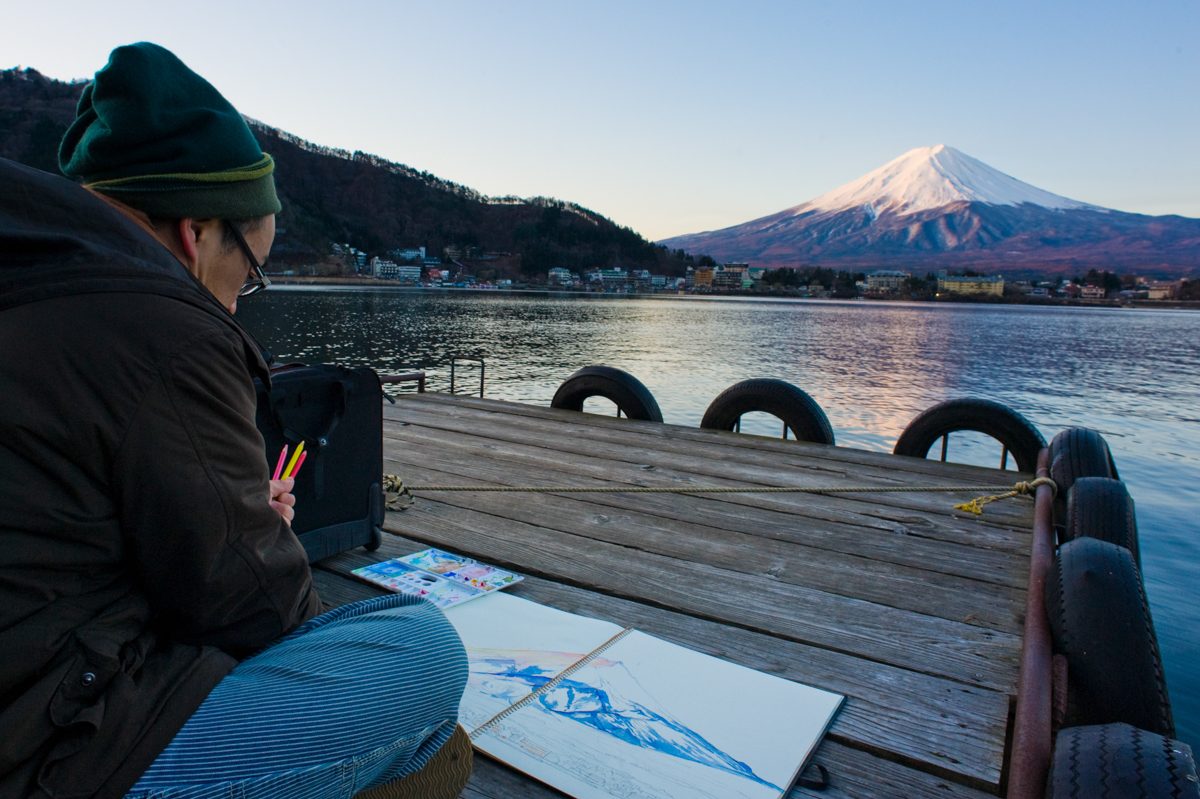
A day-trip from Tokyo to Mount Fuji and the lesser-known Hakone five lakes area is among the favorite experiences of many travelers to Japan, so here is our guide on how to visit this famous landmark with the Japan Rail Pass. Whether you prefer climbing or a more relaxed pace, we have the perfect guide for you make the most out of this trip!
Let’s start with some interesting facts about Fuji-san : Mt Fuji is not only the highest mountain ( 3.776 meters) , and Japan’s most climbed and depicted one, but it is also the pure representation of good luck and good fortune for all Japanese citizens. This is a curious fact, considering the mountain is actually a giant volcano.
Nevertheless, what is even more fascinating is that it is not a single volcano. It is part of three volcanoes, one on top of the other. The bottom one is Komitake volcano, and the second layer is Kofuji, while Fuji is the youngest of all three. Although officially classified as active, it has a very low eruption risk, since it was last active in 1708.
Interesting fact: Did you know that Mount Fuji is part of the Fuji-Hakone-Izu National Park , located less than 100 kilometers away from Japan’s capital?
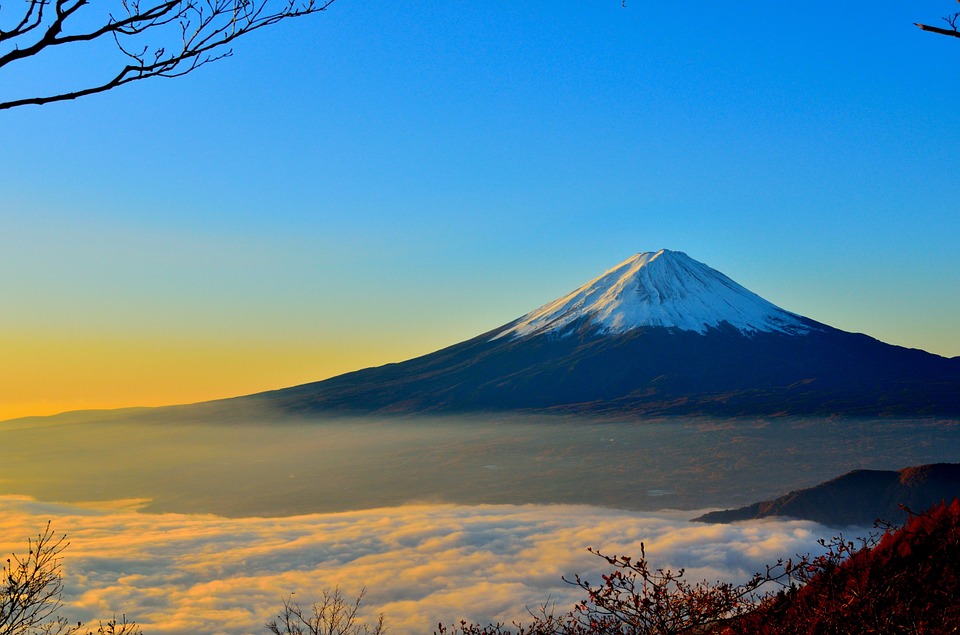
Climbing Mount Fuji
All travelers eager to climb the top of Mount Fuji must bear in mind that the climbing season lasts from July until September . During summer all hiking trails are open.
In any other period, trails and mountain huts will be closed, so it can be very dangerous for anyone to attempt climbing on their own.
Also read: Mount Fuji climbing guide
To climb Mount Fuji, there are four Fuji trails, which will take you to the mountaintop:
- Yoshida trail – 2,300m (altitude of head trail)
- Subashiri trail – 2,000m
- Gotemba trail – 1,450m
- Fujinomiya trail – 2,400m
All trails can be accessed via a mountain bus, taking passengers from one of the five 5th stations (although they are all named 5th station, these are different stations ), with the Fuji Subaru Line 5th Station, at Yoshida trail, being the most popular one.

Tokyo to Mount Fuji via Gotemba
Apart from the Yoshida trail, the Gotemba trail is one of the most popular routes among visitors. Travel time by train is a little over 2 hours from Tokyo. To get there:
- Take JR Tokaido line for Kozu from Tokyo Station, using your JR Pass
- Once at Kozu (Kanagawa), take the JR Gotemba Line for Numazu
- Get off at Gotemba Station | final destination

Note: The Hyperdia screenshot shows you a detailed description of a journey example with pre-selected departure time and date. Note that the train trip will be free of charge for all Japan Rail Pass holders. The displayed price is only valid for passengers with no JR pass.
Once at Gotemba station, take a bus to Subashiri 5th station , the gateway to climbing Mount Fuji. The bus operated by Fujikyu to reach the Gotemba climbing route. A one-way bus journey is about an hour long, at the cost of 1.540 yen (round trips are 2.060 yen).
Please note that Fujikyu is not part of the Japan Rail Group, which means the Japan Rail Pass does not cover buses ran by this company , and no seat reservations are available .
Book your Japan Rail Pass now
Mount Fuji from the Shinkansen trains
Summer is also the time when Mount Fuji can be clearly seen from a Shinkansen train leaving Tokyo towards Nagoya – Osaka – Kyoto. The window view is impressive – make sure to reserve your D or E seat (C or D in Green Cars ), which is the right side from Tokyo, left side from Kyoto .
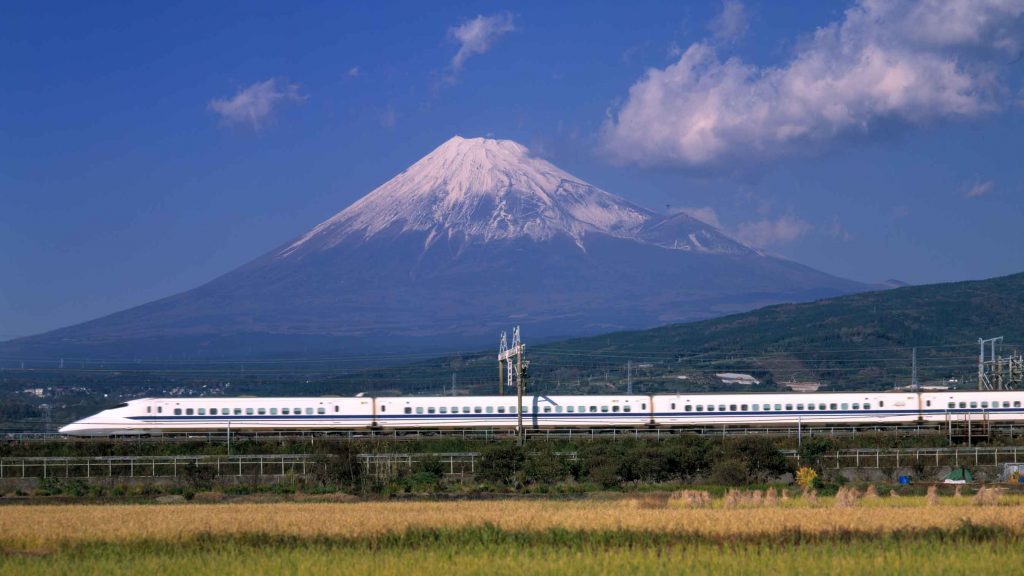
What to see in the Mount Fuji area
As we have already mentioned, Mount Fuji forms part of the Fuji-Hakone-Izu National Park. Hakone is one of the most popular destinations for tourists, located less than 100 km. from the capital city of Japan.
Famous for its scenic area, Ashi lake , hot springs and breathtaking views of Mount Fuji, Hakone is more than worth the visit.
Please check our new Hakone guide for more information on visiting the area.

Best time to visit Mount Fuji and its area
Also, please remember that the best time to visit any of these places is the hiking (summer) season , from July to mid-September . These are the months that promise sunshine, good weather, and fantastic views.
Unfortunately, travelers who decide to make this trip in October or March may not be able to enjoy the area’s scenery fully due to heavy rains or clouded mountain peaks.
Tokyo to Hakone with the JR Pass
Here’s how to get from Tokyo to Hakone with the bullet train :
- Take the Tokaido Shinkansen (Kodama and some Hikari trains, please check) from Tokyo Station (covered by the Japan Rail Pass)
- Get off at Odawara station
- Take the Hakone Tozan train for Hakone-Yumoto (not covered by JR)
- Get off at Hakone-Itabashi. This is your final destination.
Also very popular among the locals are Fujigoko or Fuji’s Five Lakes , which are located in the northern area of Mount Fuji.
Tokyo to Fuji Five Lakes
Kawaguchiko (or lake Kawaguchi) , Saiko, Yamanakako, Shojiko, and Motosuko are the Fuji Five Lakes. Each of them offers unforgettable views and outdoor activities, including fishing, hiking, and camping. Most hotels in the area are located close to the five lakes too.
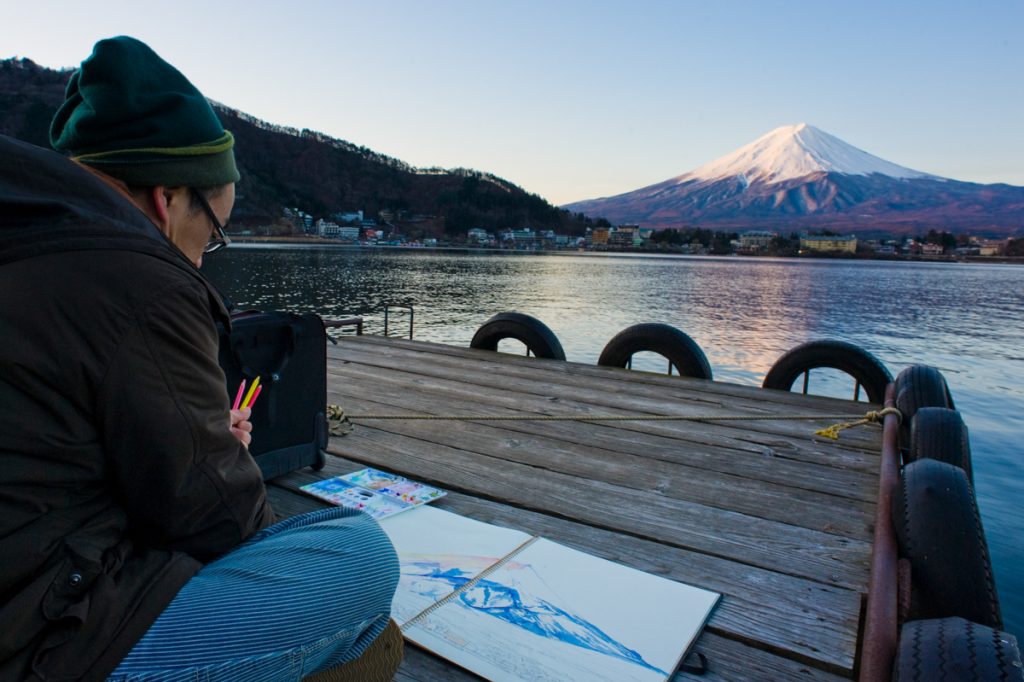
To get to the Fuji Five Lakes:
- Take the JR Chuo Line from Shinjuku Station (Tokyo) to Otsuki Station (Azusa trains, covered by the JR Pass).
- Once at Otsuki, take Fujikyu Railway to Kawaguchiko Station (not covered by the JR Pass).
Kyoto and Osaka to Hakone
Some travelers prefer to visit the area coming from the Kansai region (Osaka and Kyoto). Here’s how to get there from the west with a bullet train :
- Take the Tokaido Shinkansen (Kodama and some Hikari trains, please check) from Kyoto Station or Shin-Osaka station (covered by the Japan Rail Pass)
- Take the Hakone Tozan train for Hakone-Yumoto Station (not covered by JR)
- Get off at Hakone-Itabashi Station. This is your final destination and the gateway for the Mount Fuji area.
Related posts
Related tours & activities.
Pirate Ship Dows the JR pass cover access to the pirate ship on the lake?
Thanks Walid
No, sorry. The Pirate Ship is owned by a private company and is not covered by the JR Pass.
Happy travels!
HI, we are traveling from Tokyo to Kyoto and will use the JR pass. We would love to stop in Hakone on our way, and make a 1/2 day visit to see Mt. Fuji close up. I have been able to find directions on how to get from Tokyo to Hakone, but have NOT found how to get from Hakone to Kyoto, and if there are times I need to be aware of before there no more trains to catch late in the day. Thanks!
Hi Ana! We recommend you to read our Hakone travel guide: Access and what to do article. There you will find all the details on how to travel from Hakone to Kyoto 😉 Happy travels!
Not sure if this is JR rail pass? Does your 14 day tour that you have advertised are the trains all covered by the JR rail pass for this trip
KYOTO to FUKUOKA
I would like to take the JR Pass from Kyoto to Fukuoka. I don’t seem to find any train information on that route. Are trains going from Kyoto to Fukuoka and can I use my 7 day Pass? THANKS
Yes, you can go from Kyoto Station to Hakata Station in Fukuoka using your 7-day JR Pass. Please check our Fukuoka guide for further information on the itinerary.
Pls. let me know which train do I need for the following : 1. Roundtrip ticket train from Tokyo to Mt Fuji and which train station should we get off when reach MtFuji. 2. Do we need any transportation in order to reach 5th station 5? 3. Roundtrip ticket train from Tokyo to Kyoto?
Hi Christie! All the details regarding reaching Mount Fuji are detailed in this article you are commenting, we encourage you to carefully read it. Getting from Tokyo to Kyoto with the Japan Rail Pass is easy. You should take the Shinkansen Hikari bullet train from either Tokyo Station or Shinagawa Station in central Tokyo, and arrive at Kyoto Station.
Hi there! Me and my wife is going to japan on October 9 for 14 days and I am plan to get a 14 days JR pass, my 1st trip to Japan,, can’t wait for it.. Landing at Narita International Airport Day 1 – Arriving at Narita 11:30 am planning to stay in Shibuya or Shinjuku (afternoon Tokyo sightseeing) Day 2 – Day trip Kamakura passing by ONODEN Day 3 – Day trip Central Nikko & Okunikko Day 4 – Day trip Hakone & Mt. fuji Day 5 – Move to Takayama and explore Takayama Day 6 – Day trip to Shirakawago and Kanazawa Day 7 – Move to Kyoto Day 8 – Day trip to Arashiyama Day 9 – Day trip to OASAK Day 10 – Day trip to Nara Day 11 – In Kyoto the whole day and back to Tokyo on Night Train Day 12 – Tokyo East Side Day 13 – Free time (still planning) Day 14 – Depart Narita @ 13:10 Kind of very tight on the schedule , Is the 14 day JR pass worth on our trip? Thanks a lot and more power!
Hi Abraham! Since you are travelling around the whole country and given your itinerary, the 14-day Japan Rail Pass pays off. Enjoy your stay!
Hi, I’ll be visiting Tokyo and Osaka by mid-November 2018 and would like to pay a visit to Mt.Fuji. I would like to have an experience go by bullet train. I planning to purchase JR pass. Is there any bullet train for: 1. Tokyo to Osaka (Return) 2. Tokyo to Mt. Fuji Look forward to your reply. Thanks
Hi Jovi Ong! Getting from Tokyo to Kyoto with the Japan Rail Pass is easy. You should take the Shinkansen Hikari train from either Tokyo Station or Shinagawa Station in central Tokyo, and arrive at Kyoto Station. This line is fully included in your Japan Rail Pass . Regarding how to get to Mount Fuji, the itinerary is partially covered by the pass. This article you are commenting has all the details 😉 please check carefully.
We are traveling 12 days in Japan, from Narita airport to Tokyo to Nagana to Kyoto and Mount Koyasan to Osaka to Hiroshima and Miyajima then fly to Okinawa and then go to Tokyo and Mount Fuji. Do you suggest Japan Rail Pass, or JR East or JR West 4 day or 7 day pass? Thank you for any help. We leave July 23. We want to also go to Universal in Tokyo.
Hi Cindy! The nation-wide Japan Rail Pass is the only pass that will allow you travel along the whole country. Should you want a pass to travel to all mentioned locations it would be adviceable to go for the Japan Rail Pass.
Hello there – I will be In Japan for 9 days only, below is my travel itinerary, I need advise how best to utilise and activate my 7-days JR pass so I can use it for the Narita Express on my departure on my last day as well, any tips and realistic advise is truly and highly appreciated:
* Day 1-3: arriving Fukuoka Airport and stay in Fukuoka for 4 days * Day 4-5: travelling from Fukuoka to Osaka and stay in Osaka for 3 days * Day 6: travelling from Osaka to Tokyo and stay in Tokyo for 4 days * Day 9: departing Japan from Narita Airport
Questions that need your expert advise pls: 1. I would love to visit Mount Fuji (but not climbing, only to view, I believe can be done so at either the Lakes or Hakone (?)), shall I go to Mount Fuji from Hakata (during my Fukuoka stay) or Tokyo (during my Tokyo stay) or Osaka (during my Osaka stay)?
2. Is there a night train from “Hakata to Osaka” and “Osaka to Tokyo”? If not, what is the best way/timing to travel in these routes pls?
3. Is it better to do the Kimono/traditional photoshoots in Tokyo Asakusa or Osaka?
4. Heard that the “TOEI Animation Gallery” has closed down already, is there any place that we can see most animation-related stuff esp. Naruto and Dragonball pls?
5. Can we visit the Ghibli Museum & J-World Tokyo on the same day pls?
I would really appreciate any advise/suggestion/recommendation you can provide me with esp. utilising the 7-day JR pass.
Thanks again and awaiting your soonest reply. Labe
Hi I would like to ask about coin lockers at Numazu Station, our itinerary would be:
Checkout at Tokyo, travel to Mt Fuji Day Trip at Mt Fuji Travel to Osaka
This would be possible if we could leave our baggages at coin lockers. Are there any coin lockers at Numazu Station? Thank you very much!!!
Hi we are planning on a trip from Tokyo to Mt Fuji for the night and then to Kyoto. We have the 7 day pass, how do we go about doing that?
Hi Bronislava! In this article you can read all about travelling between Tokyo and the Mount Fuji. Should you want to move afterwards to Kyoto, as specified also in this article, you can do so in the Tokaido Shinkansen .
Hi, I plan to visit Mt Fuji , the five Lakes on 17 June 2018 for a day trip. Then,how do i go to Kyoto after that ? Your kind advice is much appreciated. Thank you very much.
Hi Carol! Should you want to move afterwards to Kyoto, as specified also in this article, you can do so in the Tokaido Shinkansen. It is also included in your Japan Rail Pass .
We want to stop by mount Fuji on the way to Kyoto. We are wondering if there is any large size coin locker to deposit our luggage at the Gotemba or Kozu station? Any other thought about how to handle the luggage would also be appreciated.
Is the JR rail the only way to get to mount fuji? I am considering to get the metro ticket for my stay in tokyo, but i am not sure if it is sufficient or not. Would love to hear from advise on it!
Hi Joyce! Please note Mount Fuji and its area are not part of Tokyo metro. Should you want to reach Mount Fuji you will have to consider purchasing other types of ticket.
Hi JRPass Team. We are arriving Tokyo, Narita airport on May 28 late afternoon. for 10 days. Of course we wil buy JR Pass for 7 days. On our arrival to Narita to our accommodation to Urayasu-shi, Chiba-ken, Todaijima we do not want to use yet our JR Pass instead we will buy one off ticket to get into our accommodation. OUr itinerary 1st day – Narita airport to Urayusu-shi, Chiba Ken for accommodation apartment in Urayusu-shi 2nd day – Disneyland (will buy ticket goin to disneyland) – any idea how much 3rd day – Disney Sea (will buy ticket goin to disneysea- any idea how much 4th day – Activate our 7 days JR Pass from this day. Tokyo city centre for Mt Fuji tour, JR Pass 5th day – Tokyo-kyoto-nara-tokyo or should we go tokyo-Kyoto-nara-osaka(stay overnight)-is this a long long trip 6th day – Tokyo-Osaka 7th day – Osaka back to Tokyo 8th day – tokyo sightseeing 9th day- tokyo sightseeing 10th day – 7th day of JR Pass from Urayusu-shi to Narita airport for departure. Lastly when is the best time to buy JR Pass online, our departure is May 28, 2018. How long does it take delivery from mail. Thank you and looking forward to have this once in a lifetime experience in Japan.
If you get your Japan Rail Pass from http://www.jrailpass.com the standard delivery time varies between 24 and 48 hours. However, the exact delivery time will depend on the customer’s location, time of order, public holidays as well as customs problems and/or ground/air transportation disruption. The estimated maximum delivery time is 72 hours.
Enjoy your trip!
hi, My family of 3 adults and 2 kids will arrive in Haneda on the 14 April ard midnight. Our apt is near Hirai Station. Our itinerary as follows: D1- Tokyo (15 April 2018) D2-Disneyland D3-Mount Fuji/ Lake Kawaguchi/Tokyo Skytree D4- Day trip to Tateyama Kurobe Alpine Route-Nagago-Toyama D5- Tokyo/Tsukiji/Tokyo D6- Day trip to Shikarawago ? open option on this D7- Tokyo-Haneda (21 April)
I got two questions? 1- Can I use the JRPass immediately when i arrive and still can be use when we going back to Haneda on the 21 April at 7pm. 2-Your opinion on my itinerary
Hi Khairul!
The Japan Rail Pass validity period is calculated in days, not in hours. Therefore, if you have purchased a 8-day pass and your activation date (when you first use the pass) is the 14th of April, the exact expiration time will be midnight on April 20.
We hope you enjoy your trip!
I am planning for an 8 days holiday in May 12-19 this year. My rough itinerary is as follow: May 12: Arrival Narita airport (1800). May 13: Shibuya- harajuku- shinjuku and maybe Asakusa May 14: Mt Fuji- chureito Pagoda- shibazakura Festival May 15: Yokohama- Travel to Osaka May 16: USJ May 17: Kyoto May 18: Nara- Osaka (afternoon) May 19: First train to Tokyo for departure at Narita. PS: I want to try the night train (Sunrise Seto) Osaka-Tokyo on May 18.. Is it possible? They said hard to reserve and must be in Japan in time or reservation..
Will a 7 day pass worth it for my Itinerary? Will it be advisable to get Pasmo card for some trains or buses that does not include the JR Pass?
Thank you in advance
The Japan Rail Pass would pay off – please note that it has a cheaper price than a Tokyo to Kyoto return ticket, on a Shinkansen bullet train. Given your itinerary, it will amost be fully coveres with the pass:
– The Narita Express is the most convenient Tokyo city transfer from and to Narita International Airport. – When in Tokyo, the pass affords access to 5 different local lines: the Yamanote Line , the Keihin-Tohoku Line , the Rapid Chuo Line, the local Chuo-Sobu line and other metropolitan lines that circulate on the outskirts of the city such as the JR Keiyo, Musashi, Nambu and Yokohama lines. Please note that Shibuya, Harajuku and Shinjuku can be accessed with the Yamanote line. – Hakone and Mount Fuji area can also be accessed with the pass, however some small parts may require to buy separate tickets. – From Tokyo, your Japan Rail Pass gives you direct access to all that Yokohama has to offer. After you will also be able to easily reach Osaka at not additional cost in the JR Tokaido Shinkansen line (Kodama train). – While in Osaka, you will be able to make full use of the Osaka Loop Line. This line will also take you straight to Universal Studios Japan . – Travelling between Kyoto and Osaka is now easier than ever. Just take the Hikari train on the Tokaido Shinkansen line. You will get between Kyoto Station and Shin-Osaka Station. – In order to get from Kyoto to Nara , begin at Kyoto Station. Take the Miyakoji Rapid Train, on the JR Nara line to JR Nara Station. To get then to Osaka jusr raje the Yamatoji Rapid Train to Osaka Station .
We hope you enjoy your stay!
Hi there, I will arrive Toyko on 14/11/18 and depart from Osaka on 23/11/18 . I plan to visit as many places as possible and suggest whether a 7 days JR pass is advisable. Plan to stay in Tokyo, Kyoto, Nara ? Osaka or do you suggest that I stay only in Tokyo and balance all days in Osaka but travel out everyday to other places. If I have finished my JR pass on 22nd, how to I travel from Osaka to the airport.
Hi SC Chiew! We strongly recommend you to check our 10 days in Japan: Travel itinerary for our itinerary and recommendations.
hello. we would like suggestions on how to travel from TOKYO to Mount FUJI in December 23, 2018. Five Lakes would be ok. will Mt. Fuji be visible in December 23 or so?
appreciate reply. thanks.
Our best suggestions are detailed on this article you are commenting 😉 We recommend you to carefully read it. If travelling in Dececember you may not be able to enjoy the area scenery fully due to heavy rains or clouded mountain peaks – but of course it will always depend on the concrete day.
We hope you enjoy yout stay!
Hi! Planning to travel this coming April. I have 4 kids in tow so this trip will be quite challenging. My first concern is we want to see Cherry Blossom and first stop is Tokyo or Osaka. We also plan to visit Disneyland. Any suggestion if we are planning to stay for 7 days or better if we book 14 days? You have any suggestion re itinerary? And what route should we do first if we want to see cherry blossom. Thank you!
Sure, our blog is full of itineraries and travel tips .
If you want to enjoy cherry blossom you cannot miss our 2018 cherry blossom forecast for Japan article. There you will be able to find which areas are expected to be in full bloom at the date of your trip and then you can just adapt to it. For example, the best times to visit (full bloom) are expected to be around March 24 in Tokyo , and March 28-29 in Hiroshima , Kyoto and Osaka.
Hi there! I’m going to japan end of this month for 10 days, my 1st trip to Japan,, can’t wait for it.. Landing at Kansai International Airport Day 1 – Arr at Osaka Day 2 – Osaka Sightseeing (free and easy) Day 3 – Universal Day 4 – Kyoto sightseeing Day 5 – Shirakawa-go Day 6 – Tokyo Sightseeing Day 7 – Disney Sea Day 8 – Tokyo sightseeing / planning to Gala Yuzawa Day 9 – Mt.Fuji Day 10 – Narita Kind of very tight on the schedule , and we only purchase 7 days JR Pass, any suggestion ? And if we would like to do day trip to Mt.Fuji, is it possible to visit Gotemba and Hakone and back to Tokyo before 7 pm? and how to go there from Ueno ? Gotemba first or Hakone first? Do I need to reserve the seat? Thanks a lot!!
Your full itinerary is covered by the Japan Rail Pass :
– To travel from the Kansai Airport to the city of Osaka, board the Limited Express Haruka at the Kansai Airport Station. Take the Haruka to Shin-Osaka Station. At Shin-Osaka , transfer to a local train to Osaka Station. – While in Osaka, you can make full use of the Osaka Loop Line . – To get to Universal Studios , from Osaka Station take the Osaka loop line to Universal City Station. – To get from Osaka to Kyoto you can take the Hikari train on the Tokaido line. The same train will take you straight to Tokyo. – While in Tokyo, the JR Pass affords access to five local railway lines: the Yamanote Line , the Keihin-Tohoku Line , the Rapid Chuo Line, the local Chuo-Sobu line and other metropolitan lines that circulate on the outskirts of the city such as the JR Keiyo, Musashi, Nambu and Yokohama lines. – DisneySea is a twenty-minute walk from Maihama Station, or you can take the Disney Resort Monorail from Maihama to Tokyo Disney Sea Station. – Mount Fuji trip is already described in this article. – From central Tokyo to Narita Airport you can travel in the Narita Express , fully included in your pass.
Hi , How can I go to My-t Fuji using JR rail pass. Can I go to 5th station. and come bak.
Hi Shanthi!
This article you are commenting describes well how to get to Mount Fuji from Tokyo using your Japan Rail Pass . Make sure to check the ‘Tokyo to Mount Fuji via Gotemba’ part 😉
I’m travelling to Japan on 28/04/2018. Touch down in Osaka then will be going to Kyoto for temples visit on 01/05/2018. Next will be Mount Fuji and Tokyo city. Could you please recommend on how can I travel from Kyoto to Mount Fuji? Or can you please suggest some planning to me? As I check online, I find out that all they way from Kyoto to Mount Fuji takes more than 5 hours by train. But I’m not sure with all the trains. Appreciate for your help.
Thank you. Elaine
Reaching the Mount Fuji is easiest from Tokyo since it’s the closer than Kyoto. Should you still want to go to Mount Fuji from Kyoto , you may take the JR Tokaido Shinkansen to Mishima (included in th JR Pass), then Fujikyu Bus to Kawaguchiko (not included in the JR Pass ). This is the fastest method.
We hope you enjoy your visit!
Hi, I will visit Japan from Osaka (arriving May 01, 2018 – 8AM @Kansai) and then back from Haneda (May 14 – 11.45AM). I will stay in Osaka, and going back and forth the Kansai Prefecture – Osaka, Kyoto, Nara, Kobe, then go to Tokyo, then Fuji, then back to Tokyo for shopping. I also would like to visit Gotemba Premium Outlet for my last shopping.
Any idea on how I maximized by 7 day JR Pass during this visit and any good place that I might be missing. I’m more of a cultural person, but also like to mix with modern entertainment such as Universal Studio, Osaka Aquarium, Museum of Art etc.
I’m still mixed on having to take JR Pass (fast but expensive) and JR-West rail which is cheaper but spent more time on the road. I’m not looking for a tight schedule. 🙂 Some ppl recommend me to go to Nagoya, or even in the between Osaka – Tokyo cities. Would like to visit a good onsen if any. 🙂
Appreciate your help. 🙂
Since you are staying around 14 days in Japan we strongly recommend you to check our Japan in 14 days: Travel itinerary for our best recommendations on how to seize this amount of days. For further ideas we recommend you to also check our articles The 10 Best Theme and Amusement Parks in Japan and How to use Onsen: the best Japanese hot springs for the best onsens in the country.
We hope you enjoy your stay in the country!
hello I plan to be in japan from May 13th to May 29th – 17 full days. I’d like to see Tokyo, Kyoto, Nara, Nikko, Kanazawa, Osaka, Hokkaido, Hiroshima. There is so much information online and I’m not sure how to plan the route of the trip so as to save travelling time. Off course, I’ll be buying the JRP however what route should we take? What is the order of the cities we should take? Im most concerned about Hokkaido. How do I get there and which place is the most convenient to stay between Matsumae and Sopporo? Would this trip be covered by the JRP? I’m aware that JRP can be used for commuting outside of Tokyo however what can I use to travel within Tokyo? Do i need to purcvhase an additional pass for within Tokyo?
We recommend you to check our Japan in 21 days: The ultimate travel itinerary article. It features our best recommendations to enjoy to the fullest a stay of 3 weeks in Japan and includes almost all of your desired visits. From our point of view, the best itinerary in your case should be as follows: Tokyo, Nikko , Kanazawa, Kyoto , Osaka , Nara , Hiroshima .
You can reach Hokkaido from any of the main cities, being Tokyo the closest one. However the trip from Tokyo to Sapporo would take you 8 hours (and 11 from Kyoto) so we recommend to plan this part carefully. The trip is fully covered by the Japan Rail Pass as specified in our redicated article.
The JR Pass affords access to five different Tokyo railway lines: the Yamanote Line , the Keihin-Tohoku Line, the Rapid Chuo Line, the local Chuo-Sobu line and other metropolitan lines that circulate on the outskirts of the city such as the JR Keiyo, Musashi, Nambu and Yokohama lines. Should you need to take any other line you would need to chose any of the prepaid ic cards available.
Just been to Japan for 10 fantastic days. We bought 7 day JR Pass. First 3 spent in Tokyo bought tickets as required (we were not sure how much we would be able to cover per day). Activated JRP on 4th day to get to our next base, Osaka. Stayed there for 6 days in a hotel inside the station and travelled to Kyoto, Hiroshima, Mijeyama, Nara, Namba, one day in Osaka, all covered by JRP, while the luggage stayed in our room. Some stations are enormous so can take 10-12 minutes walking just changing lines. Last day returned to Tokyo because of better weather, made use of JRP on Yamanote line (Loop Line) which takes you to most important sights. Hope this helps.
Hi there! We are planning a day trip (27 March 218) from Tokyo (Shinjuku) to Lake Kawaguchiko to Gotemba and back to tokyo. Could you advise me on how I can get to gotemba from kawaguchiko, then back to tokyo? We have already purchased the 14 days JR pass 🙂 Thank you!
Hi Yun Jie!
To travel from Shinjuku ( Tokyo ) to Kawaguchiko you need to take the JR Chuo Line from Shinjuku Station to Otsuki Station (covered by your Japan Rail Pass). Once at Otsuki, take Fujikyu Railway to Kawaguchiko Station (not covered by your Japan Rail Pass). To get to Gotemba, take the JR Tokaido line for Kozu. Once at Kozu (Kanagawa), take the JR Gotemba Line for Numazu, and get off at Gotemba.
Have an amazing trip!
Hello! We are planning to visit Mt Fuji in Winter January and a day trip from Tokyo. Would Hakone and the Five Lakes be doable to do in both one day and are they in the same direction getting there, or is one more preferable than the other? Which way would we go to first and what would we have to pay that is not covered by the JR Pass? Also, is the Fuji Hakone Izu National Park walkable from Hakone Station? Thank you
Hi Darlene!
Hakone and the Five Lakes form part of the Fuji Hakone Izu National Park . Should you want to visit the Five lakes, you would need to travel until Kawaguchiko Station as described in this article.
Have a nice trip!
Hi, it is advisable to stayover one night in Hakone area or a day trip to Mt Fuji area from Tokyo will be sufficient?
That will be a chioce that will depend on you, on the time you have to visit Japan, on the kind of places you like to discover… The beautiful lakes, mountains, hot-spring resorts, historical sites and incredible views of Mount Fuji are just a small number of the attractions Hakone has to offer.
Hakone area is full of amazing places to discover: not only Mount Fuji but also the Fuji Hakone Izu National Park ,
Hi I have a JR pass for 7 days and plan to do a DIY trip for Mt. Fuji, Hakone and Gotemba. Please let me know what will be the best trip to do to achieve that in 1 day.
If you are planning to reach Mount Fuji it should be easy to combine with Gotemba: if you take the Gotemba trail, as described in this article, you will be able to easily hop off at Gotemba station. It will also be easy to reach Hakone since it is the same area. To get to Hakone you can take the same line that brought you to Mount Fuji ( Tokaido Shinkansen ) and get off at Odawara station. From there itinerary will be as described in this article.
Since they might be many places to fit in a single day trip, we recommend you to use Hyperdia to plan the itinerary so that you make sure you get to see them all.
Hi, I will be going to japan for 10 days and plan to get a 7 day JR pass. However, I’m not sure which day would be the best day to activate it considering I’ll be going to Tokyo Disneyland and Osaka’s Universal Studios, which means the JR pass will be sort of “wasted” for 2 full days.
My itinerary is as follows:
Landing at Narita International Airport Day 1 – Tokyo (free and easy – Shibuya/Shinjuku) Day 2 – Tokyo (free and easy) Day 3 – Mount Fuji Day 4 – Disneyland Day 5 – Transit to Osaka Day 6 – Osaka Universal Studios Day 7 – Kyoto Day 8 – Kyoto/Nara Day 9 – Osaka free and easy Day 10 – Kansai Airport
Could you kindly advise on which day should I activate the JR pass? Activating on which day would be the most cost effective as I’m not sure on which day the travelling cost is higher.
Indeed the Japan Rail Pass would be useful for almost all days. We recommend you to check which is the cost of the individual tickets for each trip and compare it to the cost of the pass. This can be easily done using Hyperdia – the number 1 Japanese online transportation planning tool.
See below how the Japan Rail Pass would make your trip easier:
– You will be able to reach central Tokyo from Narita Airport in the Narita Express , fully included in the pass. – When in Tokyo, the JR Pass affords access to five different railway lines: the Yamanote line , the Keihin-Tohoku line, the Rapid Chuo line, the local Chuo-Sobu line and other metropolitan lines that circulate on the outskirts of the city such as the JR Keiyo, Musashi, Nambu and Yokohama lines. – You will be able to reach Mount Fuji through the Gotemba trail, as you have already read in this article. – To get to Tokyo Disneyland just use your JR Pass to travel from Tokyo Station to Maihama Station, on the JR Keiyo line. – To go from Tokyo to Osaka , you will need to take either the Hikari bullet train or Kodama from Tokyo or Shinagawa stations in central Tokyo. Both run on the Tokaido Shinkansen line. – When in Osaka, you will be entitled to make full use of the Osaka Loop Line . – You can easily access Universal Studios Japan in Osaka: just start from Osaka Station and take the Osaka loop line to Universal City Station. From Nishikujo Station, you can also take the JR Sakurajima line (also called Yumesaki line). – To travel between Kyoto and Osaka just take the Hikari train on the Tokaido Shinkansen line. You will get between Kyoto Station and Shin-Osaka Station in less than 30 minutes. – To get from Kyoto to Nara , begin at Kyoto Station. Take the Miyakoji Rapid Train, on the JR Nara line to JR Nara Station. – And last but not least, to go to Kansai Airport you will just need to take the Haruka Express from either Kyoto or Osaka.
We hope you have an amazing trip!
Hi, I’m visiting Tokyo in Dec 2017 and will stay in Tokyo mostly except for a day trip to Mt Fuji. Is getting a JR pass worthwhile?
The most economical pass will always depend on your itinerary and that is why we always recommend you to check which is the cost of the individual trips at Hyperdia and compare it to the price of the nation-wide pass. Keep in mind the Japan Rail Pass would not only cover your trip to Mount Fuji but also the airport transfers and some transportation within Tokyo city.
We hope your have an amazing trip!
My husband and I will go to Japan in March 2018. Plan to stay in Tokyo from march 20 to march 25. Then go to mt. Fuji in march 26 leave in march 27( avoid the crowd in weekend). Then from mt. Fuji to Kyoto from march 27 till April 1. Do we need a two weeks JR pass or just One week pass? Which way, which date should we use the JR pass? And also we will leave Kyoto to Osaka for 3 nights then fly back home. Do we need JR pass from Kyoto to Osaka? Or just use daily pass?
Mei Kwan from Australia
If you want to assess which pass is more cost effective for you we recommend you to first draw your whole itinerary. Once you have it, check which the cost of each individual trip is. You can do this very easily using Hyperdia – the number 1 Japanese online transportation planning tool. Knowing this should be very easy to compare how much do individual trips cost to the Japan Rail Pass.
Hello JR Pass team!
Thank you for your amazing customer service. We are a family of 4 going around Japan from mid January for 2 weeks. We are planning to do a day trip from Tokyo to see Mt Fuji with the JR Pass. Obviously we cannot climb it, but which is the best location to receive the best views of the mountain/lake etc during winter and how do we get there using the Jr Pass? Thanks so much
Thank you for your warm comment 🙂 To have good views of the astonishing Mount Fuji you might want to visit the five lakes, each of them offering unforgettable views and outdoor activities. You have all the details on how to get there in this article you are reading.
I am planning to visit Mt Fuji from Osaka in a 1 day trip with my parents using JR Pass (7 day). Is it possible to cover this in a single day. I would like them to see Mt Fuji view from any location, if possible.
Other days, I would like them to visit Hiroshima and Kyoto.
Your response would ne highly appreciated 🙂
Hi Ajitesh!
Visiting Mount Fuji from Osaka in just 1 day might be too much since each individual trip will take you around 3 hours. It might be a best idea to go there while they are in Tokyo. And a tip: if what you aim is to have the majestic view of Mount Fuji and not climbing it you might like to visit Fuji Hakone Izu National Park 😉
To Visit Hiroshima from Osaka city center you need to first take the JR Haruka Express to Shin-Osaka Station, and then transfer to the Sanyo Shinkansen line (westbound, Hikari trains).
Our schedule going to Japan Nov 3, 2017 i ask, when can we reserved seat and how to process to reseved seat to JR pass bullet train .Thanks
Hi, we have travel to japan we already purchased the jr bullet train can i ask when can we reserved our seat and how to process to reserved the seat
i am going to japan with my family (1 toddler and 1 infant) for new year 2018, we are planning to go to osaka from tokyo and afterwards return to tokyo again using JRpass. I have read in a few travel blog that it is easier changing train in shinagawa station, because its easier and less crowded than Tokyo station. is that true ?
thank you so much from your answer
Hello Citra,
For traveling with kids, shinagawa station may be a better option. It is easier to change lines, no hassle and less crowds. Still a good location to take the Tokaido Shinkansen to go to Osaka, as you can see in our map.
Hope you and your family have a great time in Japan!
Planning a short trip December 11-16. Would this be a bad time to see mt. Fuji on a day trip from Tokyo? We will be in shinagawa near the prince hotel.
Mahalo Chris
Hello Chris,
Tourists are advised to schedule their visits to this special mountain during the climbing season which is from July to August. These months are ideal because of the good weather, accommodation options and convenient transportation. However, the snow will be seen covering the whole mountain during the winter, which reveals the most famous views or pictures of Mount Fuji. Apart from the summer months, temperatures at the peak are usually below freezing with the average temperatures falling around 19°F (-7°C ).
Winter is a good time to visit Japan and you are looking for some ideas, don´t miss our post best times of the year to visit Japan
Happy reading!!
I will be going to Tokyo in Dec . I shall be staying in Gotanda . I need to go togoshi to have dialysis treatment every Mon, Wed and Fri . Does jr pass cover that area ?
Does jr pass cover Yamamoto line? I shall be visiting Lake kawaguichiko (staying in kananso ryokan) Yomiuriland in Kawasaki Kamakura Odaiba Shiodome Daimon Is it more worthwhile to buy jr pass in my case for 14 days or 7 days? What advice can you give me?
Hi Kelly, Hope you are well 🙂
After seeing all the places you would like to visit, I suggest you to go for the 14 days Japan Rail Pass, because it gives you more flexibility and allows you to include more possibilities to your Japan trip. For that matter please have a look at our travel itinerary: Japan in 14 days
Although, the Yamanote Line is included in the Japan Rail Pass and is the best way to get around Tokyo and discover Tokyo major spots, you won´t be able to use it to go to the hospital. however, you can go walking, wich is 20 minutes or by metro, but you will need to get a single ticket every time you take.
Anyway, we hope you enjoy Japan as much as you can!
Have a safe trip
Best regards
HI..I AM TRAVELLING WITH 4 YEAR OLD GIRL AND INFANT(LESS THAN ONE YEAR) DO I HAVE TO BUY JR PASS FOR THEM OR THE TRANSPORTATION CONSIDERED FREE FOR AGE LESS THAN 6 TQ
Hi Marwiza!
Babies and children under the age of 6 are eligible to travel free of charge on all JR public transport. However, please note that you will not be able to make any seat reservations for your child if they don’t have a valid train ticket (JR Pass). If there are no available seats, children can be held by their parents in the unlikely event of full train cars.
We’ll be spending two weeks in Japan, which we are really looking forward too. Thanks for all the information provided on your page, these are really helpful. Purchasing the JR Pass is a no brainer, but we haven’t figured out yet whether a 1 or 2 week pass is the better option. We’ll arrive at Narita Airport and plan spending the first 5 days in Tokyo, including a trip to Nikko on the last. Then we’ll be heading to Kyoto for another 4 days and to Hiroshima and Myajima for 2 days before heading back to Tokyo and finally flying out from Narita again. We plan to validate the 1-week ticket for the second week of the trip where we’ll be using it mainly for the long distance connections between Tokyo-Kyoto-Hiroshima-Tokyo. However, this wouldn’t include the connection to the airport (upon arrival and departure) and the trip to Nikko, as well as some inner-city connections during our stay in Tokyo (such as the Yamanote line). The difference between the 1-week and 2-week JR pass amounts to 17000 Yen per person. Do you think we’ll be spending more than 17000Yen for the back and forth connections to the airport, to Nikko and for some inner-city travel during our stay in Tokyo?
Thanks in advance. Akin
Thank you for your nice comments on our blog 🙂
For the exact cost of each train ride please check Hyperdia – the number 1 Japanese online transportation planning tool. Please note that the Japan Rail Pass is more useful the more you travel and the far you do so it will always depend on the use you are going to give to the pass.
The Narita Express ticket price will differ depending on where you head to, its cost will be between 3.000 and 6.000 yen approximately since you will have to pay to reserve a seat a part of paying for the trip (please note you cannot travel without the seat reservation). All costs related to Narita Express are included in the Japan Rail Pass.
Travelling to Nikko from Tokyo will take you around 1 hour and 30 or 45 minutes and cost starts from a little more than 2.500 yen, one way. However to this you will have to add the cost of reserving your space, which will either be a seat or a standing space. All of them have an additional price that can go from 2.500 yen onwards.
We recommend you to take your time to draw your itinerary and to compare the cost of purchasing individual tickets with Hyperdia’s help to the cost of the Japan Rail Pass itself. It will for sure help you make the best choice.
Hello JRailpass, We are a family of five (2x adults and 3x kids under 10) traveling to Tokyo (Narita airport) from 5th April to 12th April 2018 inclusive. We plan to base in Tokyo (Ueno area) to see the cherry blossoms but also like to fit in a day trip to see Mt Fuji (not hiking, just looking from base or nearby with pagoda/ hot-spring side-trip), and possibly a day trip to Universal Studio or Disneyland.
Please can you recommend an itinerary based on above that maximize JR pass? Will a 7 days pass be sufficient? the kids will be 10, 7 and 4 so we should only need 2 children tickets? (we will arrive in Tokyo very early on Thursday 5th April around 8.30am, so would it be better to go somewhere first before checking to Ueno accommodation? logistic of luggages and train travel plus most accommodation only checks in after 3pm)
Many thanks, Leo.
Sure – we recommend you to check our Japan in 7 days: Travel itinerary as a reference of our recommended itinerary. Since you will spend an additional day you can easily add a visit to Universal Studios Japan (Osaka) or Tokyo Disneyland easily, and both can be reached with the Japan Rail Pass.
You will only need 2 children tickets since only 2 of your kids are between 6 and 11 years old. Children under the age of 6 are eligible to travel free of charge on all JR public transport. However, please note that you will not be able to make any seat reservations for your child if they don’t have a valid train ticket (JR Pass).
Wanting to get the Shinkansen from Shinjuku to Kawaguchiko. Is this possible or are the trains just regular local trains? It is the only opportunity we will have to experience the Shinkansen and I understand that it may not be the most economical or time-saving option but we really did want to travel on a bullet train. Thank you in advance.
Hi Danielle!
To travel from Shinjuku (Tokyo) to Kawaguchiko you need to take the JR Chuo Line from Shinjuku Station to Otsuki Station (covered by your Japan Rail Pass). Once at Otsuki, take Fujikyu Railway to Kawaguchiko Station (not covered by your Japan Rail Pass).
We hope you enjoy the bullet train experience!
Thanks for the great article and just want to say firstly your customer service seems fantastic! I’ll be travelling to Mount Fuji next month and just wanted to ask what is the easiest route to travel from Mount Fuji onwards to Kyoto using the JR pass? Thanks in advance.
We are happy you like our site 🙂
To go to Kyoto from Mount Fuji you can take Fujikyu Bus from Kawaguchiko and then JR Tokaido Shinkansen to Mishima, it is the fastest method.
Hi dear sir or madam:- I am wish to come Tokyo see Mt Fuji which train station should we be staying close from Tokyo to mt.fuji? Is it Take the JR Chuo Line from Shinjuku Station (Tokyo) to Otsuki Station (covered by JR) Once at Otsuki, take Fujikyu Railway to Kawaguchiko Station (not covered by JR)
Where to stay will see mt fuji everyday ? Hotel La vista ? Airport -Tokyo 2 night Mt Fuji 3 days 2 night
Back to Tokyo
Need to buy JR pass ? Thank you.
You might start your trip to Mount Fuji from Tokyo Station – the central as well as a terminal station for all Shinkansen bullet trains. From there take JR Tokaido line for Kozu and, once at Kozu (Kanagawa), take the JR Gotemba Line for Numazu. Then get off at Gotemba Station and you will be there. All the trip is covered by the Japan Rail Pass.
at which station of the tokaido line should I get off ?It says Kozu but I cannot find it on the tokaido itinerary.
Hi Susanna,
Yes, you should change trains in Kozu Station (Kanagawa prefecture). It’s on the JR Tokaido line from Tokyo to Odawara. For further itinerary details, please check out Hyperdia: https://www.hyperdia.com .
Hi If we are visiting Mt Fuji and Lake Ashi from Hakone, which train station should we be staying close by to if we are to head to Kanazawa early morning next day by JR pass? Any ideas of airbnb in the area? Thanks
The closest JR station in Hakone is Odawara JR station. You can take JR Tokaido Shinkansen line from there to go to Mt Fuji. It takes about an hour to get the Shin-Fuji station which is the closest Shinkansen stop to Mt Fuji.
We hope you enjoy your stay in Japan!
Comments are closed.

2 Days in Mount Fuji Itinerary: Beautiful Views and Hidden Gems
By: Author Charlotte
Posted on Last updated: 13th May 2024
Categories Itineraries , Japan
Last Updated on 13th May 2024 by Sophie Nadeau
From exploring lava tubes to thatched villages and soaking up views of the snow-capped mountain, there’s no shortage of things to do in the area. Here’s your itinerary on how to spend 2 days in Mount Fuji , as well as top tips to know before you go!
The majestic Mount Fuji stands as Japan’s highest peak and is listed as a UNESCO World Heritage. The iconic mountain rises above villages and emerald green forests, surrounded by five crystal clear lakes.

What is Mount Fuji?
The five lakes surrounding mount fuji (fujikawaguchiko), arrive at mount fuji, narusawa ice cave, fugaku wind cave, saiko iyashi no sato nenba, yamanakako hana no miyako park, oshino hakkai , kitaguchi hongu fuji sengen shrine, kawaguchi asama shrine .
- Chureito Pagoda (忠霊塔, Chūreitō)
Shimoyoshida Honcho Street
Where to stay near mount fuji, watch the mount fuji vlog.
Mount Fuji is an active stratovolcano (a volcano built up of alternate layers of lava and ash) located on one of Japan’s four main islands, Honshu. With a summit elevation of 3,776 meters it is the tallest peak in Japan and is famed for its perfectly symmetrical conical form, combined with its majestic size.
Written in Japanese “富士山” , Mount Fuji translates to “peerless one” meaning there is no other mountain in Japan quite like it. Legends say that this supreme, sacred peak harbours the secret of immortality in its depths.
The mountain has come to be both an iconic and cherished sacred symbol of the country. It’s popularity particularly grew after the Japanese artist Katsushika Hokusai published a series of woodblock prints named the 36Views of Mount Fuji (which includes the iconic print The Great Wave off Kanagawa).

The Fuji Five, known locally as Fujigoko 富士五湖, is a region that lies at the northern base of Mount Fuji, approximately 1,000 meters above sea level. The five lakes are called: Yamanakako, Kawaguchiko, Saiko, Shojiko and Motosuko.
The lake resort area is a popular spot for those who enjoy outdoor pursuits such as hiking, fishing, camping and snow sports etc. There are also a number of hot springs, museums and various other attractions that can be found in the area.
The most accessible of the five lakes is Lake Kawaguchiko. There are direct trains and bus connections from Tokyo. The other lakes are a little harder to reach. Lake Yamanakako is the largest and closest to Mount Fuji.

Day 1 in Mount Fuji suggested itinerary
Begin your trip by arriving in the Mount Fuji area. We chose to spend a full two days here, as it allows you to fully explore the surroundings and on the off chance you happen to be visiting when it’s overcast (like it was for us) then you’ll leave yourself more opportunities to see the snow-capped top of Mount Fuji.
You can visit as a day or weekend trip from Tokyo. There are direct trains from Tokyo but we personally preferred to rent a car as this gave us greater flexibility to move around the region at our own pace. Check car rental comparison prices here.

Our first stop was to one of the three larger lava tubes situated at the northern foot of Mount Fuji, the other two caves being Fugaku Wind Cave and Lake Sai Bat Cave .
There are over 100 caves in the area and they are all created by volcanic eruptions. In fact, it’s very rare to have such a prolific number of caves in one single spot. Inside the ice cave you’ll see plenty of ice pillars, some of which measure over 3 meters in length!
The path that takes you through the cave loops back, forming a figure of eight and at its lowest point the tunnel goes 21 meters underground.
As the name suggests, the cave can be pretty chilly with temperatures remaining between 0-3 Celsius. Be sure to bring a jumper with you (even during summer) and also wear comfortable shoes as the paths going through the cave can be steep and quite slippery. It is considered to be a difficult route.
Truth be told, you only really need 10 minutes to see the cave, so I wouldn’t necessarily come out of your way to visit unless you have your own transport. And, it has to be said that this is certainly not the place for you if you’re claustrophobic!

Just a 2 minute drive or 20 minute walk away you’ll find the wind cave. This was noticeably much busier as the route is more accessible and considered to be easier.
Again, this lava cave was made by volcanic eruptions and inside you can see lots of fascinating rocks and lava formations with interesting textures. It was also once used as a seed bank for which to store goods, thanks to the cool temperatures within the tunnels.
Both of the caves mentioned are designated as Japan’s natural monuments, and it’s true that they are a remarkable wonder of nature to see!
Worth noting, you can buy a combination ticket for both the ice and wind cave and because they’re only a few minutes drive away from one another, I recommend seeing both! To visit the caves individually it costs 350 yen.
If you are looking for a particularly unique snack, then there’s a stand selling soft serve sweetcorn ice cream close to the cave’s entrance. While you can enjoy it plain, it’s popular to salt the top of this snack to make for a sweet and salty treat!

Next, head to the thatched village for a chance to see the mountain. On a clear day, this spot offers amazing views of snow-capped Mount Fuji. This reconstructed traditional Japanese village of thatched roof houses did feel a little less authentic than that of some of Japan’s other thatched villages like, Kayabuki no sato, but it is pretty nonetheless.
You actually have to pay 500 yen to visit the village, but it’s worth it to see this charming spot and if you are lucky you’ll also be blessed with beautiful views of Mount Fuji.
Nenba village has a sombre history. Up until 1966 there was a vibrant farming community of over just 40 houses. However, all of that changed when a huge mud slide washed away most of the village. Today, around 20 of the thatched roof homes have been reconstructed and transformed into shops, galleries and museums.
Local activities in the village include, figurine painting, shopping for souvenirs and tasting local produce! There’s also the Sabo Museum which displays an exhibition of the mud flow disaster, showing life in photographs prior to the accident as well as discussions on how to learn from and prevent the same tragedy occurring again.
On our visit the clouds were pretty dense, but they did briefly part and Mount Fuji revealed itself to us for the briefest of moments, making the visit all the more magical!

Day 2 in Mount Fuji suggested itinerary
Start your second day at Lake Yamanakako, which is the largest and closest to Mount Fuji of the Fuji Five. The charming village that lies on the shoreline of Lake Yamanaka has a few things of interest:
- Hirano Beach – This is the spot to see the iconic Mount Fuji reflected into the water. Be aware, swimming is completely prohibited.
- Hiranoten Shrine – The main Shinto shrine in town.
- Patisserie HACONIWA Yamanakako – This delightful café even has a rooftop where you can enjoy views of Mount Fuji if the weather is clear enough! They don’t have any specific vegetarian options but were happy to make me an omelette without the usual accompaniment of a beef stew served together with a green side salad.

It’s then just under a 10 minute drive to reach the the beautiful flower park. Best visited during late spring or early summer when you can enjoy gorgeous flower fields. The vibrant colours change colour with the season and stretch over 300,000 square meters with Mount Fuji majestically sitting in the background.
If you happen to visit during the winter or early spring, you won’t be able to see the flowers in bloom. However, there’s a small botanical greenhouse area which has beautiful flowers all year round.
That being said, it only takes 10 minutes to walk around the greenhouse, so it’s not necessarily worth going out of your way to visit. Luckily the price to visit the gardens is much lower in the low season when there isn’t as much to enjoy!

Driving just ten minutes down the road will transport you to Oshino. This picturesque mountain village is known for its set of eight crystal clear spring ponds, which are considered to be sacred. The springs are part of Mount Fuji’s UNESCO World Heritage Listing and as such are a Natural monument of Japan.
Since ancient times people have been making the pilgrimage to the summit of Mount Fuji and these eight springs are the place from which many people have made the journey, they are thought to be a place of purification.
The ponds are fed with snow from Mount Fuji and lots of them are filled with fish. Apparently if you wear polarised glasses its much easier to see the fish through the water! In the area there are temples and shrines nearby to explore, as well as a museum where you can learn a little more about the history of the area.
Dotted around the ponds as you walk around are watermills and bridges, adding to the charm and tranquility of the setting. It’s seemingly the perfect spot for a rainy day, which makes sense as there’s quite a lot to see in the area.

Set against the backdrop of a dense and ancient forest, this stunning shrine is one of the most important in the region and is one of over approximately 1,300 Asama shrines in Japan.
Sengen and Asama shrines are a type of Shinto shrine that are centred around the worship of the kami of volcanos, more specifically and often, Mount Fuji.

Asama shrines are dedicated to Konohanasakuya-hime, the cherry blossom princess , who is the goddess of Mount Fuji and all volcanoes in Japanese mythology.
This shrine is famed for its Torii Gate which has roots dating back all the way to the 15th century. It stands at an impressive 70 meters high, making it the highest Torii gate that’s wooden, in all of Japan.
Within the grounds of this particular shrine you can see four Japanese cedar trees which are believed to be over 1,000 years old. It is also the start of the main train which many people take, leading them to the summit of Mount Fuji.
Chureito Pagoda (忠霊塔, Chūreitō )
For another mountain viewpoint, head to the one of the most famous and iconic spots to (hopefully) soak up the view of Mount Fuji!
This five storied pagoda overlooks the city of Fujiyoshida and is situated directly opposite Mont Fuji, so you can expect to see stunning views. Unfortunately on our visit the weather was overcast, but we still enjoyed the views over the city along with the cherry blossoms.
Overall there are a total of 398 steps to reach this iconic red and white pagoda. Visiting both the pagoda and the surrounding park are completely free to wander around, although it can get pretty busy as it’s one of the most popular things to do in the region.

Located around a fifteen minute walk away from the pagoda, is Honcho Street, which is a street that runs through the centre of Fujiyoshida and connects the city to Mount Fuji.
Famed for its retro signs, this streets is both a shopping and residential area which has become popular among tourists for the unique views of Mount Fuji (when it’s not an overcast day!) looming over the busy city below.
There are several warning signs as well as online information asking that visitors take photos with caution and don’t just step out into the middle of the roads (yes, some people do forget there whereabouts when getting snap happy) it’s a busy city and can be dangerous to just stop on the roads for a photo.
Yasuragiso – We stayed at Yasuragiso which is a traditional guesthouse where you sleep on futon on tatami! If the weather is in your favour, then you can awake to gorgeous views of Mount Fuji from your bedroom window. The guest house is clean and comfortable and makes for a great base from which to explore the wider region.

Enjoyed reading about how to spend the perfect 2 days in Mount Fuji? Pin this article now, read it again later:

Charlotte is a photographer, cat lover and an avid knitter. When she’s not curled up on the sofa with her newest knitting project (and Rico her cat!) you can find her out and about on long walks. Currently living in the magical city of Edinburgh, she looks forward to travelling and seeing more of the world!
This site uses Akismet to reduce spam. Learn how your comment data is processed .

Tokyo to Mount Fuji: A Complete Day Trip Guide for You
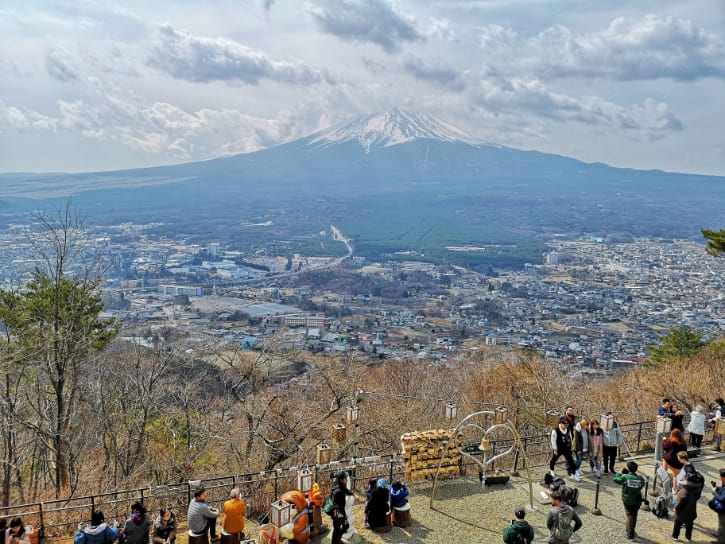
Thinking about a day trip from Tokyo to Mount Fuji ? Let me share with you in detail the ways on how to go to Mt. Fuji and what attractions you must see upon arrival .
I did a day trip with my wife to Mt. Fuji during our visit to Tokyo and we definitely had a great time. The place was surrounded by beautiful and relaxing views .
Luckily, most of the attractions are easily accessible via the sightseeing bus tour . You will get to know more about this later on, along with the best and easy ways to get around the area .
Let’s dive into the details of a Mount Fuji day trip from Tokyo . The information below will surely make your trip more convenient and memorable . 🙂
- Fujikyuko or Keio Bus (Highway Bus)
- Fuji Excursion (Limited Express Train)
- Fuji Day Tour
Best Things to Do on Your Day Trip to Mount Fuji
1. oshino hakkai, 2. kachi kachi ropeway (mt. fuji panoramic ropeway), 3. kawaguchiko music forest museum, 4. chureito pagoda, 5. fuji 5th station, 6. gotemba premium outlets, 7. fuji-q highland, 8. oshino ninja village, 9. fuji shibazakura festival, 10. oishi park, how to tour around mount fuji, mount fuji day trip from tokyo (suggested itineraries), related posts, 3 best ways to go from tokyo to mount fuji.
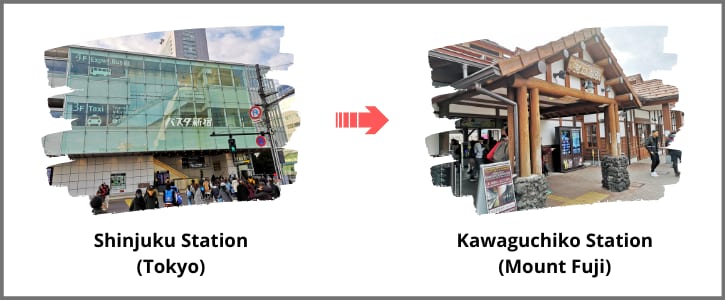
Mount Fuji is around 100 km from Tokyo and it takes about 2 hours to complete the journey.
There are 3 best transport options available ― Fujikyuko/ Keio Bus (Highway Bus), Fuji Excursion train, and guided tour.
Depart: Shinjuku (Tokyo)
For a day trip going to Mount Fuji from Tokyo , the best and easiest way is to take a highway bus or train from Shinjuku .
If you choose the bus, you can take it at Shinjuku Expressway Bus Terminal. For the train, you need to board it at Shinjuku Train Station.
Arrive: Kawaguchiko Station Kawaguchiko Station is the main transportation hub within the Mount Fuji area. Most of the buses and trains depart and stop here.
There’s a sightseeing bus tour available in Kawaguchiko Station. This is such a great choice if you want to tour around the area conveniently.
The options below are some of the public transports that will take you to the Kawaguchiko Station.
1. Fujikyuko or Keio Bus (Highway Bus)
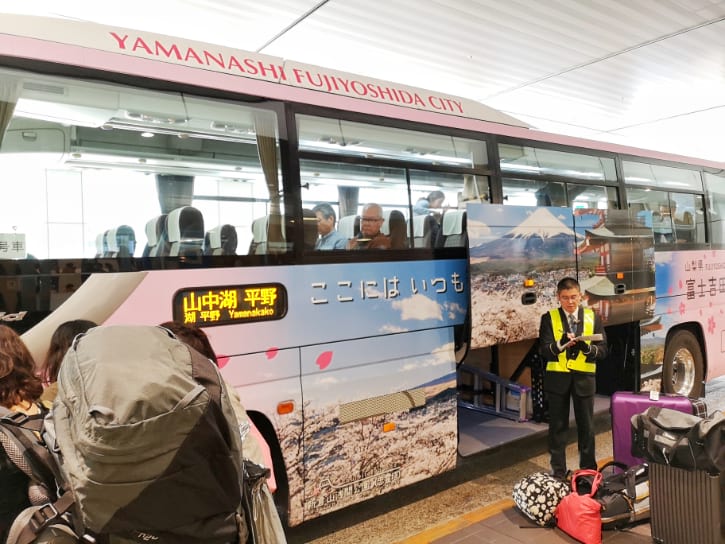
The cheapest way to get from Tokyo to Mount Fuji is taking the Fujikyuko Bus or Keio Bus . For a single trip , you just have to pay 2,200 yen per person for the bus ticket price. The ride takes around 1 hour 45 minutes .
You can take the bus from level 4 of the Shinjuku Expressway Bus Terminal in Tokyo. It’s located beside the Shinjuku Train Station.
This is a direct bus route and it will stop at Kawaguchiko Station and Fuji-Q Highland .
Bus Information:
- The buses leave every 10 to 30 minutes and they start at 6:45 AM and end by 8:15 PM. You can book the bus tickets online or directly at the bus terminal.
- I personally prefer booking online because there are times the tickets at the bus terminal are fully booked.
2. Fuji Excursion (Limited Express Train)
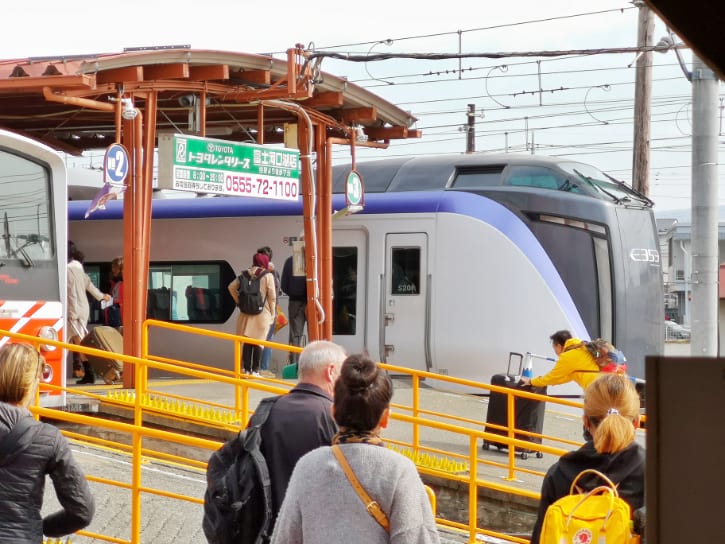
From Shinjuku Station (Tokyo) , take the Fuji Excursion Limited Express Train to Mount Fuji . The single journey takes around 1 hour and 53 minutes and costs roughly 4,130 yen per person. This train will take you directly to Kawaguchiko Station, which is in the Mt. Fuji area.
Train Information:
- The train only provides 3 round trips every day between Tokyo and Mount Fuji. The departure times from Shinjuku Station are 7:30 AM, 8:30 AM, and 9:30 AM.
- And for the return trip, the departure times of the trains from Kawaguchiko Station are 3:03 PM, 4:51 PM, and 5:36 PM.
- You can buy your train tickets online or purchase these at the ticket office of Shinjuku Station .
If you opt for an online reservation, here’s a step-by-step guide that you can follow. Alternatively, you can book the train tickets online here , which is much easier than using the website below.
- Head to the JR-East Train Reservation website .
- Choose “Purchase tickets” (Customers not using a pass).
- Click on “Search by Line”.
- Line: “Chuo Line(Chiba/Tokyo – Matsumoto, and others)”, Departure station: “Shinjuku”, Arrival station: “Kawaguchiko” and Date of travel: Select the date you want to visit.
- Click on “Search”.
- Choose FUJI EXCURSION 3 (Departure time is 7:30 AM)/ FUJI EXCURSION 7 (Departure time is 8:30 AM)/ FUJI EXCURSION 11 (Departure time is 9:30 AM)

3. Fuji Day Tour
Taking the Mount Fuji day tour from Tokyo is the best choice if you don’t have extra time to plan for your day trip .
This is highly recommended if you just want to sit back, relax, and let the tour guide bring you to the main sights .
Aside from saving time from doing your research, this minimizes the possibility of getting lost during your travel . It’s because everything is already accounted for during the day tour.
You can check out one of the best tours here: Mt. Fuji Tour 1 / Mt. Fuji Tour 2 / Mt. Fuji Tour 3 , if you’re looking a stress-free trip.
An alternative way to enjoy a day trip to Mt. Fuji is to hire a private car charter . You can book their car service here , which comes with a professional English-speaking driver. Plus, you have the flexibility to customize your own itinerary .
Mount Fuji is such a gorgeous place to explore. It is loaded with beautiful views, breathtaking gardens, traditional sites, and a lot more.
So, let me introduce you to the 10 best things to do and see around Mt. Fuji . All of these are perfect for a one-day trip , especially for first-time visitors who want to discover this amazing place from Tokyo.
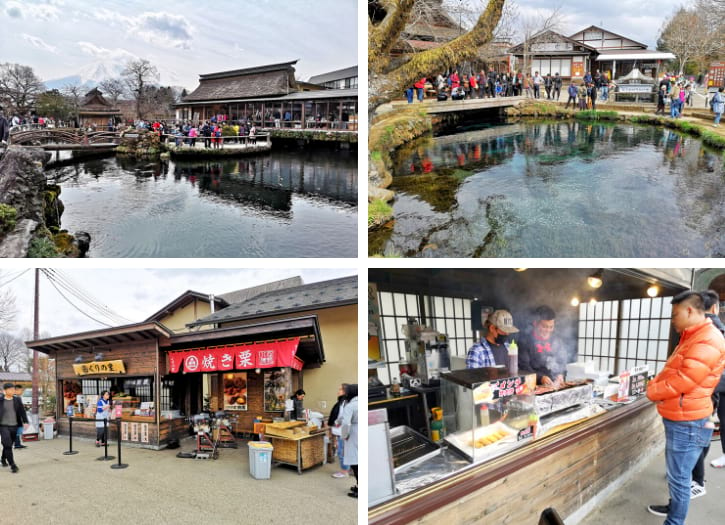
A Mt. Fuji day trip from Tokyo is incomplete without experiencing the serene charm of Oshino Hakkai .
This small village is filled with eight scenic ponds and offers many gorgeous sights to capture . Walk around the beautiful pathways and enjoy the peaceful ambience.
As you explore the ponds, try to take a photo of Mount Fuji and the traditional sites surrounding the area .
Along the way, you’ll come across various local vendors selling tasty snacks and drinks .
There are also plenty of souvenir shops that feature unique crafts and artistic products.
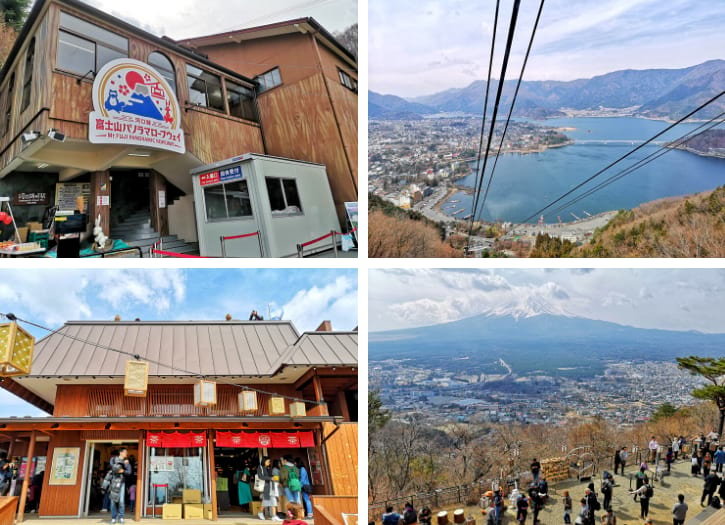
Kachi Kachi Ropeway should also be on your Mount Fuji day trip list. This cable car offers you an exceptional journey bounded by breathtaking lake views and mountain sights .
Without a doubt, this is one of the best spots to take a photograph of Mount Fuji .
Glide your way from the shore of Lake Kawaguchiko to the observation peak along Mount Tenjo.
There’s an option for you to avail of the round trip and simply just relax while the cable car travels back and forth.
But if you want extra fun, you may take off at the observation deck and then tour around the place.
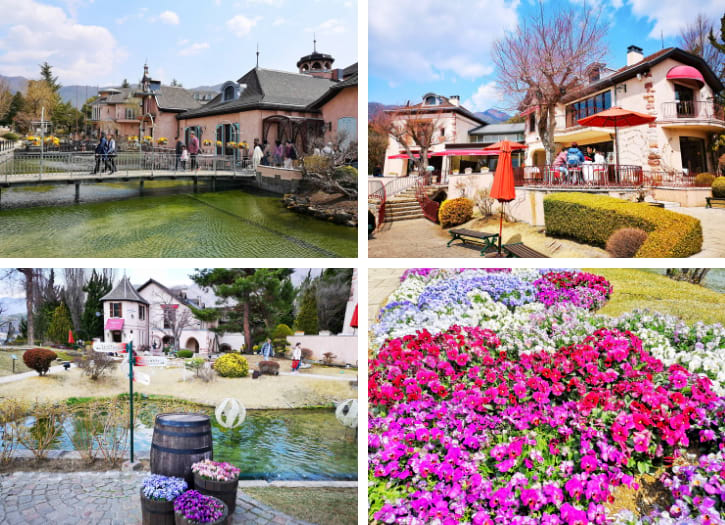
Visit the Kawaguchiko Music Forest Museum and be in awe of the European-inspired designs .
This beautifully styled theme park is known for its cosy atmosphere and unparalleled view of Mount Fuji .
Aside from its themed landscapes, the inside of the museum holds a special collection of musical instruments .
Navigate the antique exhibits and unravel the array of vintage organs .
There are also several musical experiences as well as instrument demonstrations for everyone. And, make sure not to miss the live performances and sand art storytelling shows.
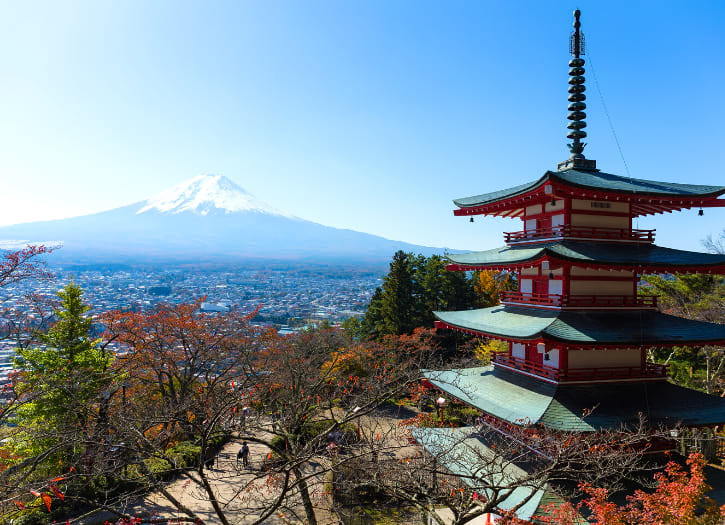
Head to the 5-storied Chureito Pagoda and see the spectacular Mount Fuji from afar .
This well-known shrine requires you to hike your way up the mountain. It takes around 400 steps to reach the top , so ready yourself in advance.
While at the top, explore the popular pagoda and capture the beautiful views of the iconic mountain and surrounding lakes .
If you visit the place during spring or autumn , the shrine’s even more captivating because of the bright nature colors.
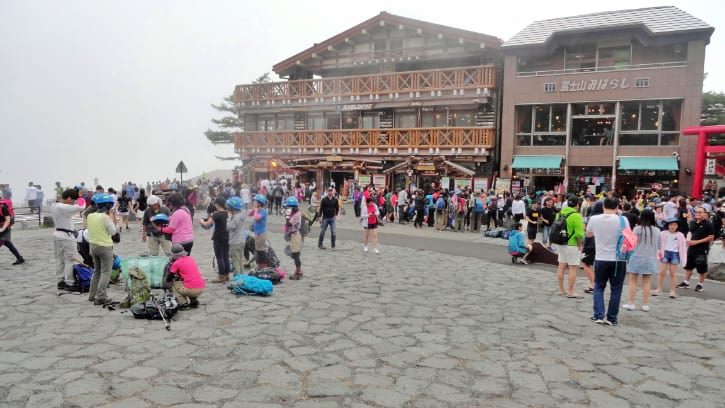
Take a trip to Mt. Fuji 5th Station or Fuji Subaru Line 5th Station. This is the starting point for those who want to see Mount Fuji up-close .
It is located near the Yoshida Trail, which opens up halfway to the summit of the famous mountain.
So, if you don’t have extra time to climb the peak of Mount Fuji, simply visit this place and enjoy the incredible sights. Watching the hikers ascend to the top is already a remarkable experience.
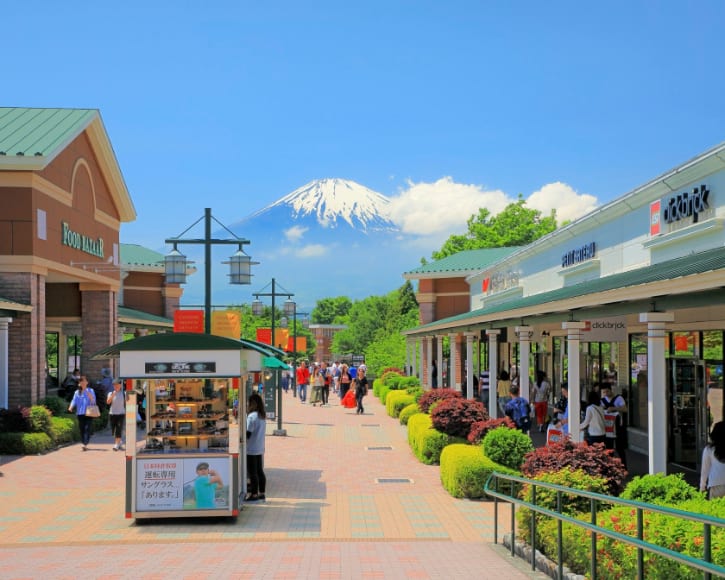
If your Mount Fuji day trip from Tokyo has a shopping agenda, Gotemba Premium Outlets is a top pick. This flagship mall is situated in Gotemba, offering a remarkable view of Mt. Fuji.
Unlike other shopping centers, this one is very huge , featuring over hundreds of stores and restaurants .
Go around the different stalls and find various international brands . There are plenty of fashion items , household goods , electronics , and sports stuff .
Aside from the shops, this mall comes with its own Ferris wheel, hotel, and hot spring bath.
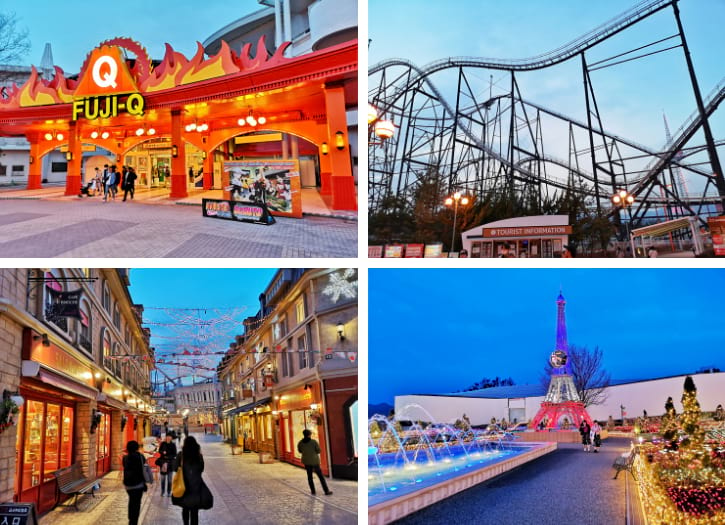
Fuji-Q Highland might not be as popular as Tokyo DisneySea or Tokyo Disneyland , but it’s definitely a must-visit amusement park .
Try the thrilling roller coasters that cater to all kinds of adventure-seekers . There are fast-paced as well as steep ones to fuel your adrenaline.
If you’re not a fan of scary rides, don’t worry because there are other options.
Be entertained by the themed attractions that are mostly based on famous anime series . You can also complete some mazes and enjoy traditional rides like carousel, teacup, and more.
To top it all, there are restaurants, souvenir shops, and rest areas.
And before you visit the park, it’s recommended that you book the admission tickets from website 1 or website 2 to save money.
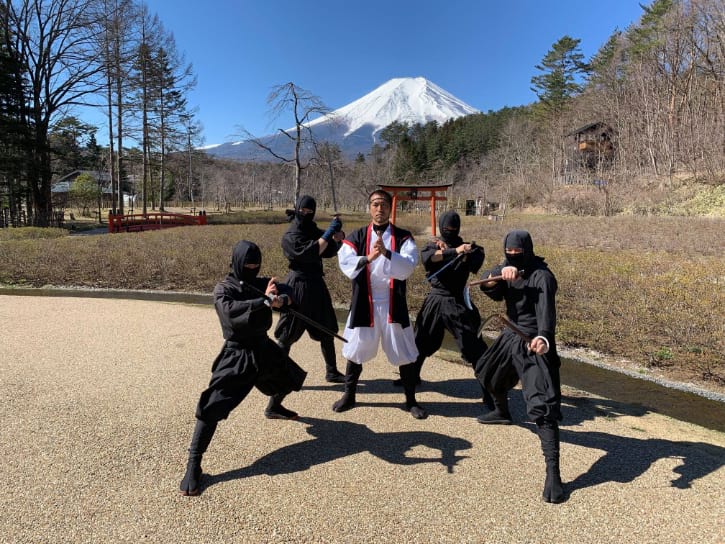
Drop by Oshino Ninja Village and witness some incredible ninja performances .
This scenic complex welcomes visitors with their one-of-a-kind presentations. And to make the shows even more exciting, they are all dressed up in character.
Be mesmerized by their amazing ninja fighting skills and techniques that are really fun to watch . While they are performing, you can also catch a glimpse of Mt. Fuji.
And if you have extra time, wander around the vast Japanese garden and enjoy the relaxing atmosphere.

Visiting Mt. Fuji between April and May? Don’t miss the Fuji Shibazakura Festival , one of the most anticipated annual events.
At this time, people flock to the Fuji Five Lakes area to witness the incredible landscape of Shibazakura .
Watch the beautiful combination of pink and purple hues that stretches up to 2.4 hectares of land.
The captivating flower scene is set against the unmatched backdrop of Mt. Fuji .
So, be ready to capture this spectacular sight or simply revel in the beauty straight from your eyes.
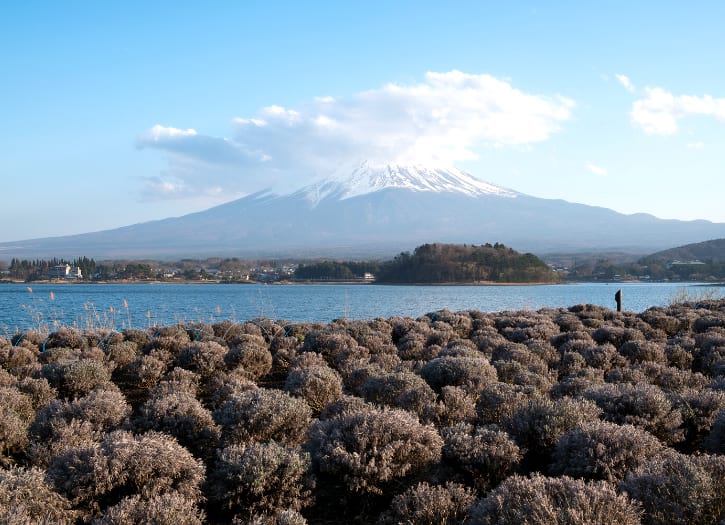
Stroll around Oishi Park and enjoy the picturesque nature views .
This park is very popular for its fields of lavender that are set near the panoramic Mt. Fuji and the pristine Lake Kawaguchiko.
Because of its gorgeous landscape, it has become a favorite among photographers .
And if you want to have a more amazing experience, try to visit the place during early summer . This is the best time to catch the Kawaguchiko Herb Festival and see the seasonal flowers in full bloom.
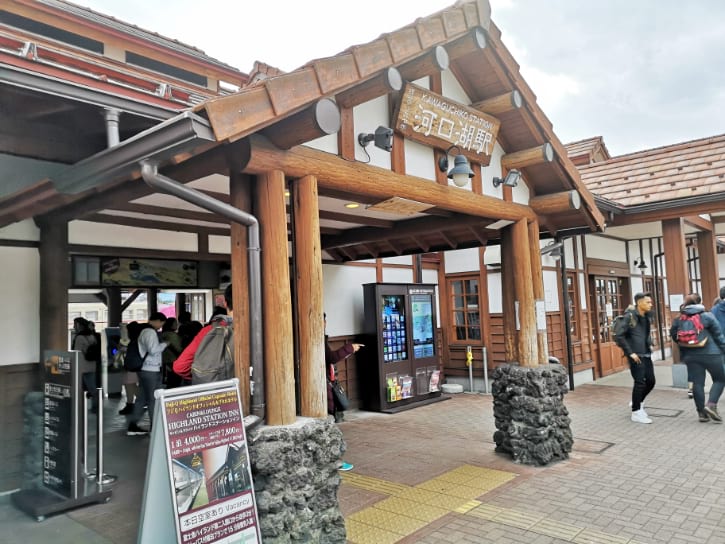
Once you reach Kawaguchiko Station from Tokyo, there are 5 types of buses to choose from. These buses help you get around the Mount Fuji area conveniently .
But be reminded that each bus covers different tourist spots. Don’t worry because I’ll explain everything in detail later on.
If you want to visit Chureito Pagoda , it’s highly recommended that you take a train instead. It’s the best and fastest way to reach the shrine. You can get more information about this option through point 6 written below.
1. Omni Buses
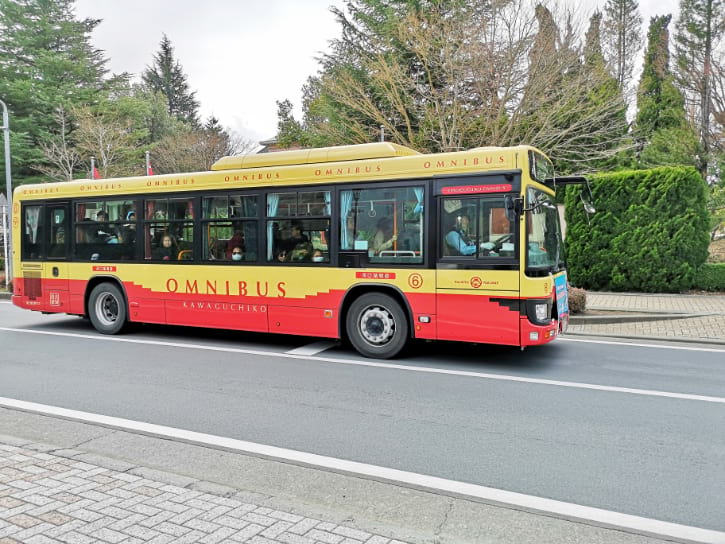
Omni buses have 3 lines , and these are Kawaguchiko Sightseeing Bus (Red-Line), Saiko Sightseeing Bus (Green-Line), and Narusawa/Shojiko/Motosuko Sightseeing Bus (Blue-Line). You can easily get on the buses upon arriving at Kawaguchiko Station.
If you want to save money, try to avail of the pass that offers unlimited use for all three lines.
You can use this pass for two consecutive calendar days . Each pass costs 1,700 yen .
- Red-Line: This bus covers major sights such as Kachi Kachi Ropeway, Kawaguchiko Music Forest, Oishi Park, and Fuji Q Highland
- Green-Line: For attractions like Kawaguchiko Herb Hall, Saiko Bat Cave (Lava Cave), and Lake Saiko, choose this one.
- Blue-Line: Take this if you want to visit Fuji Q Highland, Fujisan World Heritage Center, Fugaku Fuketsu (Wind Cave), Narusawa Hyoketsu (Ice Cave), and Lake Shojiko.
2. Fujikko-Go Bus
For those planning to go to Oshino Hakkai , Oshino Ninja Village , Fuji Q Highland , and around Lake Yamanakako , ride the Fujikko-Go Bus .
The two-day unlimited ticket for this bus is 1,700 yen per person.
3. Fuji-Subaru Line (Shuttle Bus)
If you want to reach Mt. Fuji 5th Station , take the Fuji-Subaru Line that is located at the Kawaguchiko Station. Then, get off the shuttle bus at the Fuji-Subaru Line 5th Station .
The one-way trip takes around 50 minutes while the bus fare is 1,780 yen . For the round-trip , it costs 2,800 yen .
4. Local Bus (Line A or Line C)/ Express Bus
Opt for the local bus (Line A or Line C) or express bus if you wish to go to Gotemba Premium Outlets .
If you choose the local bus , the single trip takes around 1 hour and 35 minutes and costs 1,540 yen .
For the express bus , the travel duration is about 1 hour and the price is 1,630 yen .
If the first or last stop of your trip to Mount Fuji is Gotemba Premium Outlets, you can visit this website . This will show you how to go from Tokyo and vice versa.
5. Shibazakura Liner (Shuttle Bus)
The last option is via the Shibazakura Liner (Shuttle Bus) . This bus takes you from Kawaguchiko Station to Fuji Shibazakura Festival for roughly 40 minutes . The fare costs 2,400 yen , which already includes the entrance fee and round-trip .
Do take note that the Fuji Shibazakura Festival is only best to explore from mid-April until the end of May . The rest of the days are no longer worth the visit.
6. Fujikyu Railway Line
As mentioned earlier, if you want to explore Chureito Pagoda , you should take the Fujikyu Railway Line .
Ride the train from Kawaguchiko Station to Shimoyoshida Station , which takes around 15 minutes . You have to pay 310 yen for this one-way trip .
I have prepared some sample day trip itineraries from Tokyo to Mount Fuji below to help you during your preparation.
Each itinerary will show you how long you should stay at each attraction . It also details out the ways on how to visit the places .
Also, don’t miss to check out my perfect 7 day Tokyo itinerary , which is very helpful for first-timers!
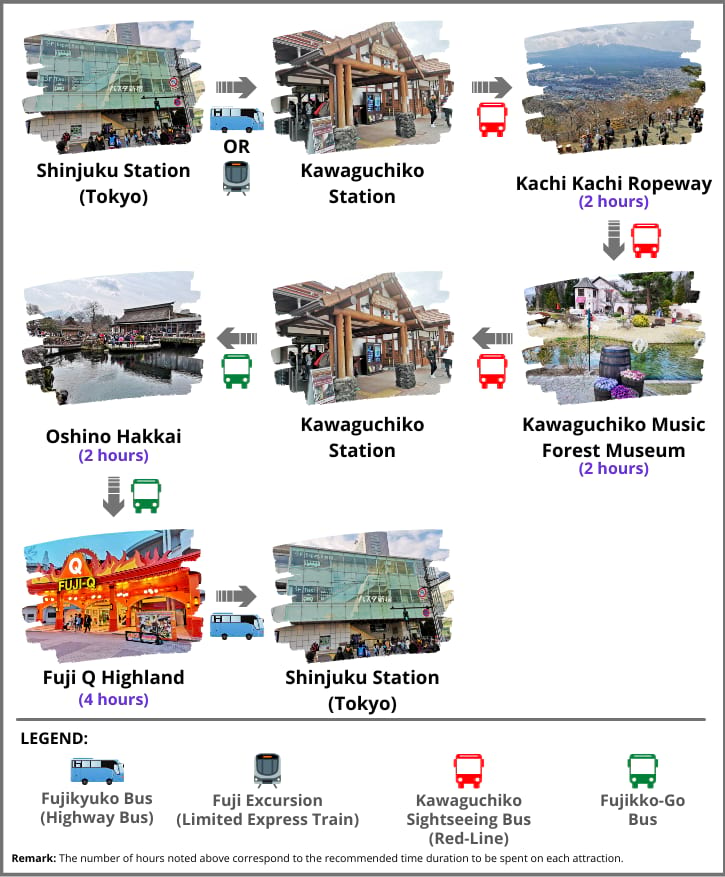
- Detailed Information for Option 1 Itinerary
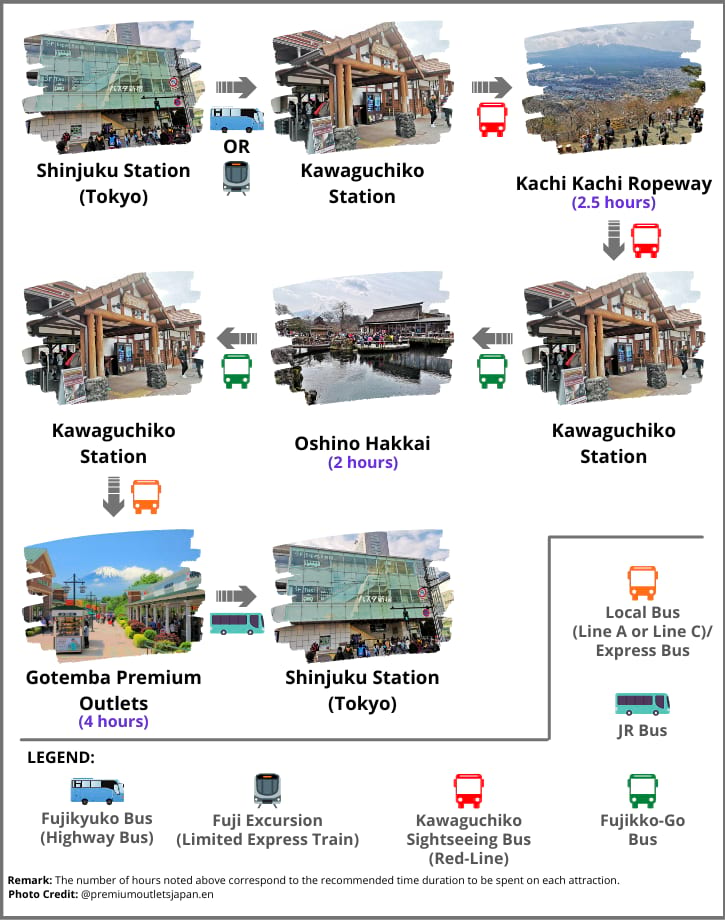
- Detailed Information for Option 2 Itinerary
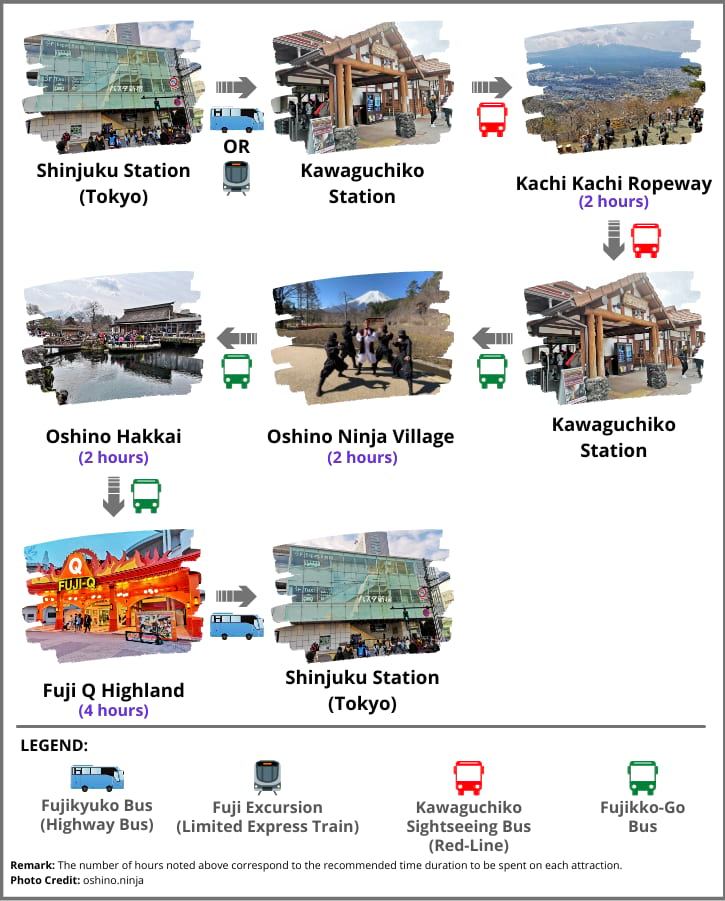
- Detailed Information for Option 3 Itinerary
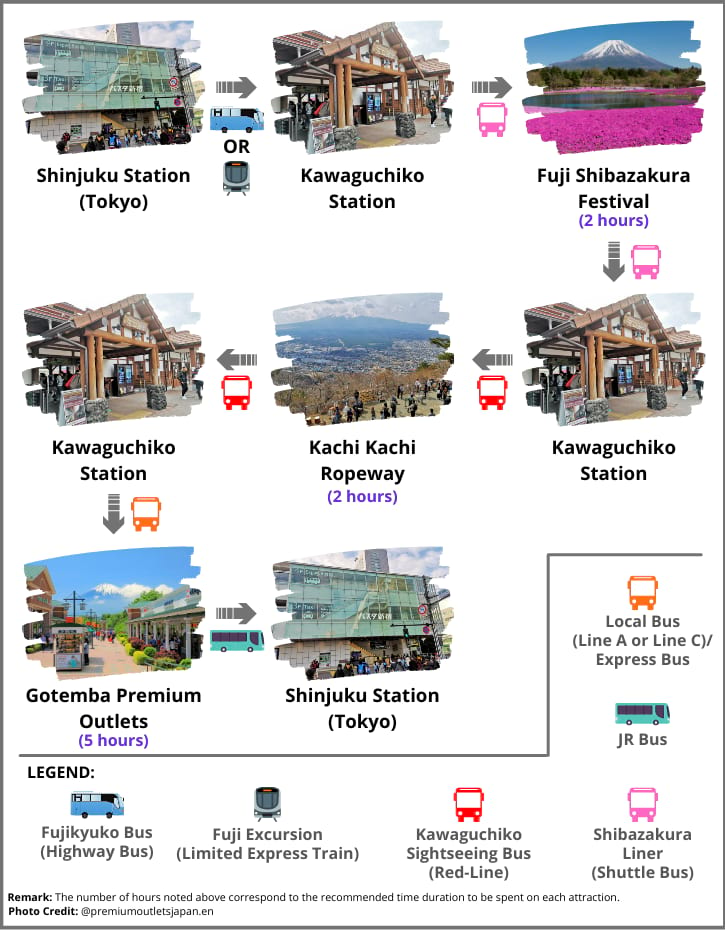
- Detailed Information for Option 4 Itinerary
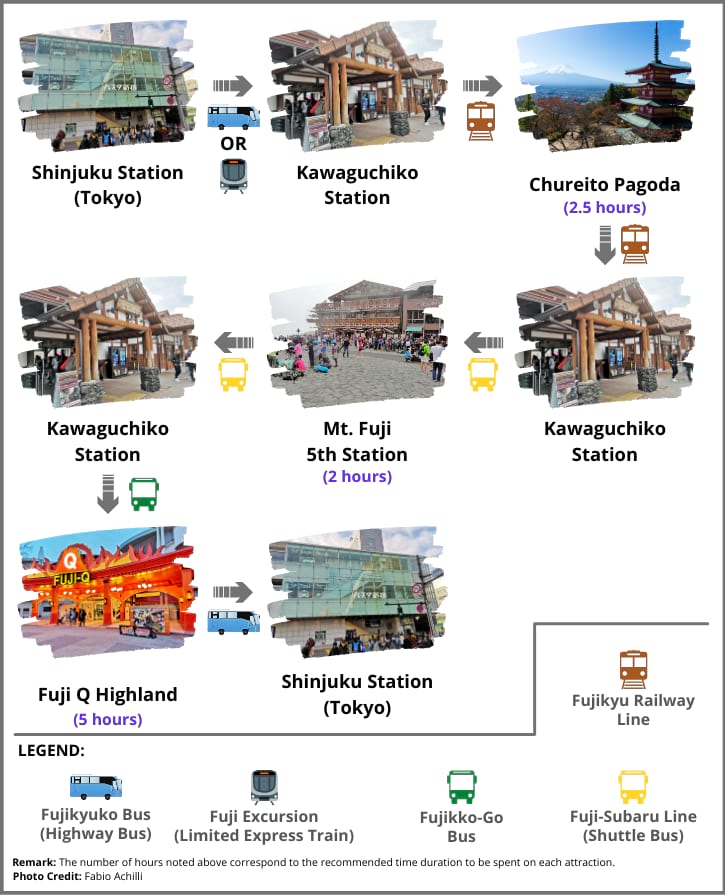
- Detailed Information for Option 5 Itinerary

Tokyo Itinerary: The Best 7-Day Guide for a Fantastic Trip

17 Best Things to Do in Shinjuku with My Perfect Itinerary

35 Best Things to Do in Tokyo You’ll Want to Go in 2024
28 thoughts on “tokyo to mount fuji: a complete day trip guide for you”.
Hi! May I know can I board the Omni Red Line bus from the midway bus stop at Kachi Kachi Ropeway to Kawaguchiko Living Center (Oishi Park) instead of starting at Kawaguchiko Station? Additionally, am I able to use my Pasmo card for this journey without the need to purchase a pass?
Hi Jamie, you can board the Omni Red Line bus at Kachi Kachi Ropeway; there’s no need to start at Kawaguchiko Station. However, you can’t use your Pasmo card on this bus. Instead, you’ll need to purchase a pass directly from the bus driver when you get on.
hi, I love the detailed itinerary – can you suggest a route if we want to visit these places only, we plan to go by January Thanks in advance! > GOTEMBA OUTLET > LAKE KAWAGUCHI > OSHI NO HAKKAI > CHUREITO PAGODA
Hi radgj, I suggest the following route for your day trip: Shinjuku Expressway Bus Terminal > Odakyu Bus/ JR Bus > Gotemba Premium Outlets > Limited Express Bus > Kawaguchiko Station > Red Line Bus > Lake Kawaguchi > Red Line Bus > Kawaguchiko Station > Fujikko-Go Bus > Oshino Hakkai > Fujikko-Go Bus > Kawaguchiko Station > Highway Bus/ Fuji Excursion > Shinjuku (Tokyo).
Organizing these four places into one day trip is difficult due to the considerable distances between them, which results in longer commute times.
Hi! Thank you for the useful information and itinerary suggestions! I saw in an earlier comment that Pasmo cards (i assume Suica as well) are not usable for Omni. Are they not usable for all bus types apart from the local buses?
Yes, Pasmo and Suica cards cannot be used for Omni and other bus types, except local buses.
Hi Josh, Can you suggest a route for these places that we are planning to visit as a day trip. Thanks in advance Lake Kawaguchi Oshino Hakkai Chureito Pagoda Mt fuji Panoramic Ropeway Kawaguchiko Music Forest Museum
Here’s my suggested route for you:
Kawaguchiko Station > Red Line Bus > Lake Kawaguchi > Walk to Mt Fuji Panoramic Ropeway Station > Red Line Bus > Kawaguchiko Music Forest Museum > Kawaguchiko Station > Fujikko-Go Bus > Oshino Hakkai > Fujikko-Go Bus > Mt. Fuji Station > Take Highway Bus or Fuji Excursion Limited Express Train to return to Tokyo
I didn’t include Chureito Pagoda in my suggested route because this attraction requires more time, and I don’t think it can be visited with the above attractions in one day.
Hi, thank you so much for the information! Could you please suggest a route if we want to visit these places only for a day trip, we plan to go in the end of Nov. Thank you so much! 1. Kachi Kachi Ropeway 2. Oishi park 3. Oshino ninja village 4. Chireito pagoda
Sorry for my late reply.
Here you go: Kawaguchiko Station > Red Line Bus > Kachi Kachi Ropeway > Red Line Bus > Oishi Park > Red Line Bus > Kawaguchiko Station > Fujikko-Go Bus > Oshino Ninja Village > Fujikko-Go Bus > Mt. Fuji Station > Fujikyu Railway Line > Shimoyoshida Station > Walk > Chireito Pagoda > Walk > Shimoyoshida Station > Fujikyu Railway Line > Mt. Fuji Station > Use the Highway Bus or Fuji Excursion Limited Express Train for your journey back to Tokyo
Hi Josh, l going to Tokyo soon and also travel to Nikko and Mt Fuji area. I already have esim and wonder it’s necessary to carry a portable WiFi since on the outskirts the signal will be weak. Please advise and thank you!
Hi Tom Quah, you should be good to go with your eSIM as long as it can connect to the internet. This way, you won’t have to bother carrying a portable Wi-Fi device.
HI, Can you suggest a day trip itinerary to mount fuji by car and then we will continue our journey to Matsumoto. I’m not planning any shopping for this trip if possible . Thanks in advance
Hi Suria, I recommend this driving route for you: Start at Kachi Kachi Ropeway, then head to the Kawaguchiko Music Forest Museum, followed by Oshino Hakkai, and finish at either Chureito Pagoda or Fuji-Q Highland. Hope you like it!
Can you suggest an itenary for Lake Kawaguchi Mt Fuji 5th Station Oshino Hakkai Ropeway Gotemba Outlet
And any tour that includes above.
Thanks Rohit
Hi Rohit, It’s challenging to visit all the places you’ve listed in one day, as some are quite far apart.
Here’s my suggested itinerary for you:
- Start at Kawaguchiko Station
- Take the Red Line Bus to Lake Kawaguchi
- Walk to the Ropeway
- Return to Kawaguchiko Station via Red Line Bus
- Board the Fujikko-Go Bus to Oshino Hakkai from Kawaguchiko Station
- Take the Fujikko-Go Bus back to Kawaguchiko Station
- Catch the Limited Express Bus to Gotemba Premium Outlets
- From Gotemba Premium Outlets, return to Shinjuku Expressway Bus Terminal via JR BUS
For a day tour, consider the popular Mt. Fuji tour covering Mt. Fuji 5th Station, Lake Kawaguchi, Oshino Hakkai, and Gotemba Premium Outlets.
If you’re going on a trip with a group or family, check out the Mt. Fuji private one-day tour . It’s great because you can customize your itinerary to your preference.
Hi Josh, I’m planning to visit Oshino Hakkai, Ropeway and Lake Kawaguchiko boat ride. If I’m taking the Fuji Excursion Limited Express train, would it make more sense to alight at Mt Fuji station instead of Kawaguchiko station and take the bus there to Oshino Hakkai?
Yes, you’re correct.
For option 2, if I remove Gotemba premium from the itinerary, will I be able to reach Tokyo before 4 pm? I will take the first trip from Shinjuku to to Kawaguchiko.
Hi Jess, I think it should be okay, but it’ll be a bit rushed. You need to make sure to reach the Kachi Kachi Ropeway (Mt. Fuji Panoramic Ropeway) by 9:00 AM and perhaps plan to stay there for about 1.5 hours before heading to another destination.
For your return trip to Tokyo, you should take the highway bus, as the first Fuji Excursion train from Kawaguchiko Station doesn’t leave until 3:03 PM.
If you’re rushing for a flight on that day, then I wouldn’t suggest visiting Mt. Fuji
Hi Josh: I had bought Fuji Hakone 3 days pass. I will go to mount fuji from shinjuku. I will stay a night at mount Fuji and travel to Hakone the next day. Here are the places that i wish to visit: Lake Kawaguchi Mt Fuji 5th Station Oshino Hakkai Ropeway Gotemba Outlet Can you please give me some guide? Is Fuji Hakone pass will allow me to take any type of buses or train? Thank you in advance for your help. Sim
Hi Hui Hui,
I would recommend following this route: Day 1: Kawaguchiko Station > Fuji Subaru Line Bus > Mt Fuji 5th Station > Fuji Subaru Line Bus > Kawaguchiko Station > Red Line Bus > Ropeway > Walk > Lake Kawaguchi > Red Line Bus > Kawaguchiko Station > Fujikko-Go Bus > Oshino Hakkai > Fujikko-Go Bus > Kawaguchiko Station/ Mt. Fuji Station Day 2: Traveling from Kawaguchiko Station to Gotemba Outlet via the Limited Express Bus
I haven’t personally used the Fuji Hakone Pass before, and I found that it doesn’t cover much of the transportation in the Fuji area. I believe it doesn’t include the Red Line Bus and Fujikko-Go Bus.
Im planning to visit the following mid dec 2023. How should i plan it. is it feasible to do all and able to catch the highway bus back (6.35pm)
Chireito pagoda Lake Kawaguchi Oishi Park Honcho street Kachi Kachi Ropeway Oshino Hakkai
Thank you so much Jac
Hi Jac, I’ve decided to skip Oishi Park in the itinerary since it’s quite far from Chureito Pagoda, Honcho Street, and Oshino Hakkai. I don’t think it’s feasible to visit all these places in one day. So, here’s my alternative suggested route for you. I hope you find it helpful.
Kawaguchiko Station > Red Line Bus > Kachi Kachi Ropeway > Red Line Bus > Kawaguchiko Station > Fujikyu Railway Line > Shimoyoshida Station > Walk > Chireito Pagoda > Walk > Honcho Street > Walk > Shimoyoshida Station > Fujikyu Railway Line > Mt. Fuji Station > Fujikko-Go Bus > Oshino Hakkai > Fujikko-Go Bus > Mt. Fuji Station > Going Back to Tokyo.
Hi Josh, thank you so much for the information! Could you suggest a route if we want to visit these places only for a day trip, we plan to go on mid January. Thank you so much! 1. Kachi Kachi Ropeway 2. Oishi park 3. Oshino Hakkai 4. Chireito pagoda 5. Kawaguchiko Music Forest Museum
I didn’t include Chureito Pagoda in the itinerary because it’s quite far from the other four places. I don’t think it’s possible to cover all of them in one day. Here’s my suggested route instead. I hope you’re fine with this change.
Kawaguchiko Station > Red Line Bus > Kachi Kachi Ropeway > Red Line Bus > Kawaguchiko Music Forest Museum > Red Line Bus > Oishi Park > Red Line Bus > Kawaguchiko Station > Fujikko-Go Bus > Oshino Hakkai > Fujikko-Go Bus > Mt. Fuji Station > Return to Tokyo.
Hi Josh, thank you so much for the information! Could you suggest a route if we want to visit these places only for a day trip, we plan to go next week. Thank you so much! 1. Honcho street 2. Oishi park 3. Oshino Hakkai 4. Chireito pagoda 5. FujiQ highland 6. Arayayama Shrine
It’s quite challenging to visit all the suggested places in just one day trip. Below is the itinerary I recommend:
Kawaguchiko Station > Red Line Bus > Oishi Park > Red Line Bus > Kawaguchiko Station > Fujikko-Go Bus > Oshino Hakkai > Fujikko-Go Bus > Mt. Fuji Station > Fujikyu Railway Line > Shimoyoshida Station > Chireito Pagoda > Honcho Street > Shimoyoshida Station > Fujikyu Railway Line > Kawaguchiko Station/ Mt Fuji Station > Highway Bus > Head back to Tokyo
Leave a Comment Cancel reply
Send me an email when the author replied my comment. (Please take note your comment only will show on this blog post after approved by me to prevent spam comments.)
Truly Tokyo
A Tokyo Travel Guide
A Day Trip to the Mt. Fuji Area: Lake Kawaguchiko
There are a number of places to enjoy stunning views of Mt. Fuji, and one of the most accessible from Tokyo is Lake Kawaguchiko. Make the most of a day trip out to the area with this one-day itinerary.

There are many places to enjoy stunning views of Mt. Fuji, but few are as picturesque an area as Lake Kawaguchiko. Not only is it remarkably beautiful, there’s plenty to do in the area too. Active folks will want to cycle, hike, or go fishing; while those who prefer more leisurely activities might like to explore the many museums surrounding the lake.

Our itinerary takes you on a leisurely exploration of some great sights in the Lake Kawaguchiko area - with plenty of opportunities to enjoy the view of Mt. Fuji.

Notes Before You Go
- One of the most economical ways to travel to and from the Mt Fuji area is by highway bus from Shinjuku Station to Kawaguchiko Station. A single journey is JPY1750 and takes approximately 1 hour 45 minutes from the Shinjuku Bus Terminal. Return or one-way tickets can be booked online on the Highway Buses Japan site. You can also buy your ticket back to Shinjuku at Kawaguchiko Station once you’re there, though you may have fewer options on the day itself.
- We suggest taking an early morning bus - departing around 7:30am or so - to arrive at around 9:30am. This will give you a full day in the area.
- Bear in mind that the bus journey returning to Tokyo in the evening can coincide with rush hour, depending on your timing. Traffic conditions can slow down the journey considerably and take up to 3 hours. If you’d rather get back to Tokyo faster and don’t mind paying a little extra, consider taking the train.

- For getting around the Lake Kawaguchiko Area, we recommend purchasing a bus pass that gives you unlimited rides on the “Retro Bus” sightseeing bus lines. (A PDF version of the bus map can be found here and saved to your phone for easy access.) The stop numbers in this itinerary refer to the map of the Red Line in this PDF. Buses along the line operate at 15-minute intervals, so you’re never left waiting long before the next one comes along.
- The pass costs just JPY1500 and is valid for two days. It’s fantastic value even if you’re not staying overnight in the area. A one-way ride from the first stop to the last stop on the Red Line, for instance, costs JPY480. On a day trip, it’s entirely possible to recoup the cost if you use it frequently enough. Just show this pass to your driver every time you alight.

- An alternative if you’d rather have a more active day is to rent bicycles from the shop near Kawaguchiko Station. A non-electric bicycle costs JPY1500 to rent for the day, and you could easily do this itinerary on a bike rather than taking the bus. On a clear, cool day, this might be a good choice for the more athletic traveler. There aren’t dedicated cycle paths, however, so you’ll either be on normal roads or the pavements.
- Itinerary timings are approximate. Adjust them to suit your schedule. Add or subtract places from this itinerary as you prefer, but it’s generally better to enjoy a few places properly than to sprint through many places. The most important thing is to ensure that you’re back at Kawaguchiko Station in good time to catch your bus back to Shinjuku.

7:45am Shinjuku Bus Terminal
The easiest way is to find the Shinjuku Bus Terminal is to take the South Exit 南口 from JR Shinjuku Station. Once you’re outside the ticket gates, walk outside to street level.

You’ll see a building opposite the South Exit that looks like this. Cross the road and take the elevator up to the 4th floor as indicated in the photo (or the escalators).

Once you emerge from the escalator, there’ll be a map a little to your left showing you where the various bus stops are. Buses to the Mt. Fuji area typically depart from stops B5 or B6.
Sometimes it won’t be entirely clear which bus stop it is, but just bring your ticket to the bus station attendant and check with them. For this reason, it’s best to arrive at least half an hour before your bus is due to leave to give yourself extra time for the last minute things - like an extra cup of coffee from Family Mart.

9:30am Arrive Kawaguchiko Station
Once you alight at Kawaguchiko Station, the first thing you should do is to pick up a bus pass. You’ll want the 2-day sightseeing pass that’s valid across all lines - whether it’s the red, green, or blue lines.

While optional, you could pick up a copy of this tourist booklet. There are short guides to sights and restaurants in the area, and an overall map of the area at the back of the booklet. You’ll find this at the tourist information counter.

10:00am Mt. Kachikachi Ropeway to Tenjoyama Park
The cable car up to Tenjoyama Park, from where you’ll see a super view of Mt. Fuji, is actually about a 15-minute walk from Kawaguchiko Station. Since it’s the 11th stop on the line, riding the bus will take you on a more circuitous route. Both the bus ride and the walk are about 15 minutes. Alight at Stop 11.

On busier days, there might be a long queue snaking up the staircase. Have someone else in your group wait in line while you head upstairs to buy cable car tickets at the machine - it’s a JPY800 return journey. Cable cars run every 5-10 minutes, so you shouldn’t have to wait too long. It’s a 3-minute ride to the top of Mt. Tenjoyama.

On a clear day, the view from the observatory deck is pretty impressive - even if the top of Mt. Fuji happens to be obscured by a passing cloud.

Take a few minutes to poke around the kitschy rabbit and tanuki-themed shrines and souvenir shop before heading back down. For the energetic, there’s a gentle 40-minute hiking trail leading down from the top of the mountain, which is particularly pleasant in cooler weather.

11:30am Lunch at Hōtō Fudō
Once you’re done with the pretty views, take the cable car back down and return to Stop 11. Take the bus to Stop 17, which is outside the Music Forest Museum.

Cross the road and head towards the nearest intersection as pictured above. Cross the road and take the small path running parallel to the main road. You’ll pass through some fields and a few standalone houses. Hōtō Fudō is the large restaurant across the road at the end of the path.

You’ll be eating Hōtō noodles here. There's almost nothing else on the menu, save for some decent simmered intestines, inarizushi (rice in tofu pockets), and Japanese pickles. These noodles are a local Yamanashi specialty, consisting of thick, chewy wheat noodles (texturally rather like rustic dumplings, or knife-cut Chinese noodles) and simmered seasonal vegetables in a rich miso-based broth. Don’t forget to stir in some shichimi chili powder.

Diners have the option of tatami mat or table seating. We suggest asking for seats by the window - the cool breeze blowing in makes the hot noodles go down a treat.
If you’re not keen on wheat noodles for lunch, skip this and head straight to the next stop. There’s a cafe at the Kawaguchiko Natural Living Center with curry rice options.

12:45pm Kawaguchiko Natural Living Center
Walk back to Stop 17. It’s a short 10-minute ride to the end of the line - the Kawaguchiko Natural Living Center.

Skip the souvenir shop and walk around the flower gardens - you’ll see all kinds of blooms across the seasons, from lavender and hydrangeas to bellflowers and roses.

It’s a heavily manicured garden, with plants in overly-neat, fussy rows. Still, it’s quite picturesque if you enjoy this style of garden. Plus, there's a magnificent view of Mt. Fuji with the lake in the foreground. Have an ice cream. Take some time to enjoy the surroundings.
During the summer, you can also sign up for a fruit picking session. This will vary with the weeks, but options might include cherries, blueberries, and cherry tomatoes. While the fruit farms aren’t located on the grounds of the center, the staff provide free transport to and from the farms after you sign up for a session (approximately 40 minutes of picking and eating). If you decide to include this in your itinerary, budget around an hour to an hour and a half spent at the center.

2:15pm Itchiku Kubota Art Museum
Hop back on the bus, this time heading back towards Kawaguchiko Station. Alight at Stop 19 for the Itchiku Kubota Art Museum.
Even if you’re not a huge fan of art museums, this one is worth visiting for the natural space it's in. The doorway to the museum looks like the entrance to hidden ancient ruins of some kind. Walk through and you'll find a gorgeous little waterfall with benches at the side. It's a wonderful place to lie down on a bench and nap - or stare at the shifting sunlight in the maple boughs above.

Entrance to the museum proper is JPY1,300 per person. The buildings are made of Okinawan corals and limestones, and they're almost more interesting than the objects they house - an eclectic collection of primitive art and Itchiku Kubota's beautiful tie-dyed painted silk kimono. With one exception, photography inside the museum is not allowed.

The tea room on the second floor of the main museum building is worth spending some time in. This looks out into a small waterfall and pond in an overgrown grove. The view is even prettier in the autumn when the fall colours are out. It's a lovely place to enjoy a cup of tea and some sweets; and photography is allowed here. When there are few visitors around, the staff won't mind if you take a seat to enjoy the view.

Don’t forget to explore the north side of the main building. Turn right as you exit and follow the path up into the forest. It’ll lead you to a mildly eerie, dimly-lit cave with a few statues inside - the source of the ice cold water streaming down the mountainside.

3:15pm Maple Corridor
After you’re finished with the museum, walk back to the main road, and through the Maple Corridor. It’s a short path flanked by maple trees on either side. It's best visited in autumn for the fall foliage.

3:30pm Ubuyagasaki Cape and Crossing Kawaguchiko-ohashi Bridge
Make your way back out to the main road and back to the same bus stop from before (Stop 19). Alight at Stop 15. Cross the road, heading to the lakeside walking path. The views of the lake and Mt. Fuji are fabulous.

Follow the path, all the while skirting the edges of the lake. Turn into the canopied walking path.

Further along, you’ll encounter a set of stone steps. Climb up.

You're now on Ubuyagasaki Cape, where you’ll see another view of Mt. Fuji.

Go back down and find your way onto the bridge. Walk across to the other side of the lake. It's a leisurely stroll that shouldn't take more than 15 - 20 minutes. If it's hot and sunny, we recommend parasols and plenty of water.

We recommend walking down to the lake shore after you reach the other side. Spend some time enjoying the waters - and the fabulous views.

4:15pm Tea time
It's time for a mid-afternoon pick-me-up. Find your way back to the main road from the lake shore. Turn left and walk up the road. The nearest stop is Stop 8, further up the road opposite the Yamanashi Gem Museum.
Ride the bus to Stop 10. Directly outside this bus stop opposite the road is a charming cafe with a frontal view of the lake - coffee and sweets.

Alternatively, ride the bus to Stop 11. Walk back the direction the bus came in until you see Cheesecake Garden on your left across the road. As the name suggests, it’s all about the cheesecake. There are around a dozen different kinds of cheesecake available, and every slice comes with a free cup of coffee.
5:30pm Kawaguchiko Station
Head back to Kawaguchiko Station in time for your bus back to Shinjuku Station. Generally it's best to time your arrival a little earlier than your intended departure time. Things can get a little chaotic around the bus stops, since traffic along the highway can cause bus delays. If that happens, it's best to show the bus attendants your ticket every time a bus to Shinjuku appears.
Mt. Fuji Area - Lake Kawaguchiko Day Trip Map
View the full size version of our Lake Kawaguchiko map which has each of the places discussed above marked on it.
Climbing or Visiting Mount Fuji from Tokyo
For more information about climbing Mount Fuji or other ways to enjoy the area, read our Climbing Or Visiting Mount Fuji guide here.
Check Hotel Availability
Destination, check-in date, check-out date.

Tokyo Vacation Checklist
- For all the essentials in a brief overview, see my First Time In Tokyo guide
- Check Tokyo accommodation availability and pricing on Booking.com and Agoda.com - often you can book with no upfront payment and free cancellation
- Need tips on where to stay? See my one page guide Where To Stay In Tokyo
- You can buy shinkansen (bullet train) tickets online from Klook - popular routes include Tokyo to Kyoto , Tokyo to Osaka and Tokyo to Hiroshima
- You can buy a Japan SIM card online for collection on arrival at Tokyo Narita or Haneda airports. Or rent an unlimited data pocket wifi router
- See my comprehensive Packing List For Japan
- Compare airline flight prices and timings for the best Japan flight deals . Check my guides to arriving at Narita Airport and at Haneda Airport .
- If you're visiting more than one city, you might save money with a Japan Rail Pass – see if it's worth it for you
- A prepaid Welcome Suica card makes travelling around Tokyo much easier - here's how
- World Nomads offers simple and flexible travel insurance. Buy at home or while traveling and claim online from anywhere in the world
Tokyo District Map

- Imperial Palace Area
- Tokyo Station
- Shimbashi Shiodome Hamamatsucho Shinagawa
- Akihabara Kanda
- Roppongi Akasaka
- Harajuku Aoyama
- Ebisu Daikanyama Meguro
Disclosure: trulytokyo.com is a participant in the Amazon Services LLC Associates Program, an affiliate advertising program designed to provide a means for sites to earn advertising fees by advertising and linking to amazon.com and amazon.co.uk. World Nomads provides travel insurance for travellers in over 100 countries. As an affiliate, we receive a fee when you get a quote from World Nomads using this link. We do not represent World Nomads. This is information only and not a recommendation to buy travel insurance.
We use cookies on this site to enhance your user experience. If you continue to browse you accept the use of cookies on our site. See our Cookie Policy for more information.
- Media & PR
- Meetings & Events
- School Groups
- Travel Trade
- Select Language 简体中文 繁體中文(香港) 繁體中文(臺灣) India (English) Bahasa Indonesia 한국어 ภาษาไทย Tiếng Việt Singapore (English) Philippines (English) Malaysia (English) Australia/New Zealand (English) Français Deutsch Italiano Español United Kingdom (English) Nordic countries(English) Canada (English) Canada (Français) United States (English) Mexico (español) Português العربية Japan(日本語) Global (English)
- India (English)
- Bahasa Indonesia
- Singapore (English)
- Philippines (English)
- Malaysia (English)
- Australia/New Zealand (English)
- United Kingdom (English)
- Nordic countries(English)
- Canada (English)
- Canada (Français)
- United States (English)
- Mexico (español)
- Global (English)
- Fujiyoshida
- Shimonoseki
- Ishigaki Island
- Miyako Island
- Kerama Island
- Tokyo Island
- Koka & Shigaraki
- Hida Takayama
- Ginza, Nihonbashi
- Beppu & Yufuin (Onsen)
- Ginzan Onsen
- Nagasaki Islands

- Kumano Kodo
- Shikoku Karst
- Amami Oshima
- Hachimantai
- Omihachiman
- Aizuwakamatsu

- Diving in Japan
- Skiing in Japan
- Seasonal Flowers in Japan
- Sustainable Outdoors
- Off the Beaten Track in Japan
- Scenic Spots
- World Heritage
- Home Stays & Farm Stays

- Japanese Gardens
- Japanese Crafts
- Temple Stays
- Heritage Stays
- Festivals and Events
- Theater in Japan
- Japanese Tea Ceremony
- Cultural Experiences in Japan
- Culture in Japan

- Local Cuisine Eastern Japan
- Local Cuisine Western Japan
- Local Street Food
- Japan's Local Ekiben
- Japanese Whisky
- Vegetarian and Vegan Guide
- Sushi in Japan Guide
- Japanese Sake Breweries

- Art Museums
- Architecture
- Performing Arts
- Art Festivals
- Japanese Anime and Comics
- Japanese Ceramics
- Local Crafts

- Scenic Night Views
- Natural Wonders
- Theme Parks
- Samurai & Ninja
- Iconic Architecture

- Wellness Travel in Japan
- Japanese Ryokan Guide
- A Guide to Stargazing in Japan
- Relaxation in Japan
- Forest Bathing (Shinrin-yoku)

- Experiences in Japan
- Enjoy my Japan
- National Parks
- Japan's Local Treasures
- Japan Heritage
- Snow Like No Other
- Wonder Around Japan

- Visa Information
- Getting to Japan
- Airport Access
- COVID-19 Practical Information
- Anime Tourism
- Countryside Stays
- Sustainable Travel
- Accommodation
- Sample Itineraries
- Travel Agents
- Deals and Tours

- Traveling by Rail
- How to Travel by Train and Bus
- JR Rail Passes
- Train Passes and Discounted Tickets
- Scenic Railways
- Renting a Car
- Yokohama Cruise Port Access
- Travel Brochures
- Useful Apps
- Accommodation Types
- Online Reservation Sites
- Eco-friendly Accommodation
- Luxury Accommodations
- Traveling With a Disability
- Hands-free Travel
- How to Book a Certified Tour Guide
- Volunteer Guides
- Tourist Information Center

- Japanese Manners
- Sustainable Travel in Japan
- Spring in Japan
- Summer in Japan
- Autumn in Japan
- Winter in Japan
- Seasonal Attractions
- Monthly Events Calendar
- Cherry Blossom Forecast
- Autumn Leaves Forecast

- Japan Visitor Hotline
- Travel Insurance in Japan
- Japan Safe Travel Information
- Accessibility in Japan
- Vegetarian Guide
- Muslim Travelers
- Safety Tips

- All News & Blog
- Travellers Blog
- Guides to Japan
- Stories of Japan
- The Other Side of Japan
- Media Releases
- JAPAN Monthly Web Magazine

My Favorites
${v.desc | trunc(25)}
Planning a Trip to Japan?
Share your travel photos with us by hashtagging your images with #visitjapanjp
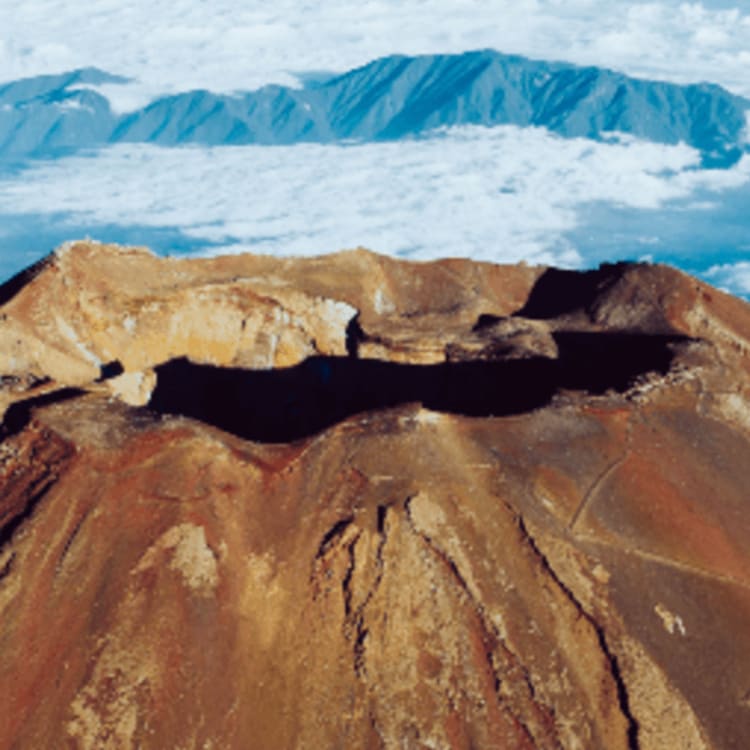
Guide Climbing Mt. Fuji: The top recommended itinerary
We sent Aussie adventurers, Hayley and Kyle , to climb Mt Fuji for the first time! Taking two days in total, including a night spent up on the mountain, the fun-loving duo returned with a wealth of experiences and recommendations they want to share with you!
This recommended itinerary takes place over 2 days. On the first day, the hike begins from the Fujinomiya 5th station (2,400m) and goes up to Akaiwa Hachigo mountain hut (3,300m) located at the 8th station where you rest for the night. This first climb is around 4km and will take most of the day.
On the second day, the final ascent to the top of Mount Fuji starts early in the morning and finishes with the descent back down to the 5th station.
Note: The Fujinomiya trail begins at 2,400 meters and is the shortest in distance to reach the top, but is also steeper and rockier in comparison to other trails (Yoshida, Gotemba and Subashiri). The duration of the ascent depends on many variables including weather conditions, route conditions, temperature and fitness level.
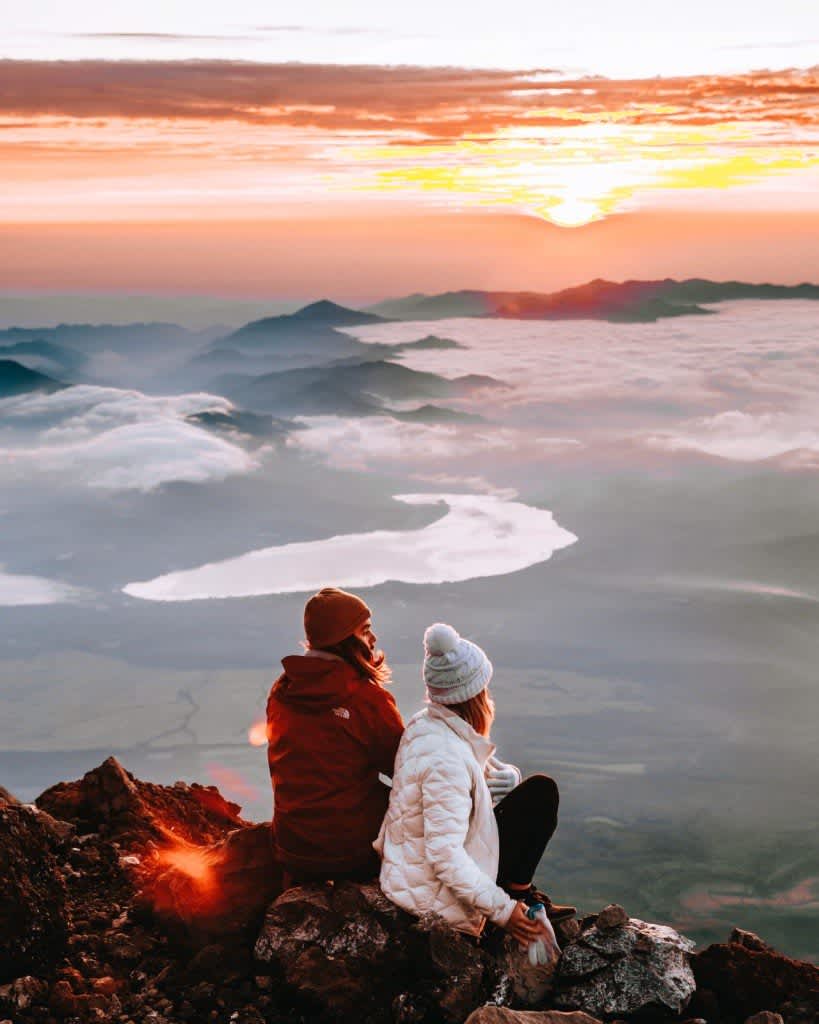
8:30–9:30am | Arrive at Mt. Fuji Fujinomiya 5th station 9:30–10:30am | Begin ascent on Fujinomiya route On a clear day you will be rewarded with views of the Pacific and surrounding mountains, including Hakone and Lake Ashi. Be sure to take as many rests as needed to give your body time to slowly adjust to the change in altitude. 3:00–5:30pm | Arrive at 8th station Akaiwa Hachigo mountain hut
Once you reach the 8th station, enjoy a hot meal and get ready for bed. The hut is quiet compared to huts on other trails, however it is far from the Hilton. You’ll be sleeping on Japanese futons in a bunk (mixed gender) that can get quite crowded—all part of the experience!
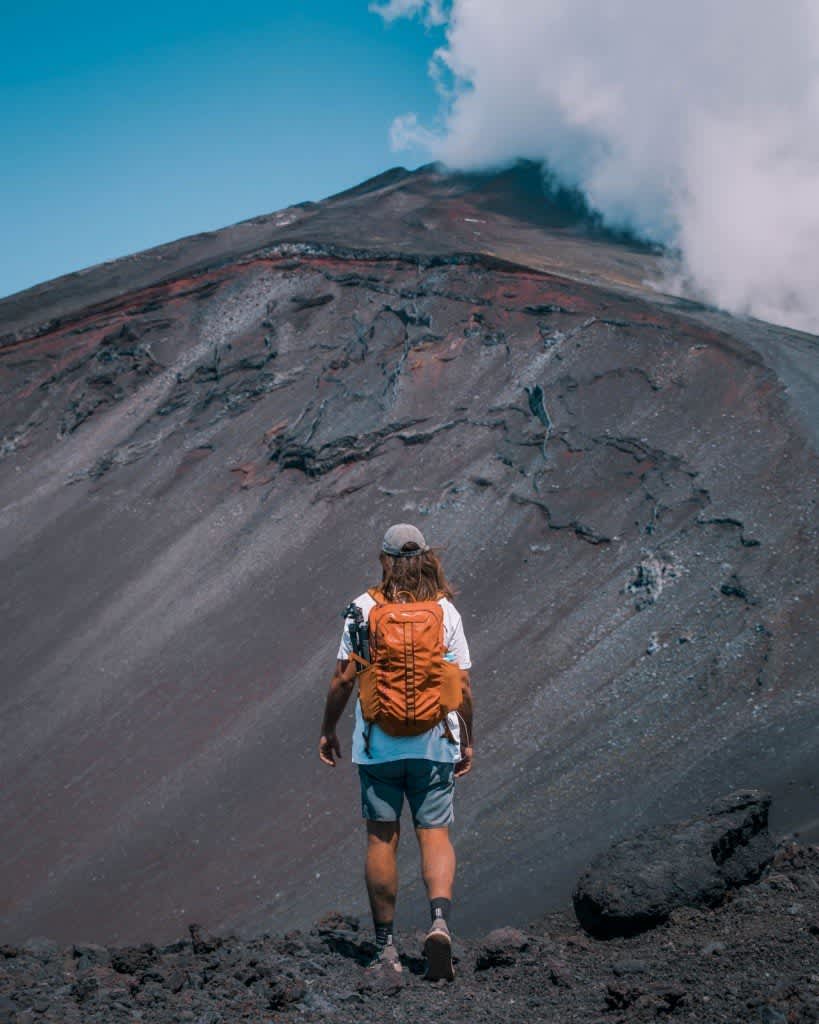
1:00–3:00 am | Rise and shine 1:30–3:30 am | Depart hut for Mt. Fuji peak This final twilight climb offers a secluded, spiritual experience, offering you a stunning sunrise over the clouds. The summit of Mt. Fuji is approximately a 2 hour climb from Akaiwa Hachigo at a relaxed, steady pace.
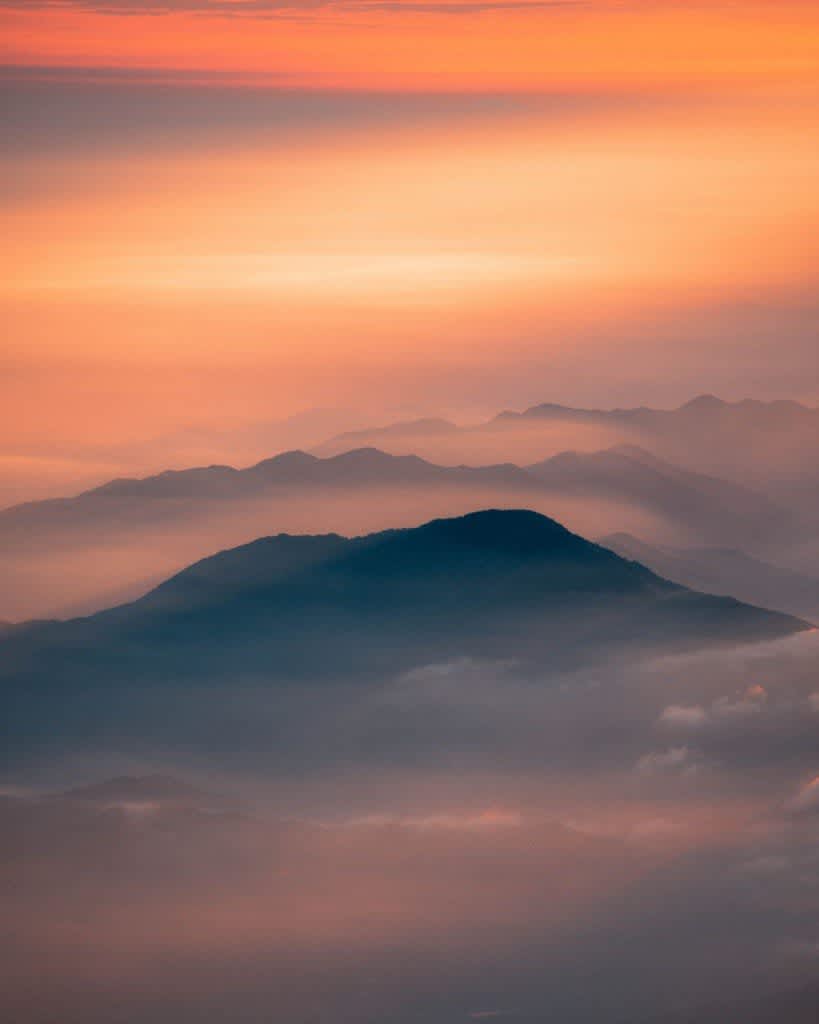
3:30-5:30 am | Arrive on Mt. Fuji peak The sunrise atop Mt. Fuji is known as goraiko or "Buddha's Halo". The sun gradually appears in dazzling shades of purple, pink, and orange over the sea of clouds that Japanese call "the ocean of cotton". Various temples, shrines, and torii gates scatter the large dominating crater on the summit. After you’ve admired the sunrise, spend an hour following the circuit of the mountain’s 8 peaks, including the 3,776m above sea level peak, Kengamine, the highest point in Japan.

5:30-7:00 am | Descent to Fujinomiya 5th station The descent takes about half the time but still requires significant effort due to the steepness. We recommend stopping by Akaiwa Hachigo for breakfast or to pick up any excess luggage you might’ve left. 10:00-1:00 pm | Arrive at Fujinomiya 5th station You did it! Now onto your next destination!
Hayley and Kyle answered some questions that should help you out if you decide to do the climb yourself. View the excerpt below, or check out Hayley and Kyle’s blog for the full Q&A here !
Do I need a guide?
Now, it’s not compulsory to have a guide, but it’s highly recommend having one. The trails can be confusing and easily mistaken if you’re on your own. Guides will also help with communicating between the locals at each station, as a lot of the Japanese don’t speak English.
We had a guide the entire time and felt he was extremely helpful with adjusting to the altitude, guiding us along the best trails and of course making sure of our safety. We booked our guide here .
How do I book a mountain hut?
Firstly you want to find the hut you would like to stay in. Preferably the highest hut along the trail you wish to follow. Here is a list and information of all the mountain huts.
Note: most mountain huts are only open during the official climbing season.
Secondly, you will need someone to book the hut who speaks Japanese, as majority of the staff at mountain huts don’t speak English. This could be a hotel receptionist, or your guide if you decide to take a guided tour.
Thirdly, you want to try book in advance if you are climbing over a weekend. The price is approx. 9000 yen including dinner and breakfast.
What is it like sleeping in a mountain hut?
Some of the huts can sleep up to 100+ people, leaving you only a tight sleeping space of only 1m. If you’re a light sleeper, make sure to pack an eye mask and ear plugs to help you sleep as it is loud throughout the night. You are provided dinner and breakfast which is usually a serving of curry and rice. If you are vegetarian, you will have to bring your own options.
There is no tap water on site, so washing your hands or face, or refilling your water bottle isn’t possible. If you need more water you will need to purchase bottled water at the hut.
What’s the best time to climb?
Mt Fuji is only open to hikers between early July to early September, and peak time being on weekends. These dates are due to the weather conditions being safe for travellers.
How much does it cost to do the climb?
While it doesn’t officially cost to climb the mountain, a donation towards the conservation of the mountain will be requested if you go beyond the 5th or 6th stations. 1,000 yen is usually the amount that is donated but you can donate more if you wish. It is also advisable to bring a handful of 100 yen coins as the toilets are not free to use.
What should I pack?
- Weatherproof pants, jacket and shoes
- Thick breathable socks, beanie and gloves
- Sun protection (sunscreen, glasses and hat)
- Lip balm, ear plugs, eye mask, face wipes
- Panadol and basic first aid
- Small garbage bags for rubbish
- 100 yen coins for bathroom
- Snacks (food for dinner if vegetarian)
- Spare clothes
Thinking of climbing Mt Fuji? Plan your trip today !
Please Choose Your Language
Browse the JNTO site in one of multiple languages

Planning a Tokyo to Mount Fuji day trip: All you need to know
By: Author Sylvia
Posted on Last updated: March 13, 2024
Wonder how to plan your Tokyo to Mount Fuji Day Trip? We got you covered.
The region around Mount Fujisan is located less than 2 hours away from Tokyo. You will find many beautiful places that will appeal to both culture and nature lovers.
A trip to this region is also a good way to split your stay in Tokyo and escape the hustle and bustle of the capital for a day or two.
In this post, we describe the best things to do around Mount Fuji.
We will share all the things you need to know to choose the best Tokyo to Mount Fuji day trip or day tour based on your personal interests.
And lastly, once you have seen the many things that you can see and do in this region you may want to go for 2 days instead of 1. Therefore we also share some excellent hotels to spend the night.
There is a really good chance that this post contains affiliate links. If you click one of them, we may receive a small commission (for which we are deeply grateful) at no extra cost to you.
Table of Contents
Tip: Join our Facebook group about Japan to hear the latest tips and get help with your travel plans from us and fellow travelers!
Where is Mount Fuji
Mount Fuji is part of the Fuji-Hakone-Izu National Park.
It’s located less than 100 kilometers away from Tokyo. It is a UNESCO World Heritage site since 2013 and has always been a popular destination for day trips from Tokyo.
Most day trips from Tokyo to Mount Fuji will head to either Lake Kawaguchiko or Hakone. These are the two most popular regions as they are both easily accessible from Tokyo.
Are you planning your Japan trip? Have a look at our Japan travel guide with lots of articles about all must-visit places in Japan.
Both places offer a different experience. That’s why we’ll go into more detail about the differences between Hakone and Lake Kawaguchiko below.
But first, let us see what’s the best time to visit Mount Fuji.
What is the best time to visit Mount Fuji?
Despite the many other sights, most people only want one thing when they come to this region, and that is, of course, to see the beautiful mountain. The many postcard-like pictures may give the impression that it is easy to take stunning pictures of the mountain but unfortunately, Mount Fuji isn’t always visible.
The mountain is best seen on clear and sunny days with mild temperatures. That makes November to February the best period to see Fujisan.
But a trip to this national park is not completely worthless if you aren’t lucky with the weather, and the mountain is hiding behind the clouds.
It will still be time well spent because there are so many other things to see and do in both Hakone as well as Lake Kawaguchiko.
Still, we recommend those that absolutely want to see the mountain, check the weather forecast when they’re planning their visit.
Useful tips for traveling to Japan for the first time.
If the clouds are forecast to be more than 30% the chances of seeing Mt Fuji are less likely. But even on a cloudy day, you can be lucky since there are sometimes breaks in the clouds.

How to see Mount Fuji?
There are plenty of ways to discover this beautiful area.
You could go independently or join a Mount Fuji Day Tour.
Going independently to Mount Fuji
Pros and cons of going independently .
- You can start and return when you please.
- You can choose what you want to see and how much time you spend at each attraction.
- It’s less expensive than a guided day tour.
- It’s less hassle-free and comfortable than joining a day tour.
- You will get less information about the Mount Fuji area.
Joining an Mt. Fuji Day Tour
Another option is joining a day tour to Mount Fuji.
Pros and cons of joining a day tour
- More comfortable since you don’t have to make an itinerary yourself, check the transport, etc.
- The tour is accompanied by a guide who will give you information about the region and its highlights.
- You can see more in a day since you don’t lose time waiting for public transport.
- More expensive than going on your own.
- You are less free because you will have to follow the group and you will have to go by a strict schedule.
If you prefer to join a day tour from Tokyo to Mt. Fuji we have both good and bad news.
The good news is that the list of day tours from Tokyo to Mt. Fuji is incredibly long. Everyone will be able to find something to his liking.
The bad news is that the sheer variety on offer makes it that much harder to pick a tour.
It took us several days to compare the different tours.
That’s why we decided to write a separate post just about these tours. We describe the various tours in detail and added a comparison table so you can quickly see the similarities and differences. Many tours are very much alike but still, they all have some small aspects in which they differ.
This overview will make it easier for you to choose the best tour based on your interests and budget.
Here you can find our full guide about the best Mt. Fuji Day Tours. If you prefer a private Mt fuji tour, check out this post.
How long do you need to explore the Mount Fuji area?
Mount Fuji i s less than 2 hours away from Tokyo so it’s perfectly possible to get a good first impression of it in a single day.
If you want to go hiking, spend the day in an onsen, or simply want to increase your chances of splendid views of Mount Fuji it’s recommended to stay 2 or 3 days.
We share some good hotels for your Mount Fuji trip further down in this post.
Knowing that not everybody has the luxury to reserve 2 or 3 days just for Mount Fuji, a Mt. Fuji day trip from Tokyo is great to get a first impression of this beautiful area.
Don’t want to go independent? These one-day tours are perfect for those who don’t want to travel independently.

Choosing between Hakone or Lake Kawaguchiko
Hakone is a small town nestled in the mountains near Gotemba. It is situated in a green environment and offers dramatic views of Mt. Fuji.
It is also a hot spring destination thanks to the volcanic activities in the area.
There are a lot of activities to enjoy around Hakone. A day trip from Tokyo is great to see Mount Fuji but wouldn’t leave much time to explore the wider region. If you have 2 or 3 days you are able to enjoy some of the other activities that can be done near Hakone.
If you’re into hiking, kayaking, fishing, or just love being outdoors, then this is the place for you.
Here is our guide about making a day trip to Hakone.
If you prefer staying the night, check out the following posts:
- Best Airbnb in Hakone
- Ryokan in Hakone with private onsen
Lake Kawaguchiko
Lake Kawaguchiko is the largest and easiest accessible of the five lakes of the Fuji Five Lakes resort area.
Besides splendid views of Mount Fuji, it offers plenty of other great activities such as onsen, museums, cable cars, hiking trails, an amusement park, and much more.
We have a separate post about Hakone , so in this post, we will focus on the main attractions in Lake Kawaguchiko.
Combine Hakone and Lake Kawaguchiko
Can’t choose between the two areas? Don’t worry, Hakone and Lake Kawaguchiko are not that far apart and can easily be combined.
Fujikyu runs several buses a day between Hakone and Lake Kawaguchiko. Buses leave from the JR Gotemba station or the Gotemba Outlets and take you to the train station in Kawaguchiko.
You can use the Hakone Tozan Bus to travel between Gotemba and Hakone. The bus is covered by the Hakone Freepass .
Things to do in Kawaguchiko
Lake kawaguchiko money-saving tips.
If you decide to travel independently by public transport you will probably save with the Mount Fuji pass .
This pass gives you unlimited rides on buses and trains around Mount Fuji, and free access to a number of attractions such as the Fuji-Q highland rollercoaster, museums, cable cars, and more.
You also enjoy an extra discount at 12 locations including restaurants, onsen, and museums.
You can choose between 1-day, 2-day, and a 3-day pass.
Read reviews and buy your pass here: Mt. Fuji Pass
Getting to Lake Kawaguchiko
Taking the bus to lake kawaguchiko.
You could take a direct bus that goes from Tokyo to Fuji Q-Highland and Lake Kawaguchiko. Buses leave from various locations in Tokyo. Pick-up locations in Tokyo are Yaesu Station, Tokyo Station, the Tokyo Dome Hotel, Shibuya Mark City, JR Ikebukuro Station, and Sunshine City Prince Hotel
At Lake Kawaguchiko the bust stops at Fuji-Q Highland, Mt. Fuji Station, and Kawaguchiko Station.
When buying tickets you will need to select a route first. You can then select your preferred pick-up and drop-off locations in the second step of the booking process.
Check prices and availability: Intercity bus to Lake Kawaguchiko
Taking the train to Lake Kawaguchiko
If you want to go by train you can use the Ltd. Express Fuji Excursion. This train leaves Shinjuku daily at 7:30 am, 8:30 am, and 9:30 am. Just under 2 hours later you are in Kawaguchiko.
If these hours don’t suit you you need to take the JR Chuo line to Otsuki first where you need to change to the Fujikyu Line to Kawaguchiko. This train journey will take approximately 2,5 hours.
Both trains follow the same route, the only difference is that you have to change trains for the second option.
Holders of a JR Tokyo Wide Pass can use this pass for the entire journey but, regardless of which train you take, the segment from Otsuki to Kawaguchiko is NOT covered by the Japan Rail Pass.
Where to stay in Tokyo for the first time.
How to get around Lake Kawaguchiko
The easiest way to independently explore the region is by using a sightseeing bus. There are several lines.
Each line covers a different area.
They all leave from Kawaguchiko Station.
The Red Line brings you along the eastern and northern coastline and to the main resort amenities.
The Green Line takes you to the southern shores of Lake Kawaguchiko. The bus follows a scenic route and offers many splendid views of the wooded Fuji 5 lakes region.
The Blue Line travels along Road 139 and through the Aokigahara Forest over to the Lake Motosuko Tourist Information Centre.
The Fujikko-go (F-line) bus line leaves from Kawaguchiko Station for Fujiyoshida, Oshino Hakkai, and Lake Yamanakako. You can take this bus to visit Lake Yamanaka, including the Sengen Shrine, Mt. Fuji Radar Dome, Benifuji Spring, Oshino Hakkai, and Hananomiyako Park.
The Mount Fuji World Heritage Loop Bus takes you to lots of interesting places such as the Chureito Pagoda, Oshino Hakkai Village, Oshino Ninja Village, etc.
If you have a Mount Fuji Pass you can ride all these buses for free.
JR offers an alternative pass for this region. The JR Mt. Fuji-Shizuoka area mini pass covers the same bus lines and, in addition, you can ride the local Tokaido, Gotemba, and Minobu JR lines. The private Izuhakone railway is also covered. Thanks to the addition of the JR lines a much larger region can be traveled, however, entrance fees to attractions are not included with this pass.
Where to stay in Lake Kawaguchiko
With all the great things to do in the Fuji 5 Lakes region, you might want to stay longer than 1 day. Here are some of the best places to stay around Lake Kawaguchiko.
Mizno hotel

This newly renovated hotel offers excellent service, an amazing view of Mt Fuji, and a wonderful traditional Kaiseki dinner.
The hotel also has a private onsen on the rooftop overlooking Mt Fuji. English is widely spoken by the staff. The hotel also has complimentary bicycles that you can use to explore the region.
Be aware that the hotel is on top of a steep hill. But they offer pickup and dropoff at Kawaguchiko Station.
Lovely hotel with astonishing views of the lake and Mount Fuji.
More information and booking:
Booking.com
Fujikawaguchiko Onsen Konanso

FujiKawaguchiko Onsen Konanso offers a free shuttle bus to and from the station. You will stay in a comfortable traditional Japanese room. The breakfast offers a good selection of both Japanese and Western food.
From the rooftop, you can get amazing views of Mount Fuji while bathing your feet in the foot onsen.
Here you can enjoy true Japanese hospitality.
Didn’t find what you were looking for? Check out this list of Ryokans in Mount Fuji. If you are looking for a Mount Fuji hotel with a private onsen, click here.

What to do in Lake Kawaguchiko
Now that we have taken care of the discount passes and hotel options, let’s have a look at all the marvelous things to see and do in and around Lake Kawaguchiko.
For each of these attractions we also state whether they are covered by a tour, and if so, which one. So if you’re still in doubt about joining a tour, you can get a better idea about what they include.
Enjoy the magnificent views of Mount Fuji
One of the reasons, or should we say the major reason, most visitors come to Lake Kawaguchiko is to see Mount Fuji.
That’s why we start with the list of places that offer the most beautiful views of Mount Fuji.
The good news is that the Fuji Five Lakes region one of the best places is to see the mountain. It offers visitors one of the highest chances of an unobstructed view thanks to its proximity.
Be aware that your chance to see Fujisan will heavily depend on the weather. Visibility tends to be best in the early mornings (usually before 9 am) and in the late afternoons. During day time, clouds often obstruct the view, especially during the summer months.
These are the places with the most beautiful views of Mt. Fuji.
The northern shore of Lake Kawaguchiko
A hike along the Northern shore of the lake will grant you several splendid views of the lake with the volcano in the background.
The boardwalk is especially photogenic during the cherry blossom season in April and during the first half of November when the fall colors kick in.

Chureito Pagoda
The Chureito Pagoda offers magnificent views of Mount Fuji and is an iconic Mount Fuji viewing spot.
The Chureito Pagoda is included in tour 3.
Oshino Hakkai
This touristy village offers excellent picture opportunities with Mount Fuji in the background.
Oshino Hakkai village is included in tour 3 , tour 4 , and tour 5
Kachi Kachi ropeway
This ropeway offers 360-degree views of Mount Fuji and the five lake area.
This small park offers great views of the lake and Mount Fuji.

Mt Fuji 5th Station
Mt. Fuji 5th stations are intermediary stations for people that climb Mt. Fuji. As their name suggests they’re already a good part up the mountain. Because these stations can be reached by car most people will start their climb here, it may be cheating a little but it still takes about 6 hours to get to the top.
There’re 4 5th stations, roughly one in each wind direction. The stations are the closest you can get to the top of Mount Fuji without making the climb.
Each station is located at around 2000 meters above sea level and therefore when weather permitting, they offer breathtaking views of the mountain and its surroundings.
These stations are excellent places for beautiful views of Mount Fuji, the Japanese Alps, and the greater fifth lake area.
A stop at one of the Mt. Fuji 5th Stations is included in tour 1 , tour 2 , tour 4 , tour 5 , tour 6 , tour 7 , and tour 8
Stroll around Arakurayama Sengen Park and climb up the Chureito Pagoda
The Chureito Pagoda is part of the Arakura Fuji Sengen Jinja Shrine. It offers magnificent views of Mount Fuji and is an iconic Mount Fuji viewing spot.
The image of the pagoda with Mt. Fuji in the back is one of the most famous pictures of Fujisan.
If you go to the Cureito Pagoda you can create your own version of this iconic shot.
Just be aware that you will first have to climb around 400 steps to reach the spot where you can take this picture.
If possible, arrive early to beat the crowds and try to avoid the weekend when the site is usually very busy.
A visit to the park is especially recommended during the cherry blossom season and during the colorful fall season.
This attraction is included in tour 3.
How to get here
Coming from Kawaguchiko: You can ride all the way to Shimo-Yoshida Station on the Fujikyu Railway Line (14 minutes, 310 yen from Kawaguchiko). From the station, it’s a short 10-minute walk to the park.
Coming from Tokyo: If you hold a JR pass you take the Chuo line express from Shinjuku to Otsuki station (1h). This part is covered by the JR Pass. At Otsuki station change for the Fujikyuko line. The ride from Otsuki to Shimo-Yoshida Station takes another 40 minutes and costs 960¥.
Instead of the train, you can also use the Mount Fuji World Heritage Loop bus .
Try Hoto Noodles
Hōtō is a local Mount Fuji dish made of thick flat udon noodles and vegetables in miso soup.
It’s a dish that can be ordered in many restaurants all around the Mount Fuji area and something you should definitely give a try if you want to experience the local cuisine. must absolutely try.

Visit the Kitaguchi Hongu Fuji Sengen Jinja Shrine
This is the main Sengen Shrine on the Northside of the mountain and this used to be the place where hikers from Tokyo started their climb to the top of Mt. Fuji.
The Shrine is dedicated to Princess Konohanasakuya, the deity of Mt. Fuji, and is built for protection from volcanic eruptions.
The colorful red buildings of the Shrine are well hidden in a dense forest. The forest and beautiful buildings make it a great place to relax, walk around, and appreciate nature.
The Shrine is also known as Fujiyoshida Sengen Shrine and shouldn’t be confused with the Fujisan Sengen Shrine.
The latter is located at the Southern side of the mountain and is the most important Shrine dedicated to Mount Fuji.
Back in the days, when Kyoto was still the capital of the country, the Fujiyoshida Sengen Shrine was the starting point for those who wanted to climb Mount Fuji.
Nowadays most climbers start from one of the much higher-located 5th stations.
You can read reviews here.
How to get there
By Mount Fuji World Heritage Loop bus .
The Kitaguchi Hongu Fuji Sengen Jinja Shrine is normally not included in any of the tours. If the road to the Mt. Fuji 5th station is closed, however, tour 4 will go there. (road closures can occur during the winter)
Visit one of the Mt. Fuji 5th Stations
These days the Mt. Fuji 5th stations are the starting points for climbing Fujisan. They’re located at the Northern, Eastern, and Southern slopes of the mountain and are the highest points accessible by car.
As already said, on a clear day, you can enjoy beautiful views of Mount Fuji, the Japanese Alps, and the fifth lake area.
Note that these stations are located at altitudes ranging from 1900 meters (6233 ft) to 2400m (7874 ft), so ensure to take warmer clothes with you.
By bus from the Kawaguchiko train station. The bus operates daily except when the road is closed due to snow during the winter months.
A visit to one of the Mt. Fuji 5th Stations is included in tour 1 , tour 2 , tour 4 , tour 5 , tour 6 , tour 7 , and tour 8

Enjoy an onsen
Soaking in an onsen, a Japanese hot bath, is something you should absolutely experience while in Japan.
Onsen are an integral part of the Japanese traditional culture and the Japanese have been using the onsen for ages to unwind and to take good care of both body and soul.
Many of the outdoor onsen that are located around Lake Kawaguchiko offer stunning views of Mount Fuji. It’s a unique experience to sit in an onsen with such a breathtaking view of Mount Fuji.
Several hotels and ryokans have their own onsen facilities.
If you’re staying overnight you can book a hotel with a scenic onsen like the Mizno hotel .
If you’re on a day trip your possibilities are slightly more limited. You can either use one of the public onsen facilities or one of the hotel or ryokan onsens that are open to day visitors.
These are 2 onsen facilities with Mt. Fuji views that can be used by day visitors:
Hotel Mifujien has older gender-separated bathing facilities with nice views of Mount Fuji.
Yurari is a public onsen complex that has over 10 different hot spring baths. From one of them, you have a view of Mt. Fuji.
Prepare yourself for your onsen visit by reading about the proper onsen etiquette first.

Wander around Oshino Hakkai Village
This village lies between Lake Kawaguchiko and Lake Yamanakako. It’s a world cultural heritage site famous for its eight crystal-clear sacred ponds.
It’s a touristy village and several of the rustic houses contain restaurants and shops.
Next to the largest pond is Hannoki Bayashi Shiryokan, an open-air museum that showcases old traditional farmhouses along with traditional farming tools, samurai armors, and various weapons from that time.
The houses, with the perfectly shaped volcano in the background, make for a perfect picture that could have been made in the old days of Japan.
Hours and Fees
There is no fee to view the ponds but there is an admission fee of ¥300 for the open air museum, Hannoki Bayashi Shiryokan, which is situated at the largest pond.
The museum is open every day from 9:00 am- 5:00 pm.
How to get here:
By taking the red line of the Kawaguchiko sightseeing bus.
A visit to the Oshino Hakkai village is included in the following guided tours: tour 3 , tour 4 , and tour 5 .
Learn everything about Ninjas in the Oshino Ninja Village
Oshino Shinobi no Sato also called the Ninja Village, is a place where you can rent Ninja costumes, watch a Ninja show and solve the mystery of the Karakuri house which is full of traps and secret doors.
From the garden, you can enjoy great views of Mt. Fuji.
You can find more info about the Ninja Village here and read reviews here.
How to get here:

Ride the Tenjoyama Park Kachi Kachi Ropeway
This ropeway is known for its scenic view of Mt. Fuji. He is therefor more often referred to as the Mount Fuji Panoramic Ropeway rather than its official name.
The Kachi Kachi cable car starts at the eastern shore of Lake Kawaguchiko and ascends 400 meters to an observation point near the summit of Mount Tenjo.
From here you can enjoy amazing views of Mt. Fuji and Lake Kawaguchiko.
It’s possible to hike an additional 300 meters uphill from the top station to the actual summit of Mount Tenjo where you can see a small Shrine.
Opening hours: 9 am- 5 pm
Winter: 9.30 am-4.30 pm ( December first until 28th February)
900 yen for a round trip with the cable car. If you want you can also hike to the top and back or you can buy a one-way ticket for 500 yen and walk back down along the trail.
Allow about 40 minutes to one hour for the one-way hike up.
How to get there :

Fuji Q Highland Amusement Park
Fuji Q Highland Amusement Park is the place to be for those who want to add a bit of adrenaline and thrills to their day trip from Tokyo to Mount Fuji.
This is one of Japan’s most popular amusement parks. It has 4 spectacular roller coasters, all of them held a record when they opened and Do-Dodonpa still holds the record for being the rollercoaster with the fastest acceleration. It reaches its top speed of 180 km/h in just 1.6 seconds.
Despite the fact that the other coasters have lost 1 or 2 places in the rankings since their opening, they are still regarded as some of the best roller coasters in the world.
Besides roller coasters, you can also find a lot of other thrill attractions such as a scary labyrinth, a haunted hotel, water coasters, virtual reality attractions, and more.
There is a 4D Fuji Airways Flight Simulator that provides a 4D aerial tour of Mt Fuji.
But also the families and the less brave aren’t forgotten, here’s an overview of the attractions.
More information and tickets: Fuji-Q Highland Tickets
From Tokyo: Most busses coming from Shinjuku to Kawaguchiko make a stop at the Fuji Q Highland Amusement Park.
From Kawaguchi station: 1 stop on the Fuji Kyūkō Line..
Guided tour number 8 includes a visit to La Ville de Gaspard et Lisa, a theme-park modeled in French style after the popular comic book characters. It’s part of Fuji-Q Highland but doesn’t have any of the attractions like those you find in the main park. It’s however a nice place for pictures and they have done a good job of recreating the French atmosphere.
Visit one of the many museums
Museum fans will love the red line of the Fujikyuko sightseeing bus. This bus has several stops at museums.
Below are some of the most popular museums along the route.
Kawaguchiko Music Forest Museum
The Kawaguchiko Music Forest museum shows a world-class collection of different types of music boxes.
Various musical performances go on throughout the day; be sure to catch the water fountain show. Every hour, on the hour, the fountains just outside the museum, will ‘dance’ to music.
The beautiful gardens around the museum are also very festively lit up during the winter months.
Read reviews on TripAdvisor.
Using the Hop on hop off bus: Take the Red Retro bus to stop 15.
The Kawaguchiko Museum of Art
This museum houses a collection of Mount Fuji-inspired art pieces. Visitors can see a variety of pictures and paintings showing the volcano.
Read reviews on TripAdvisor.
Using the Hop on hop off bus: Take the Red Retro bus to stop 16.
Itchiku Kubota Art Museum
This museum displays incredibly beautiful kimonos created by Itchiku Kubota. The museum is surrounded by a beautiful Japanese garden.
Using the Hop on hop off bus: Take the Red Retro bus to stop 19.
Yamanashi Gem Museum
The museum has a collection of over 3000 valuable gems from all over the world. The exhibits cover a wide variety of gems ranging from rough gemstones created by nature to beautiful jewelry pieces created by true artists.
Using the Hop on hop off bus: Take the Red Retro bus to stop 8.

Take wonderful pictures from Oishi park
This small park situated at the northern shore of Lake Kawaguchiki offers great views and plenty of photo opportunities of Mount Fuji.
Thanks to the various flower beds spread throughout the park, a visit is always a colorful experience.
The end of the 350-meter-long “Flowers road” is a popular Mt. Fuji picture spot.
The park is also a nice place to relax and enjoy a picnic.
No entrance fee.
Read reviews on Tripadvisor.
Using the Hop on hop off bus: Take the Red Retro bus to the terminus ( stop 22).

Stroll Around Saiko Iyashi no Sato Nemba
This open-air museum is situated on the site of the former farming village of Nemba. The village was destroyed by a typhoon in 1966 and about 20 of the original houses were later restored.
Visitors can see the quaint thatched roofed houses, some of which contain small museums. You can also participate in craft workshops to test your skills in traditional handicrafts.
It’s rather commercial so many of the houses contain restaurants and gift shops. You can also rent traditional Japanese costumes to take pictures.
Don’t forget to take the classic shot of Mt Fuji with the thatched houses in the foreground.
Entrance fee:
How to get there Using the Hop on hop off bus: Take the green line and exit stop 48.

Explore a cave
Past eruptions have created lots of caves in this region. Three of these caves are open to the public.
The floor in the caves is uneven and can be slippery so we recommend wearing good walking shoes.
The bat cave
With its length of 386 meters, the bat cave is the longest cave in the region. Although it’s called bat cave you will hardly see any bats during the day because they are sleeping.
As you walk around the cave, you can see various kinds of formations created by the lava.
The cave is a also good starting point for a hike through Aokigahara forest.
Read reviews on TripAdvisor
Opening Hours: 9:00 to 17:00
Closed: December 1 to March 19
Entrance fee
Take the green line from Kawaguchiko station to Saiko-Komriana.
The Fugaku wind cave
This cave was once used as a natural refrigerator to store ice and other perishables, as the temperature remains low through summer. The year-round average temperature in the cave is 3 degrees.
Hours: 9:00 to 17:00 (shorter hours in winter; longer hours in summer) Closed: No closing days
how to get there
Take the green line from Kawaguchiko station to Fugaku-Fuketsu.
The Ice Cave
The ice cave has since long been used to store ice. The temperature in the cave stays below freezing all year round. It’s the smallest of the three caves. During your visit, you can see some ice formations.
Take the blue line from Kawaguchiko to Narusawa Hyoketsu.

Go hiking in Aokigahara Forest
This forest grows on the bottom of hardened lava. The lava absorbs the sound and gives the forest a special quiet atmosphere.
It is believed that the ghost of the dead live in the forest and in recent years many suicides have taken place in this location. As a result, the park is now known as the Suicide forest.
Some urban legends arose as a result of these accidents.
Stories are circulating about compasses that go haywire, but those are false.
The magnetic rays of the lava may interfere with the compass when put on the ground but when the compass is held at a normal height it will function perfectly fine.
Despite its lurid nickname and the urban legends, the park is a perfectly safe place to hike.
It attracts two types of visitors these days, those who come here for vistas of Mount Fuji and disaster tourists who hope to spot some macabre activities.
Take the green line from Kawaguchiko station to the Wind cave.
Take the blue line from Kawaguchiko to the Ice cave
Lake Kawaguchiko and the surrounding national park is a nice region to spend a few days during your trip through Japan.
the best 3 week Japan itinerary.
You can admire Mount Fuji and enjoy a number of other activities, such as relaxing in the onsen or having a blast in the Fuji-Q Highland amusement park.
Lake Kawaguchiko is so diverse that young and old will never be bored.
The info in this post should help you to explore this region on your own but if you are short on time, or prefer the comfort of a guided tour, you should have a look at our top list of organized Mt. Fuji Day tours .
Either way, if you visit this region, we’re sure it will be one of the highlights of your Japan trip.
Did you already make a Mount Fuji day trip? How was your experience?
If you like this post, pin it.

- Destinations
- Travel Tips
- Travel With Us
- Paid Travel Internship
- TTIFridays (Community Events)
- SG Travel Insider (Telegram Grp)

3D2N Mt Fuji Itinerary Under S$570 — Road Trip From Tokyo
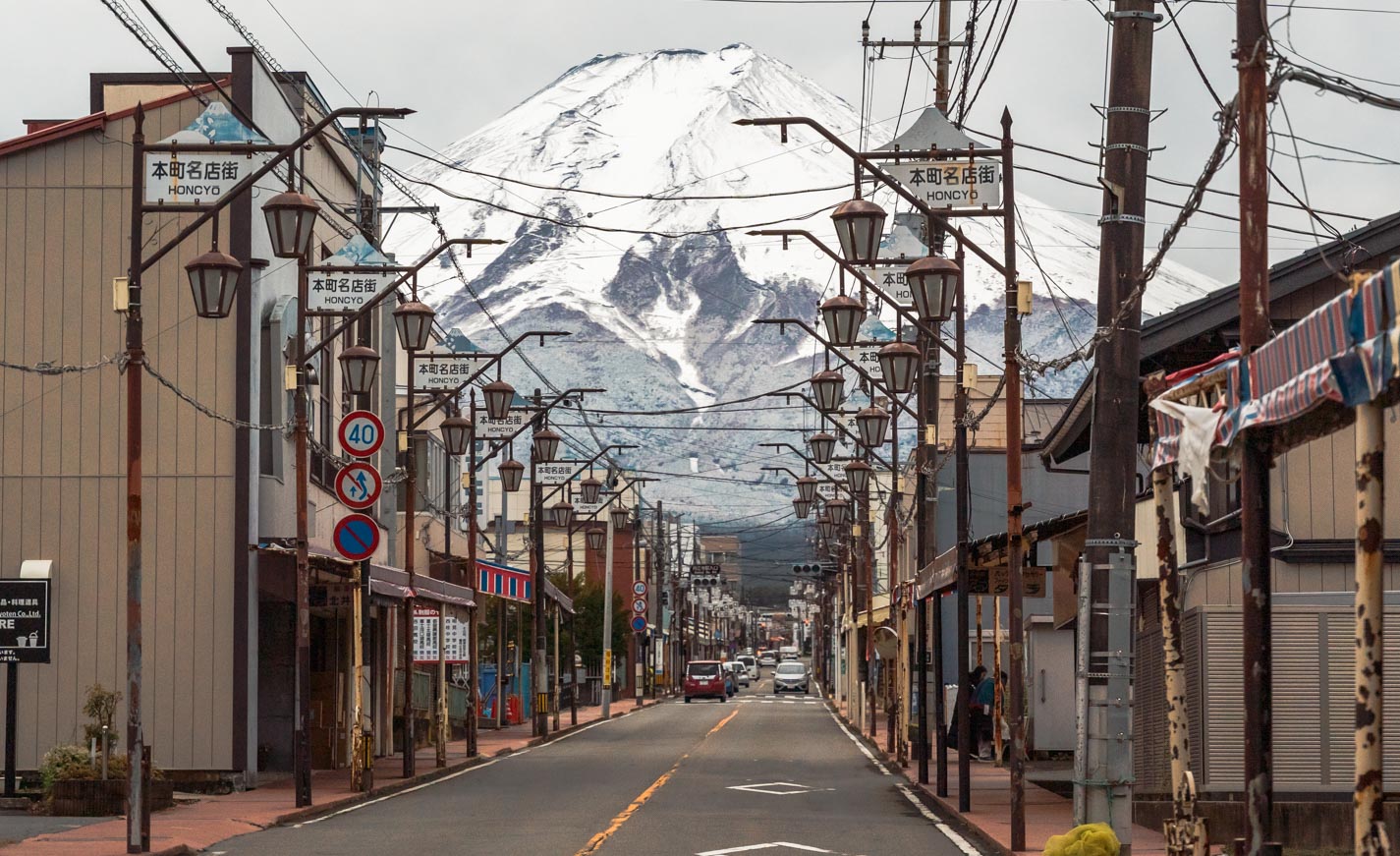
If Japan had a profile picture, it would definitely be Mt Fuji in its snow-covered glory. Here’s the guide to exploring the best of Japan’s most famous mountain.
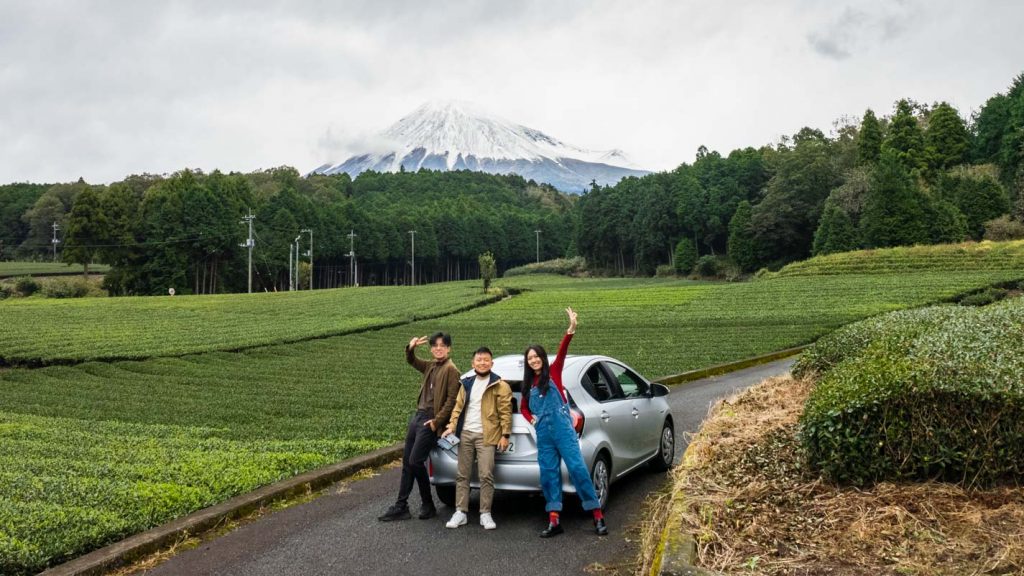
Mount Fuji needs no introduction. While hiking to the peak of Mt Fuji is a bucket list experience for many, our recent week-long Japan trip brought us through some of the hidden gems surrounding the Fuji area. Here’s the chill road trip guide to exploring the best of Fuji and its surrounds on a road trip from Tokyo.
Car rental: If you’re entering Japan from Tokyo, it’s best to rent a car and drive down as public transport to many of these places are either infrequent or non-existent. Don’t forget to collect your pre-booked 4G SIM card from the airport as you’ll be needing it for navigation!
Mt Fuji Road Trip Route and Budget Breakdown
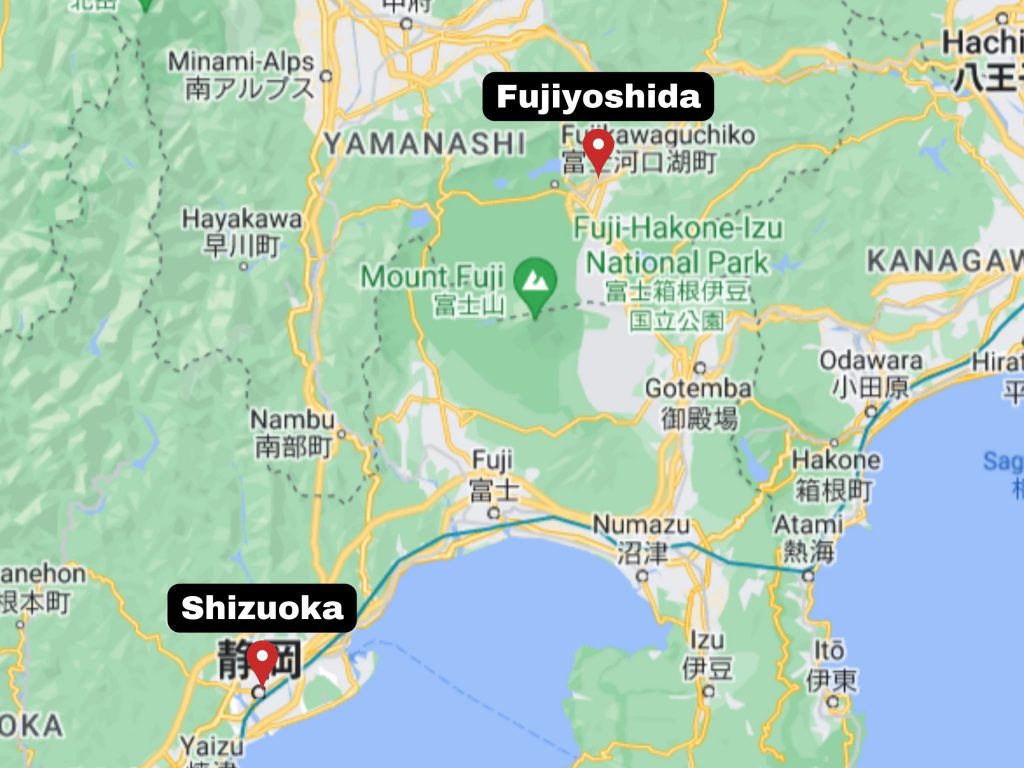
Transport: S$146.16 (excl. flight) Accommodation: S$181.40 Activities: S$74.85 Food: S$105 (~¥3,500/day) Misc: S$56.65 TOTAL: S$564.06 (1SGD = 100JPY)
(detailed breakdown for one pax here)
*Note: Flights were excluded from the budget as airfares fluctuate quite a bit across the year.
Day 1: Fuji-Q Highland
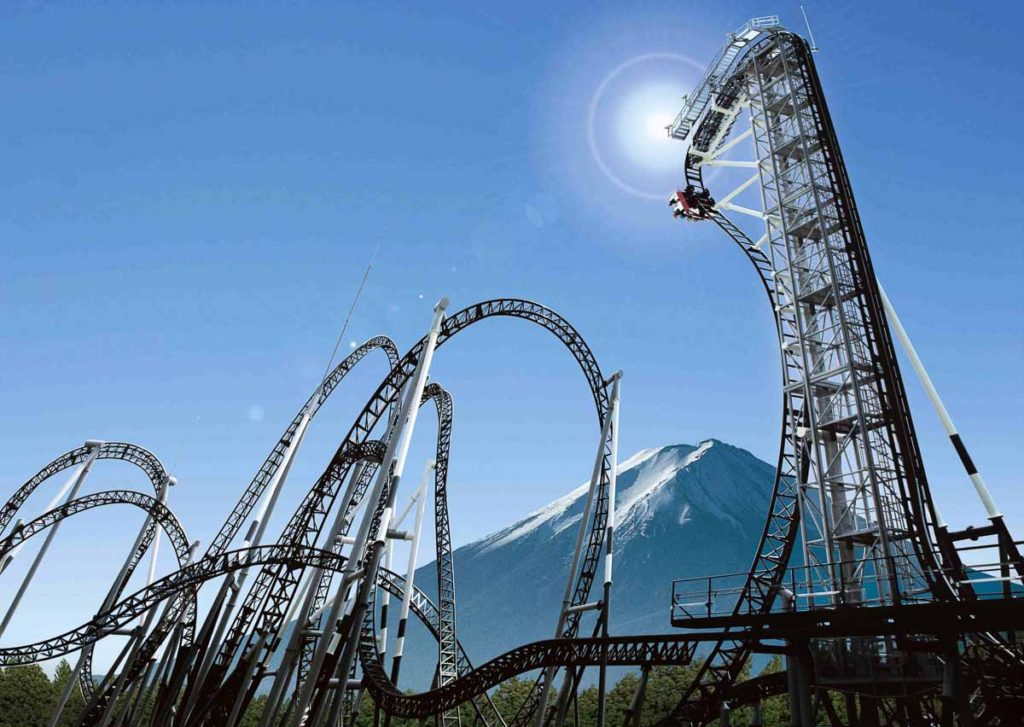
Photo credit: FujiQ
Fuji-Q Highland is, a rollercoaster lover’s haven. It has not just one but five Guinness World Record titles under its belt.
After a 2.5-hour drive from Tokyo, we were ready to take on Japan’s most thrilling amusement park.
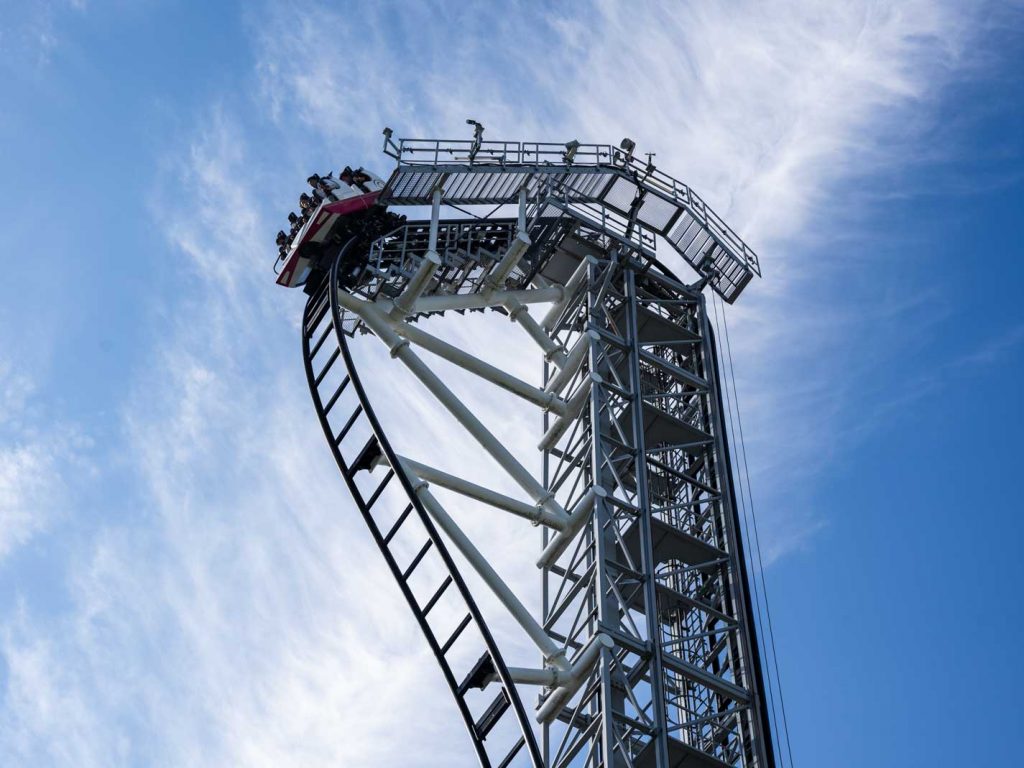
Admission to the park is free, and rides cost between ¥400–¥2000 per ride. If you’re planning to spend the day here, get the FujiQ One Day Pass for unlimited access to all the rides.
Here are the ones you shouldn’t miss:
Fujiyama — The King of Coasters with five Guinness World Records such as the tallest and fastest roller coaster Takabisha — World’s second steepest coaster with a 121° drop (0.5° difference from the first place Shellraiser in America) Eejanaika — Fastest 4D rollercoaster with 14 inversions, the most in the world!
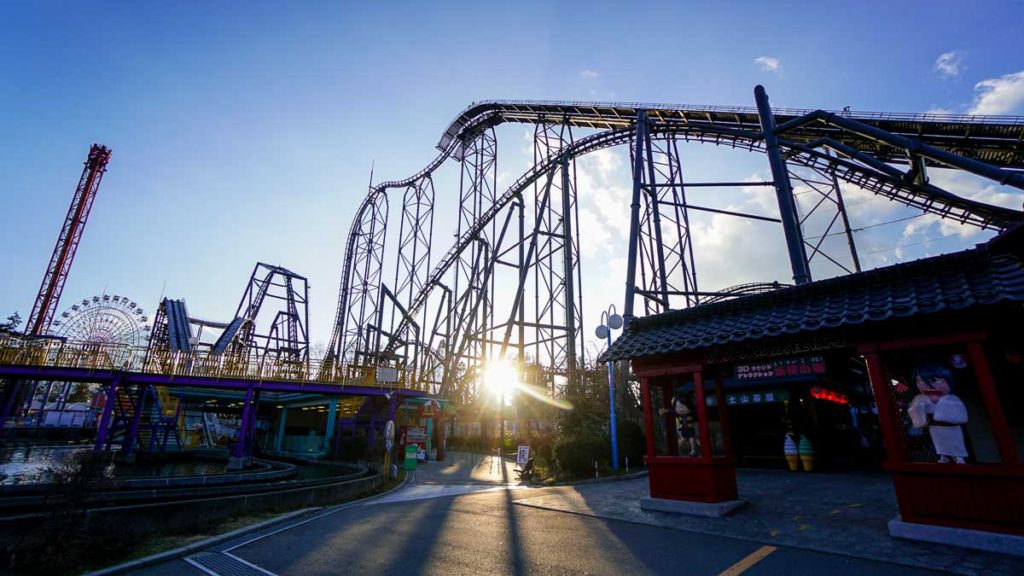
My personal favourite is Fujiyama because of its insane 70m drop, plus multiple twists and turns with Mt Fuji as a backdrop.
There are free lockers provided around the park so you’ll want to drop them off before the rides.
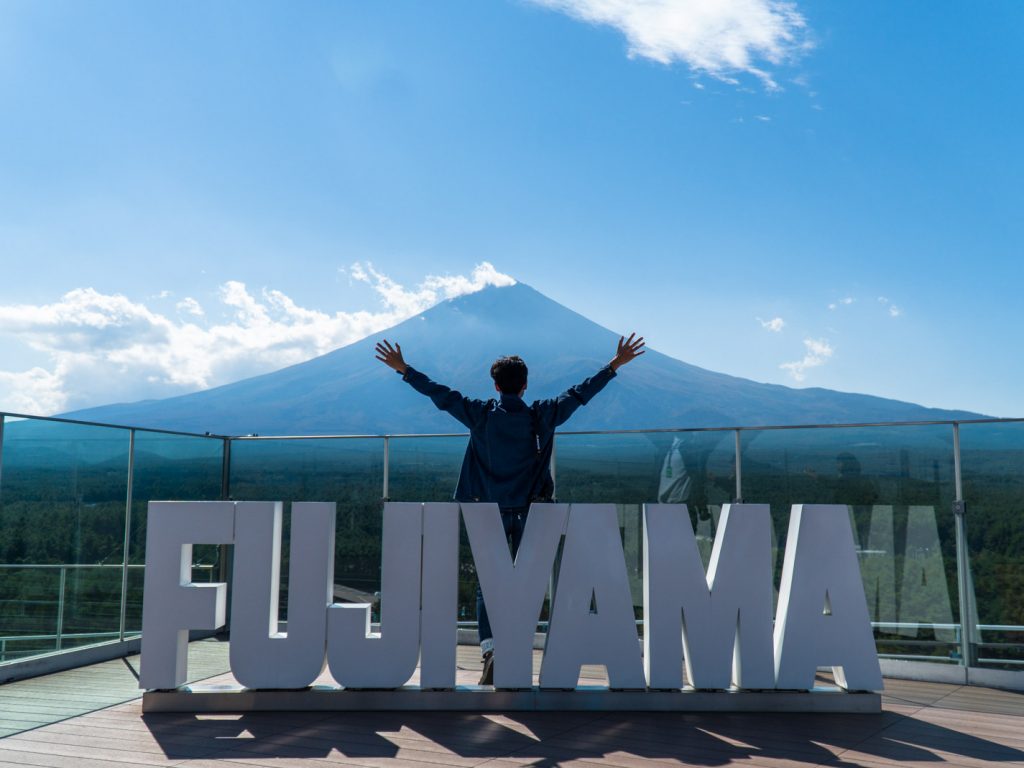
After an adrenaline-filled adventure, we headed to the newly opened 55m-tall Fujiyama Tower, which offers a bird’s eye view of Mt Fuji and the occasional Fujiyama coaster zooming past.
*Pro-tip: Pay an additional ¥1,000 to slide down the Fujiyama Slider for a fun way down to the ground floor.
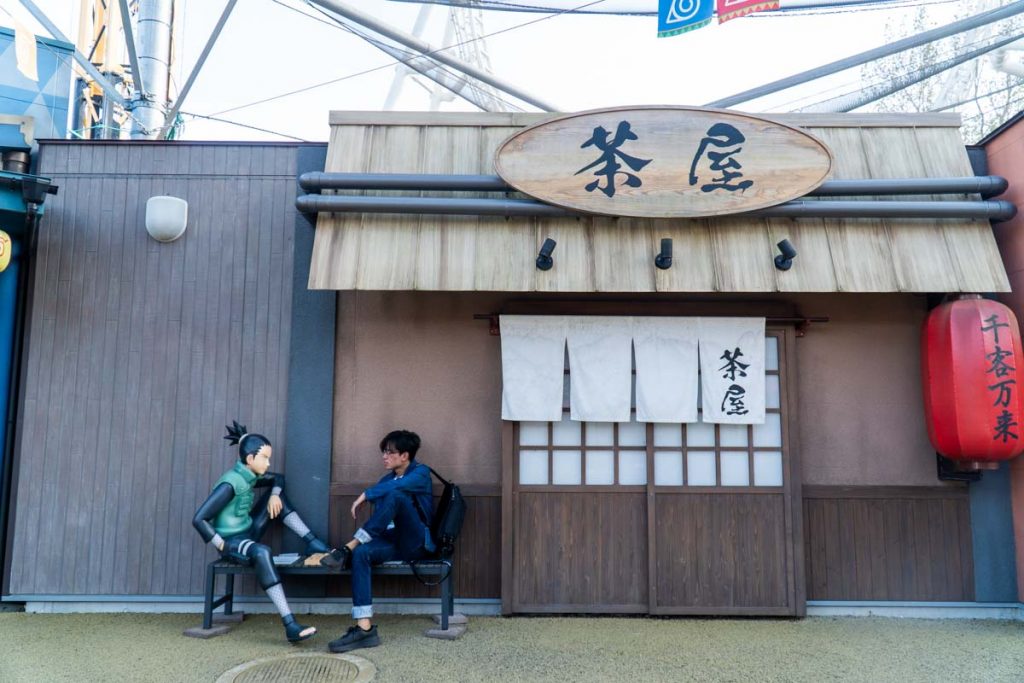
We then visited Naruto Village where we posed with life-sized Naruto characters and even visited Naruto’s favourite Ichiraku Ramen Shop !
Entrance fee: One Day Pass from ~S$62 via Klook Opening hours: 9AM – 6PM Address: 5 Chome-6-1 Shinnishihara, Fujiyoshida, Yamanashi 403-0017, Japan
Read also: The Best Roller Coasters in Japan Most Tourists Miss — Fuji Q Highland Guide
Arakura Fuji Sengen Jinja Shrine
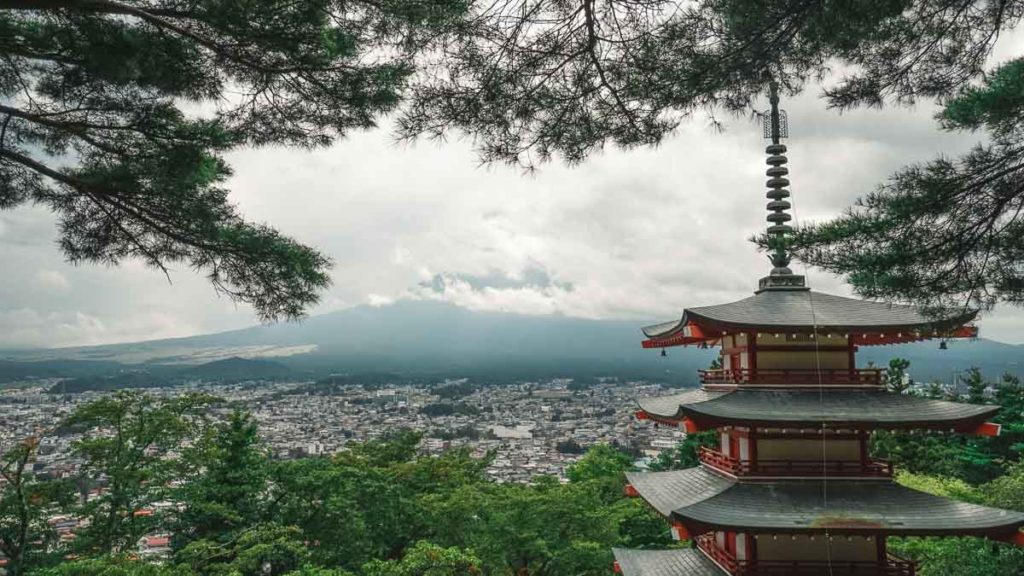
The Chureito Pagoda is one of Fuji’s, if not Japan’s, most symbolic attractions! After climbing a whopping 396 flights of stairs, we were rewarded with a sweeping panorama view of Fujiyoshida city against Mt Fuji.
Entrance fee: Free (¥1,000 parking fee during the annual cherry blossom festival) Opening hours: 24hrs Address: 3353-1 Arakura, Fujiyoshida, Yamanashi Prefecture 403-0011, Japan
*Pro-tip: Visit during Spring (early April) to catch a sea of cherry blossoms or in Autumn (October to November) for the orange maple leaves.
Dinner at Sanrokuren

Ending our day with dinner at Sanrokuren — a traditional charcoal grill-eating house serving some of the freshest Kushiyaki (grilled skewers) — it was perfect for cold rainy days, and winter evenings!
Set in a 150-year-old gassho-zukuri -style house (built with wooden beams and a steep thatched roof), the area is warmed by hot coal consistently shovelled into the charcoal pit by the staff.
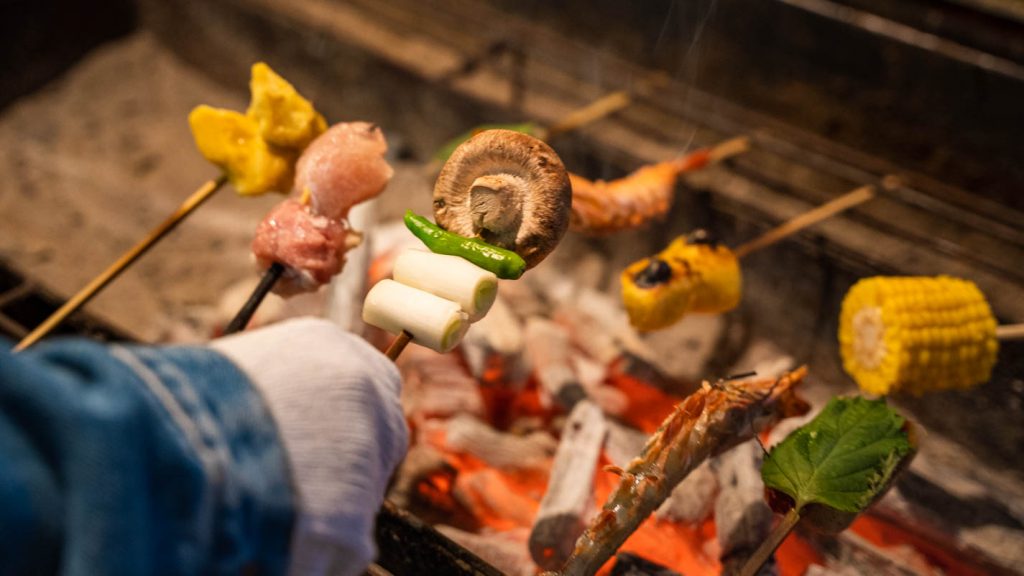
We ordered the Singen set (¥3,800) which comes with a rich assortment of fresh seafood and flavourful meats on skewers. Plus, a bowl of piping hot Hoto noodles — a Yamanashi region specialty consisting of thick and flat udon served in miso soup and seasonal vegetables.
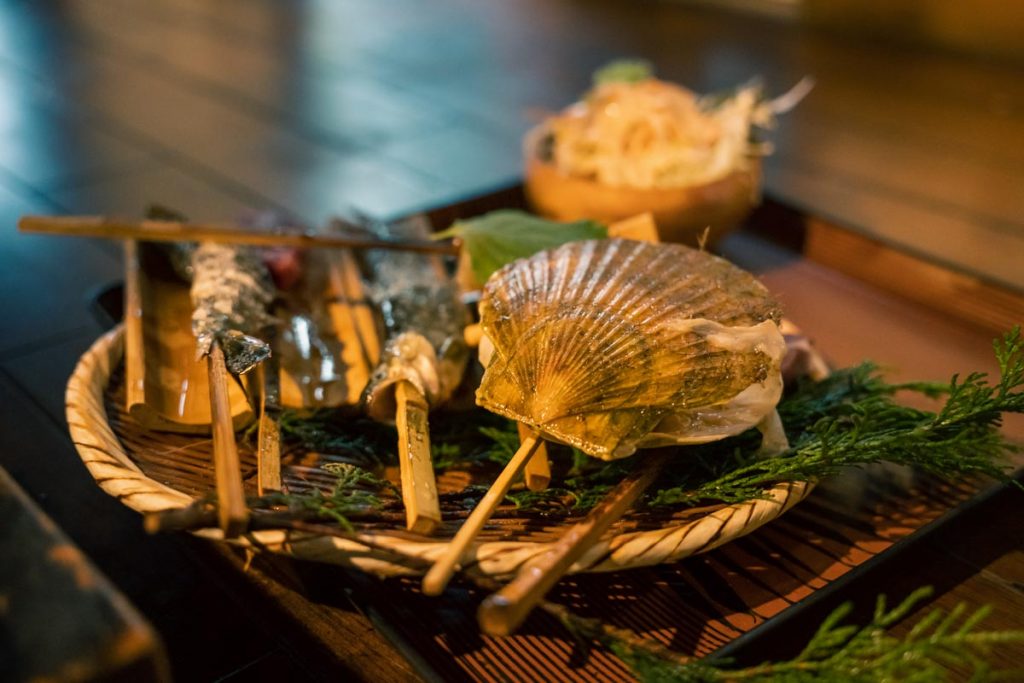
My favourite skewer in the set was the rainbow trout freshly caught from a small pond outside the restaurant because of its naturally sweet and delicate meat.
Cost: From ¥2,200 – ¥4,400/set Opening hours: 11AM – 9PM (Last entry 7PM), closed on Thu Address: 3370-1 Funatsu, Fujikawaguchiko, Minamitsuru District, Yamanashi 401-0301, Japan
*Pro-tip: Arrive at least an hour before the last entry as queues can be quite long!
Accommodation — Fuji View Hotel
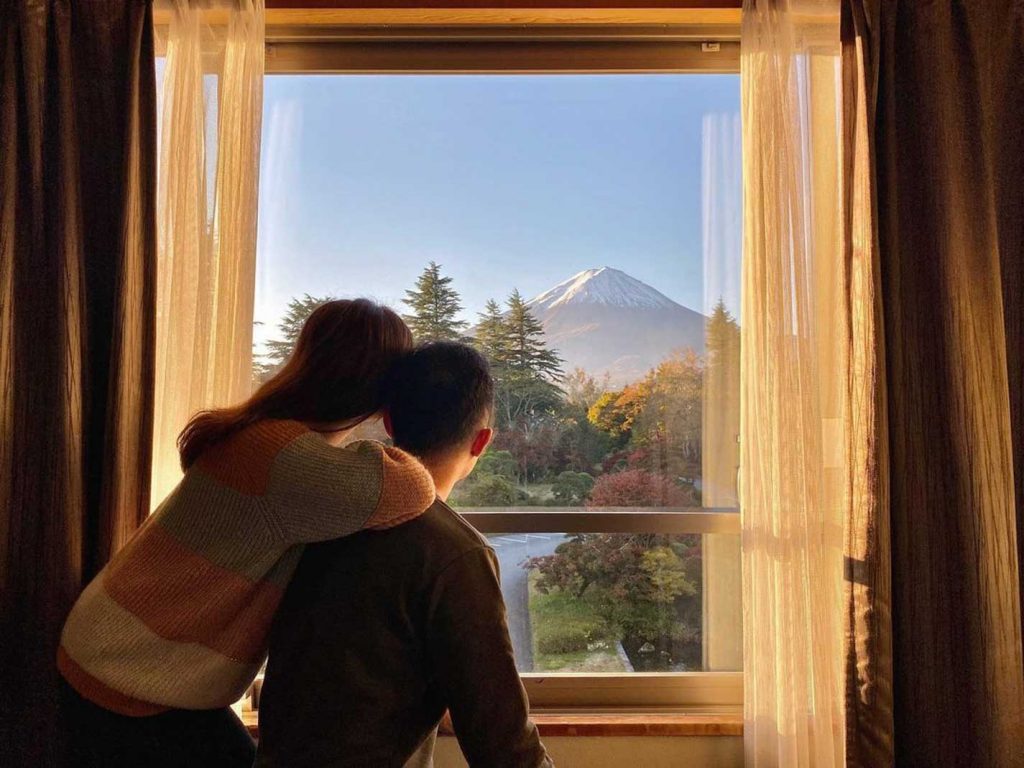
Photo credit: @bulaiern via Instagram
Fuji View Hotel’s specialty is that some of the rooms offer a great view of Mt Fuji overlooking the Lake Kawaguchi. Sadly for us, it was cloudy while we were there but the traditional tatami-style room was cosy and access to its outdoor onsen still made the stay an enjoyable one!
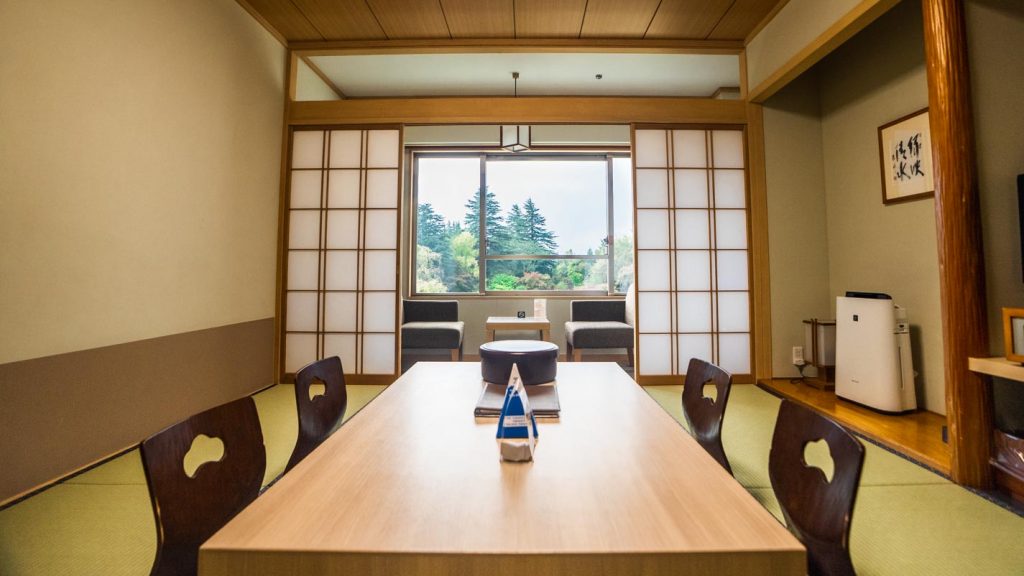
*Note: While most public onsens don’t allow tattooed individuals to enter, this one does.
Cost: ~S$364/night for the Japanese Style Mount Fuji View Room incl. breakfast) Address: 511 Katsuyama, Fujikawaguchiko, Minamitsuru District, Yamanashi 401-0310, Japan
Day 2: Fuji Five Lakes and Fujiyoshida
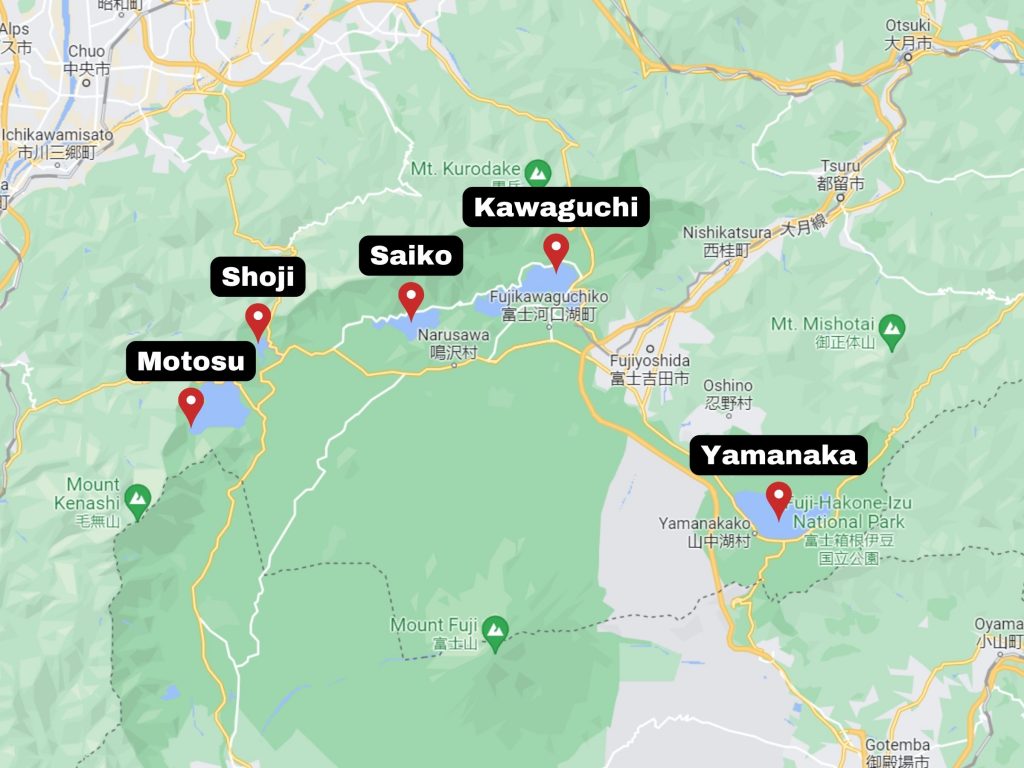
Visiting the Fuji Five Lakes is a must for every Mt Fuji itinerary as they have the most scenic views of the iconic mountain. If you’re short on time, here are three of them to check out!
Read more: 9 Best Mt Fuji Viewing Spots — Must-visits and Lesser Known Guide to the Best Photo Spots
Lake Kawaguchi

Photo credit: tokyocheapo.com
Lake Kawaguchi was the closest to our accommodation (about a 13-minute drive away), but the main highlight here is Oishi Park, which has flowers blooming in profusion every season!
Address: Kodachi, Fujikawaguchiko, Minamitsuru District, Yamanashi 401-0302, Japan
Lake Motosu
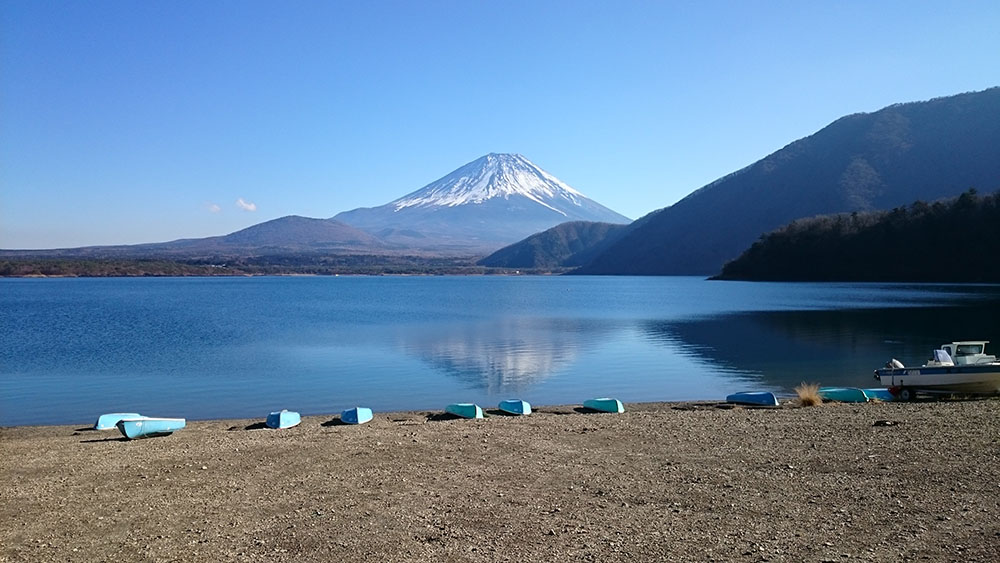
Photo credit: animetourism88.com
Fun fact: Lake Motosu is actually printed on the back of the ¥1,000 note! So you can literally camp here while gazing at a ¥1,000 view 😉.
Being the clearest lake out of the five, it’s also a popular spot for water activities such as windsurfing, canoeing, and even diving.
Address: 2926 Nakanokura, Minobu, Minamikoma District, Yamanashi 409-3104, Japan
Lake Yamanaka
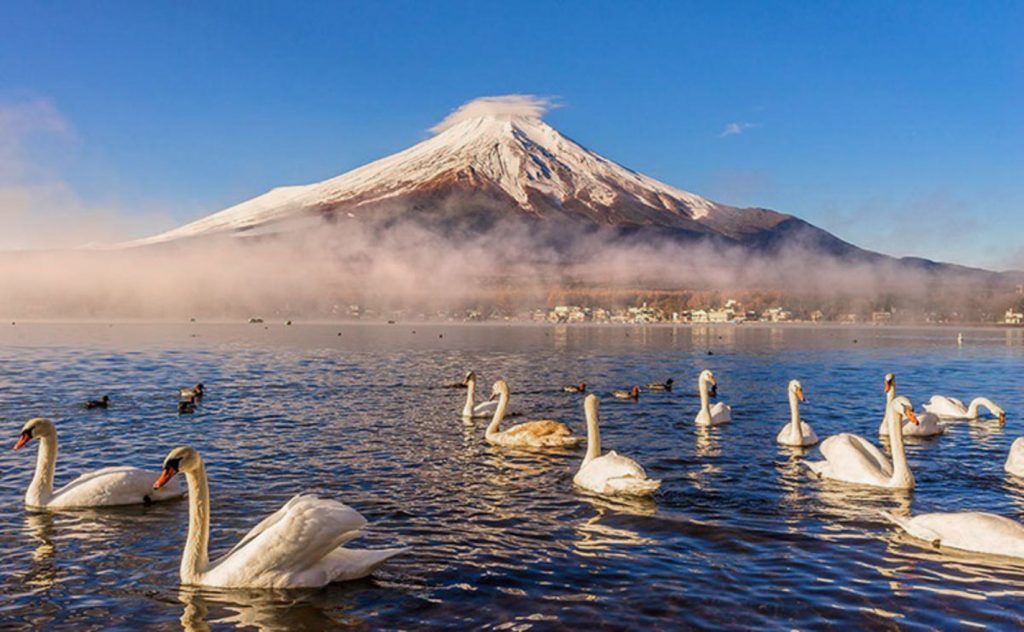
Photo credit: MYSTAYS .com
Lake Yamanaka is the closest to Mt Fuji out of the five lakes and is also unofficially known as “Swan Lake” — given the huge flock of swans there.
It’s inaccessible by public transport, which might explain why there weren’t as many people in the area. So we pretty much had the whole place to ourselves!
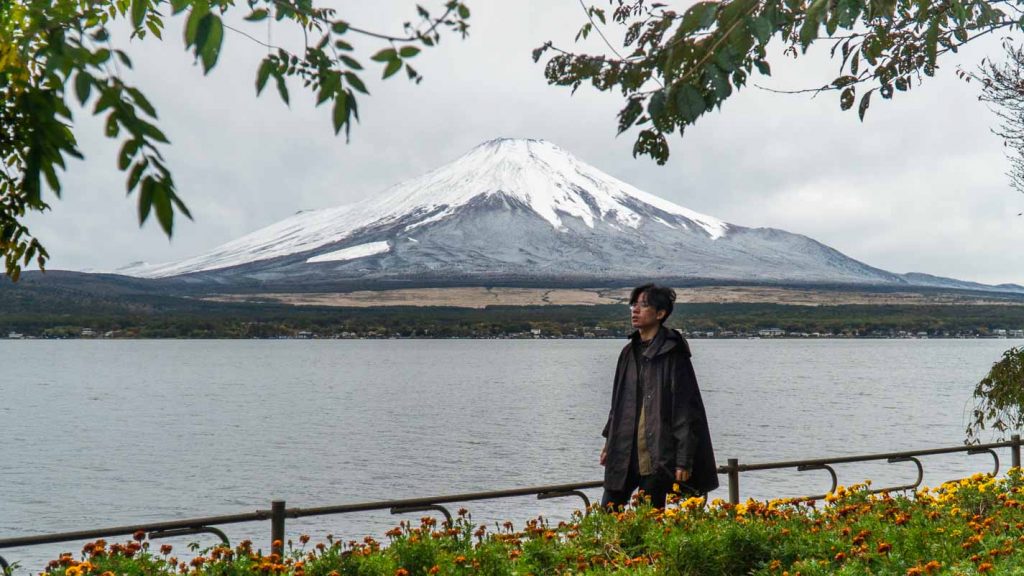
Address: Yamanakako, Minamitsuru District, Yamanashi, Japan
Honcho Street
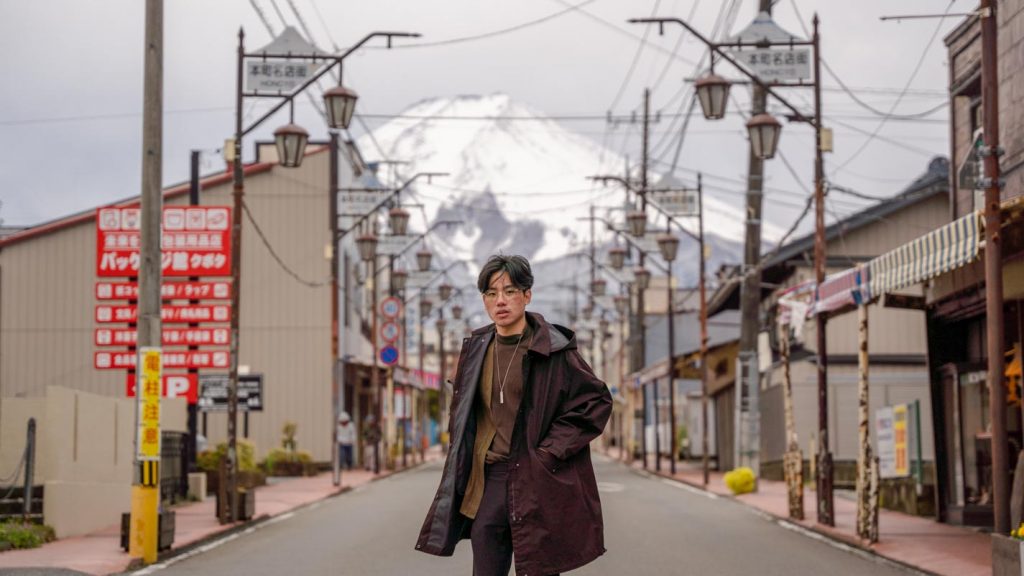
Honcho street is a 20-minute drive away from Lake Kawaguchi and is one of the most picturesque spots to shoot Mt Fuji — featuring idyllic shop rows and utility poles in a retro town setting.
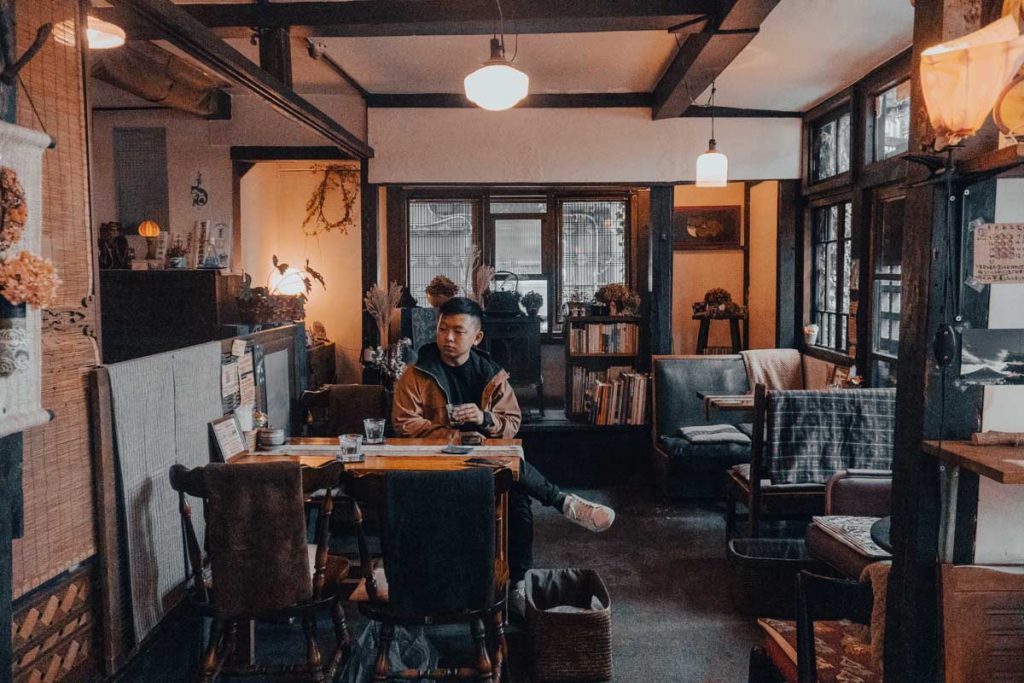
In the area, we popped by Cafe Gekkou for a coffee break. Furnished with 80s-inspired decor, the coffee was delicious and so were the cakes!
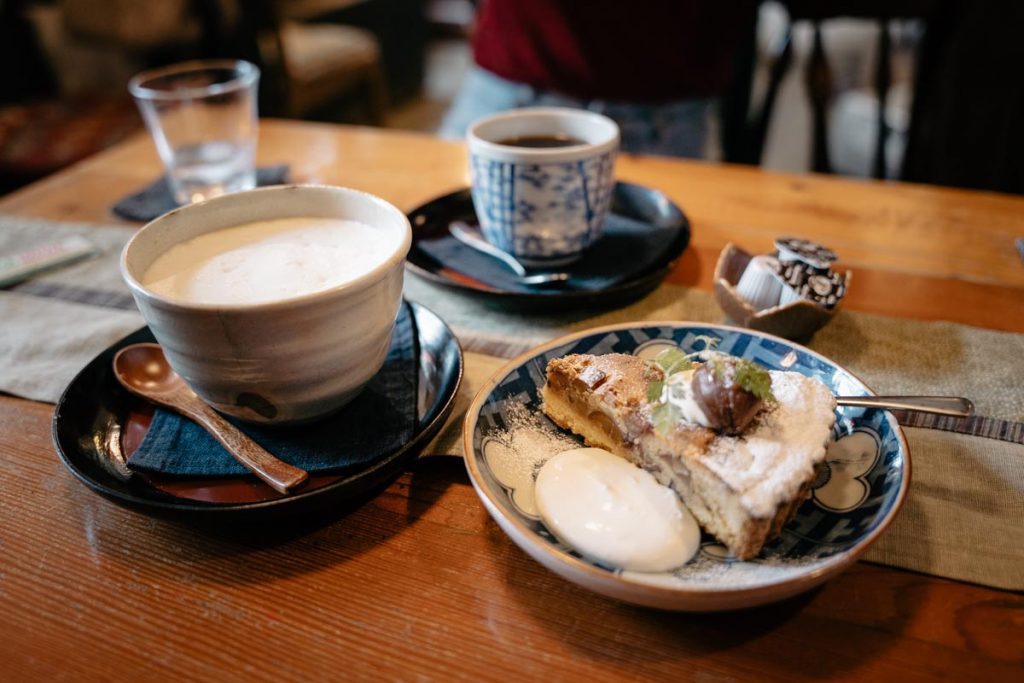
Latte (¥550), and the rich and nutty Chestnut cake (¥580)
Honcho Street Address: 3 Chome-12-295 Shimoyoshida, Fujiyoshida, Yamanashi 403-0004, Japan
Cafe Gekkou Opening hours: 12PM – 6PM Address: 318 Shimoyoshida, Fujiyoshida Yamanashi Prefecture
Kitaguchi Hongu Fuji Sengen Shrine
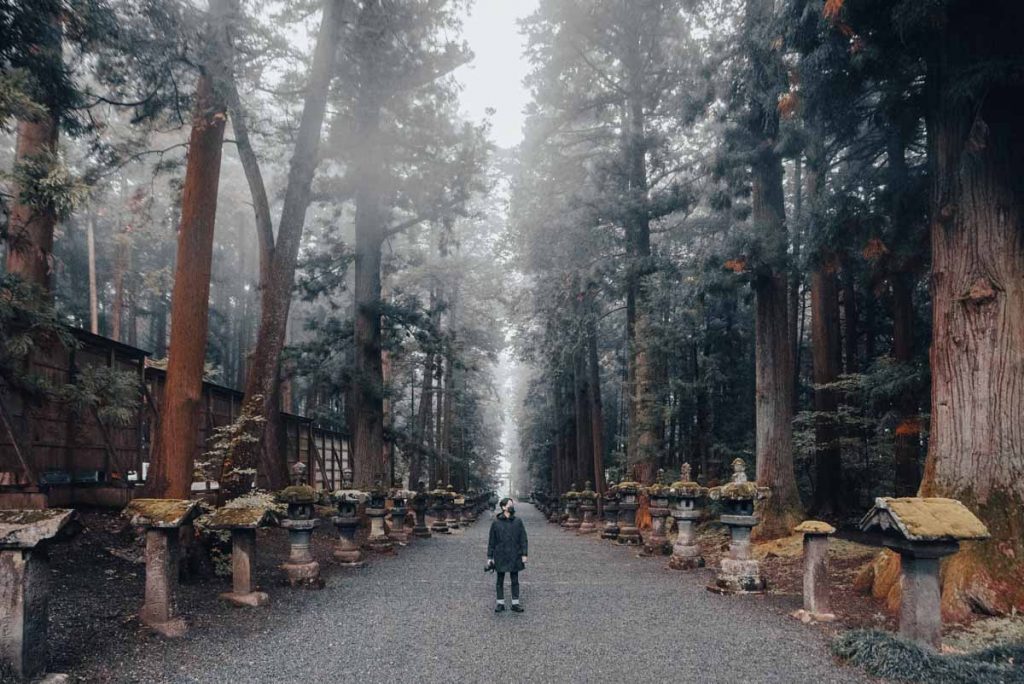
Kitaguchi Hongu Fuji Sengen Shrine used to be the starting point for followers of the Fujiko faith before they began their ascent up Mt Fuji. Today, it’s a UNESCO World Cultural Heritage site. The shrine entrance is bordered by moss-covered stone lanterns and has an enormous 18m – tall torii gate.
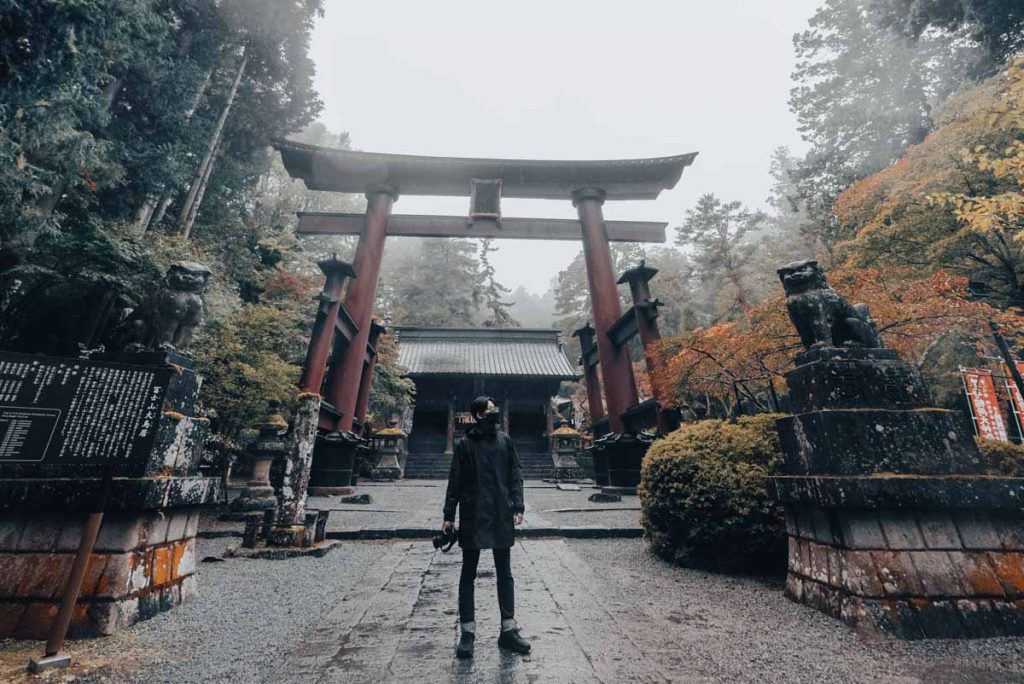
The sacred trees surrounding the area are over 1,000 years old and you can find occasional priests making their rounds around the main shrine giving the space a mysterious vibe.
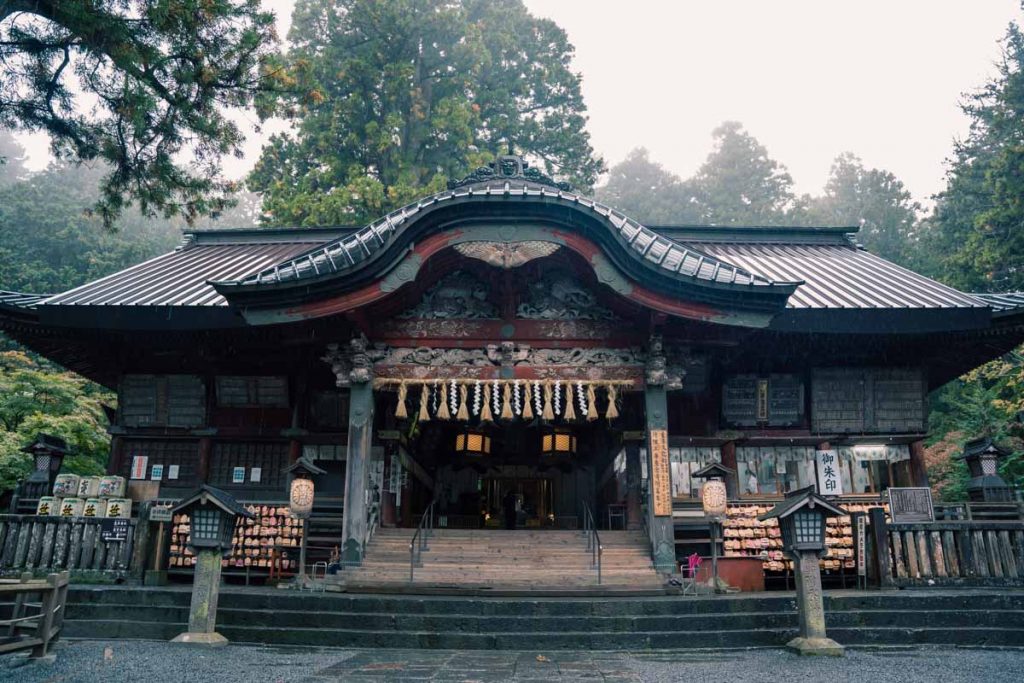
Opening hours: 8:30AM – 5:30PM Address: 5558 Kamiyoshida, Fujiyoshida, Yamanashi 403-0005, Japan
Hotokura Funari Kawaguchiko
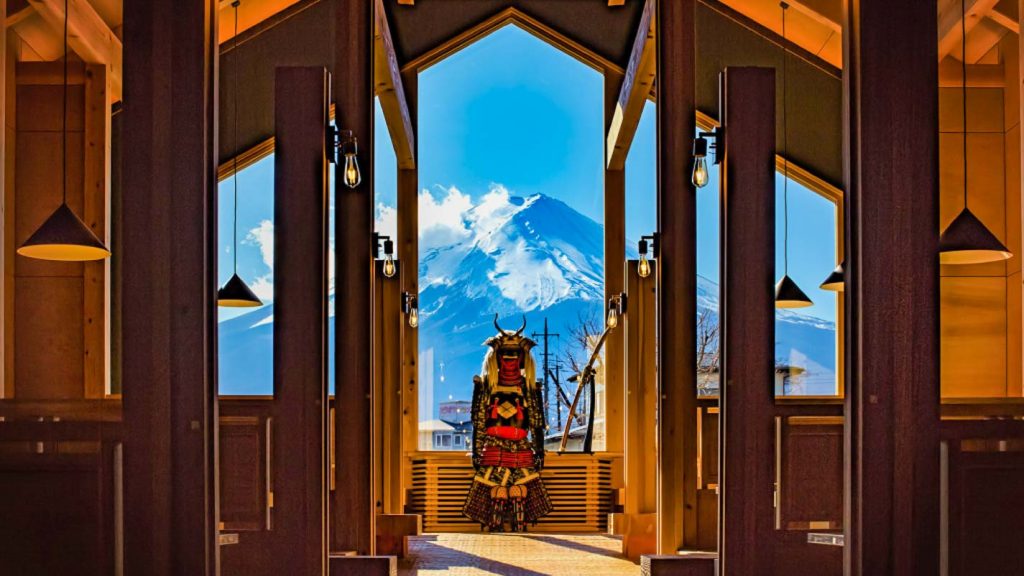
Photo credit: Yamanashi Tourism Organisation
For a meal with a view, Hotokura Funari Kawaguchiko is famous for its amazing Mt Fuji backdrop.
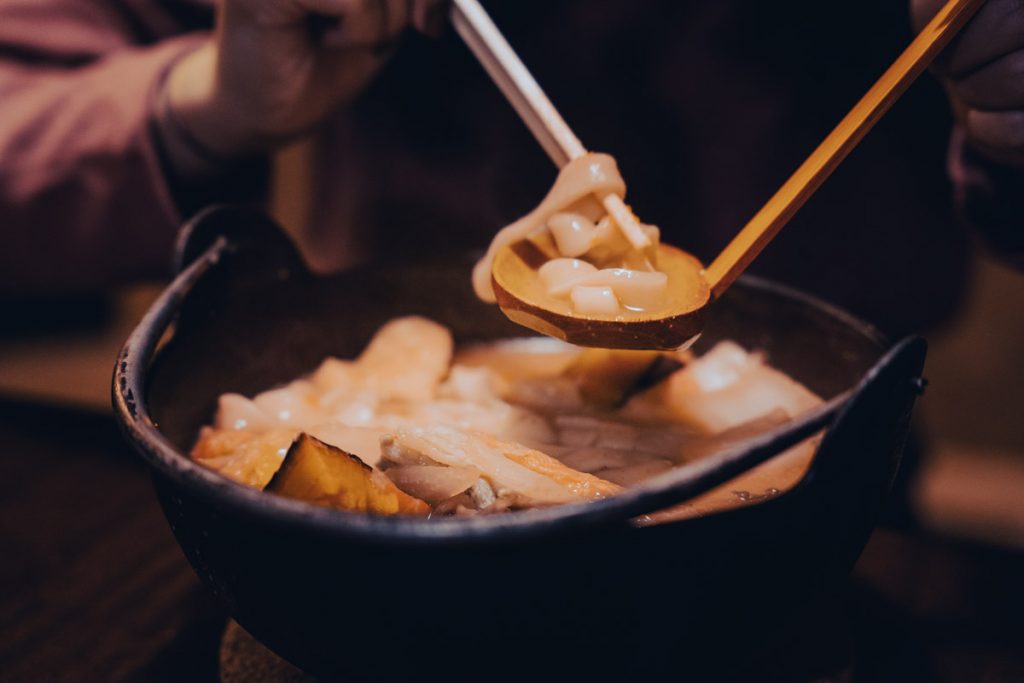
Plus, we’re also here for another round of delicious Hoto — we just can’t get enough!
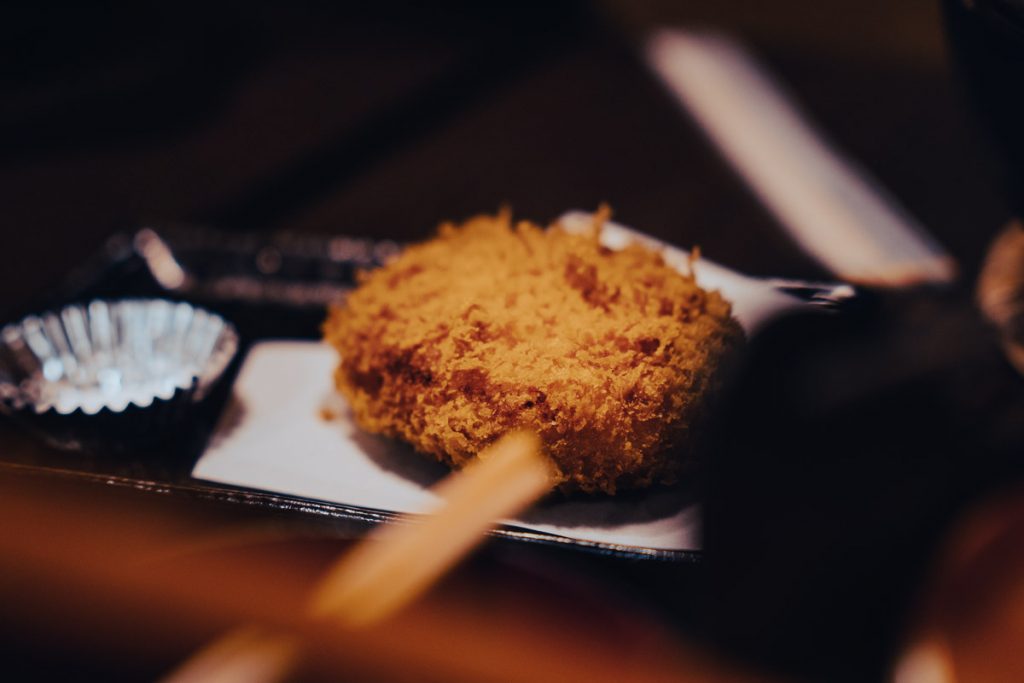
I loved the Golden Hoto with Pork (¥1,320) with its springy noodles and flavourful seasonal vegetables. Also try the naturally sweet and milky Hokkaido butter croquette (¥385/piece) — crisp on the outside, fluffy on the inside! 😋
Cost: From ¥1,320/bowl Opening hours: 11AM – 9PM Address: 6931 Funatsu, Fujikawaguchiko, Minamitsuru District, Yamanashi 401-0301, Japan
*Pro-tip: Use the camera function on Google Translate to decipher the full Japanese menu.
Accommodation — CITIO Hotel Shizuoka
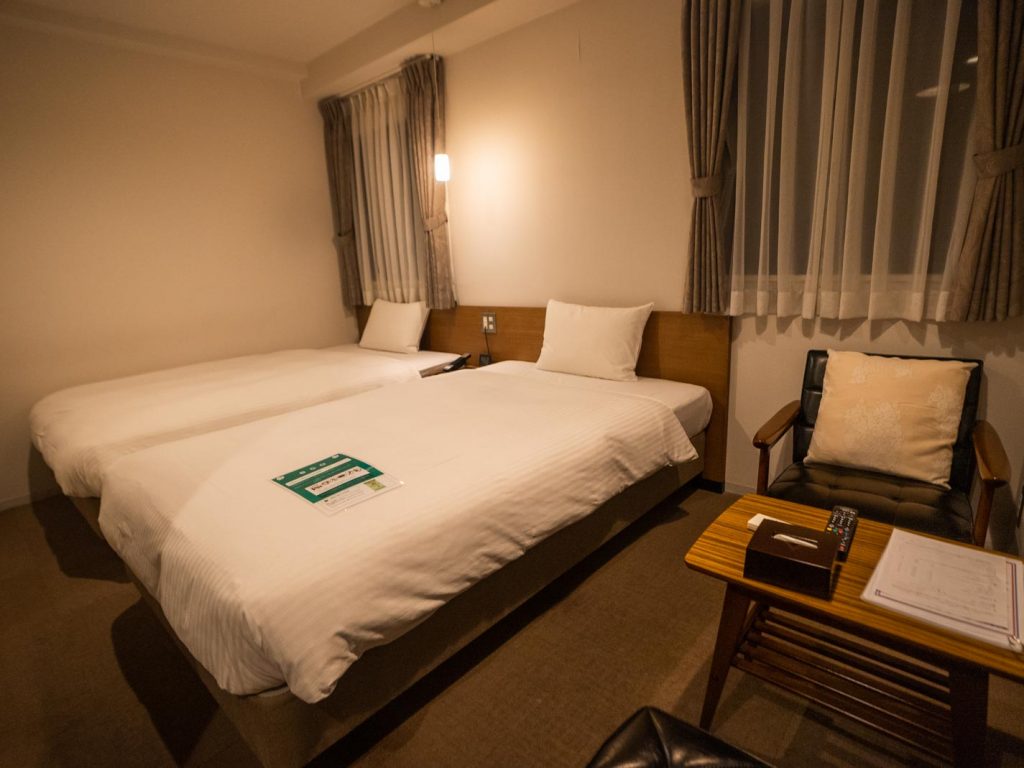
Hotel CITIO Shizuoka is a 5-minute walk from attractions like Sunpu Castle, as well as restaurants like Ichiran ramen! The hotel has clean comfy beds and a relatively large bathroom for a relaxing stay.
*Note: There’s no hotel parking so we parked at a 24hr car park (¥1,500/night) near the hotel.
Cost: Twin Room from ~S$102/night Address: 1-2 Tenmacho, Aoi Ward, Shizuoka, 420-0858, Japan
Day 3: Shizuoka
Miho no matsubara.

Photo credit: zekkeijapan.com
Set out early to catch the sunrise at Miho no Matsubara — a beach lined with pine trees along the shoreline, against a stunning view of Mt Fuji.
Fun fact: This view impressed a famous Ukiyo-e master, Utagawa Hiroshige, so much that he turned it into a famous print in the Edo period — known as the Thirty-six Views of Mount Fuji .
Address: Miho, Shimizu Ward, Shizuoka, 424-0901, Japan
Shiraito Falls
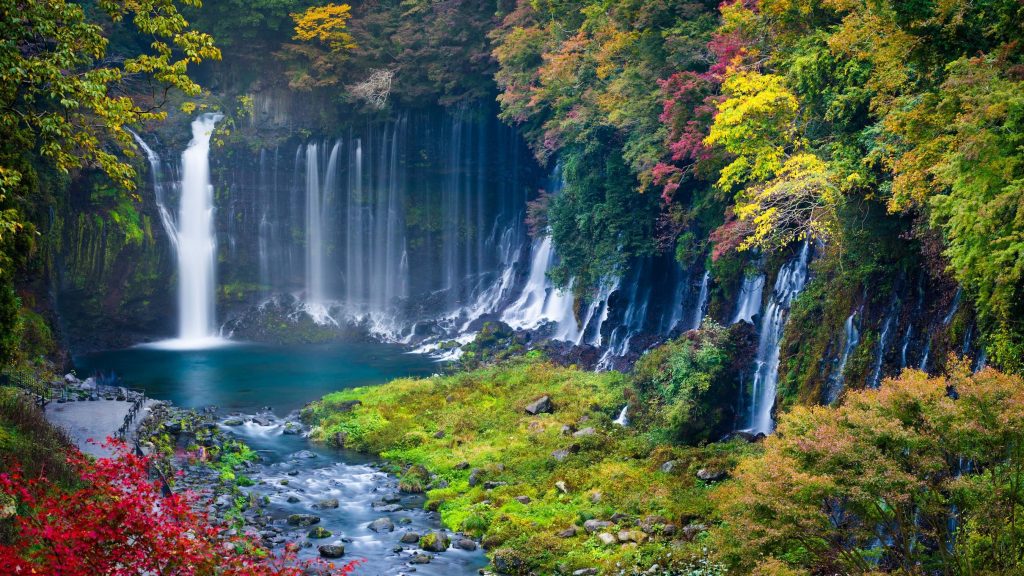
Photo credit: GaijinPot Travels
Shiraito Falls is one of Japan’s most prized waterfalls — holding not only a UNESCO World Heritage title, but also a place in the One Hundred Waterfalls of Japan (according to the Japanese government).
The 150m-wide gentle cascade resembles threads of fine silk, hence giving its name Shiraito or white threads.
The base of the waterfall is easily accessible via a short walking trail and the best time to visit is during Autumn — when Shiraito Falls is basked in orange foliage.
Address: 273-1 Kamiide, Fujinomiya, Shizuoka 418-0103, Japan
Obuchi Sasaba Tea Plantation
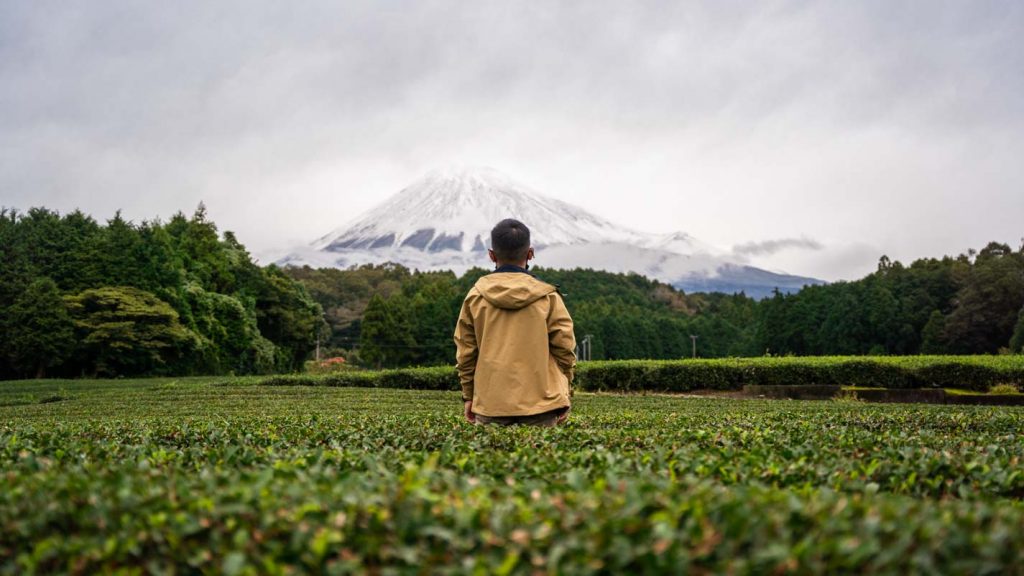
Shizuoka is one of the largest producers of green tea in Japan, so it’s no surprise that there are many tea plantations here.
We headed over to Obuchi Sasaba tea plantation en route to Mishima Sky Walk and had the whole place to ourselves, along with a pretty unique view of Mt Fuji 🍵 .
Entrance fee: Free Opening hours: 24hrs Address: 1445 Obuchi, Fuji, Shizuoka 417-0801, Japan
Mishima Sky Walk
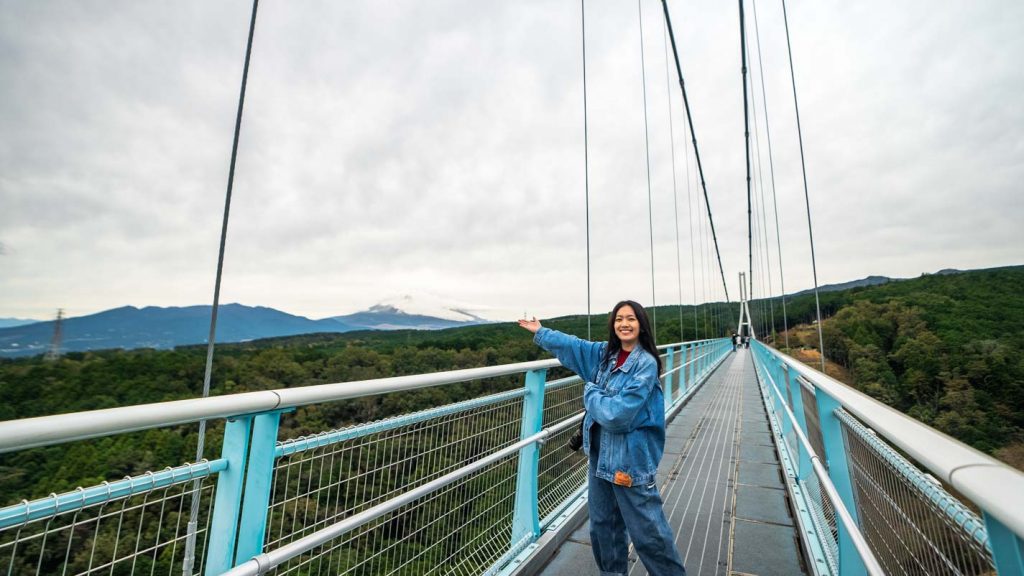
Mishima Skywalk is the longest pedestrian suspension bridge in Japan. At 400m long, it gives a bird’s eye view of Mt Fuji and Surunga Bay , perfect for our final stop in this Mt Fuji itinerary.
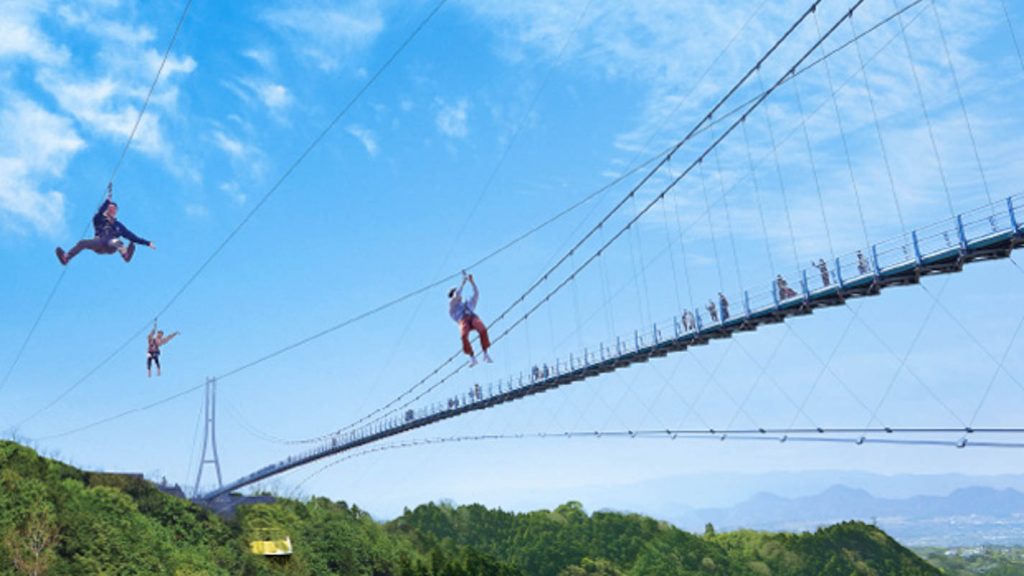
Photo credit: Mishima Skywalk
It connects to an adventure hub on the other end where you’ll find thrilling activities such as treetop obstacle courses, and a long zipline that runs beneath the bridge (¥2,000/roundtrip).
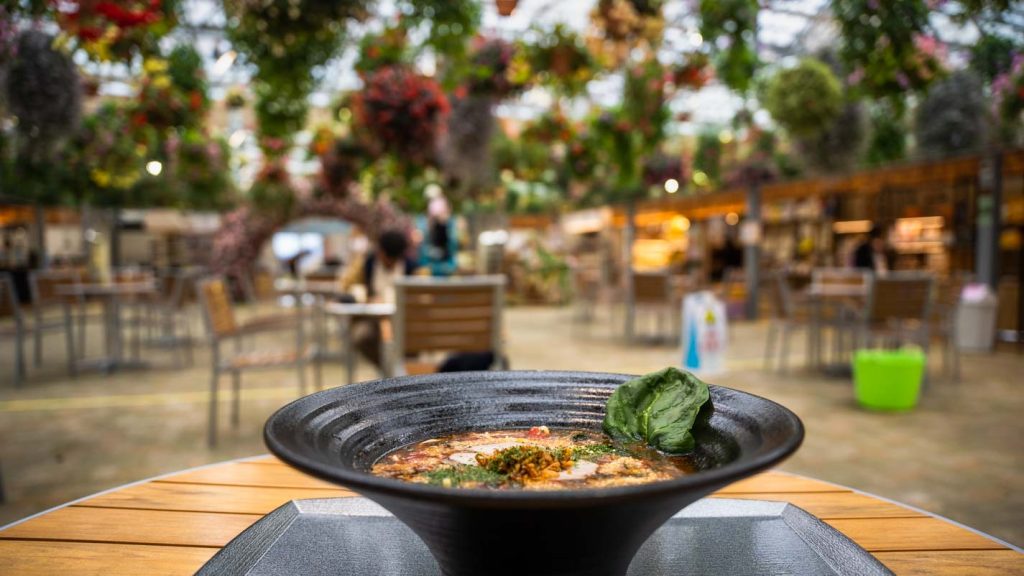
We had lunch inside the Sky Garden and ordered the Golden Tomato black pepper noodles (¥1,100/bowl) from Karumen . It tasted like a peppery and fragrant tomato soup ramen with seasonal vegetables — but with a lot more flair and spice.
Entrance fee: ¥1,100 Opening hours: 9AM – 5PM Address: 313 Sasahara Shinden, Mishima, Shizuoka 411-0012, Japan
*Note: Entry to the park requires proof of vaccination.
Useful tips for your Mount Fuji itinerary
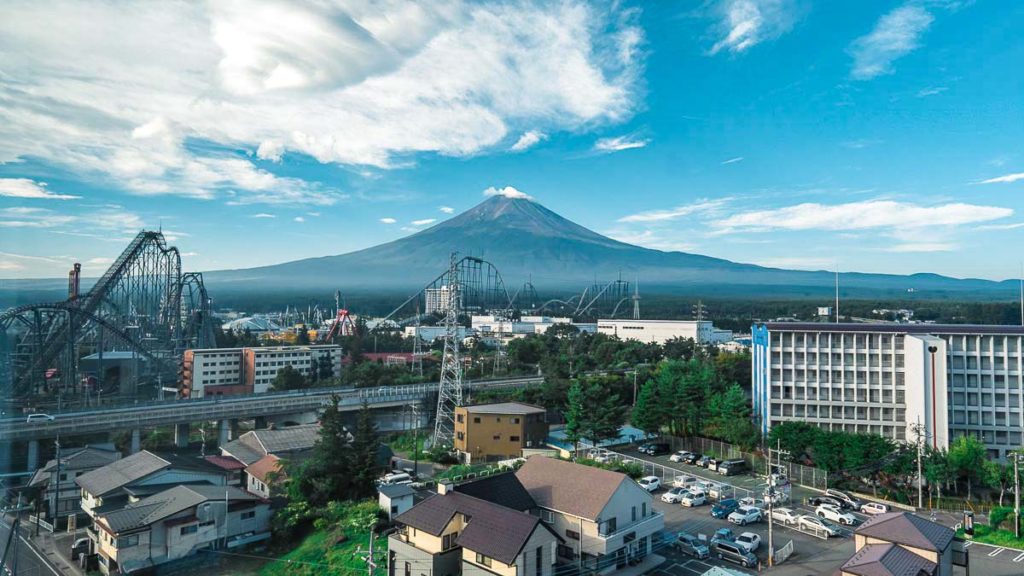
Getting to see the most famed mountain in all of Japan was such a ride. There were days when Mt Fuji was completely covered by dense clouds and rain, followed by a clear sky revealing a snow-capped Mt Fuji the very next day.
To get the most out of your road trip, here are some tips to help you out!
1) The Best time to visit Mt. Fuji is said to be between November and February (autumn and winter seasons) as the chances of clear skies are the highest. Personally, I’d still want to visit during spring to catch the cherry blossoms there! 2) Use the 24-hour Mt Fuji live stream and check the weather forecast for the day to see if it’s worth hunting for the best Mt Fuji photo spots 3) Be flexible with your itinerary — if Mt Fuji is not visible, you could visit other attractions first such as the Kitaguchi Hongu Fuji Sengen Shrine, and return on a better day. 4) Rent a car as most places aren’t easily accessible via public transport. It’s also a very scenic drive from Tokyo, so you can enjoy the seasonal colours of nature on your way! 5) Download Google Translate, as almost everything is in Japanese here.
Also, do check out these related itineraries! — Japan Self-Driving Guide for First-timers — 15 Things You Need to Know Before Renting the Car — Guide to Climbing Mount Fuji — Everything You Need To Know About Climbing Japan’s Highest Mountain — 7D6N Japan Itinerary Under S$1.5k — Road Trip from Tokyo to Mt. Fuji and Beyond
What’s your favourite thing to do around Mt Fuji? Let us know in the comments!
For more travel inspiratio n, follow us on Facebook , Instagram , YouTube , and Telegram .
View this post on Instagram A post shared by thetravelintern.com 🇸🇬 (@thetravelintern)
LEAVE A REPLY Cancel reply
Save my name, email, and website in this browser for the next time I comment.

Hong Kong’s Outdoor: 9 Lesser-Known Sights for the Adventurous

HK’s Hidden Outdoor Gems: 7 Things to do in Hong Kong...

Sai Kung Guide — 7 Day Trip Itineraries to an Often...

A First-timer’s Guide to Belgium — Why This Should be Your...

Top 11 Hotels Near Tokyo Disney Resort — Quirky Themes, Dino...

- Terms Of Use
- Privacy Policy
Expedia Rewards is now One Key™
Earn onekeycash when you sign in and book an activity.

Check availability
- About this activity
Tokyo to Mount Fuji Journey of a Lifetime Day Trip
- Mobile voucher
- Instant confirmation
- Multiple languages
Embark on an unforgettable journey from Tokyo to Mount Fuji with our Mt. Fuji Classic Route Day Tour! Experience the breathtaking beauty of Japan's iconic peak as you traverse picturesque landscapes and charming villages. Departing from Tokyo, our comfortable tour bus takes you through the countryside, offering glimpses of traditional Japanese life. Marvel at the changing scenery as you approach Mount Fuji, with its snow-capped summit dominating the horizon. Explore Lake Kawaguchi's serene waters, reflecting Mount Fuji's grandeur. Discover Oshino Hakkai, a quaint village known for its crystal-clear ponds fed by the mountain's snowmelt. Ascend to the Mount Fuji 5th Station, 2,300 meters high, for panoramic vistas. Our knowledgeable guides provide insights into Mount Fuji's history and culture. Whether you're seeking adventure or cultural immersion, our tour offers an unforgettable exploration of Japan's most revered natural wonder. Book now for a once-in-a-lifetime experience.
Activity location
- モード学園総合校舎コクーンタワ 7
- 160-0023, Shinjuku City, Tokyo, Japan
Meeting/Redemption Point
- Wed, May 15 -
- Thu, May 16 -
- Fri, May 17 $84
- Sat, May 18 $84
- Sun, May 19 $84
- Mon, May 20 $84
- Tue, May 21 $84
- Wed, May 22 $84
- Thu, May 23 $84
- Fri, May 24 $84
- Sat, May 25 $84
- Sun, May 26 $84
- Mon, May 27 $84
- Tue, May 28 $84
- Wed, May 29 $84
- Activity duration is 10 hours 10h 10h
What's included, what's not
- What's included What's included English/Chinese-speaking guide
- What's included What's included Admission to attractions
- What's excluded What's excluded Other personal expenses
- What's excluded What's excluded Meals and beverages
Know before you book
- Wheelchair accessible
- Infants and small children can ride in a pram or stroller
- Public transportation options are available nearby
- Infants are required to sit on an adult’s lap
- Transportation options are wheelchair accessible
- All areas and surfaces are wheelchair accessible
- Suitable for all physical fitness levels
- Warm clothing (preferably thick clothing for warmth)
- Always bring your trash when getting off the bus
- Free for children aged 0-2 as long as they will not occupy separate seats
Activity itinerary
Tokyo mode gakuen, mt.fuji 5th station (sky palace), lake kawaguchi, oshino hakkai.
- Admission ticket included
Gotemba Premium Outlets
Best deals on things to do, top experiences in shinjuku city.
- Travel recommendations The world is a big place – not sure where to go? Get recommendations on destinations, the best times to go there, and what to do.
- Travel in the UK How much have you really travelled within the UK? There are so many local hidden gems waiting to be discovered – be inspired here.
- The taste of travel For some, the best way to experience a place is through its food. See the best places to go for dining and local dishes around the world.
- Tips & tricks Hack your way to the most amazing trips ever with tips on everything from how to pack your carry-on to how to eat dumplings.
- Travel experiences What’s your favourite thing to do when you’re travelling? Find the best things to see and do based on your interests or type of travel.
- News Read the latest news about the travel industry, our products and services, and what’s happening at KAYAK.

The ultimate Japan itinerary for first-timers

Japan is one of the most fascinating countries you could visit but travellers often feel overwhelmed when putting together a Japan itinerary. Luckily for you I just returned from an epic trip and will share my best tips with you.
Whether you have a week, 10 days, or want to combine both into a 2 week Japan itinerary — this article has you covered. I'll share some amazing places to see , where to stay, and how to plan a road trip in Japan.
In this article
How to get to Japan?
What is the best mode of transport for your japan itinerary, best time for your japan itinerary, average budget for your japan itinerary, japan itinerary 7 days — from tokyo to the mountains, japan itinerary 10 days — kansai & beyond.
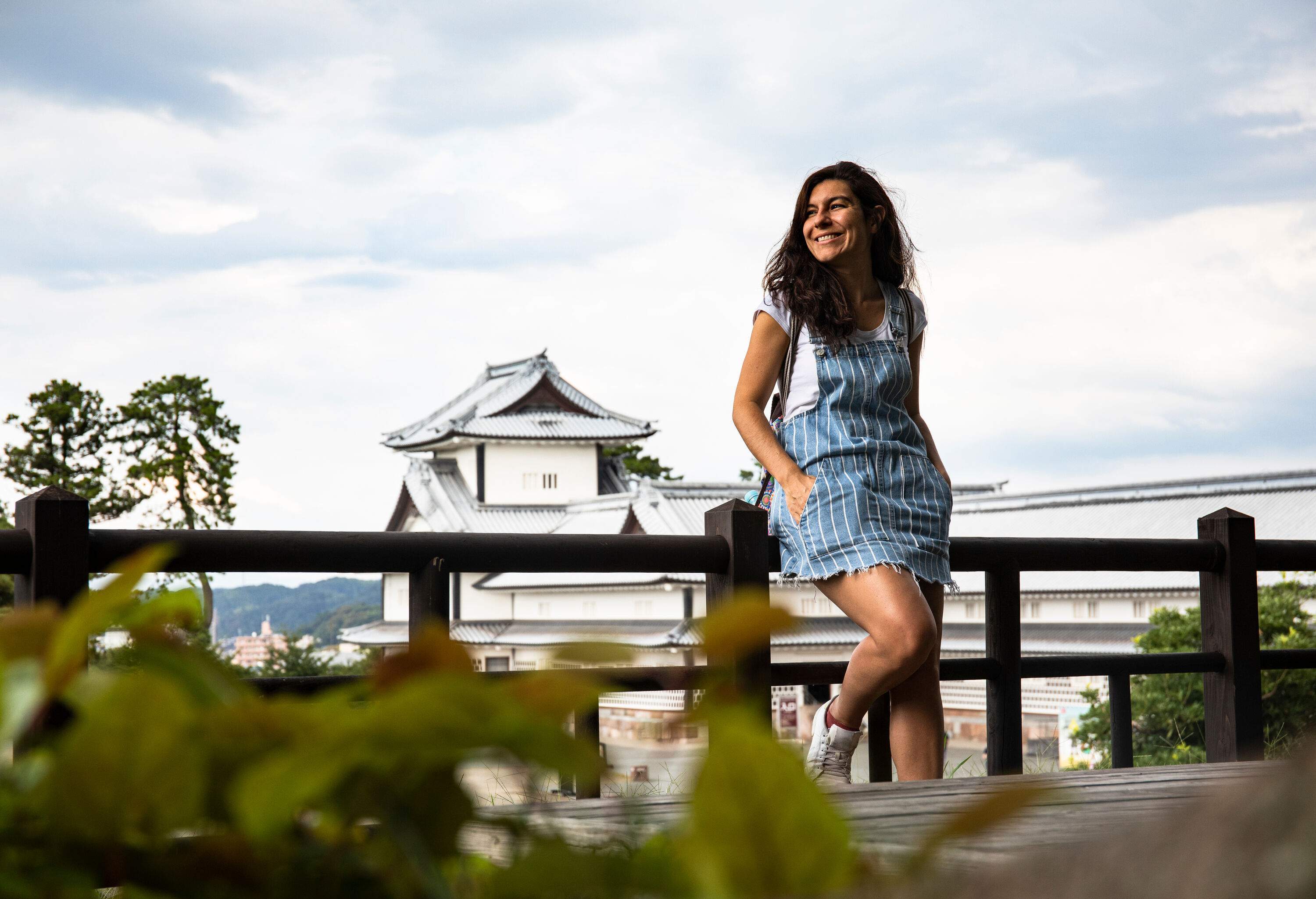
Japan has a few international airports and some you can even reach with a direct flight from the UK. A direct flight from London to Tokyo costs £978 on average (Data sourced through KAYAK comparator search tool).
When flying in or out of Tokyo you have the choice between the airports Haneda and Narita . Depending on your Japan itinerary you may want to check for a direct flight to Osaka Kansai.
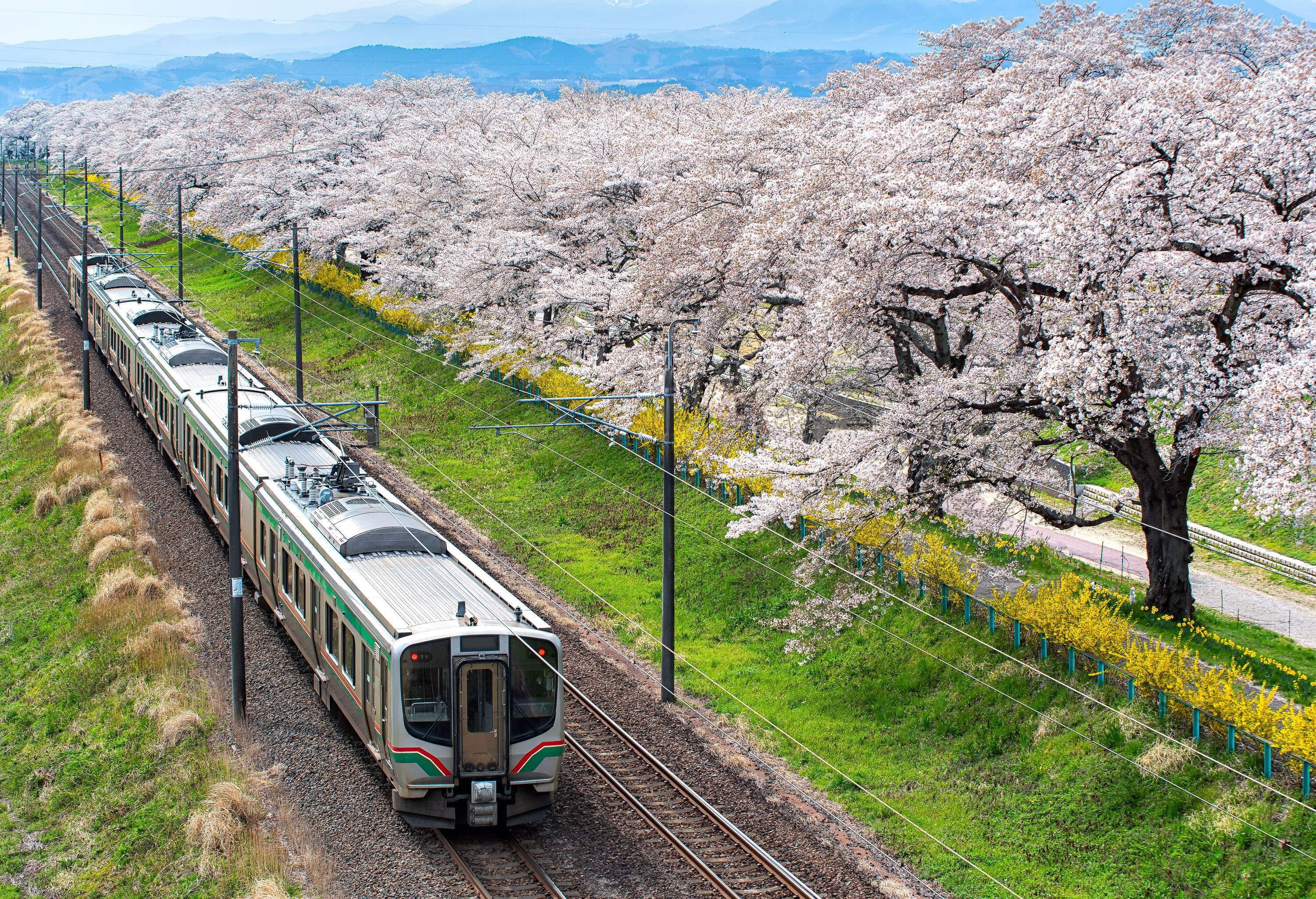
Most Japan itineraries can be done by car, train, or plane , or a combination thereof. Budget and where you want to go will be deciding factors. In addition, it is important to think about how many people will be travelling. Especially if you are planning a Japan itinerary for 14 days with the whole family, it might be cheaper to rent a car.
However you will need to get an International Driving Permit to drive legally in Japan. For many visitors, the left-hand traffic system can present an issue. But visitors from the UK will feel right at home! You can find more tips on driving in Japan as well as traffic laws on the website of the Japanese Automobile Federation .
According to the data we have compiled (based on travellers's searches on KAYAK), October is the most popular season for a trip to Japan. March and April are also strong contenders due to it being Sakura , cherry blossom season. While the weather is great for exploring during these months, hotel rooms will be more expensive and popular tourist spots are even more crowded than usual.
January, February, and August are the least popular travel months in Japan. If you don’t mind heat and humidity, give August a go . For those travelling in winter, there are plenty of great ski resorts in Japan, but you must be mindful of road conditions when getting a hire car.
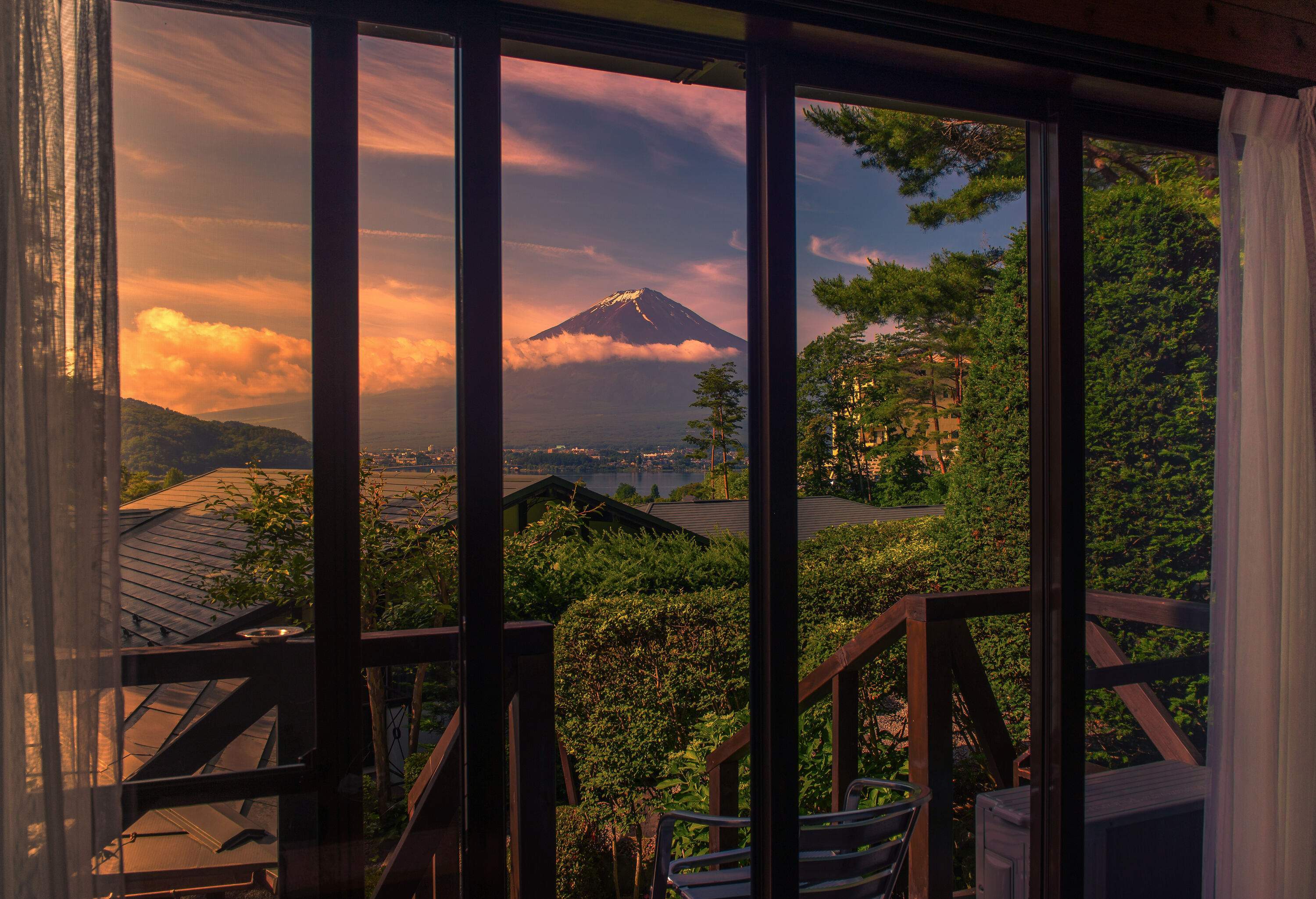
Before you book your flight to Japan, it's a good idea to put together your budget. If you are planning on renting a car for a road trip through Japan have a look at these average prices we have put together for you based on our data:
- Average price for a double room in Tokyo: £131 per night
- Average price of a bed in a hostel in Tokyo: £51 per night
- Average price of a rental car in Tokyo: £66 per day
- Price for a litre of petrol in Tokyo: £0.90*
*As of April 2024
For the 10-day Japan itinerary below, you will cover up to 300 miles and the total budget will be approximately £885 per person based on two people sharing (not including flights). However, you may need to add a buffer for tolls, which can be quite steep.
If you prefer to travel by train, the Japan Railpass is a great option to get around . However, it saw a recent price increase. Once you have mapped out your route it is a good idea to add up the individual trips on the Japan Railpass website and calculate whether it might be cheaper to buy single tickets.
The following Japan itineraries are planned around doing a road trip, and show distances and approximate travel times for cars.
Day 1–3: Tokyo
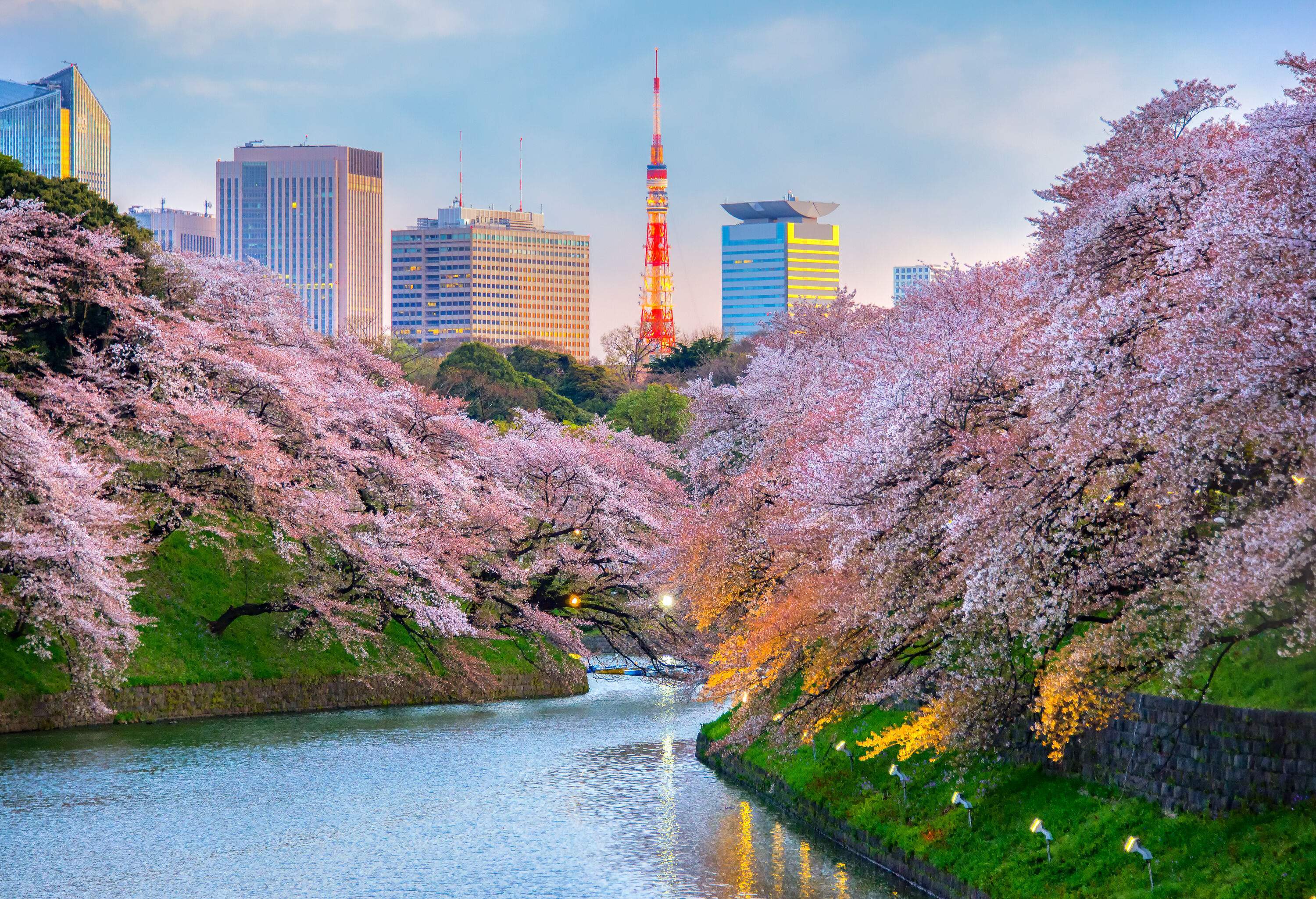
For most, a Japan travel itinerary starts in the country’s capital Tokyo. Chances are that jet lag means taking things a little slower but even without that, Tokyo is huge and there is so much to see . Take a few days to explore famous areas like Shibuya and Shinjuku, Ginza, and the historic Asakusa area.
Hotel in Tokyo : Hotel CEN , located a quirky yet residential area
teamLab is an international art collective that currently has two exhibitions in Tokyo. It merges technology, art, and nature and integrates the visitors in a very unique way. While difficult to describe, their current shows are absolutely magical even if you are not usually a museum fan.
Gōtokuji Temple
Cat lovers have to take a trip to Gōtokuji Temple. It is said to be the home of the maneki-neko, the beckoning cat figurines that are known to bring luck. You can see them everywhere around the temple and of course there is a gift shop. The cats from the source have become so popular that sales are limited to one figurine per person.
Day 4: Hakone
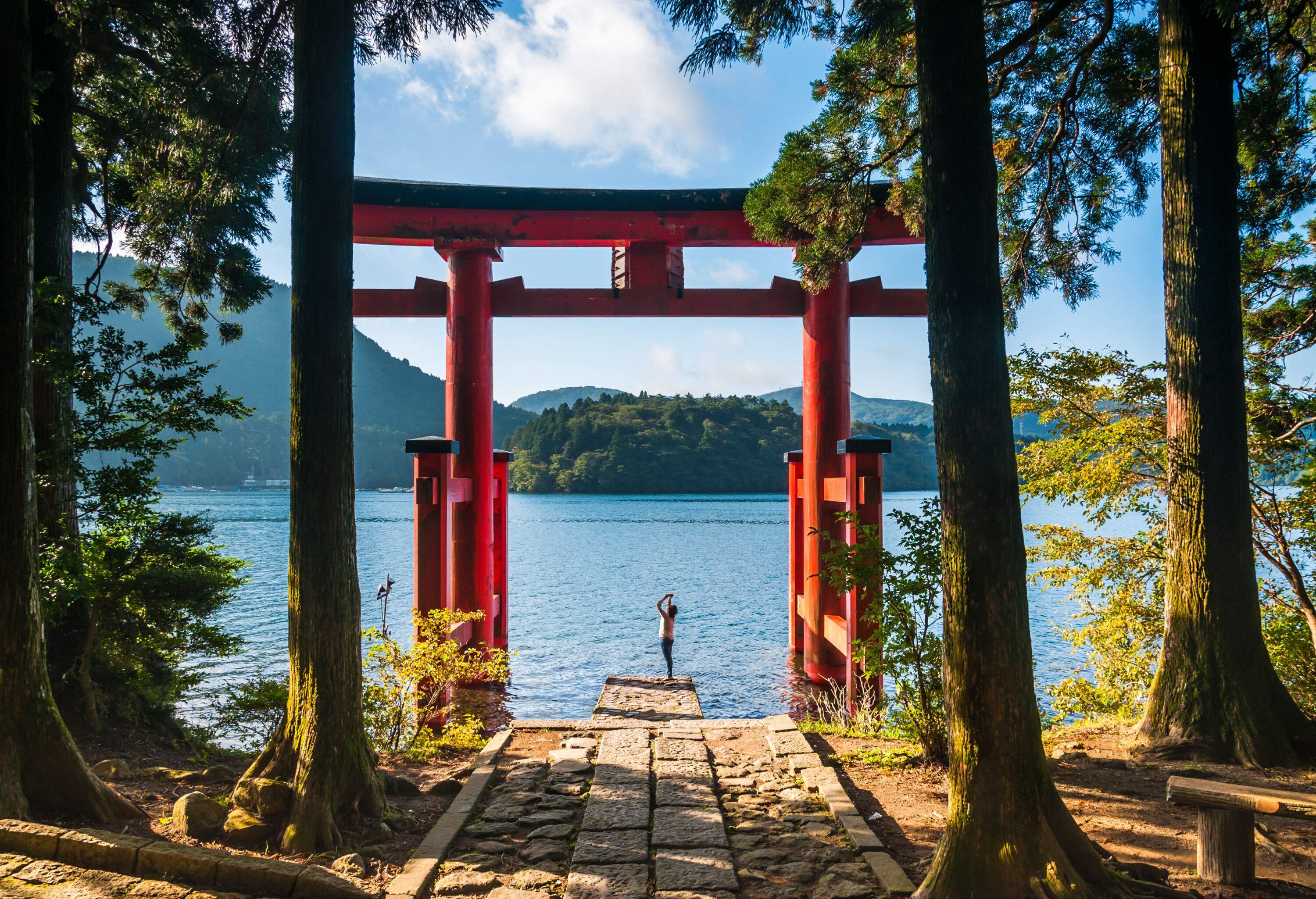
Distance from Tokyo: 50 mi — at least 1 hour
Not far from Tokyo, you find Hakone, the perfect place for a weekend getaway in nature . Over Lake Ashinoko you have a great view of Mount Fuji. After a day of exploring you can recharge in one of the town's many hot springs.
Hotel in Hakone : Fujiya Hotel , a beautiful historic accommodation
Hot springs, hot rivers, and an egg-like smell: it is pretty obvious that Owakudani is an active volcanic zone! The area is located around the crater of Mount Hakone and there are various walking trails to explore. You can even buy eggs cooked in hot pools that are said to extend your life by seven years.
Lake Ashinoko
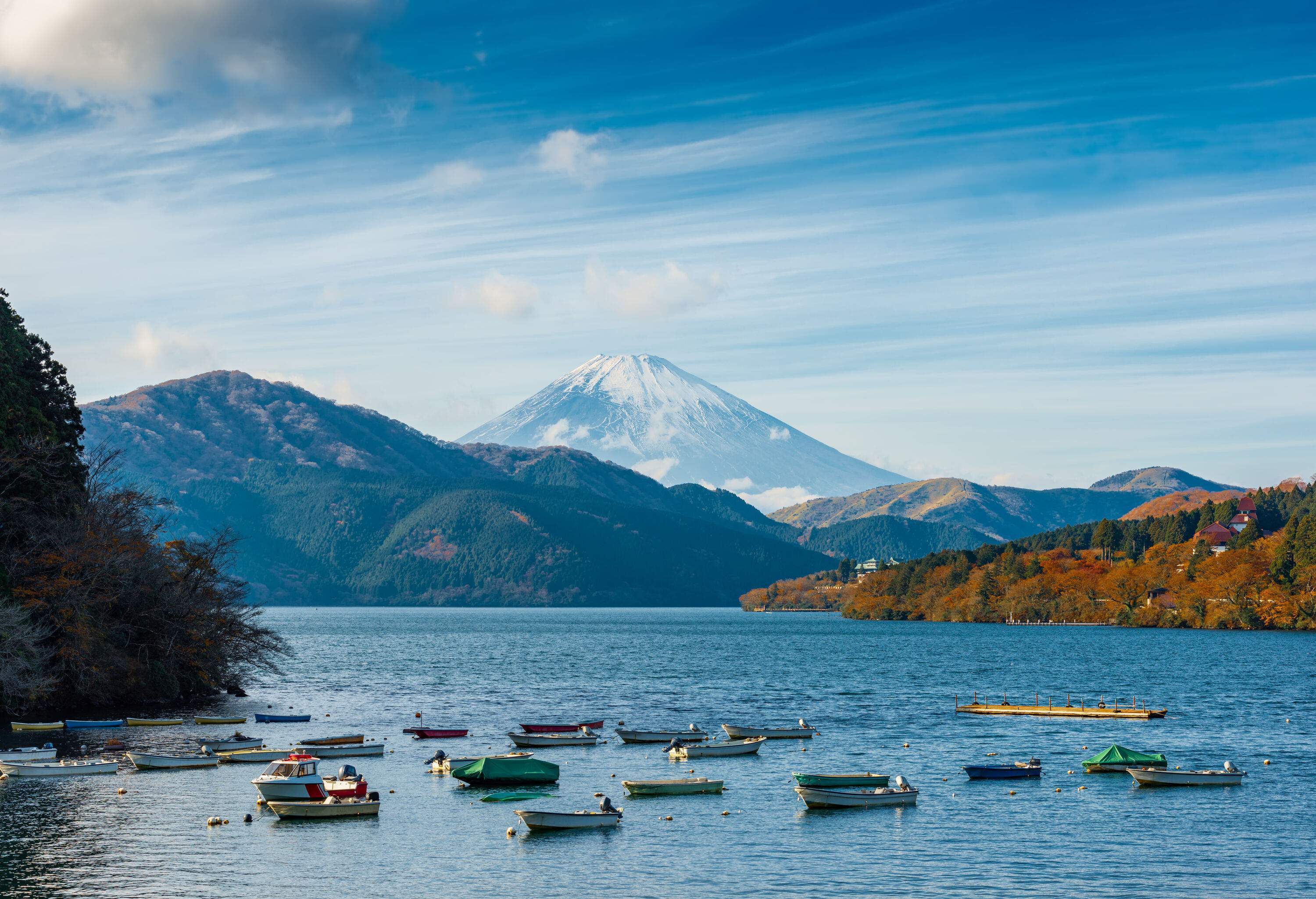
For some of the best Mount Fuji views head to the shore of Lake Ashinoko . You can take a sightseeing-boat over the lake or simply stroll along the shores. If seeing Mount Fuji in all its glory is a must, time your visit well: the cold season brings clearer skies.
Day 5: Matsumoto
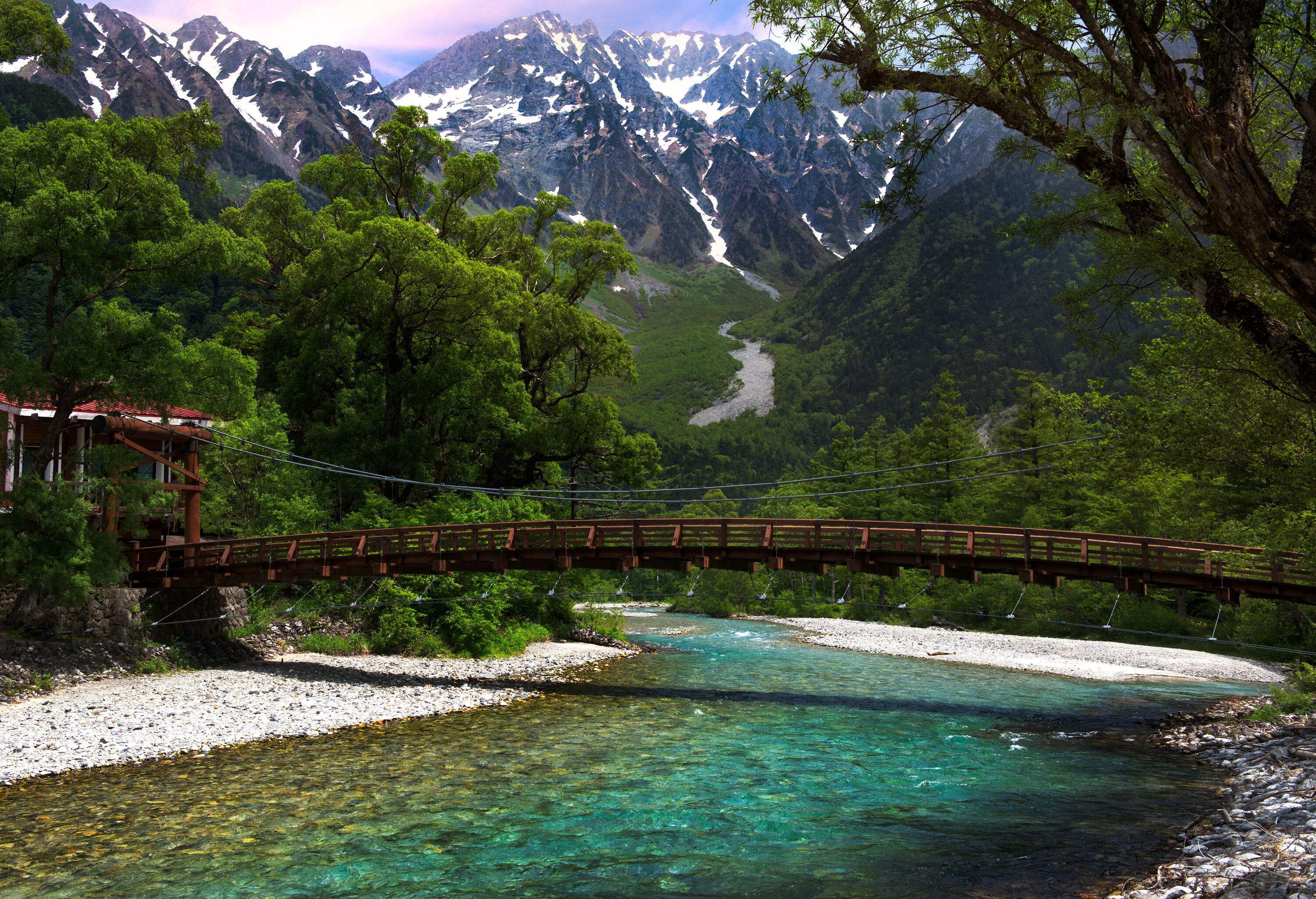
Distance from Hakone: 150 mi — 3 hours
Mountain lovers have come to the right place as Matsumoto is a great spot to explore the Japanese Alps . There are plenty of trips you can take from here to see various parts of the Alps, summer and winter. The city is also home to a few interesting museums and one of Japan’s most beautiful castles.
Hotel in Matsumoto : Onyado Nono , a stunning inexpensive hotel with a hot spring
Matsumoto Castle
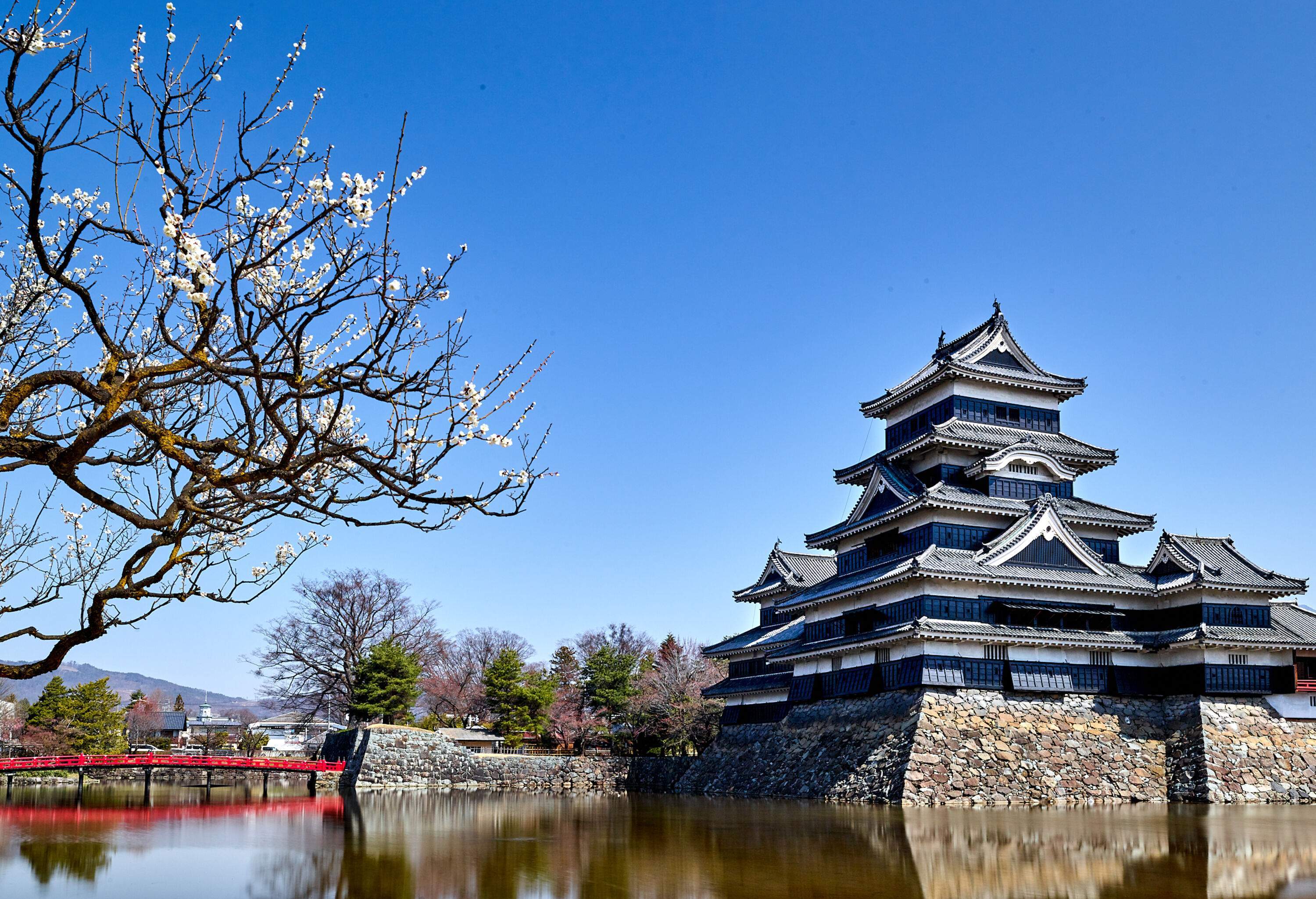
While some Japanese castles had to be rebuilt, Matsumoto is one of the most complete original castles. This is highlighted by the authentic wooden interior. Especially during cherry blossom season a stroll around the moat is a treat.
Daio Wasabi Farm
Some like it hot and if you do, the Daio Wasabi Farm is a place you should see. On the farm, you can visit a restaurant and many shops that sell everything from fresh wasabi root to wasabi beer and even wasabi chocolate.
Day 6+7: Shibu Onsen
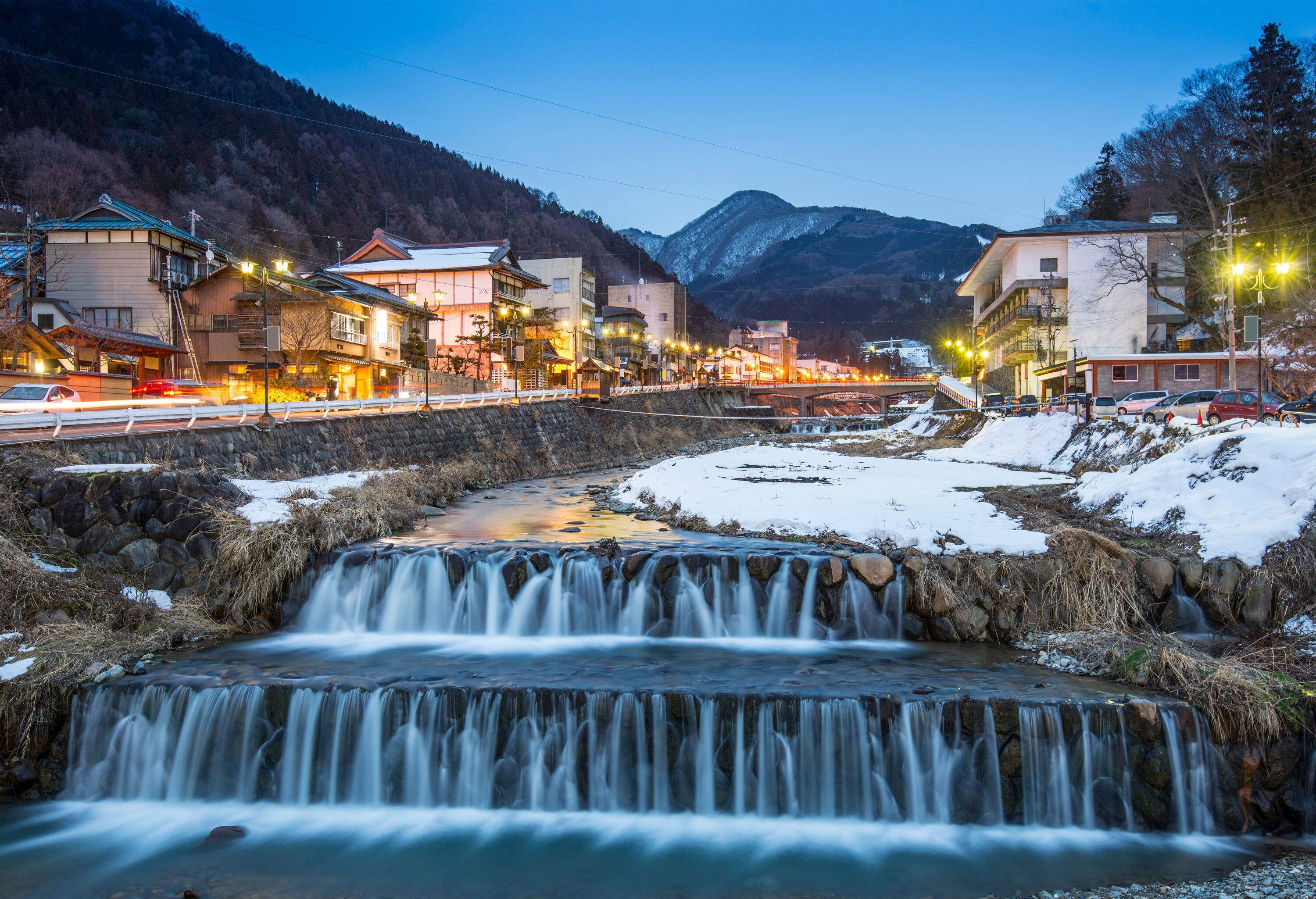
Distance from Matsumoto: 60 mi — 1.5 hours
Shibu Onsen is a picturesque historic hot spring town surrounded by mountains. Beautiful ryokans, the traditional Japanese inns, line the streets and are the perfect backdrop for a wellness holiday. Ryokan Kanaguya is said to have inspired the bathhouse of the beloved Studio Ghibli movie 'Spirited Away'.
Hotel in Shibu Onsen: Kokuya , a stunning ryokan in the center of town
Visit nine public Onsen
There are nine public Onsen in town and you will need to stay overnight to get a key to visit. Visiting all nine brings good fortune! One thing to remember: tattoos are unfortunately a no-go in most Japanese Onsen. If you have some, check if your hotel has a private hot spring.
Jigokudani Monkey Park
It is best to come before March if you want to see the Japanese macaque or snow monkeys as they are called in Jigokudani. Only when it is cold do they come down to sit in a hot Onsen and chill, play, and be adorable.
After your final night in Shibu Onsen you will drive back to Tokyo for your flight home. Make sure to check which airport you are flying out from (Narita or Haneda) and leave enough time to drop your hire car off before checking in.
Day 1–3: Osaka
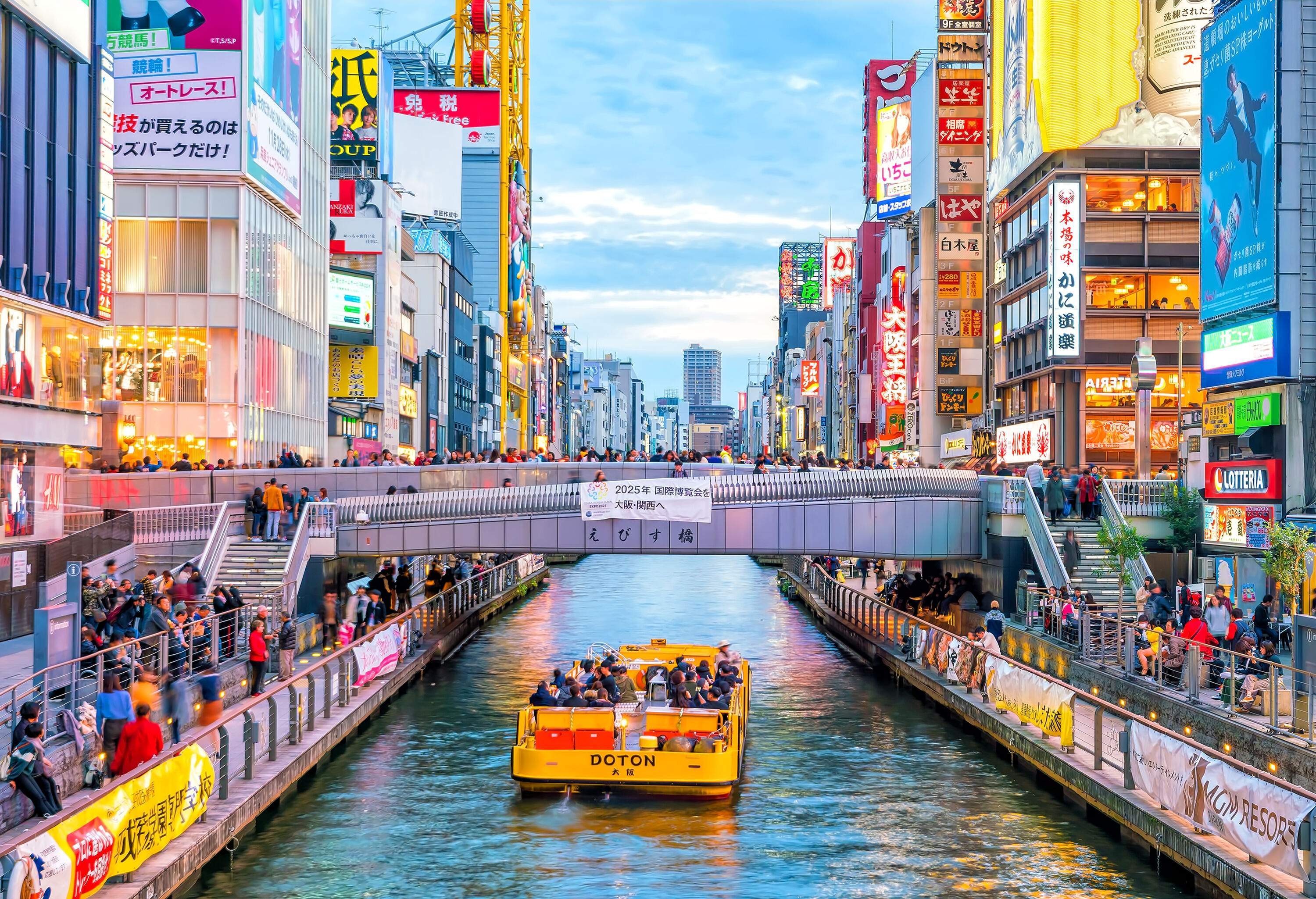
Osaka, Japan’s second biggest city, is known for its incredible food scene. Next to the usual staples, the city’s kitchens are best known for their Okonomiyaki, a pizza pancake-cross, and Takayaki, yummy octopus balls. Dotonburi, Osaka’s nightlife center, is one of the best places to try them both.
Hotel in Osaka : Zentis , a member of Design Hotels with light and airy rooms
Another great area to explore is Shinsekai, meaning ‘new world’ when it was built in the early 20th century. The shopping and dining area centres around the Tsutenkaku Tower, modelled after the Eiffel Tower. Today a visit feels a bit like traveling back in time — but in a good way!
Osaka Castle
Osaka Castle was built in 1583 and became the largest castle at the time. Everything about it was meant to impress and impress it did. That was until its destruction first by Tokugawa troops and then by lightning. Today’s reconstruction was built in the 1930s but it is still a sight to behold. Osaka Castle is also one of the best hanami spots where you can see the cherry blossoms.
Day 4: Nara
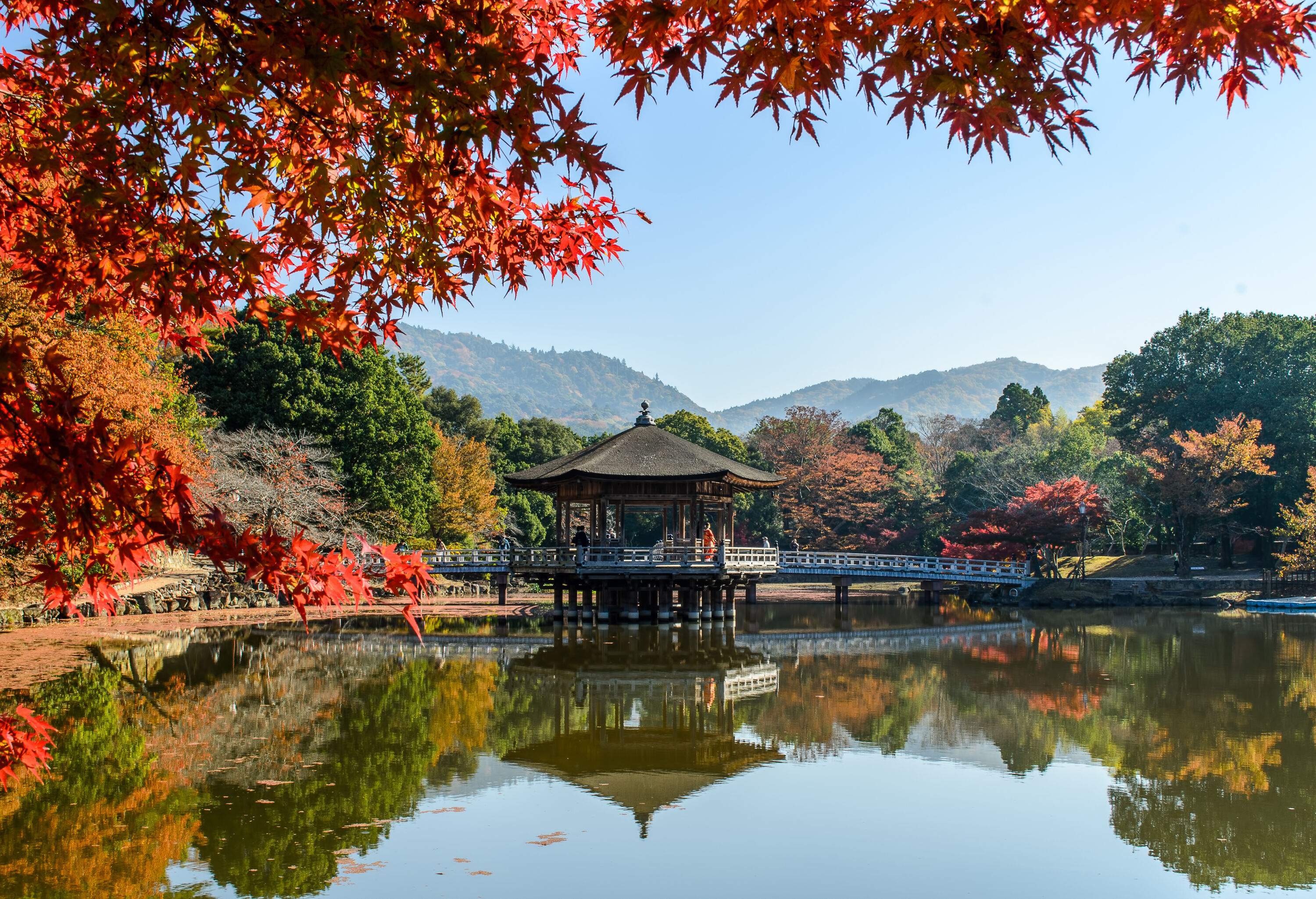
Distance from Osaka: 20 mi — 30 minutes
Nara was Japan’s first official capital and still holds a lot of significance thanks to its historic treasures. The Todaiji Temple is one of the most famous ones and is home to a large bronze Buddha. But admittedly most people come to meet the locals in Nara…
Hotel in Nara : Iroha Grand Hotel Kintetsu Nara Ekimae in the city centre
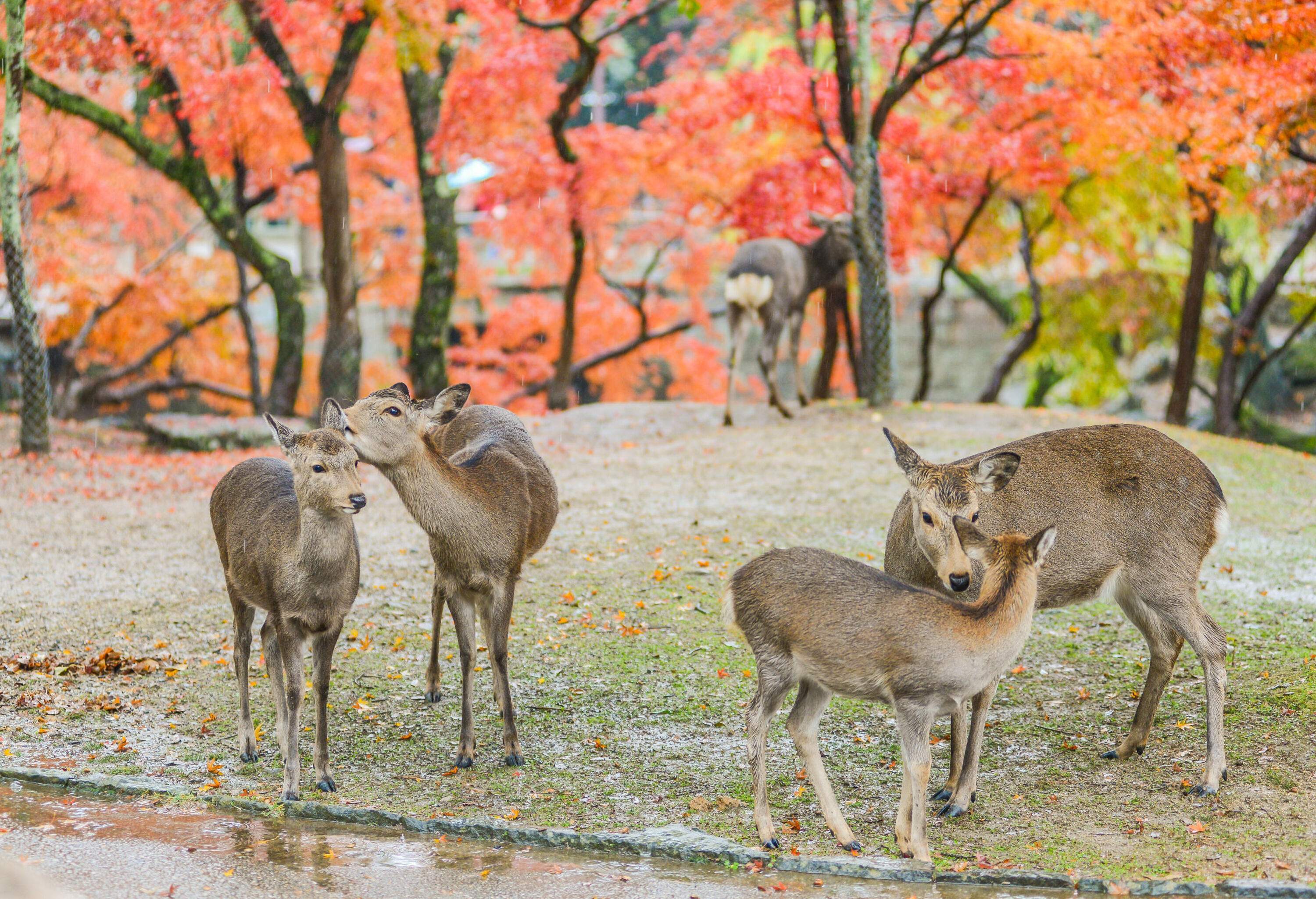
Nara is best known for its over 1,000 wild deer that roam the park and sometimes the surrounding streets. You can buy some deer cookies and feed them but be careful — the deer can be quite cheeky and might search your bag or nibble on your coat. The further you go into the park, the fewer people and you will have the deer all to yourself.
Nakatanidou
If you are in the mood to nibble on something, head to Nakatanidou, a shop that makes the most delicious yomogi mochis. Even more exciting: you can watch mochitsuki. This is the process of mochi-pounding. Nakatanidou has been awarded for the fastest mochi pounders and every half an hour you can watch their craft.
Day 5–7: Kyoto
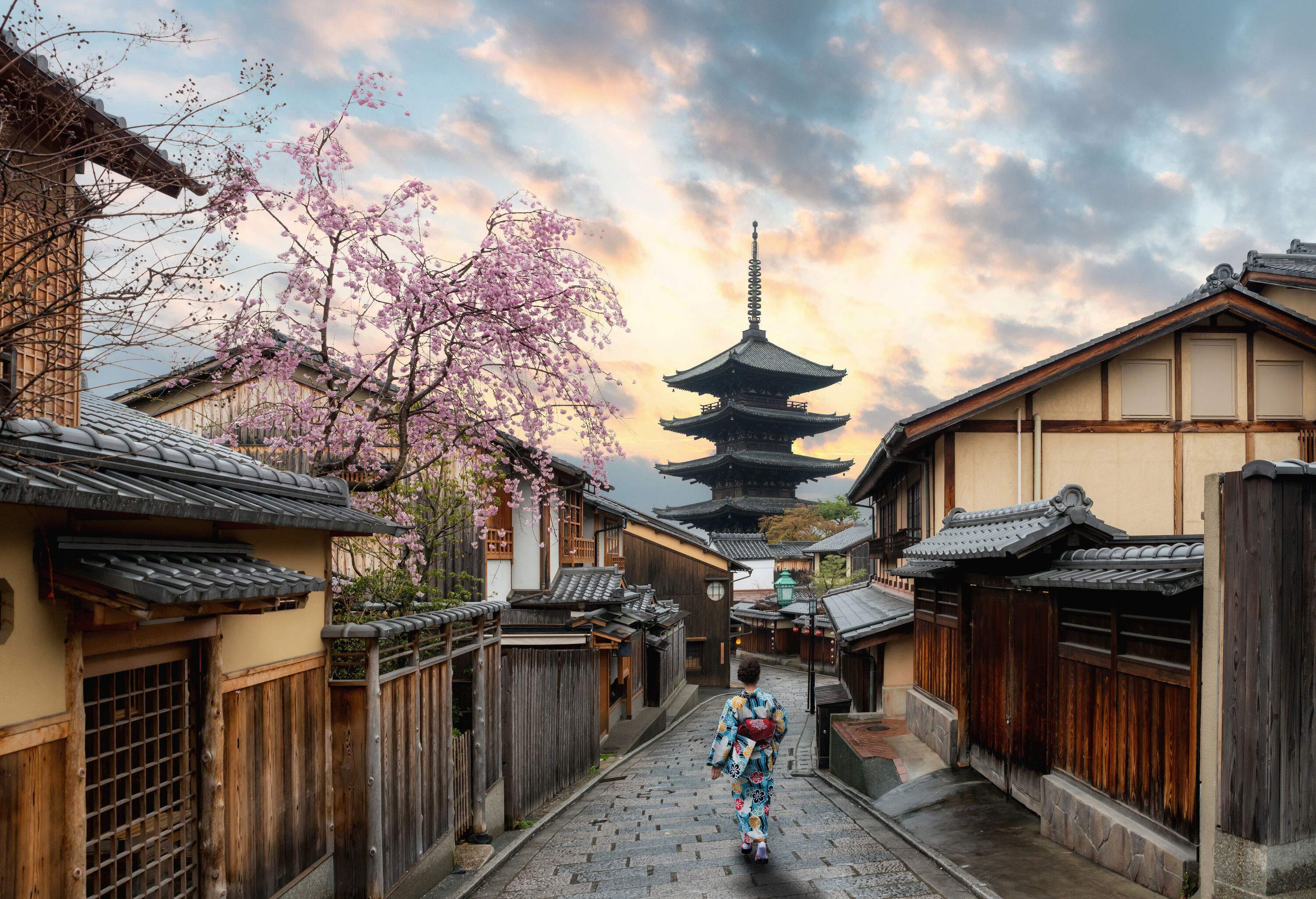
Distance from Nara: 30 mi — 45 minutes
Kyoto is another former capital of Japan and thanks to some beautiful historic buildings and lots of charm, it is an absolute must-see for visitors. Highlights include Nijo Castle, the Imperial Palace, and dinner in Pontocho, an alley with traditional wooden buildings.
Hotel in Kyoto: Node , a member of Design Hotels with lovely, modern rooms
Nishiki Market
A visit to the Nishiki Market is the perfect activity even when it rains as it is covered. Left and right you will find food stalls and restaurants with the most delectable treats. Daifuku, wagyu skewers, and Taiyaki await. You can even buy special dog treats, all things matcha, and of course, Japan’s infamous white strawberries that are worth every yen.
Gion District
The Gion District is the old part of town and home of Kyoto’s Geishas. Unfortunately, some streets recently had to be closed off due to unruly tourists but many parts are still accessible. Walk past the Yasaka Shrine all the way to the Yasaka Pagoda and stop at one of the most beautiful Starbucks on the way. If you want to get a picture in front of the pagoda you will need to get up very early — crowds usually start to form around 6 am!
Day 8: Kobe
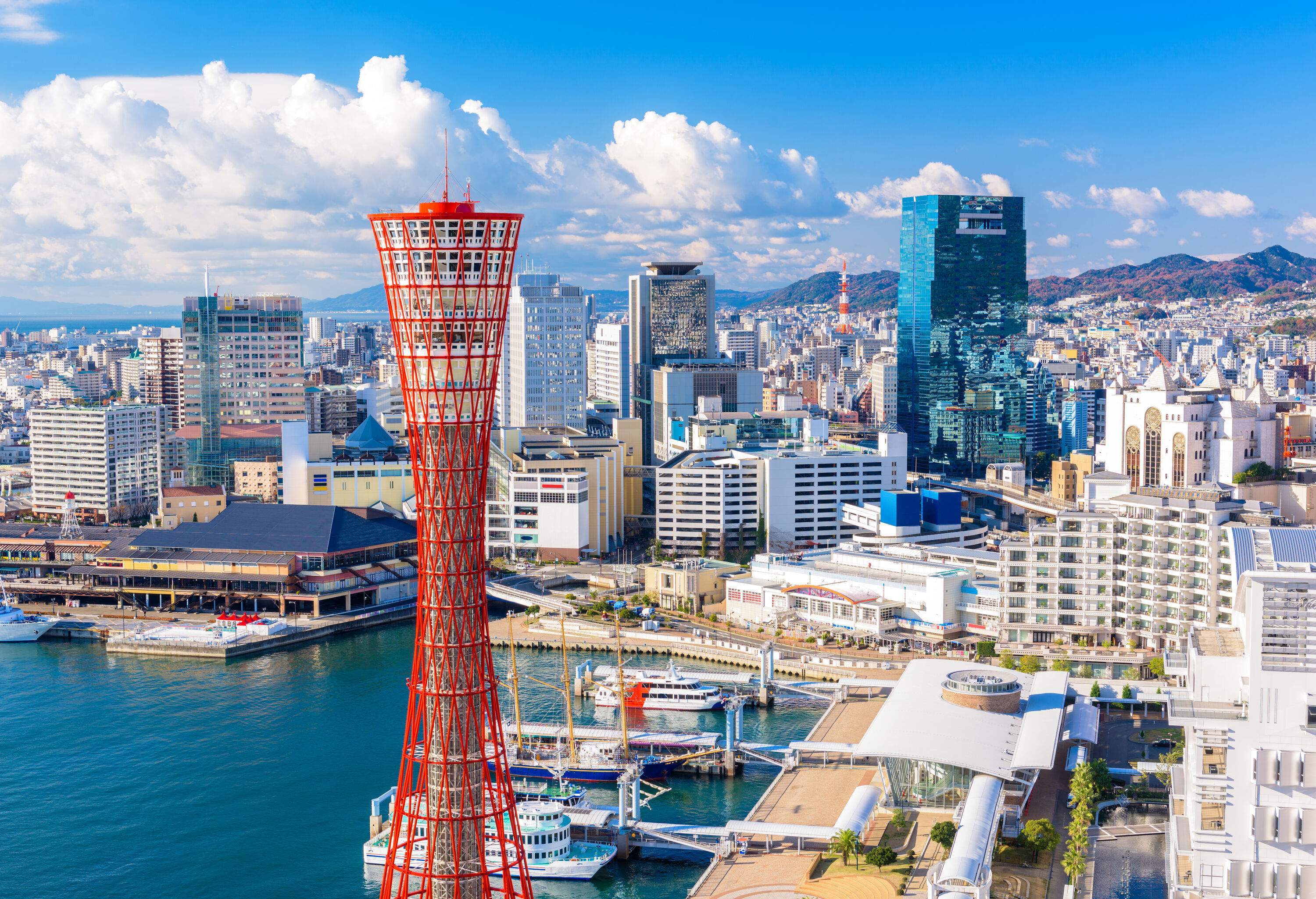
Distance from Kyoto: 50 mi — 1 hour
Kobe is probably best known for its famous beef but even if you are a vegetarian it is a pretty great city to visit. From Kobe you can also take a trip to Himeji Castle, a one-hour drive west. The White Heron Castle is one of Japan’s most beautiful and not to be missed. Alternatively, you can visit it on your way to Hiroshima.
Hotel in Kobe: La Suite Kobe Harborland, a luxury hotel with a view of the harbour
Nada Sake District
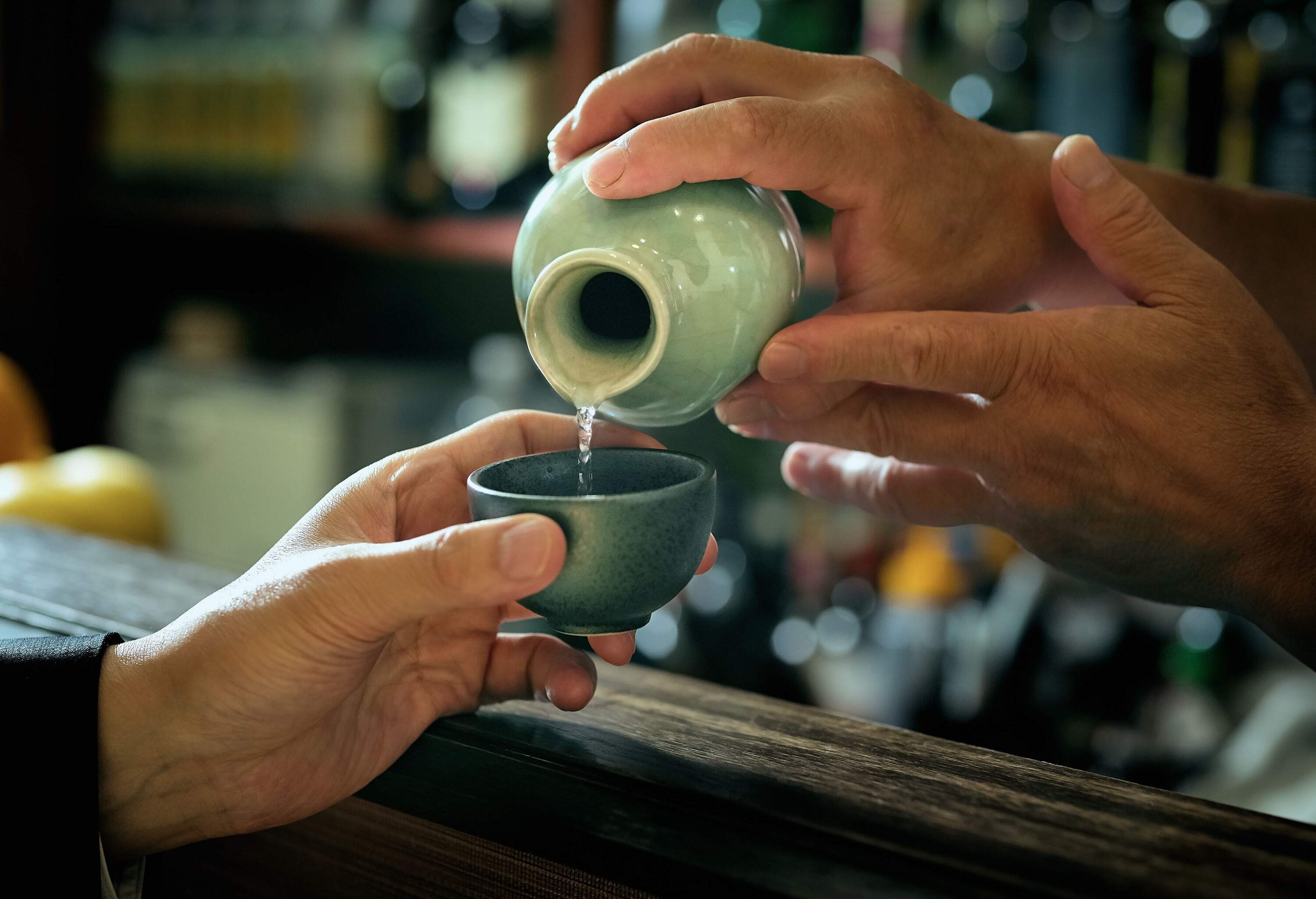
If you want to try some of Japan’s best sake there is no better place than Nada in Kobe. You can visit different breweries in the area. Some have exhibits about the art of sake brewing and many offer tastings.
Kobe Earthquake Memorial Museum
Unfortunately, earthquakes are a part of life in Japan and Kobe was hit especially hard in 1995. The museum not only commemorates the 5,000 people who lost their lives but also educates about earthquakes as well as disaster prevention.
Day 9+10: Hiroshima
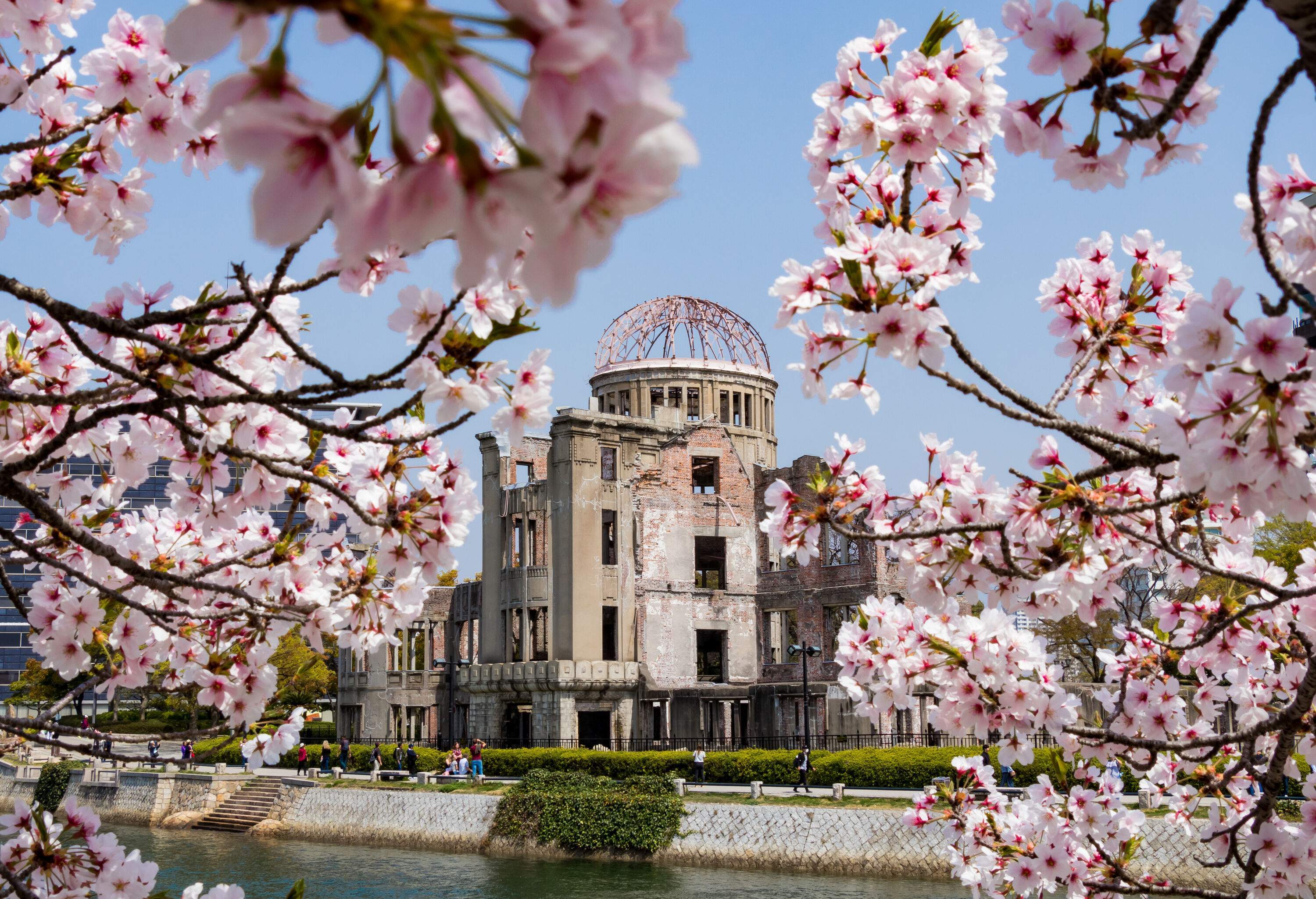
Distance from Kobe: 190 mi – 4 hours
Hiroshima is an absolute gem and quickly became my favourite city on my recent Japan trip. Despite its tragic history, the city today is full of life and a real stunner, especially when the sun is out. Whatever you do, don't forget to eat some local oysters and the Hiroshima-style Okonomiyaki.
Hotel in Hiroshima: Kiro , a sleek design hotel that has some traditional Japanese rooms
Peace Memorial Museum & Park
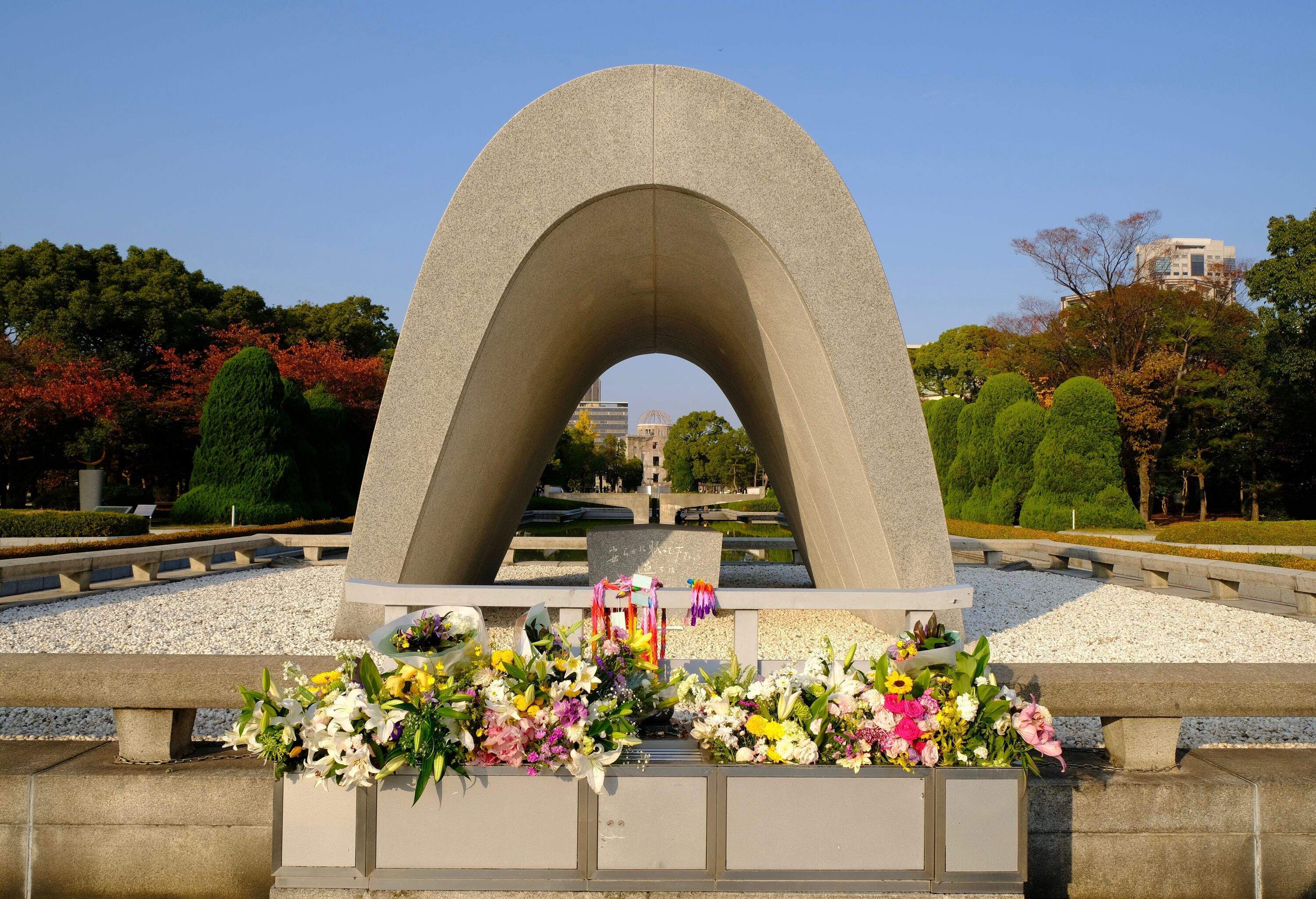
No visit to Hiroshima would be complete without learning more about the first atomic bomb that was dropped here on August 6, 1945. The museum pays tribute to the victims and survivors. Stroll through the park afterwards, which has some beautiful memorial sites and visit the A-Bomb Dome, a stark reminder of the event.
Miyajima Island
Hop on a train and catch a short ferry to visit Miyajima Island. The island is home to more holy deer and the Itsukushima Shrine that appears to be floating during high tide. I recommend you come early in the morning as the island gets very busy with day trippers. Do get a matcha ice cream decorated with a deer cookie while you stroll along the beach.
From Hiroshima, it is best if you book a flight out from Osaka Kansai airport. Alternatively you can drop off your car at Hiroshima airport and book a domestic flight to Tokyo and leave from there.
Create your own 14-day Japan itinerary
If the above is not enough for you, you can combine both routes into an epic Japan 2 week itinerary. Alternatively, you can add one of the most beautiful places in Japan or stay longer to see a haunted building in Tokyo .
Flight and hotel rates are averages based on data collected by KAYAK. These prices offer an estimate for organising your trip, but they may vary according to offers, period, destination, or your preferences. The price per litre of petrol, as of April 1st, 2024, is subject to fluctuations, and comes from numbeo.com .
The hotel recommendations included in this article are based on customer ratings and the author's personal choices, so please feel free to use our hotel search tool to find the accommodation best suited to your needs.
About the author
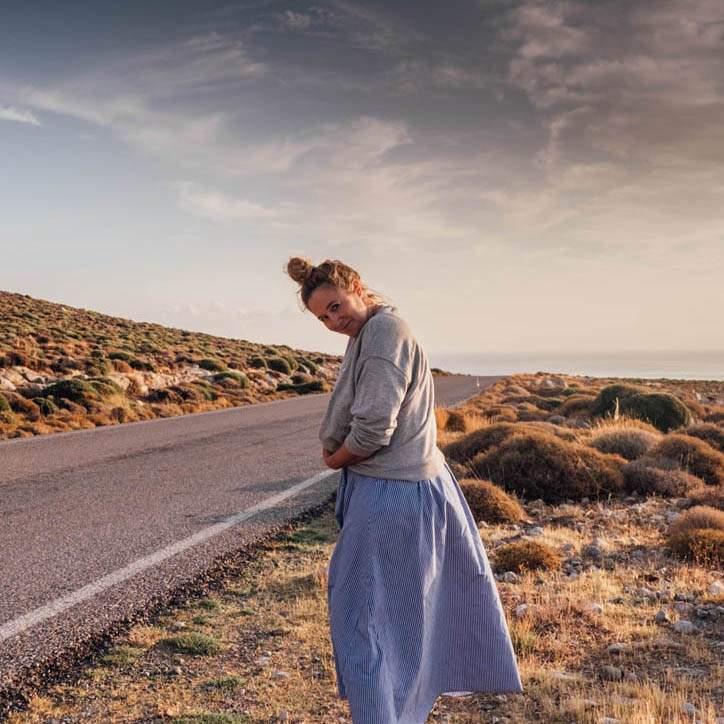
Explore more articles
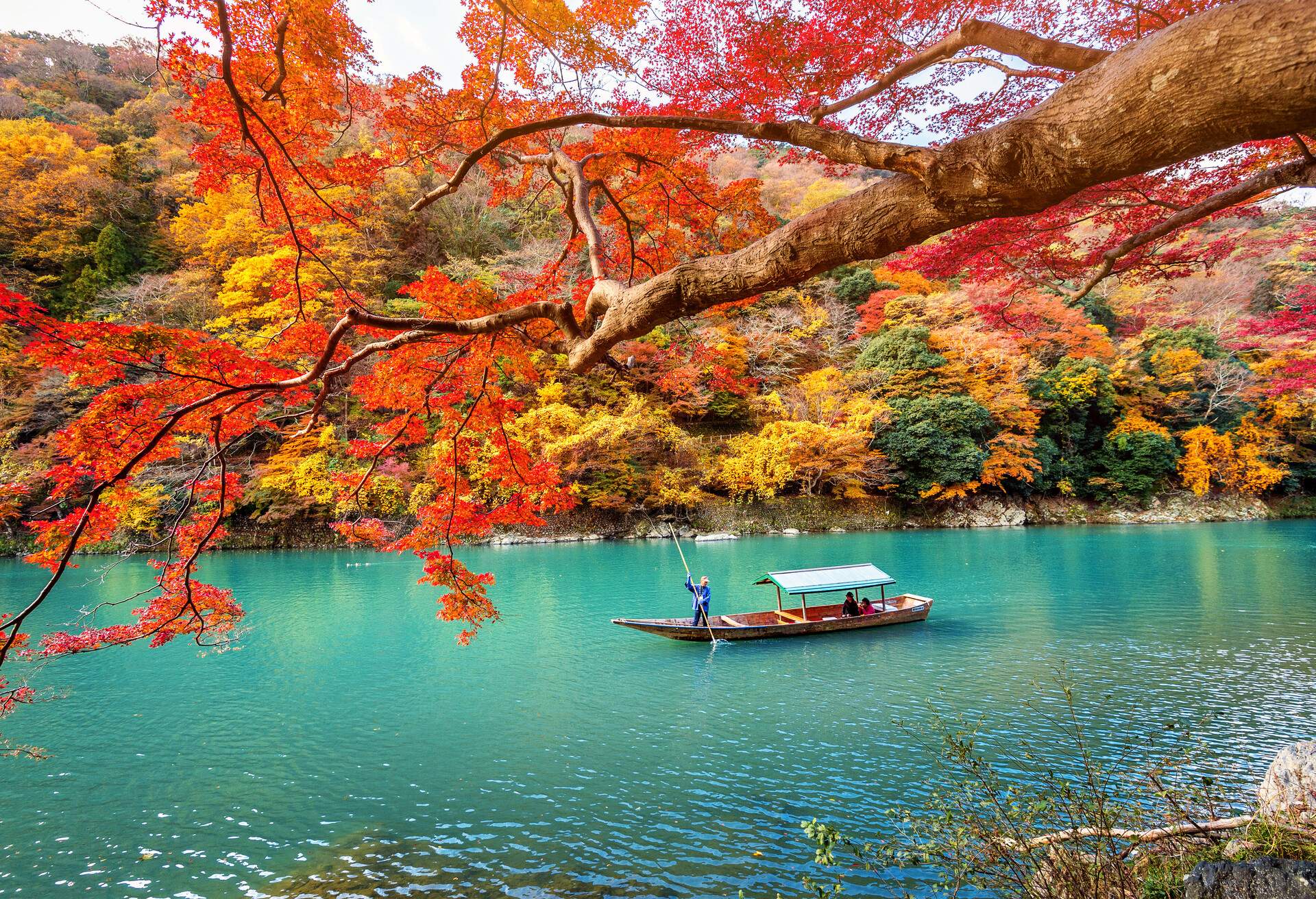

The PERFECT 5 Days in Tokyo Itinerary
P ack your bags because we’re heading to Tokyo, Japan! Get ready for a memorable journey with this 5 days in Tokyo itinerary where we’ll explore the city’s cultural wonders, technological advancements, and delicious food.
From the colorful shopping and Anime hub that is Akihabara to the cultural richness of Ueno, this 5 day Tokyo itinerary takes you to quirky themed cafes and hidden gems like Ameyoko.
This Tokyo, Japan travel guide will help you plan the perfect 5 days in Tokyo and includes some of the best things to do to give you a taste of Japan’s capital.
Expect insights on navigating public transport, indulging in local food, and finding those off-the-beaten-path gems that make Tokyo truly special.
Let’s dive into an epic 5 days in Tokyo!
5 Days in Tokyo Summary
Before we dive into the nitty gritty this is a sneak peek into what to expect on this 5 days in Tokyo itinerary.
Day 1: Arrive at Narita International Airport
Day 2: explore shinjuku .
- Day 3: Visit Shibuya and Harajuku
Day 4: Visit Ueno Park and Museums
Day 5: explore akihabara and ameyoko .
Japan is one of the best places in Asia for a family vacation . If you have more time and want to explore beyond Tokyo, why not travel to other Japanese cities such as Osaka or Kyoto ?
Both cities are worth exploring. Osaka is the best city in the country to explore Japan’s street food culture. While you’ll want to give yourself at least 3 days in Kyoto – the cultural capital of Japan. From both Osaka and Kyoto, it is an easy day trip to Nara, Japan , as well, where thousands of tame deer roam freely in the streets alongside locals and tourists.
Even better, why not travel to other countries near Japan such as South Korea or Taiwan that offer a well-rounded trip in Asia?
Anyway, let’s get into the details of your 5 days in Tokyo trip including the best attractions, where to eat, and how to get around.
On day 1 of your 5 day Tokyo itinerary, you’re touching down in Tokyo! Get ready for a warm Tokyo welcome as you step off the plane onto Japanese soil.
Depending on where you’re coming from you will arrive at Narita International Airport or Haneda International Airport..
For those landing at Narita, getting to the city center is pretty straightforward.
Hop on the Narita Express Train and the Shinkansen train (included with the Japan Rail Pass – also known as the JR Pass), or opt for a limousine bus or private transfer . The trip will take around 1 hour and 30 minutes.
Once there, navigate to your hotel via the subway or treat yourself to the convenience of a taxi.
If Haneda is your entry point, the Monorail (a sweet JR Pass perk), a laid-back limousine bus , or a quick taxi ride are your options. A major plus of arriving at Haneda is its close proximity to the city, taking only 30 minutes by taxi or around an hour by train
Once you’ve checked into your hotel, it’s time to unwind Japanese style.
Kick back, relax, and savor the local flavors of Japan at a nearby restaurant– perhaps paired with a refreshing Japanese brew.
If you’re a first time visitor to Japan, don’t over-schedule your first day. Use this day to adjust to the time change, familiarize yourself with your surroundings and for the family to overcome jet lag .
RESERVE YOUR JAPAN RAIL PASS HERE
Rise and shine, today is your first full day in Tokyo!
Start your day at the popular Shinjuku 3D Billboard featuring the adorable Calico Cat. located opposite the Shinjuku Station’s east exit. It’s the perfect Instagrammable moment to kick off day 2 in Tokyo.
Spend some time wandering through the shops in Shinjuku, whether you’re just a window shopper or on the hunt for some new pieces to add to your wardrobe.
Next, take a breath of fresh air at the Shinjuku Gyoen National Garden , a quiet escape from the heart of the bustling city. You can buy an audio guide to enhance your visit and learn more about the history and culture hidden in the garden.
When it approaches lunch, venture into the lively streets of Shin Okubo for a taste of some Korean street food. Don’t forget to explore the K-pop stores sprinkled along the way. A visit to this Koreatown gives you a good glimpse into Seoul and how it differs from Tokyo .
Afternoon
During the afternoon, feel the adrenaline rush as you take the streets in a street racer with a go-kart adventure through Shibuya or Shinjuku. It’s like a real-world Mario Kart experience! You’ll need an international driver’s license for this adventure.
Also, if visiting Tokyo with kids , this fun adventure is, unfortunately, not suitable for those under 18 .
So, if traveling with children, spend your afternoon exploring the Odaiba District – home to the Rainbow Bridge, one of the world’s largest Ferris Wheels, and lots of fun kid-friendly attractions including Small World Tokyo Miniature Museum , the National Museum of Emerging Science, LegoLand Discovery Center .
As the sun sets, it’s time to experience Tokyo’s epic nightlife.
Begin your adventure in Shinjuku’s Golden Gai, a maze of narrow alleys boasting tiny bars, cheap food stalls, and eateries. It’s the ideal starting point for a DIY bar crawl or food tour . Start your evening with a Japanese brew and a few appetizers.
Continue your journey to Omoide Yokocho , where you can enjoy a delicious bowl of ramen or yakitori from one of the charming, traditional eateries.
If you’re up for it, cap off your night in Kabukicho, Tokyo’s lively entertainment and nightlife district.
You can take a ramen making class or catch a show. Whether you’re drawn to karaoke joints, themed bars and restaurants, arcades, or captivating performances, Kabukicho has it all.
I highly recommend checking out Kabukicho Tower , a new entertainment hall with arcade games, bars, restaurants and even a virtual DJ!
Day 3: Dive into Shibuya and Harajuku
Next up, set your sights on the lively districts of Shibuya and Harajuku.
Start your day at the iconic Shibuya Crossing , a sight featured in many movies and now your chance to be part of the action. Known as the busiest crosswalk in the world, navigate the famous Shibuya scramble crossing amid a sea of people, to get your first taste of Shibuya’s energy.
While in the area, elevate your experience at Shibuya Sky rooftop . You can take a guided Shibuya walking tour or simply explore the area on your own.
Make sure to book your tickets at least a day in advance as they sell out fast and whilst it is on the pricier side, the views of Tokyo are worth every yen!
For lunch, head to Ichiran Ramen , known for its individual booths and signature tonkatsu broth. And be prepared to wait in line for 10-15 minutes, this place is very popular and for good reason!
After lunch, you can either walk or hop on the Yamanote Line to head to Takeshita Street in Harajuku, the epicenter of fashion and trends. Known as the “Teen Holy Land” in Japan, adults and children alike will love all the shops selling Kawaii products and cute desserts.
Wander through the unique boutiques, people watch and don’t miss out on the heavenly crepes offered by the street vendors.
Coffee enthusiasts, make a pit stop at Cafe Reissue for an Instagram-worthy experience. Sip on 3D latte art that is almost too cute to consume. This is a great time to take a “ Crazy Cute Harajuku Food Tour ”.
As the day turns into night, consider delving into Shibuya’s nightlife scene. With countless bars, clubs, and late-night dining options to choose from, Shibuya at night is a whole new experience.
Whether you’re into intimate restaurants, bars, bustling entertainment venues, or late-night eats, Shibuya has it all.
As an alternative, head to Tokyo Tower for sweeping views of the city at night.
Day 4 of this 5 day Tokyo travel itinerary promises a fantastic blend of nature, culture, and immersive experiences.
Kickstart your day with a walk through Ueno Park in the heart of the city. If you’re visiting in spring, the cherry blossoms that Japan is famous for will be in full bloom. Cherry blossom season in Japan typically peaks in late March or early April.
Explore the numerous temples and shrines tucked away within the park, with the iconic Benten-do Temple on the island in Shinobazu Pond being an absolute must-see.
Whether you’re in the mood for tempura, ramen, or a bento box, Ueno has a plethora of small restaurants and street vendors to satisfy your Japanese food cravings.
Next, delve into Japan’s rich cultural heritage at the Tokyo National Museum , located within the expanse of Ueno Park. The museum houses a range of art, artifacts, and historical items, offering a glimpse into Japan’s history.
You can also head to the famous Senso-ji Temple in the nearby Asakusa district. Senso-ji is home to a five-story pagoda, as well as a bustling market just inside the temple’s outer gates.
Tonight, prepare for an unforgettable experience at TeamLab Planets , an immersive digital art installation that pushes the boundaries of creativity and technology.
Book your evening spot in advance for a mind-blowing sensory journey that seamlessly combines the digital realm with artistic brilliance.
Keep in mind that TeamLab Planets is a unique experience that comes with a price tag and it’s also not the easiest to get to from the city center.
Plan your journey accordingly, as it involves navigating multiple subway lines. Or if you have the funds you can hop in a taxi for a 20-30-minute ride to the museum.
On your final day on your 5 days in Tokyo itinerary, take to the streets of Akihabara and the bustling market scene of Ameyoko. It’s the perfect way to wrap up your Tokyo travels with a fusion of tech wonders, anime culture, and traditional markets.
Jumpstart your day with a quick and convenient ride on the Yamanote Line to Akihabara Station, also known as Electric Town.
Here, you’ll dive into a realm where technology, anime, and pop culture collide. Stroll through the lively streets to explore the captivating world of electronic stores, manga shops, and anime merchandise.
Anime is just one of the reasons you’ll love visiting Japan with kids . Even if you’re not an anime aficionado, the vibrant culture of Akihabara is an experience in itself.
For a unique bite to eat, explore one of Akihabara’s quirky-themed cafes. From maid cafes to Gundam-themed restaurants to owl cafes , there’s a quirky spot that can add a touch of whimsy to your morning.
After soaking in the tech wonders of Akihabara, decide whether to hop back on the Yamanote Line or take a leisurely 1-2 km walk to Ameyoko . This bustling market street offers everything from fresh seafood and street food to clothing, shoes, and electronics.
It’s the ideal place to snag those last-minute souvenirs, grab some lunch and savor the vibrant market atmosphere of Japan.
As an alternative , you could head in the opposite direction to see the famous Tokyo Imperial Palace and the Tsukiji Outer Market .
The Tsukiji Fish Market was once a place where you could watch a live fish auction, however, the auction has moved to the outskirts of the city, but you can still visit the outer market where vendors sell fresh-off-the-boat sushi and seafood.
As the day comes to a close, make your way back to Ueno for a farewell dinner. The area is home to a myriad of restaurants and eateries from authentic Japanese to international cuisine. Walk through the area until you find a spot you like to stop for dinner.
Or if you’re feeling weary from the whirlwind of the past few days, consider a cozy takeaway or a quick bite from a convenience store to savor in the comfort of your accommodation.
Whether you choose to dine in style or opt for a more relaxed evening, take a moment to reflect on the incredible 5 days in Tokyo you’ve just had!
Where To Stay In Tokyo
So where should your home base be for tackling this 5 days in Tokyo itinerary?
Look no further than the heart of Shinjuku. This neighborhood is a living testament to the city’s dynamic spirit, offering busy streets, plenty of restaurants and cafes, neon-lit nightlife, and a range of accommodations catering to every budget.
And here’s the beauty – the well-connected Shinjuku Station transforms exploration into a seamless journey, opening doors to Tokyo’s diverse wonders and beyond.
Budget: Unplan Shinjuku
For those mindful of their budget, Unplan Shinjuku is a savvy option in Tokyo.
Unplan has a clean, modern design with both shared and private rooms. There are also plenty of communal spaces so you can hang out with other travelers. Plus there is an onsite restaurant and shisha bar.
By staying at Unplan Shinjuku your Tokyo adventure just got more affordable, fun and stylish!
Luxury: Park Hyatt Hotel
For the ultimate luxury stay, there’s truly nothing that compares to Park Hyatt Tokyo .
Boasting iconic skyline views, impeccable service, and lavish amenities, this hotel exudes sophistication and relaxation in every detail.
A stay at the Park Hyatt Tokyo is synonymous with stepping into a world of indulgence, making it my top recommendation for those in search of the crème de la crème in Shinjuku accommodations.
And let’s not forget about the rooftop bar, offering some of the most breathtaking views you’ll find in the city. So if you have the funds, elevate your Tokyo experience with the pinnacle of luxury at Park Hyatt Tokyo!
FAQs: 5 Days in Tokyo
Moving onto some commonly asked questions about spending 5 days in Tokyo.
Are 5 days enough for Tokyo?
Absolutely! While Tokyo is a big city with endless things to do, you can pack a whole lot into 5 days in Tokyo – or even 4 days if you are limited on time.
From the tech haven of Akihabara to the scenery of Ueno Park, each day brings new adventures. Just pace yourself (the city is pretty full on), embrace the local culture, and of course, eat loads of Japanese food!
Of course, if you have even longer, you can take a day trip to Hakone or Jigokudani Monkey Park, one of the most beautiful winter wonderlands in the world .
Should I go to Osaka or Tokyo?
Ah, the classic Japan dilemma! Visiting Osaka or Tokyo.
Both cities offer distinct experiences. Tokyo is a dynamic city of fashion, dining and tech while Osaka charms with its street food and vibrant nightlife.
In the end, it really depends on your preferences. If you love the fast-paced city scene with loads of tech and diverse neighborhoods, Tokyo’s your go-to. If you’re a foodie seeking a more relaxed and authentic vibe, Osaka might be better for you.
Better yet, why not both? The Shinkansen (bullet train) can zip you between them in a few hours. Plus, the more time you spend in Japan, the more you will appreciate the country’s beautiful culture and all the unique Japanese habits and customs .
How do I get from Tokyo to Mount Fuji?
Ah, the majestic Mount Fuji!
If you’re wanting to visit the iconic view from Tokyo, you’ve got a few options. You can take a bus from Tokyo to the Fuji Five Lakes area, which takes around 2 hours.
Alternatively, hop on a train to Kawaguchiko Station. From there, buses can take you to various viewpoints. This is another two-hour journey, but the breathtaking sight of Fuji is well worth it!
CHECK OUT OUR HAKONE DAY TRIP ITINERARY THAT OFFERS BEAUTIFUL VIEWS OF MOUNT FUJI
The Wrap-Up: 5 Days in Tokyo
And there you have it, the perfect 5 days in Tokyo!
From the anime of Akihabara to the fashion in Harajuku, we’ve covered it all in this 5 day itinerary. The ramen, the quirky cafes, the parks, the nightlife and the markets.
And thanks to the city’s excellent transport and connectivity, jam-packing your 5-day itinerary with attractions and various neighborhoods is a breeze.
Until next time, arigato and sayonara.
Like it? Pin this 5 day Tokyo itinerary to save it for later!
Do you have a question or comment about any of the things to do on this 5 day itinerary for Tokyo? We’d love to hear from you! Leave your thoughts in the comments below.
Also popular with travellers
Gandikap: all you need to know before you go (with photos).
- Elektrostal Tourism
- What to do in Elektrostal
- Elektrostal Hotels
- Itineraries
- Elektrostal
- 5 Days In Elektrostal
Elektrostal Itinerary 5 Days
Best itineraries for 5 day trip to elektrostal.
Let our handpicked 5-day Elektrostal itineraries guide you in creating a trip plan of your own. Take a look at these customised Elektrostal trip plans for 5 days and you will not miss out any point of interest in the city.
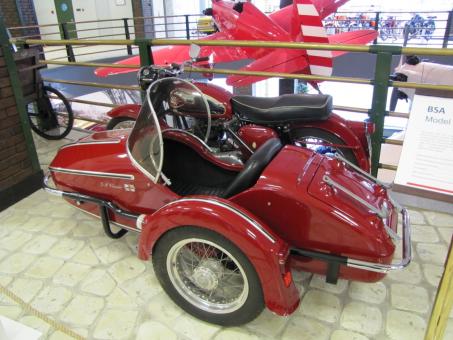
Recent Itineraries: Elektrostal Trips for 5 Days
Make your travel planning easier by using these perfect 5 days in Elektrostal itineraries from our users and travel experts. Look out for wisely chosen places you would like to explore during 5 days in Elektrostal.

Ready to Plan a Elektrostal Itinerary 5 Days Now?
Are you now ready with your Elektrostal bucket list? Create an itinerary to Elektrostal using our Free Trip Planner and check all the attractions off your list.
Also popular with travellers
Gandikap: all you need to know before you go (with photos).

IMAGES
VIDEO
COMMENTS
Explore the scenic beauty of Lake Kawaguchiko, Japan's most awe-inspiring view of Mt. Fuji, in this comprehensive guide. Learn how to get there from Tokyo, what to see and do, and how to enjoy the hot springs and cultural heritage of the area.
The Ultimate Day Trip to Mt Fuji: A 1 Day Itinerary. Looking for a day trip to Mt Fuji? In the land of the rising sun, where ancient tradition seamlessly intertwines with modernity, one towering icon stands as a testament to Japan's natural grandeur - Mount Fuji. Standing tall at over 12,000 feet in the clouds Mount Fuji, also known as ...
Explore different ways to enjoy a Mt. Fuji day trip from Tokyo, including tours, amusement parks, onsen, and scenic spots. Find out how to get to Mt. Fuji, where to stay, and what to see in the Fuji Five Lakes area.
Learn about the history, culture, and attractions of Mount Fuji, the highest peak and a sacred site in Japan. Find out how to reach, climb, and stay at the mountain, and what to do in case of bad weather.
Our recommended 1-day Mt Fuji Five Lakes Itinerary: 1. Mt Fuji Panoramic Ropeway, 2. Nagasaki Park, 3. Oishi Park, 4. Fuji Sengen Shrine, 5. Chureito Pagoda If you have more days: Green & Blue Sightseeing Bus Line to Lake Saiko, Lake Shojiko, and Lake Motosuko, Fuji-Q Amusement Park, Fujiyama Art Museum
Head to Fuji-Q Highland from Mt. Fuji 5th station via Kawaguchi-ko station by highway bus. The 11:40 AM departure will take 40 minutes and cost ¥1,570, one way. From there, you can enjoy roller coasters and other theme park rides to your heart's content. Day passes are ¥6,300 per person and the park is open until 5 pm.
If you don't have a lot of room in your Japan itinerary, a Mount Fuji day trip from Tokyo is a great way to peep the famous peak. There are essentially 3 ways to experience Mount Fuji as a day trip from Tokyo: Use the Hakone Free Pass. Self-drive to Kawaguchiko. Join a guided tour.
This Tokyo to Mt Fuji day trip blog follows an itinerary covering scenic spots surrounding the Fuji Five Lakes including sacred shrines, exquisite ponds and finishes off the day at Japan's ultimate shopping destination before heading back to Tokyo. If you're interested to learn how you can do all this on a Mount Fuji excursion from Tokyo ...
Mt. Tenjo towers over the east side of Lake Kawaguchi and is easily accessible via the Mt. Fuji Panoramic Ropeway.Ride 1,000 meters to the top to enjoy panoramic views. Along the way, you'll encounter numerous monuments and kid-friendly scenes depicting a local folktale, in which a clever rabbit takes revenge on a scheming tanuki (raccoon dog).
Picture: mount fuji day trip itinerary review. However, if you want to go to Mount Fuji during the non-climbing season, you have to change the journey, namely from Shinjuku station to Kawaguchiko station will take 1 hour 45 minutes (1,750 yen/ one-way ~ 15.5 USD).
The Enchanting Five Lakes of Mt. Fuji Nestled at the foot of Mt. Fuji are the five lakes that were formed during its last eruption: Lake Motosu, Lake Shoji, Lake Saiko, Lake Kawaguchiko, and Lake Yamanaka. Together, they are referred to as the Five Lakes of Mt. Fuji and were officially recognized as part of the Mt. Fuji Cultural World Heritage ...
A day-trip from Tokyo to Mount Fuji and the lesser-known Hakone five lakes area is among the favorite experiences of many travelers to Japan, so here is our guide on how to visit this famous landmark with the Japan Rail Pass. Whether you prefer climbing or a more relaxed pace, we have the perfect guide for you make the most out of this trip! Let's start with some interesting facts about Fuji ...
Day 1 in Mount Fuji suggested itinerary Arrive at Mount Fuji. Begin your trip by arriving in the Mount Fuji area. We chose to spend a full two days here, as it allows you to fully explore the surroundings and on the off chance you happen to be visiting when it's overcast (like it was for us) then you'll leave yourself more opportunities to see the snow-capped top of Mount Fuji.
3 Best Ways to Go from Tokyo to Mount Fuji. Mount Fuji is around 100 km from Tokyo and it takes about 2 hours to complete the journey.. There are 3 best transport options available ― Fujikyuko/ Keio Bus (Highway Bus), Fuji Excursion train, and guided tour.. Depart: Shinjuku (Tokyo) For a day trip going to Mount Fuji from Tokyo, the best and easiest way is to take a highway bus or train from ...
The cable car up to Tenjoyama Park, from where you'll see a super view of Mt. Fuji, is actually about a 15-minute walk from Kawaguchiko Station. Since it's the 11th stop on the line, riding the bus will take you on a more circuitous route. Both the bus ride and the walk are about 15 minutes. Alight at Stop 11.
Itinerary DAY 1 8:30-9:30am | Arrive at Mt. Fuji Fujinomiya 5th station 9:30-10:30am | Begin ascent on Fujinomiya route On a clear day you will be rewarded with views of the Pacific and surrounding mountains, including Hakone and Lake Ashi. Be sure to take as many rests as needed to give your body time to slowly adjust to the change in ...
Mount Fuji is part of the Fuji-Hakone-Izu National Park. It's located less than 100 kilometers away from Tokyo. It is a UNESCO World Heritage site since 2013 and has always been a popular destination for day trips from Tokyo. Most day trips from Tokyo to Mount Fuji will head to either Lake Kawaguchiko or Hakone.
Although you can do this Hakone itinerary as a day trip from Tokyo, I recommend that you spend the night at one of the many great onsen ryokans in the Hakone area as we did. ... From the train, you can see Mt. Fuji on a clear day. By Train. The Odakyu Line goes directly from Shinjuku Station in central Tokyo to Hakone-Yumoto Station in Hakone ...
2. Due to the winter weather, it is not possible to go to Mount Fuji 5th Station. From Dec 1th to April 25th of the following year, go to Arakurayama Sengen Park instead of Mt.Fuji 5th. 3.Kindly understand that the itinerary schedule may be adjusted according to weather, road conditions and other reasons.
Mt Fuji Road Trip Route and Budget Breakdown. Transport: S$146.16 (excl. flight) Accommodation: S$181.40 Activities: S$74.85 Food: S$105 (~¥3,500/day) Misc: S$56.65 TOTAL: S$564.06 (1SGD = 100JPY) (detailed breakdown for one pax here) *Note: Flights were excluded from the budget as airfares fluctuate quite a bit across the year. Day 1: Fuji-Q ...
Tokyo Mode Gakuen. 5h. During the bus journey from Tokyo to Mount Fuji, travelers will transition from the urban landscape of Tokyo to the serene countryside. They may glimpse traditional Japanese villages, verdant fields, and possibly Lake Kawaguchi, known for its reflection of Mount Fuji. Oshino Hakkai, a village with crystal-clear ponds ...
Having spent time in the Hakone region we have put together our recommended Hakone itinerary for a 1-2 day visit, including various options depending on your personal interests. Things to do in Hakone include fun train, boat and bus trips, a ropeway trip, exploring a volcanic area, views of Mt Fuji when the weather is co-operative, shrines and ...
31 reviews. 41 helpful votes. Mt Fuji Day Trip: Back in play! Now I'm serious. May 11, 2024, 5:07 PM. Background: I had planned for Sanrio Puroland on Thursday, but it is closed on Wed & Thu for the rest of May. So, I moved that to another day when I will be visiting Shinjuku, and this has freed up an entire day for me (Thursday, May 22) when I ...
Check into AirBnB anytime after 4PM. Relax, enjoy the scenery of the lake and Mt. Fuji (fingers crossed). 29th - Wednesday - Take an already reserved Bus via Sekitori from Kawaguchiko Station (track no. 6) at 10:20am to Mishima Station North Gate (1 hour 30 min). Take the Shinkansen to Kyoto ( 2 hours 20 min).
Japan itinerary 7 days — From Tokyo to the mountains. 🗓️ Duration: 7 days. 📍 Route: Tokyo - Hakone - Matsumoto - Shibu Onsen. 🚗 Distance covered: 260 mi. 🧡 Highlights: Hot Springs, Mount Fuji, snow monkeys. 👀 Suitable for: City slickers, wellness fans & mountain lovers.
Before we dive into the nitty gritty this is a sneak peek into what to expect on this 5 days in Tokyo itinerary. Day 1: Arrive at Narita International Airport. Day 2: Explore Shinjuku. Day 3 ...
Trips Alerts Sign in. Cart. Elektrostal. Elektrostal Tourism Elektrostal Hotels Elektrostal Bed and Breakfast Elektrostal Vacation Rentals Flights to Elektrostal Elektrostal Restaurants Things to Do in Elektrostal Elektrostal Photos Elektrostal Map Elektrostal Travel Guide.
Hotels near Electrostal History and Art Museum Hotels near Park of Culture and Leisure Hotels near Statue of Lenin Hotels near Museum and Exhibition Center Hotels ...
Best Itineraries for 5 Day Trip to Elektrostal Let our handpicked 5-day Elektrostal itineraries guide you in creating a trip plan of your own. Take a look at these customised Elektrostal trip plans for 5 days and you will not miss out any point of interest in the city.
All photos (1) Suggest edits to improve what we show. Improve this listing. Revenue impacts the experiences featured on this page, learn more. The area. Gorkogo, 15, Elektrostal 144002 Russia. Reach out directly. Visit website. Call.